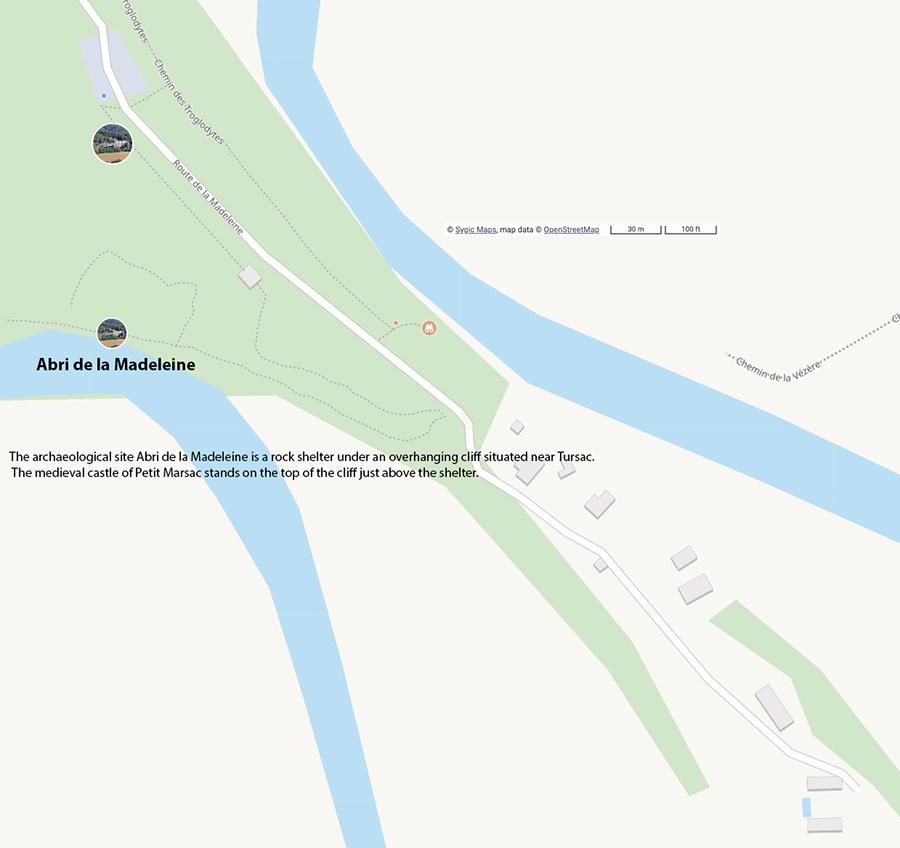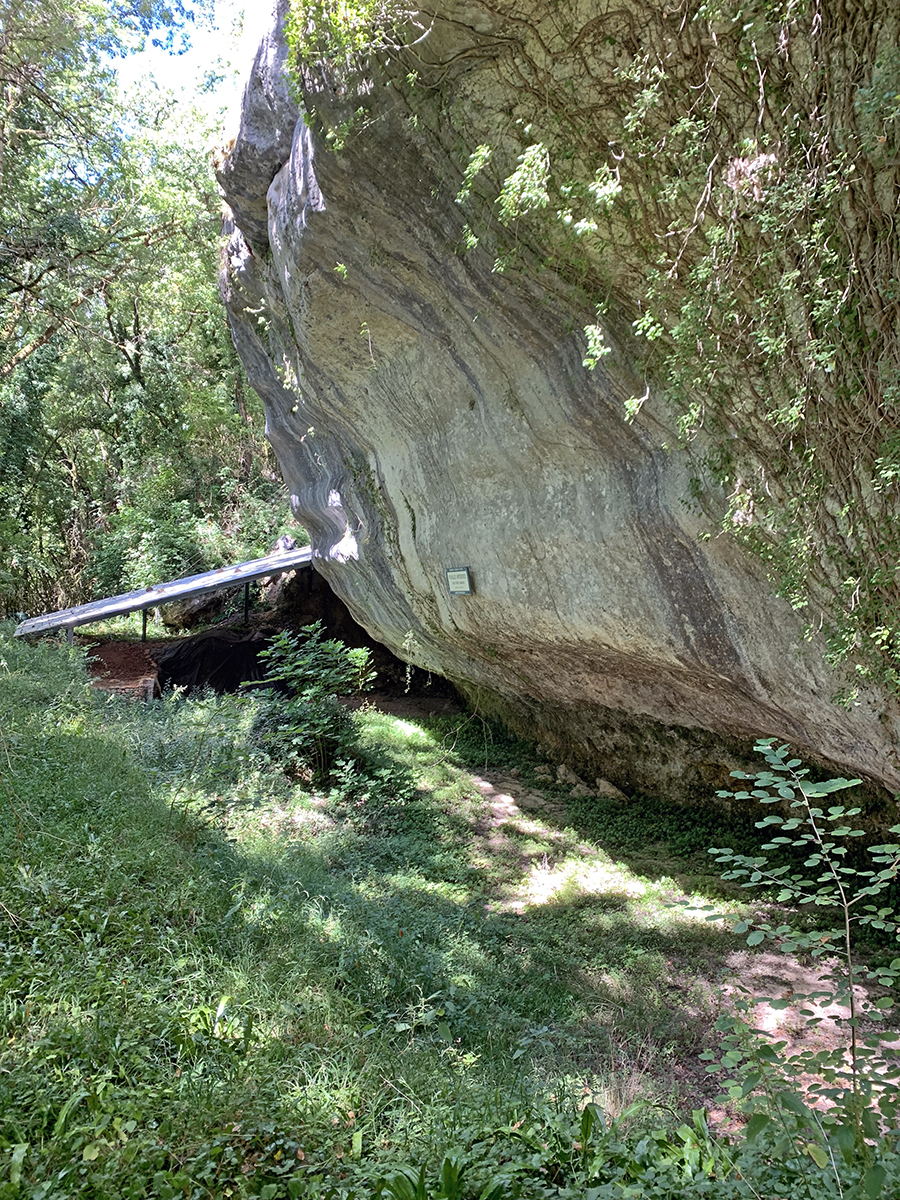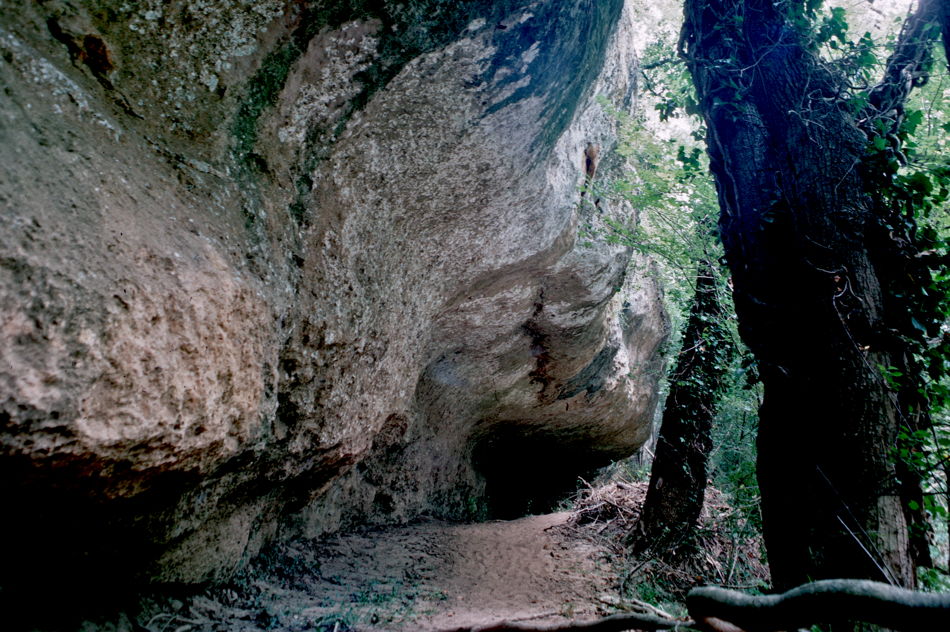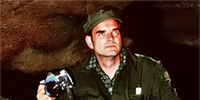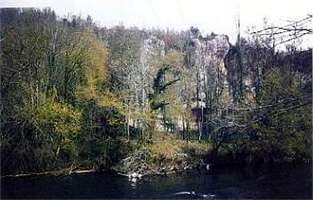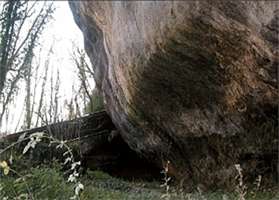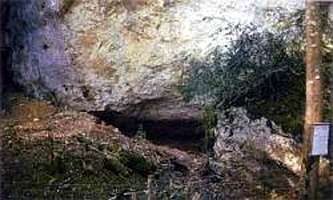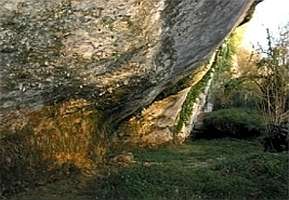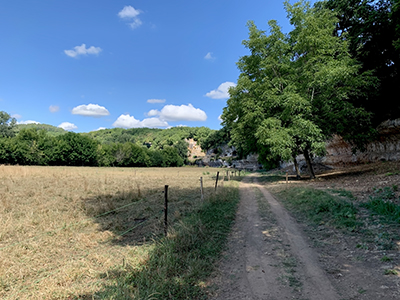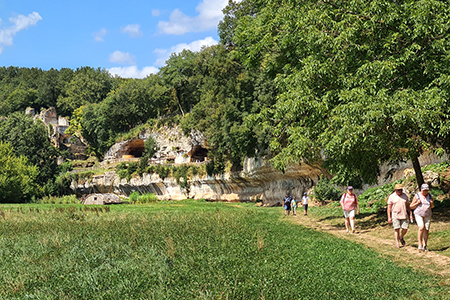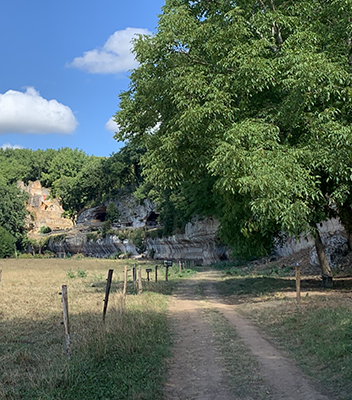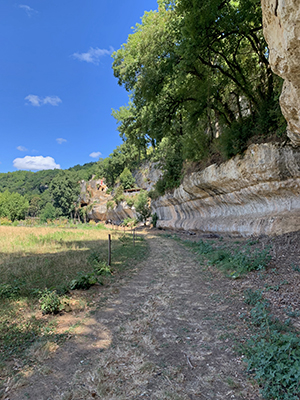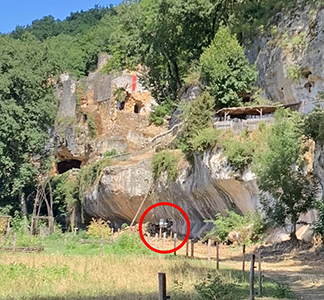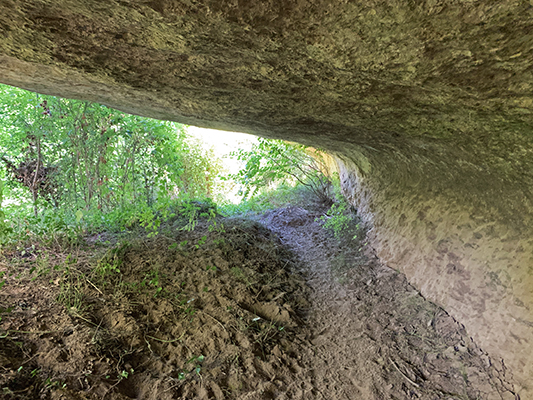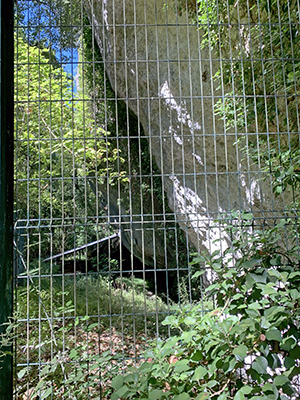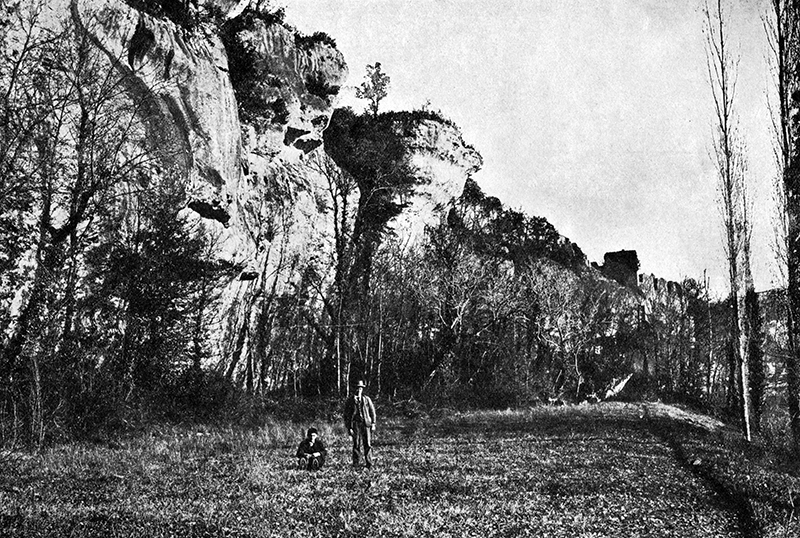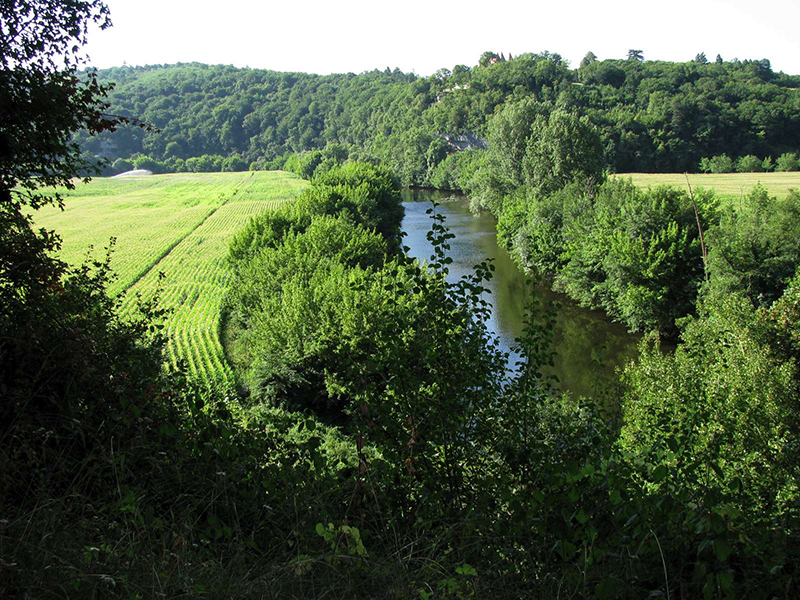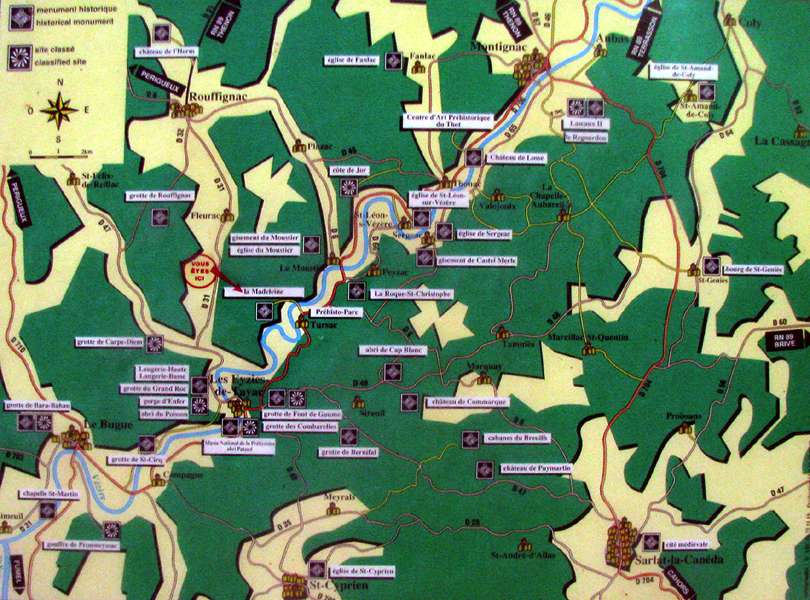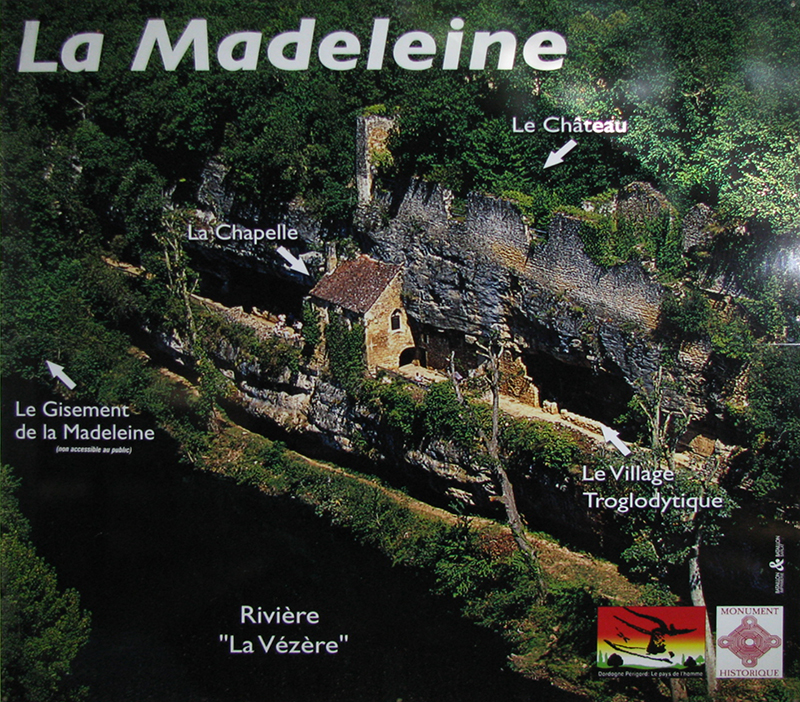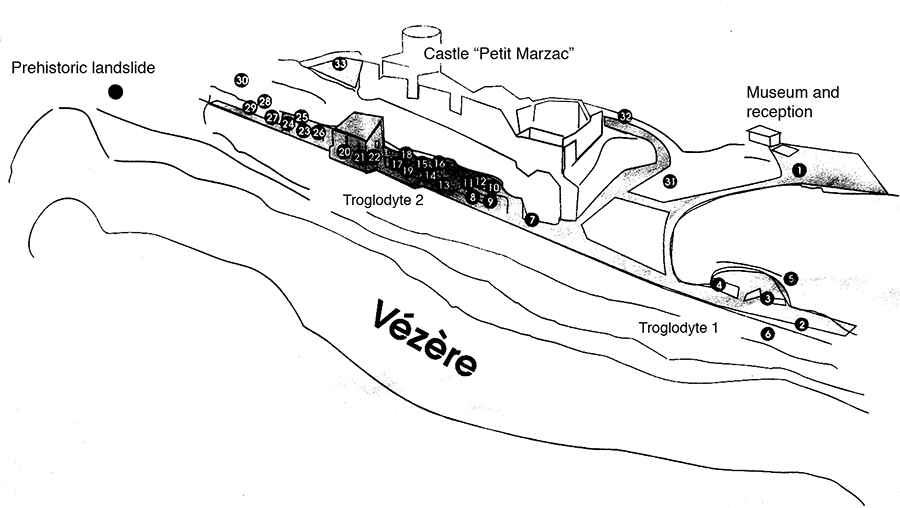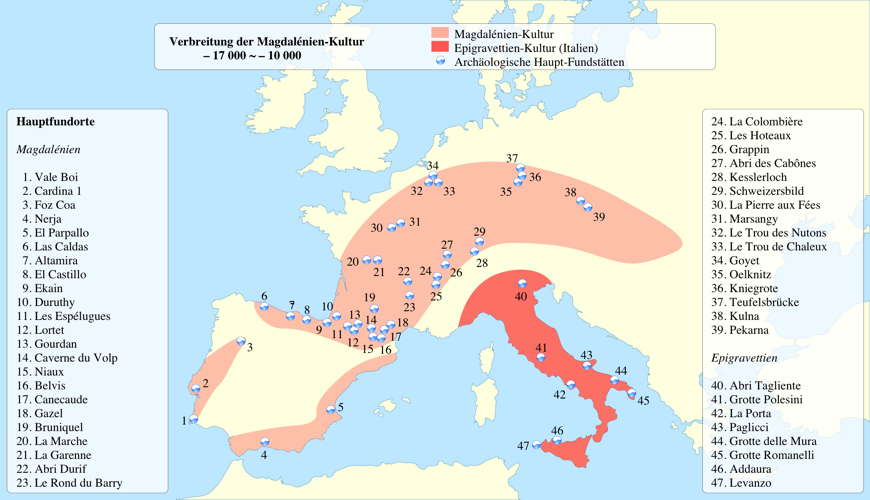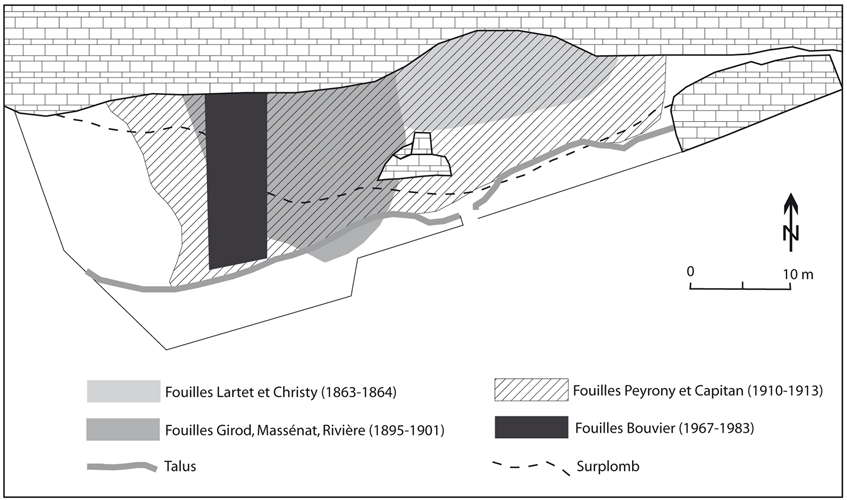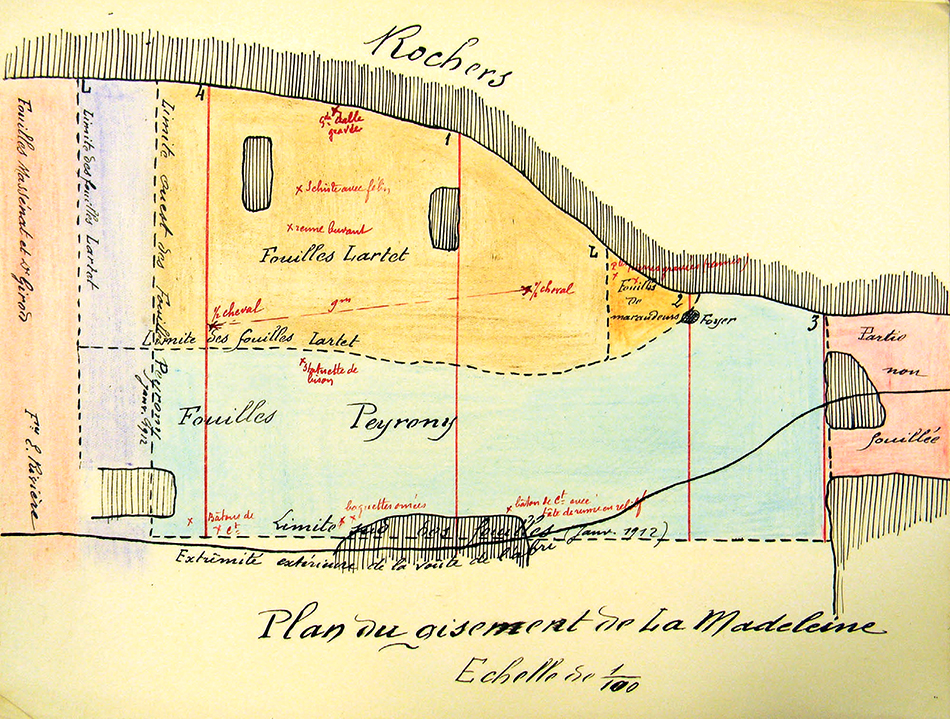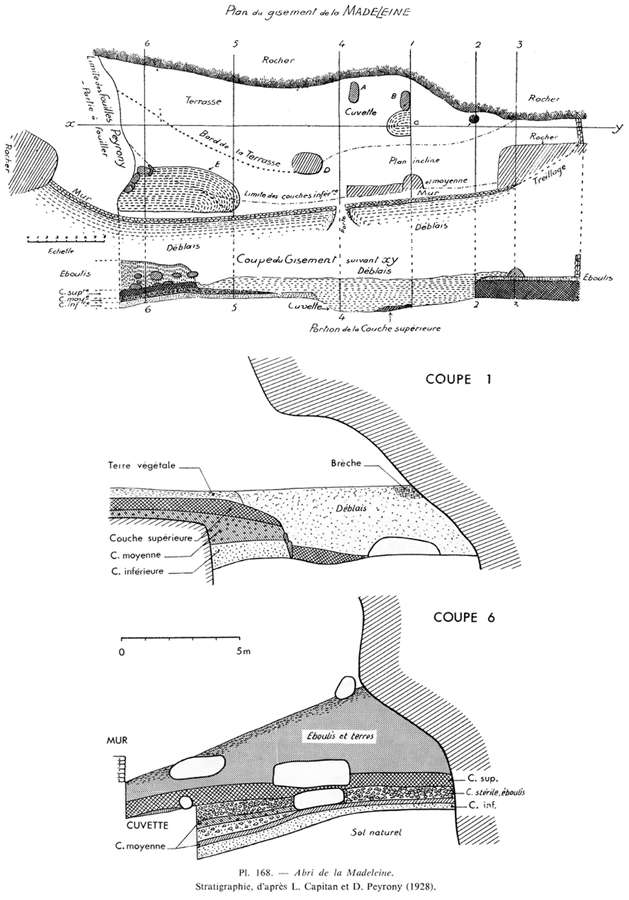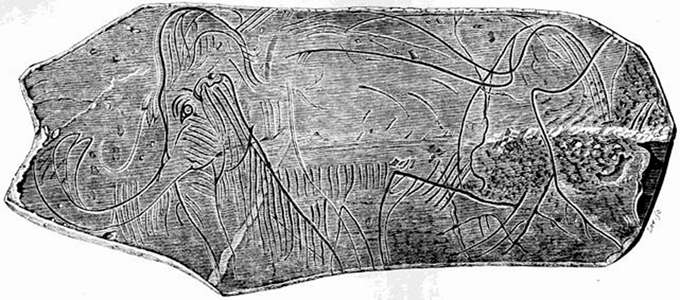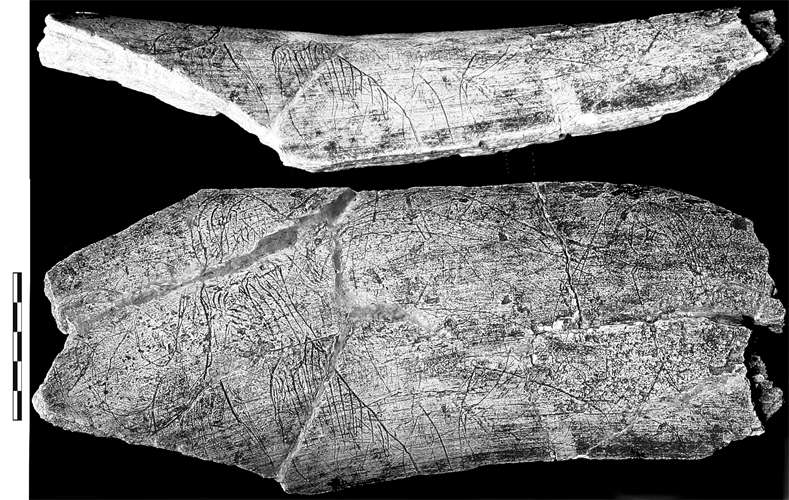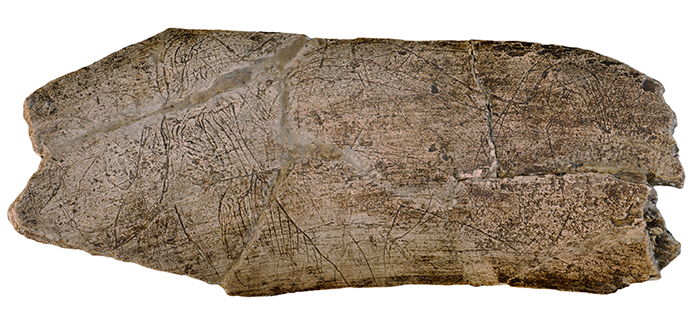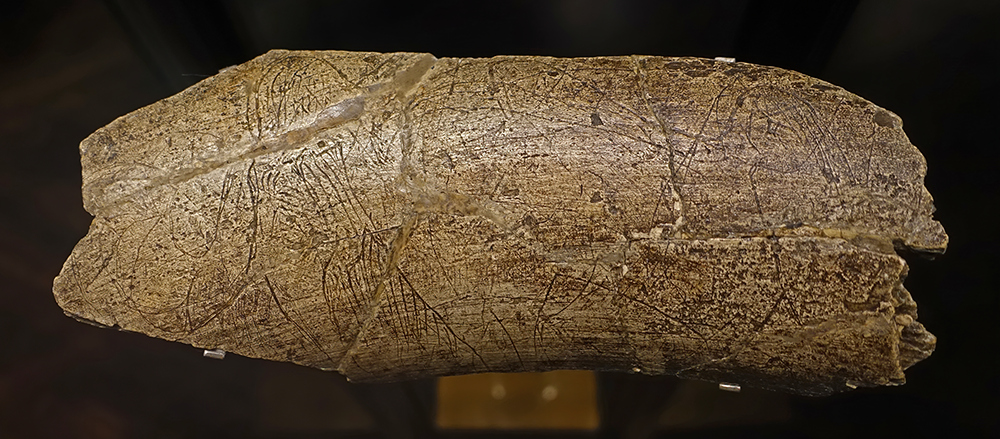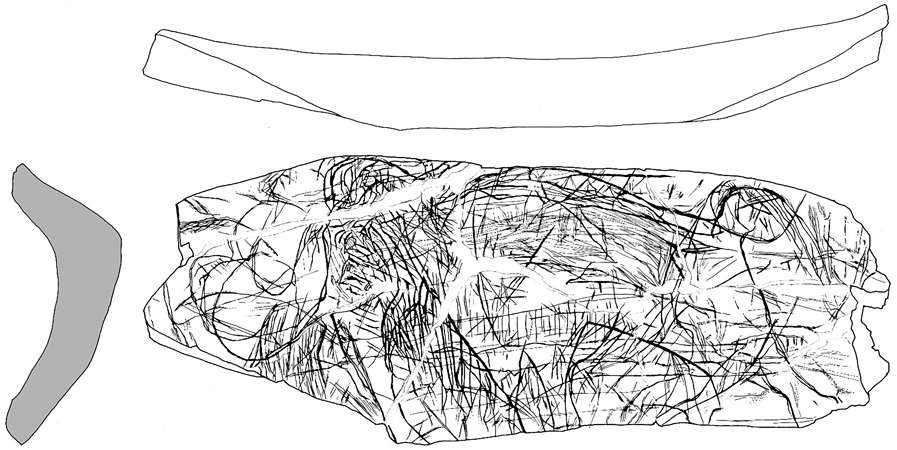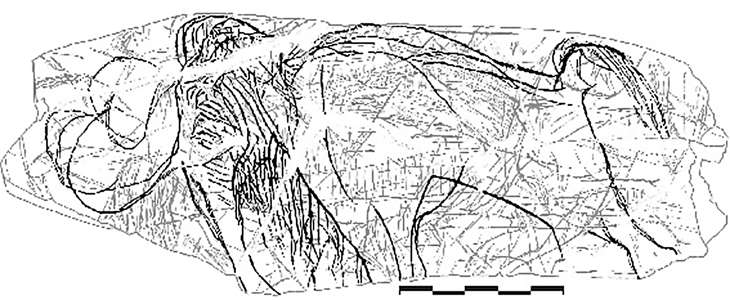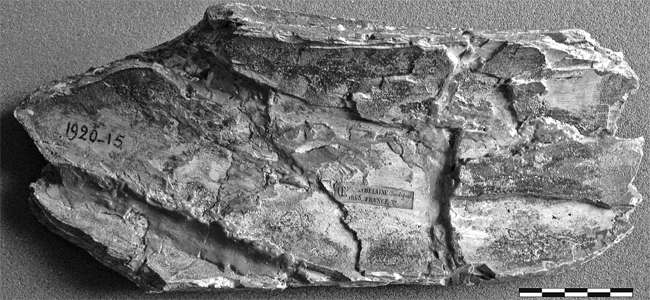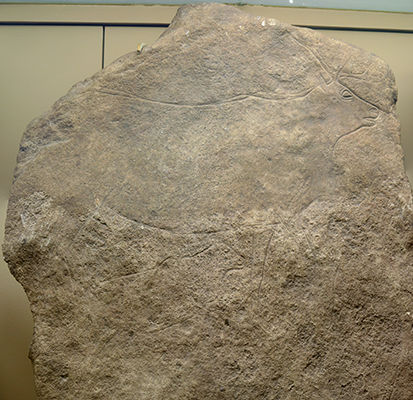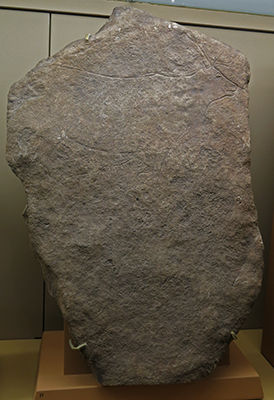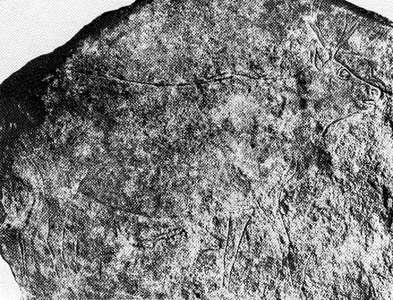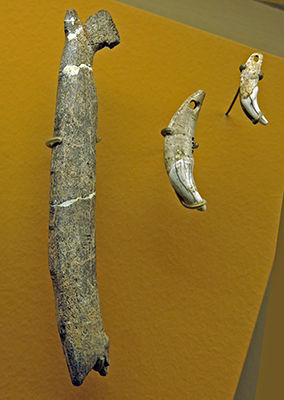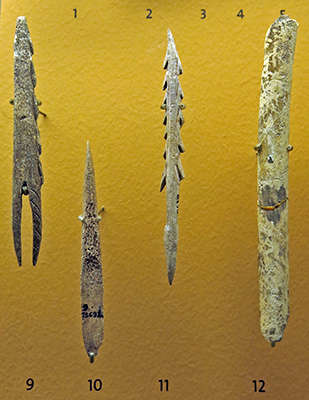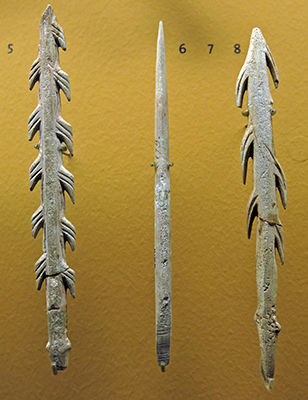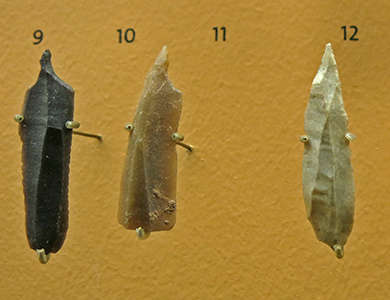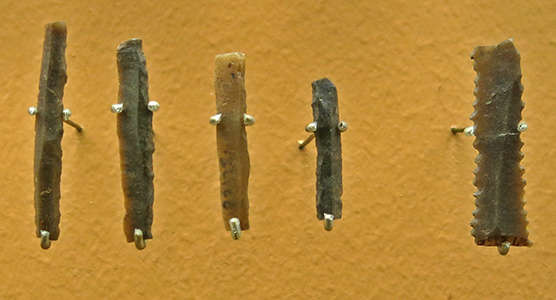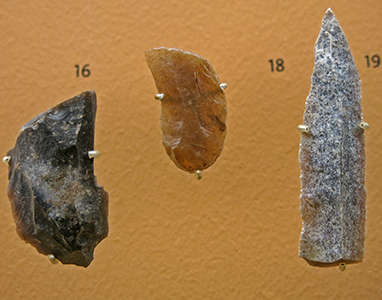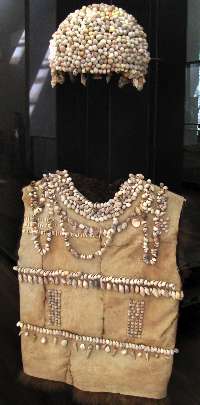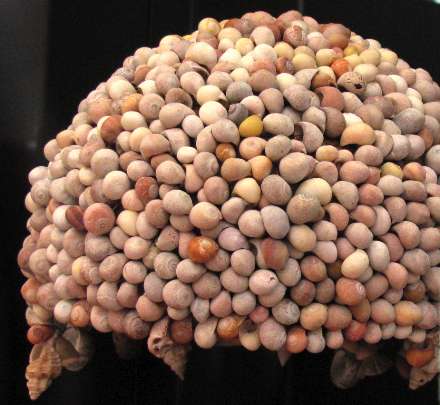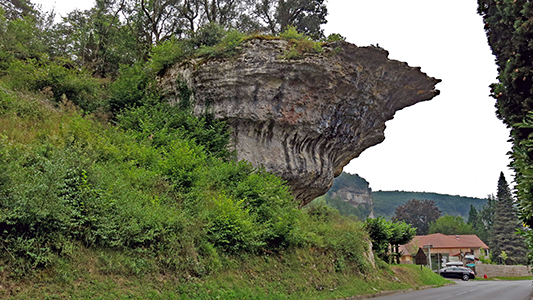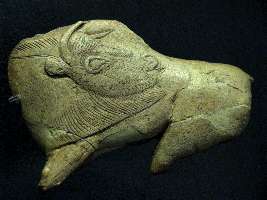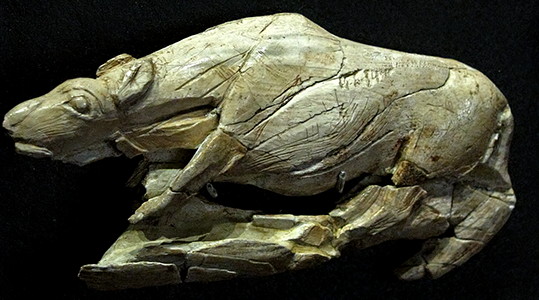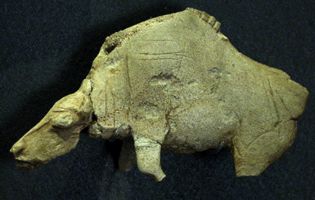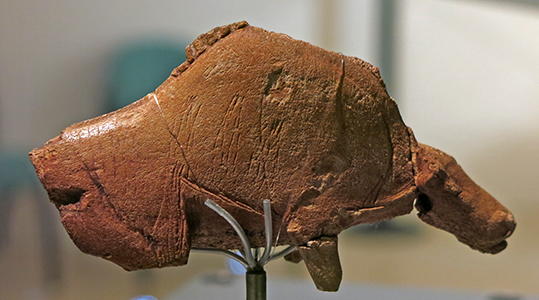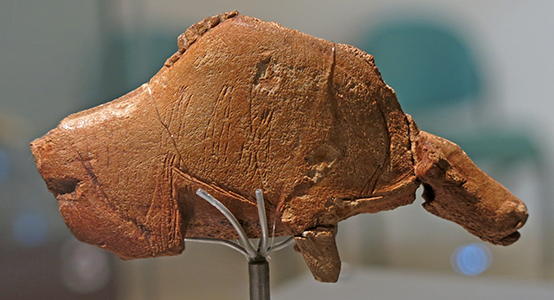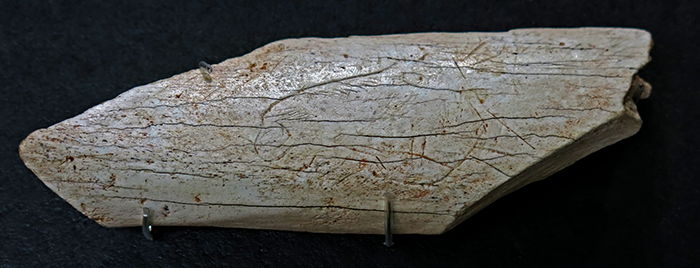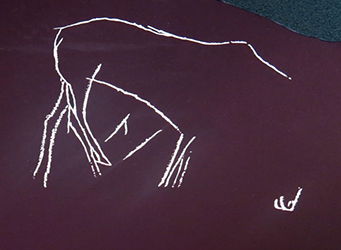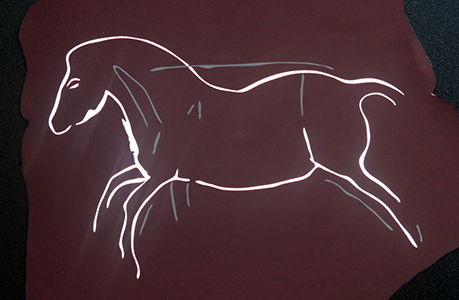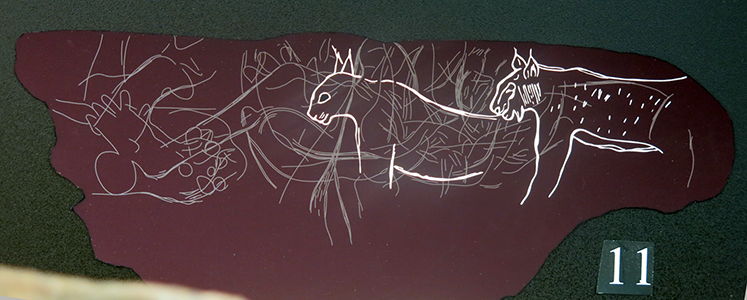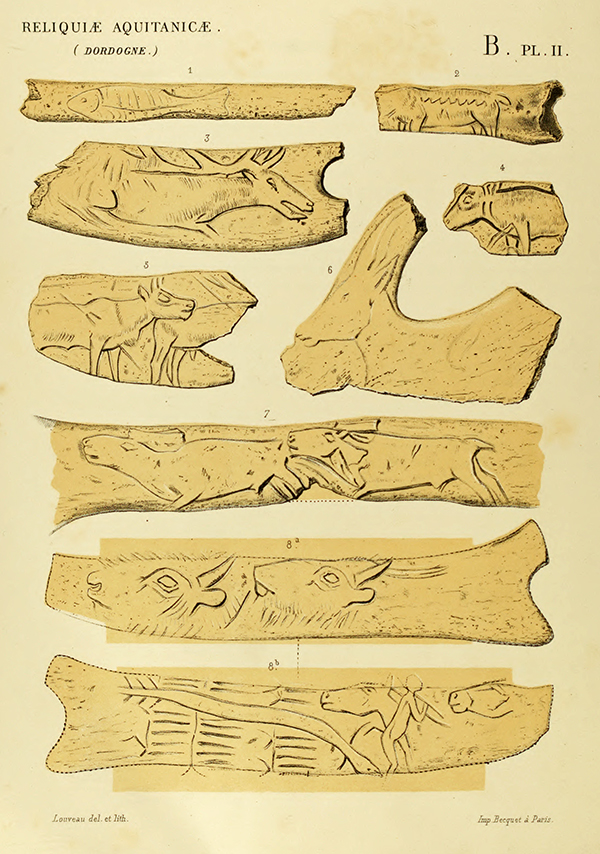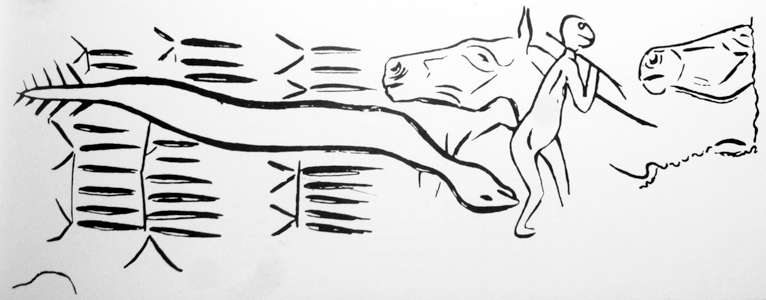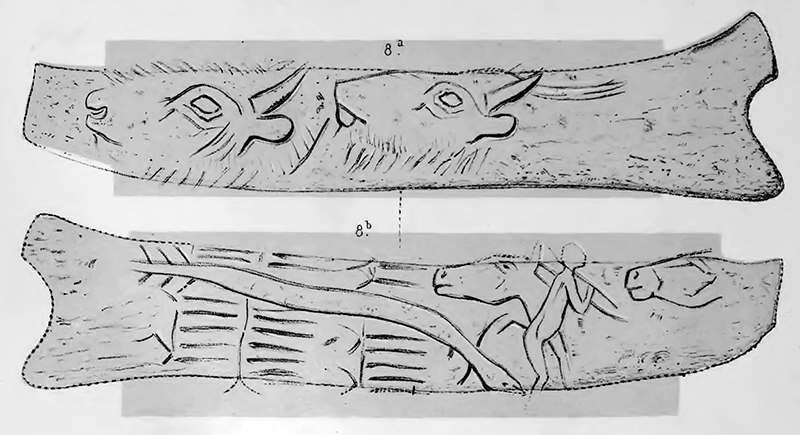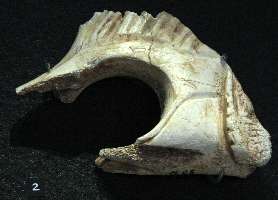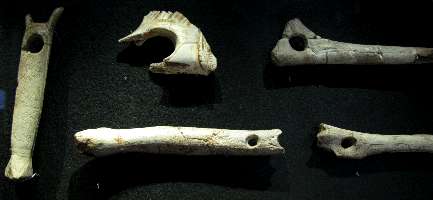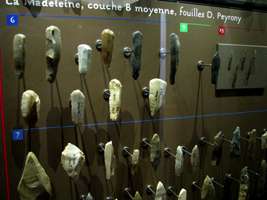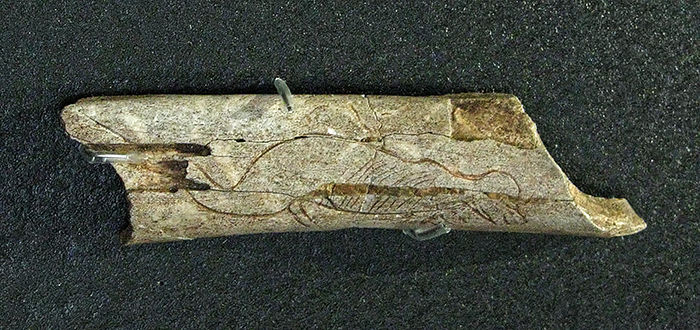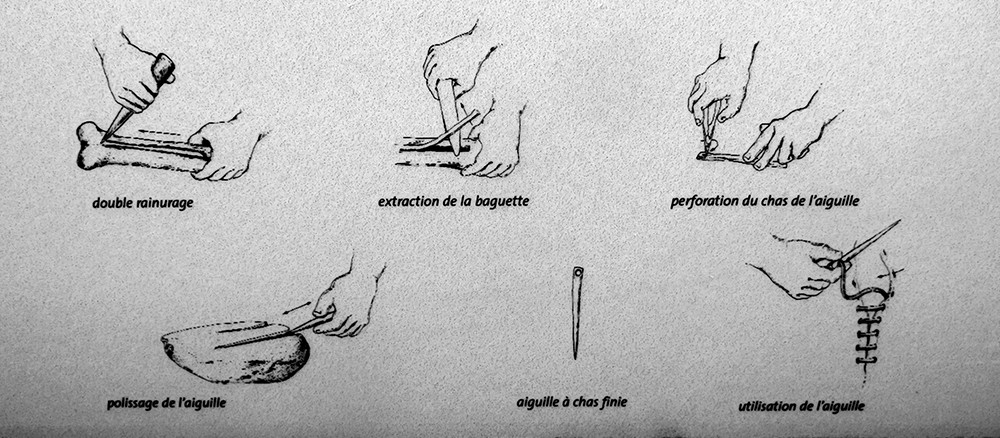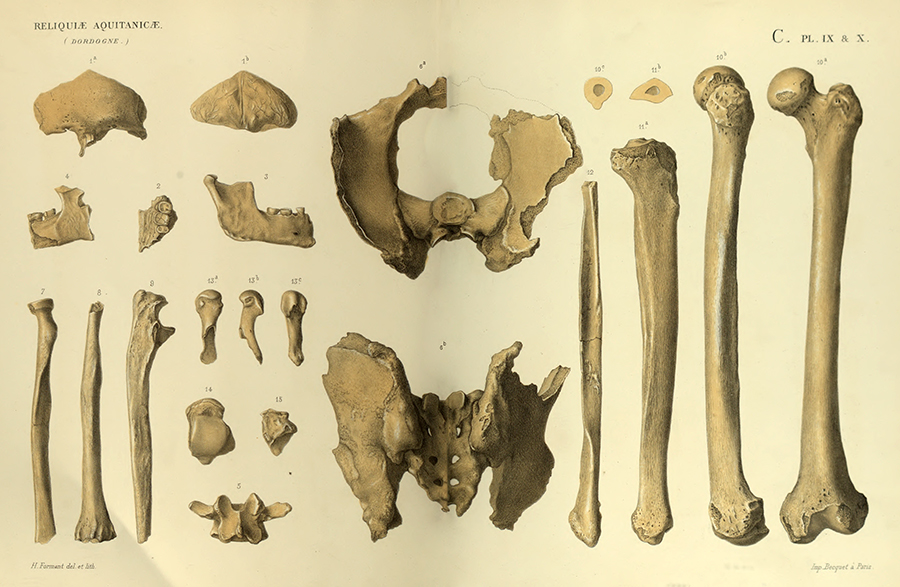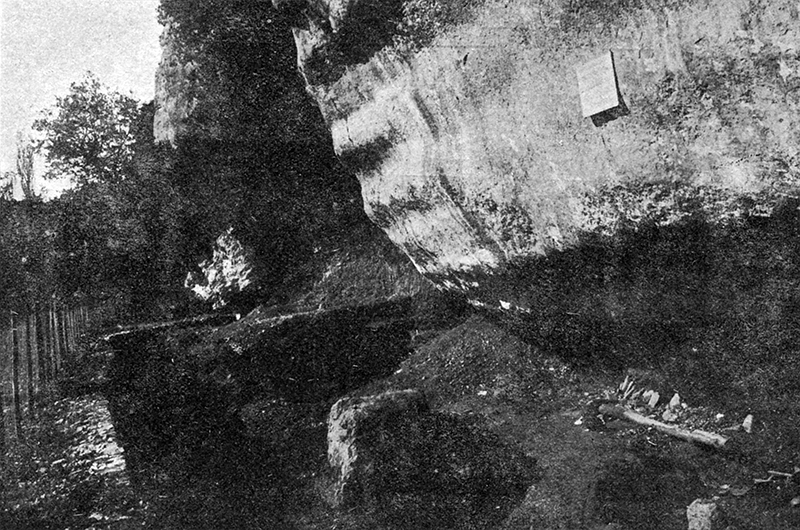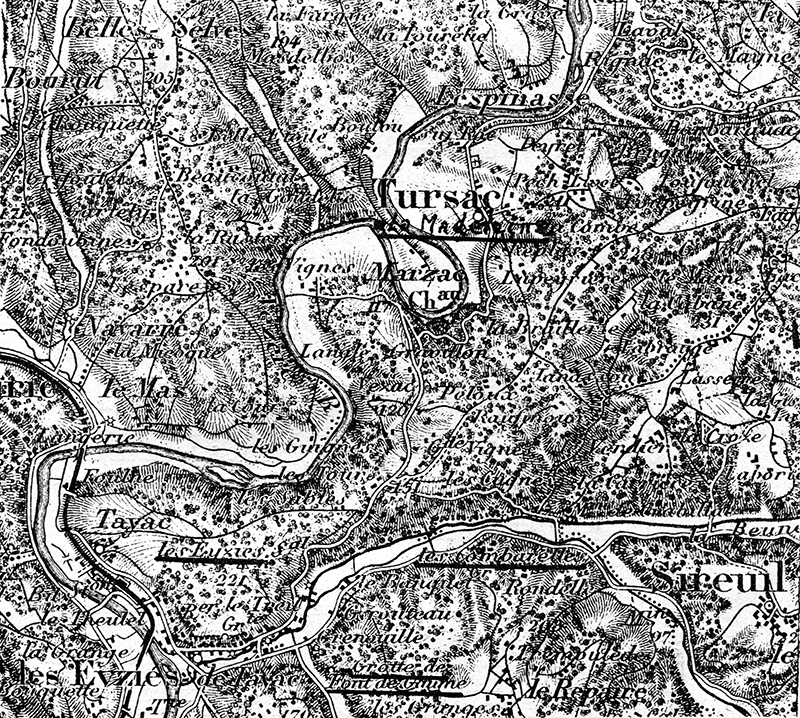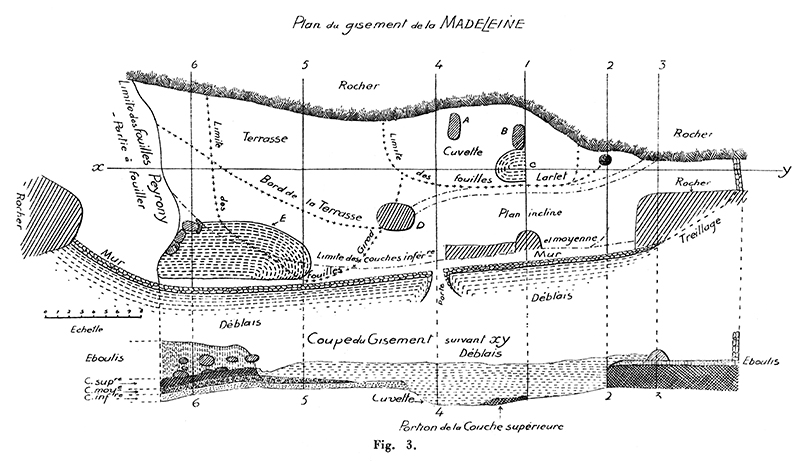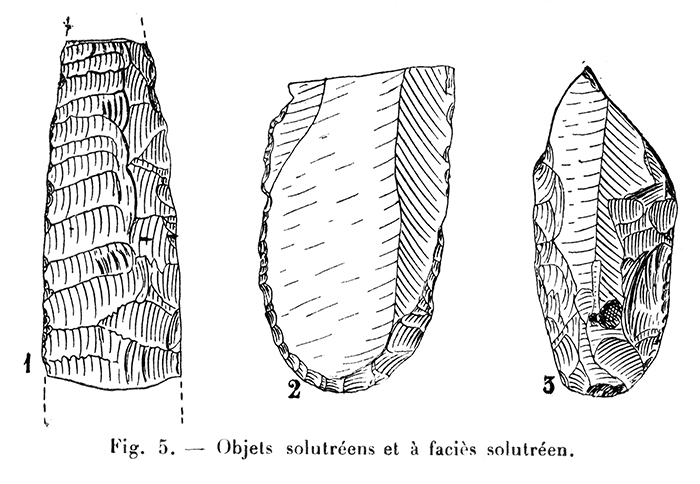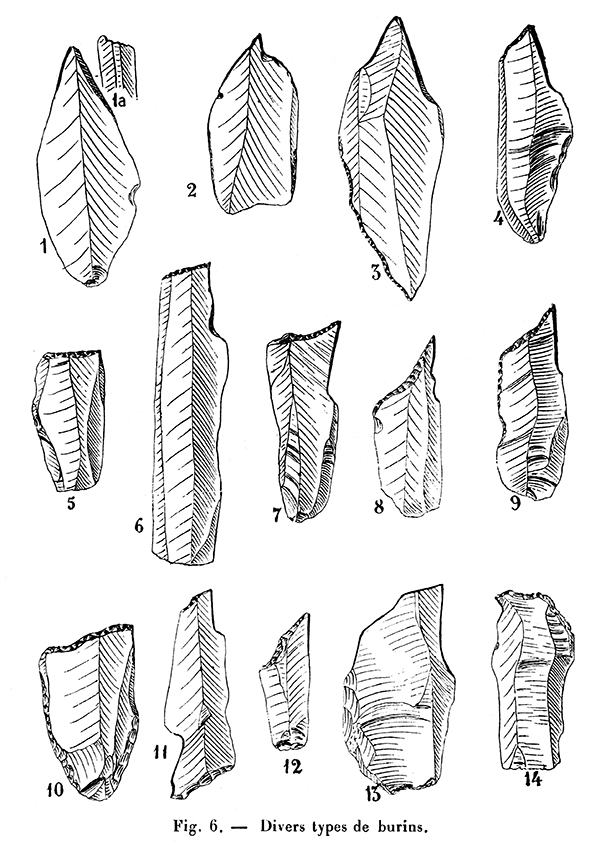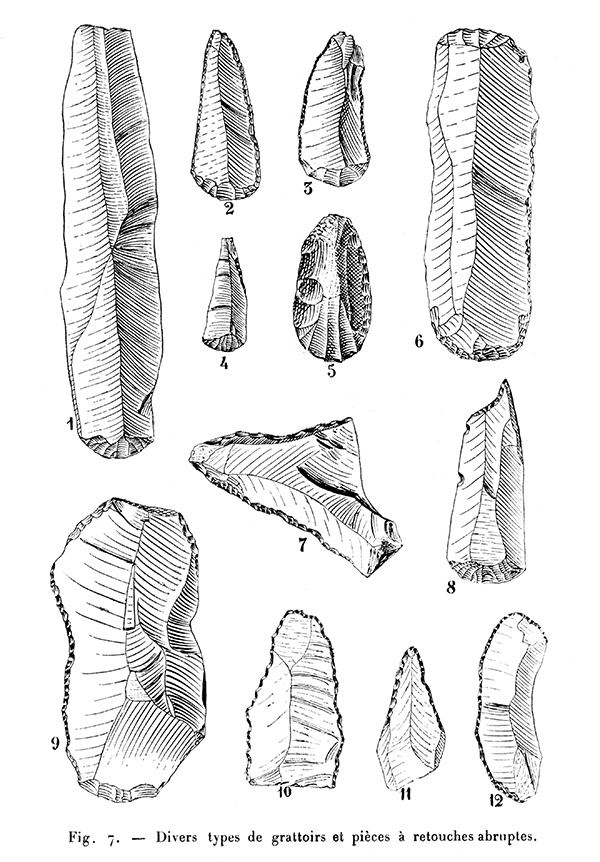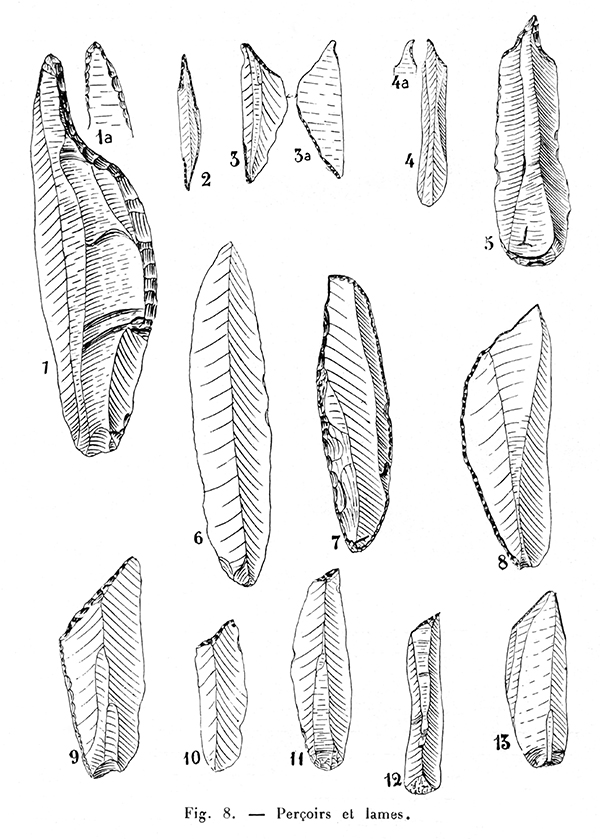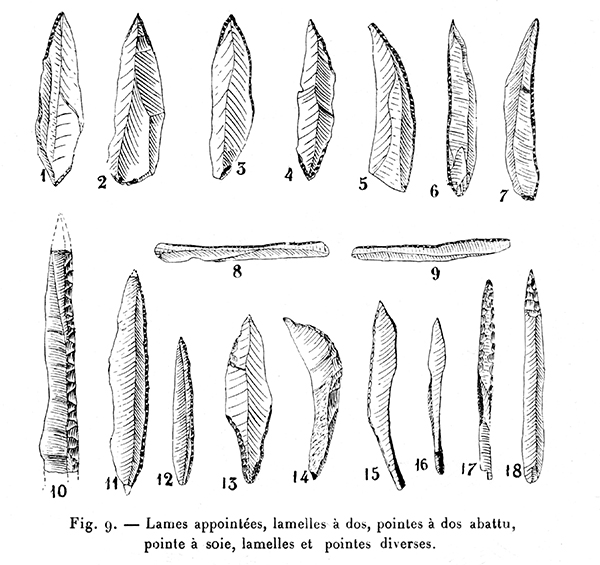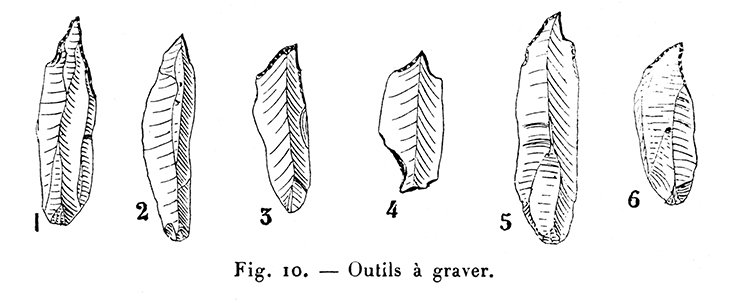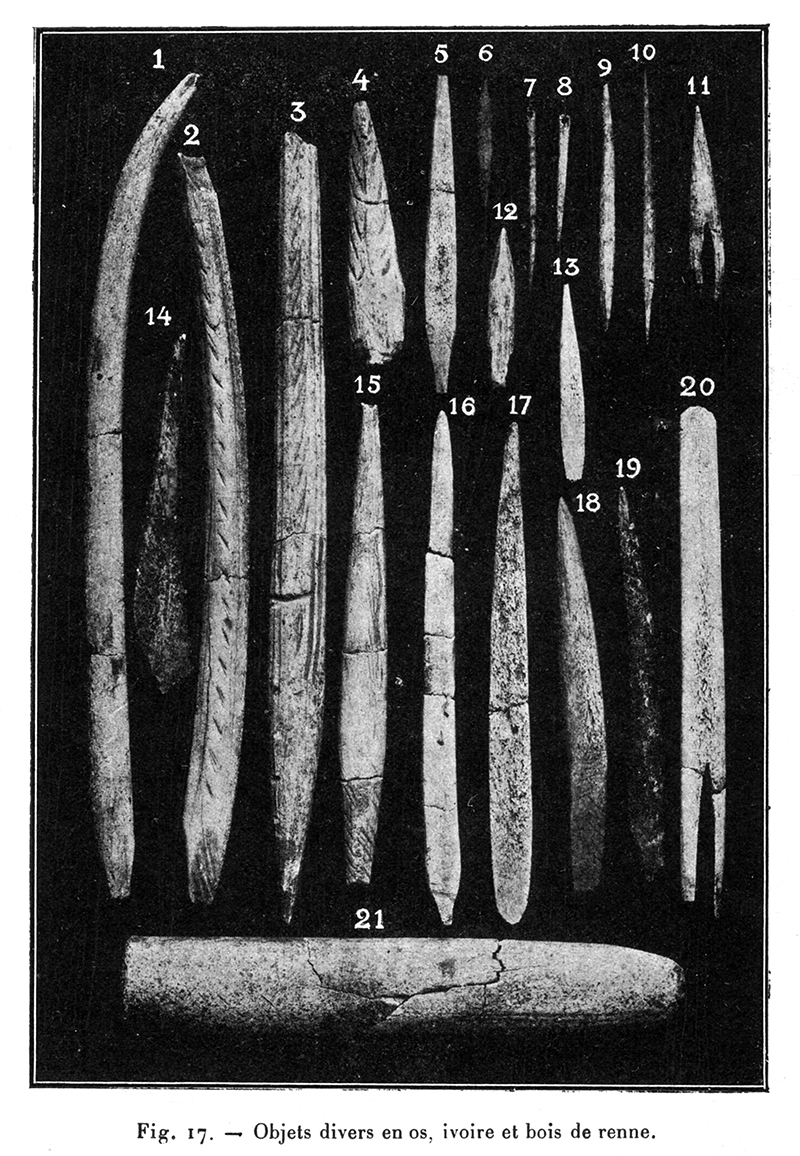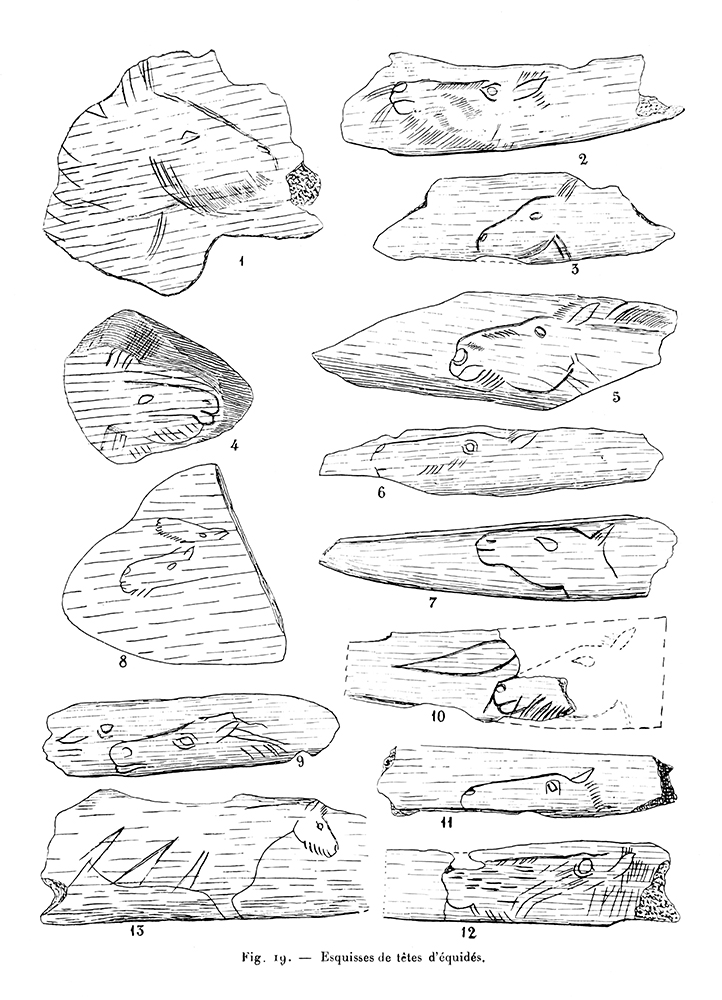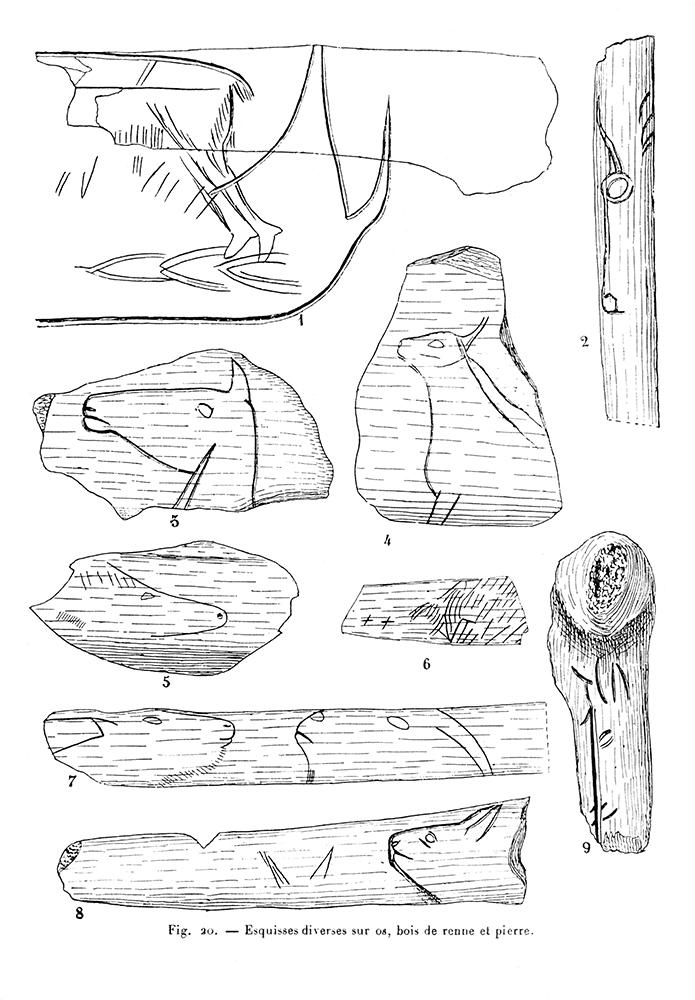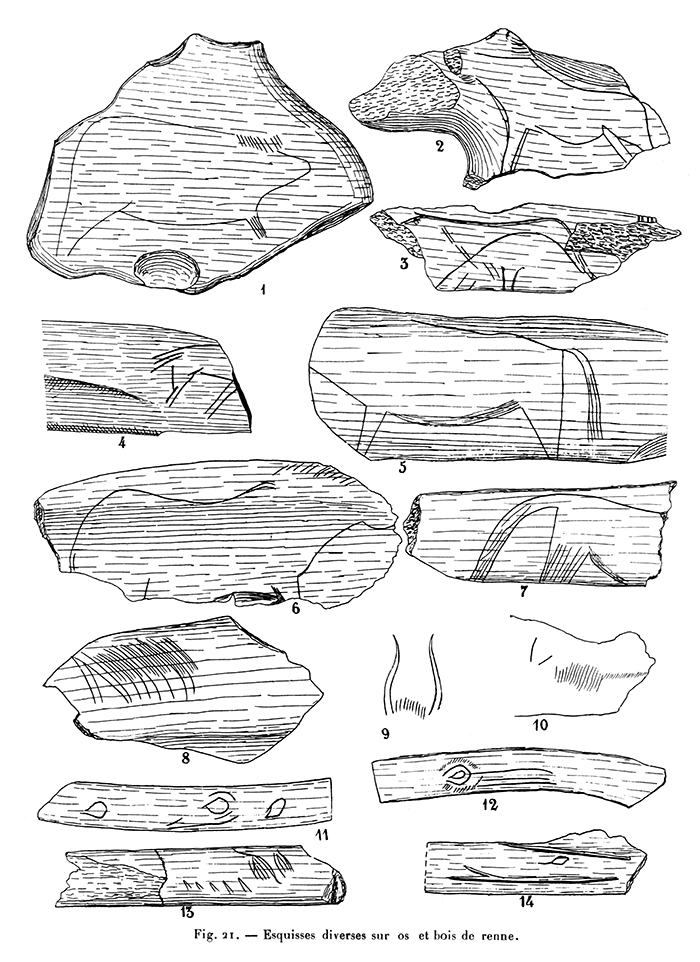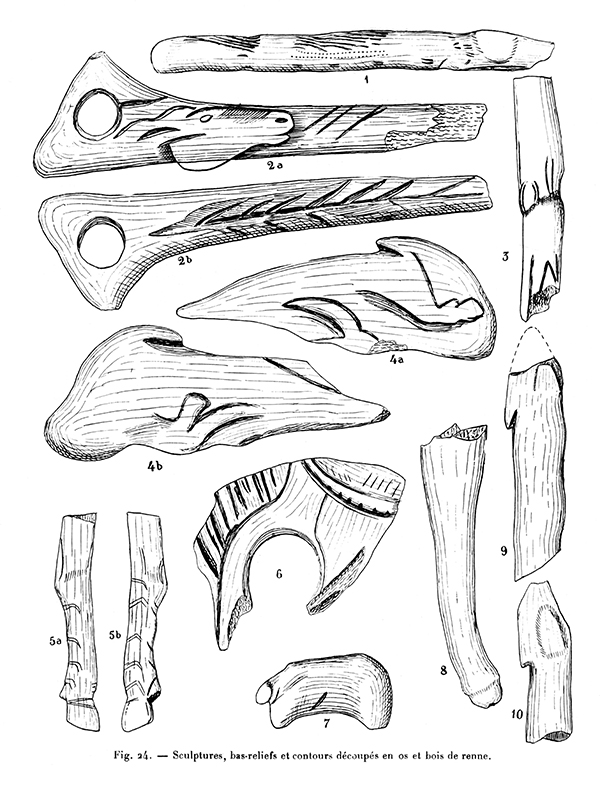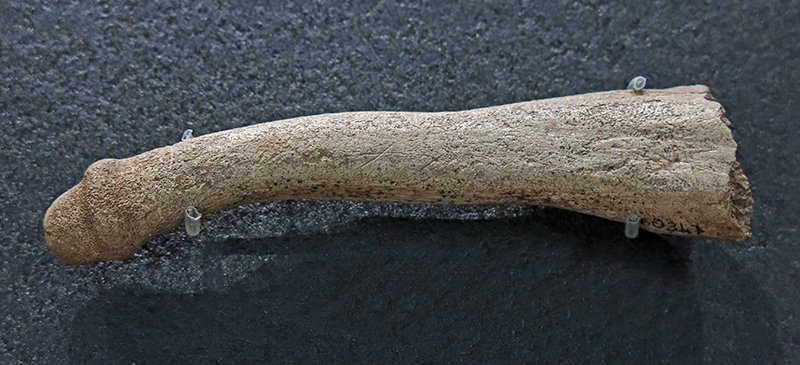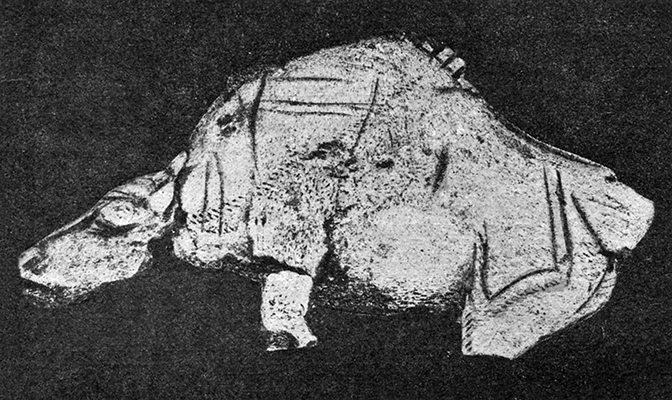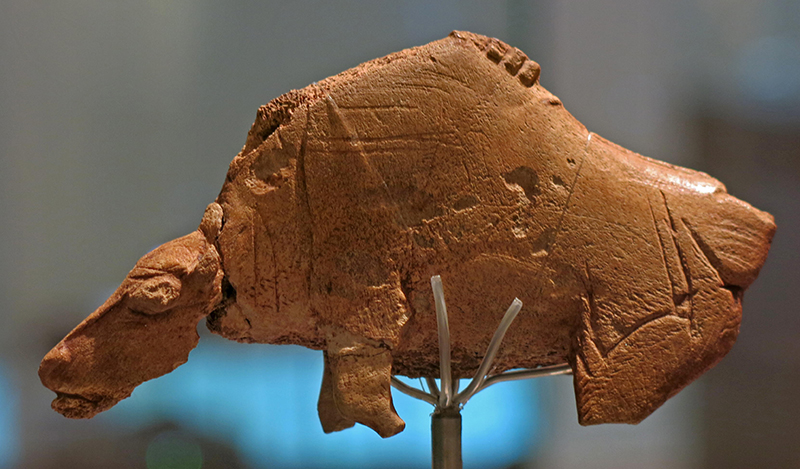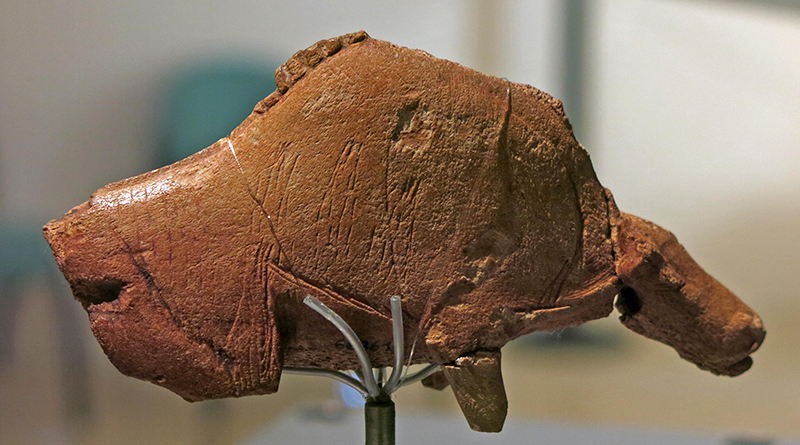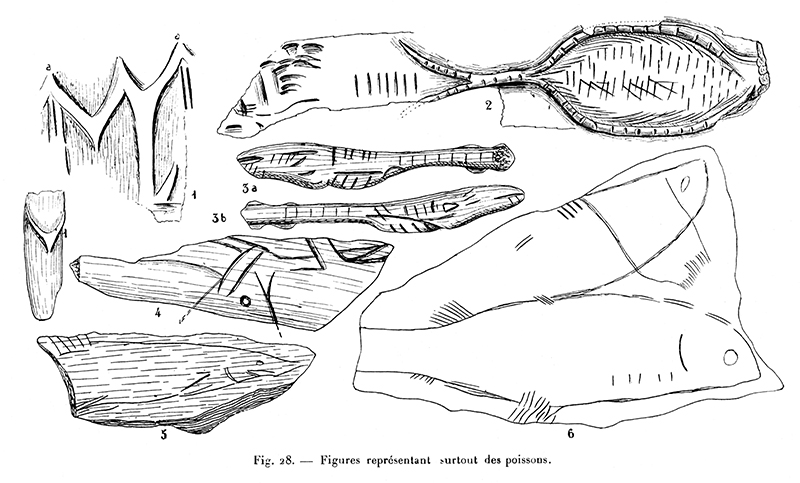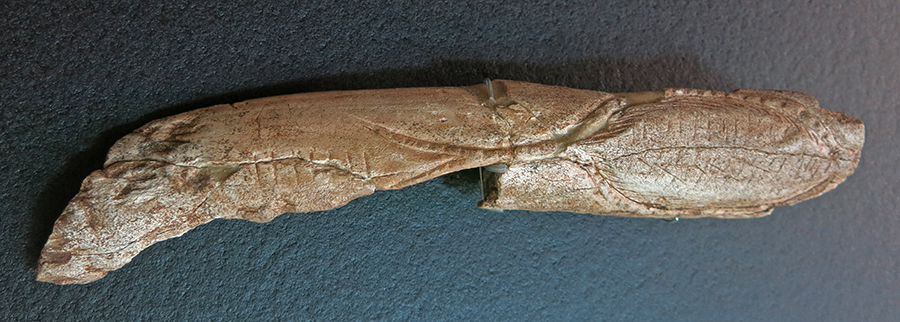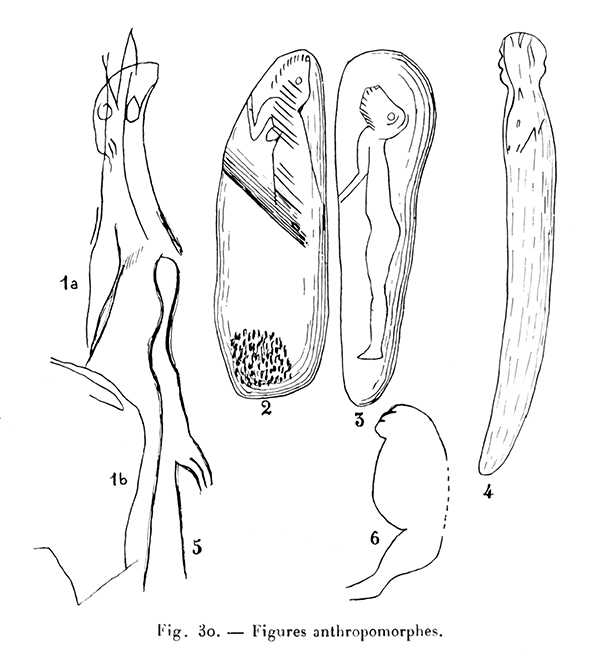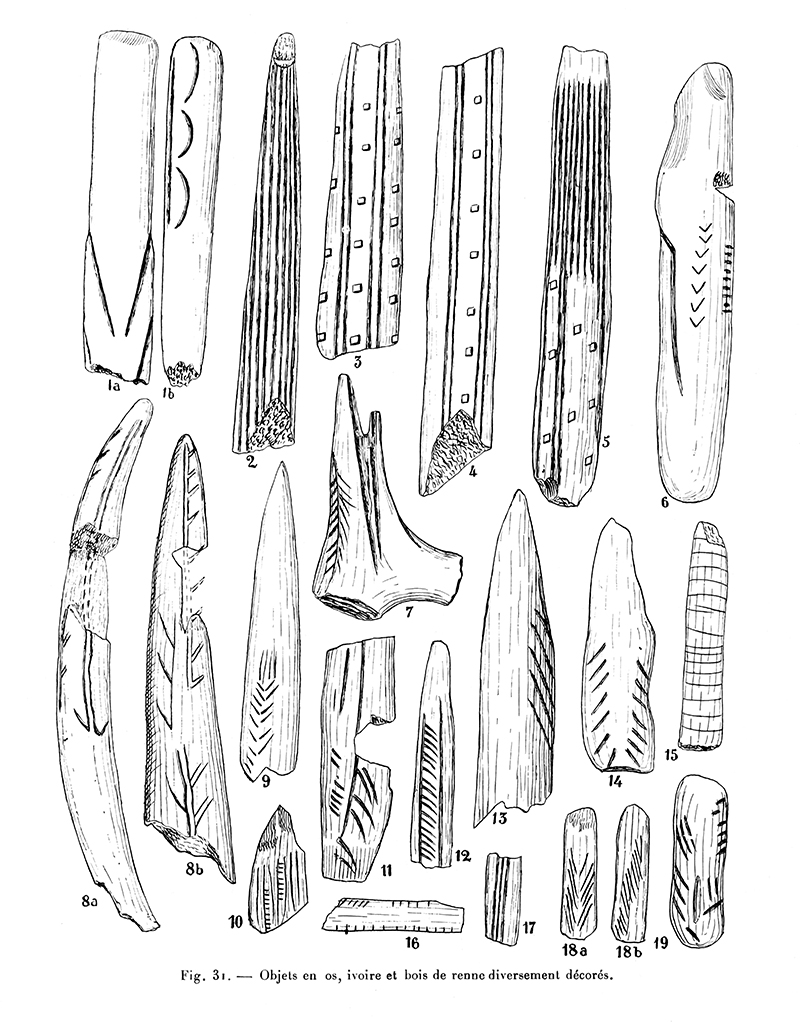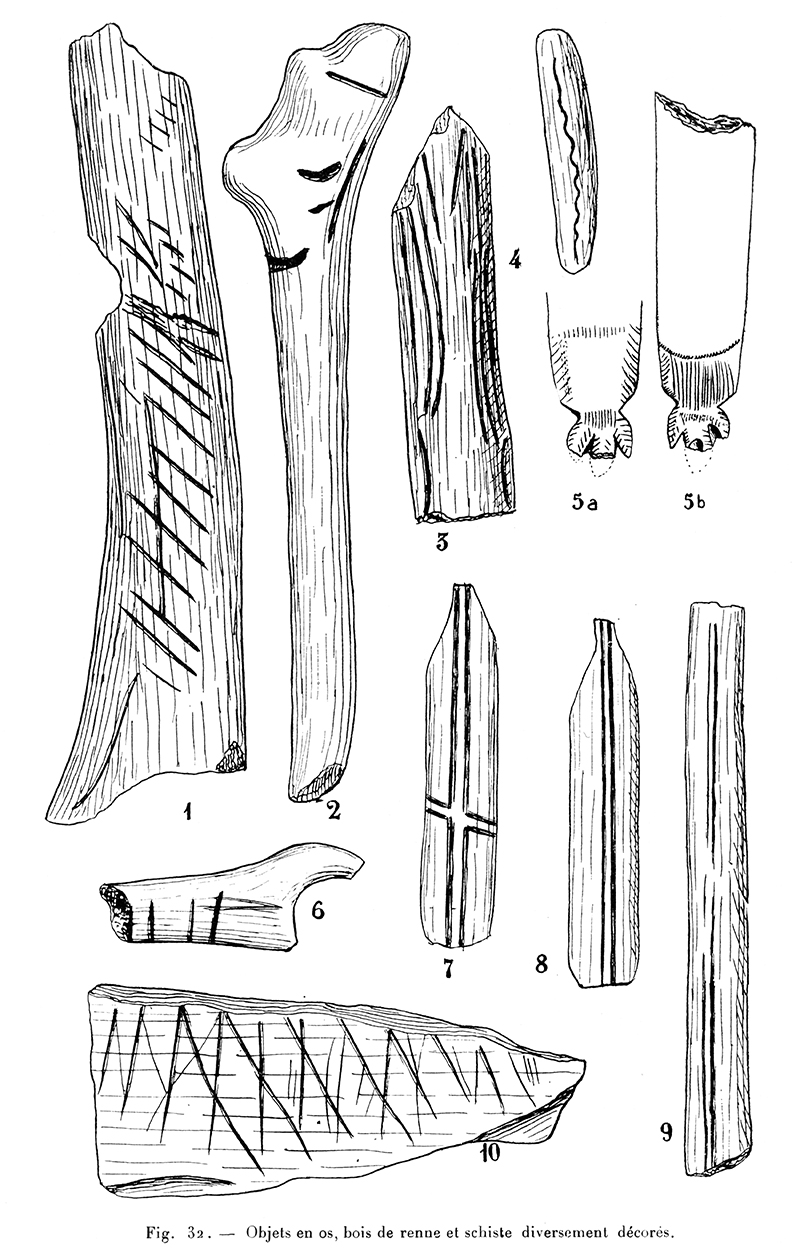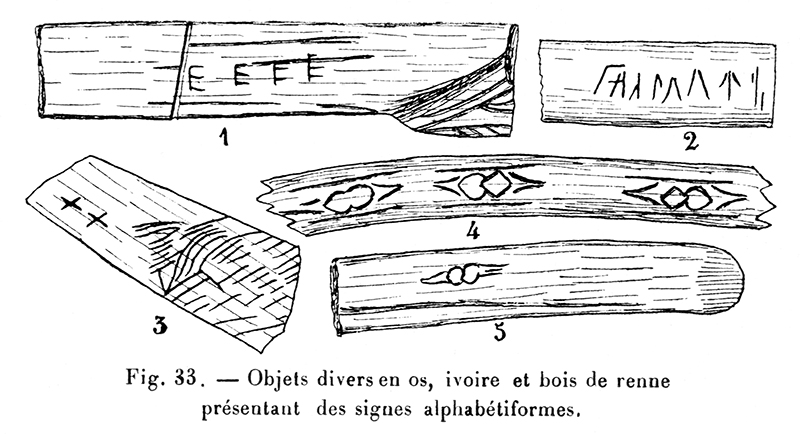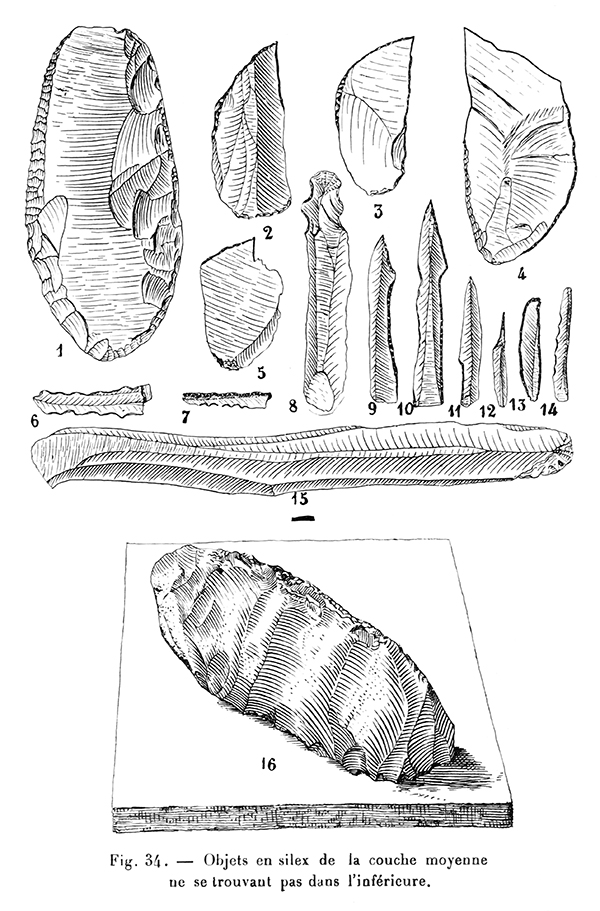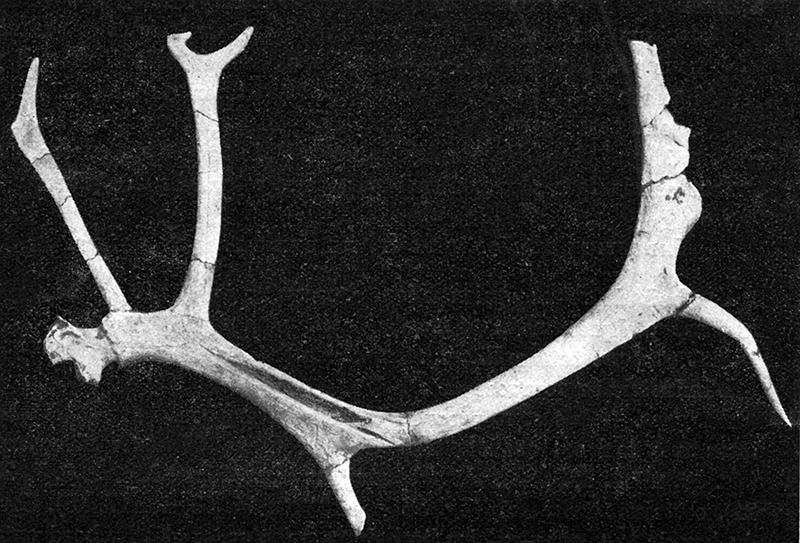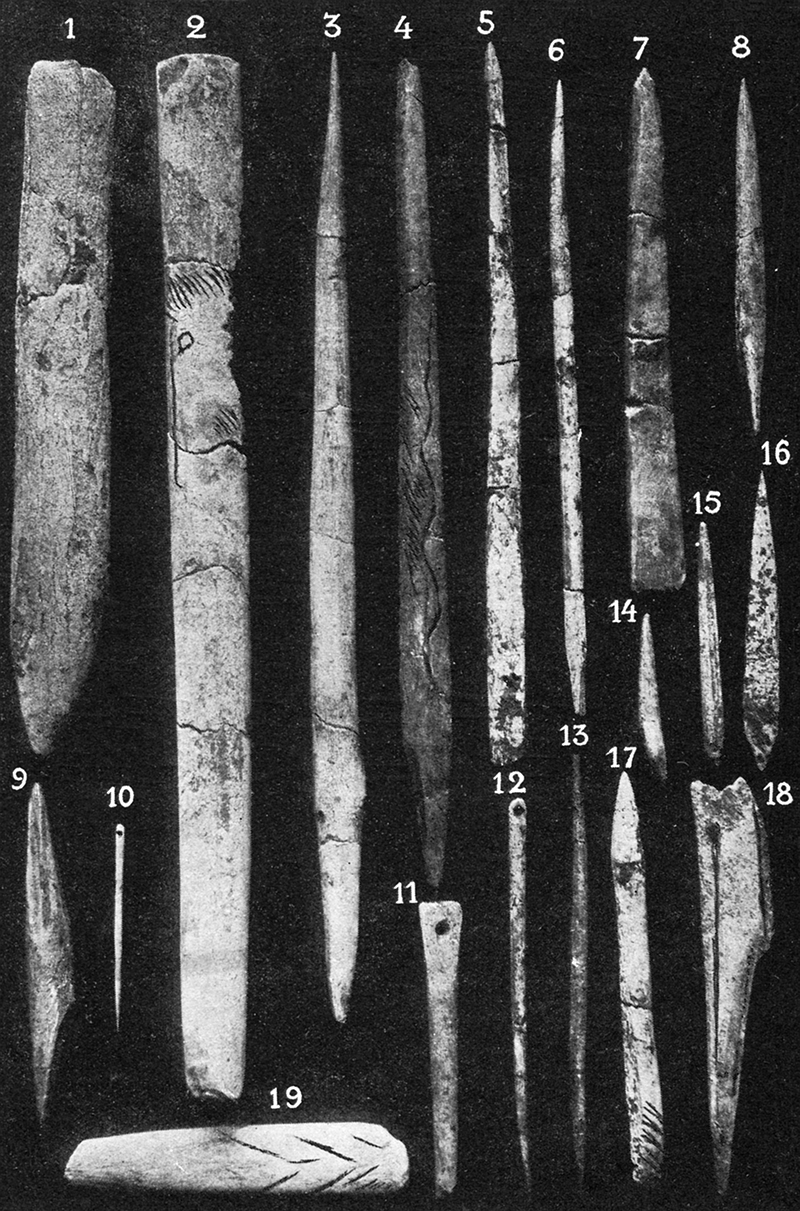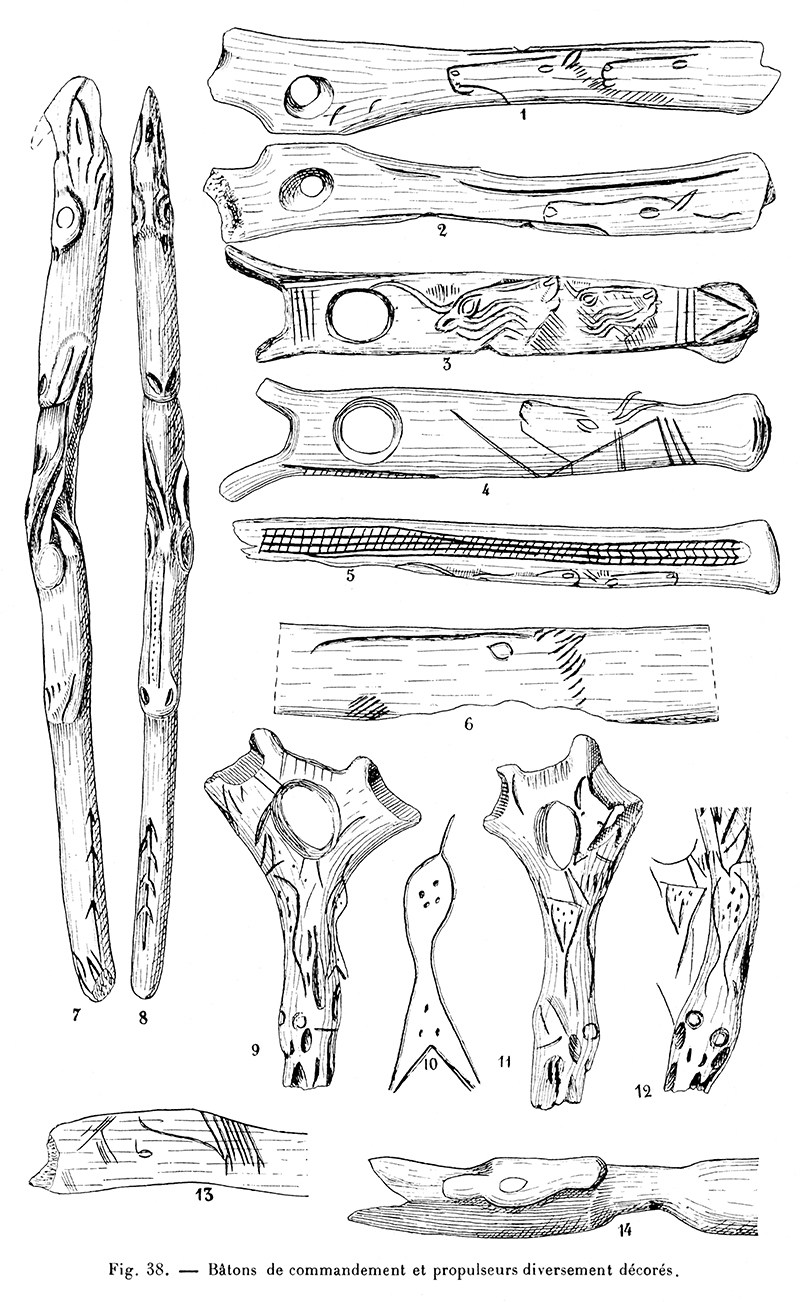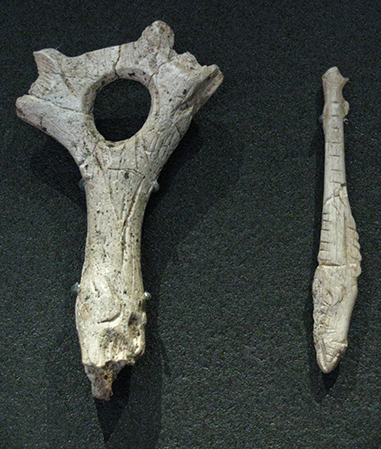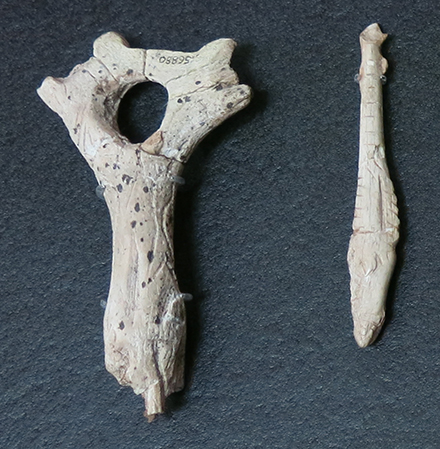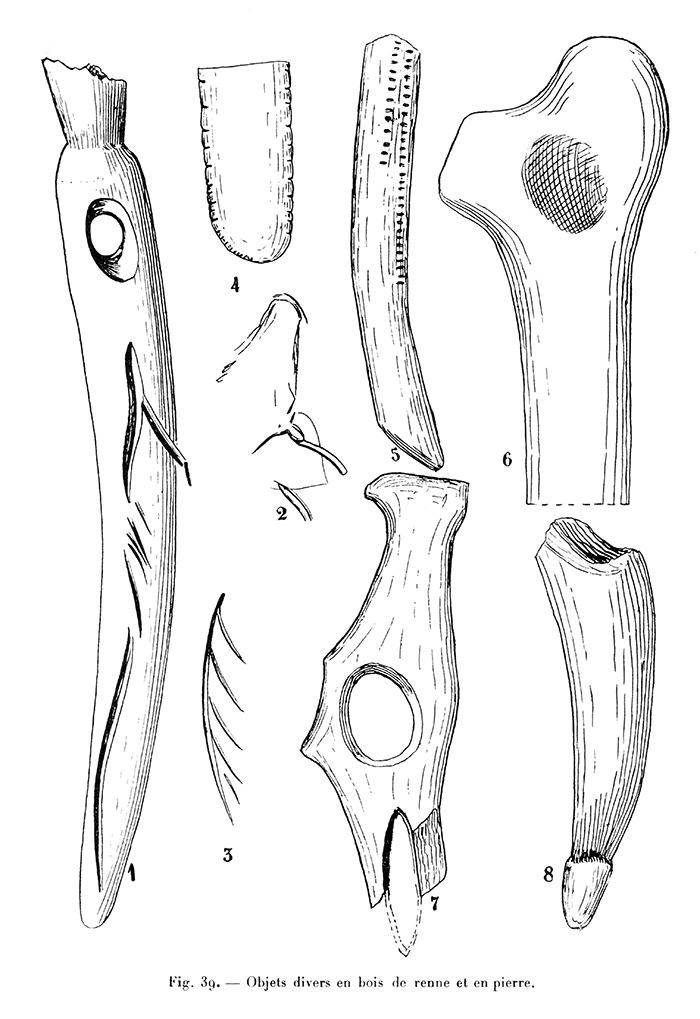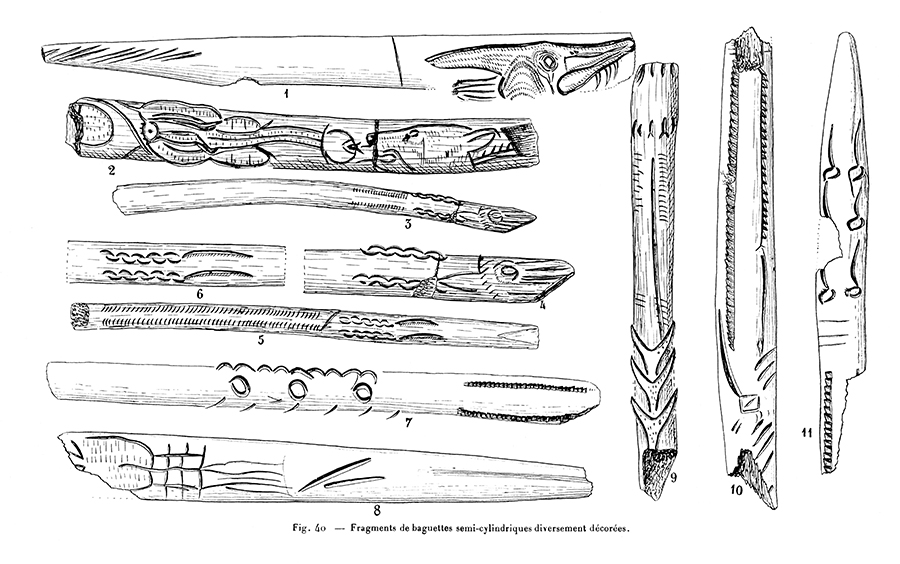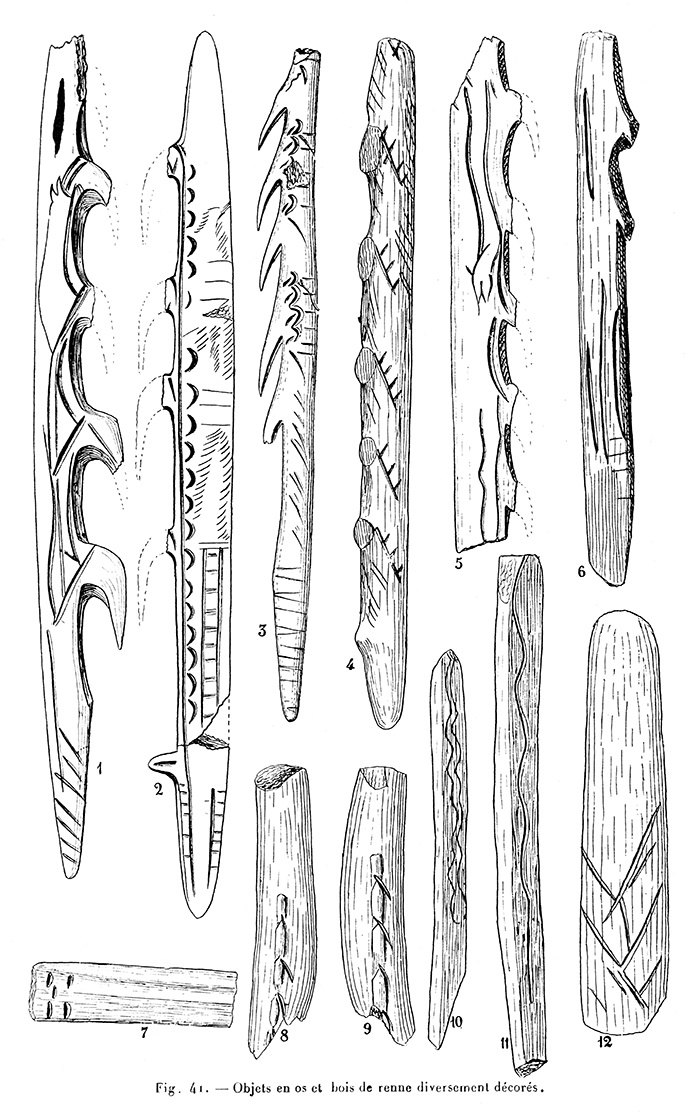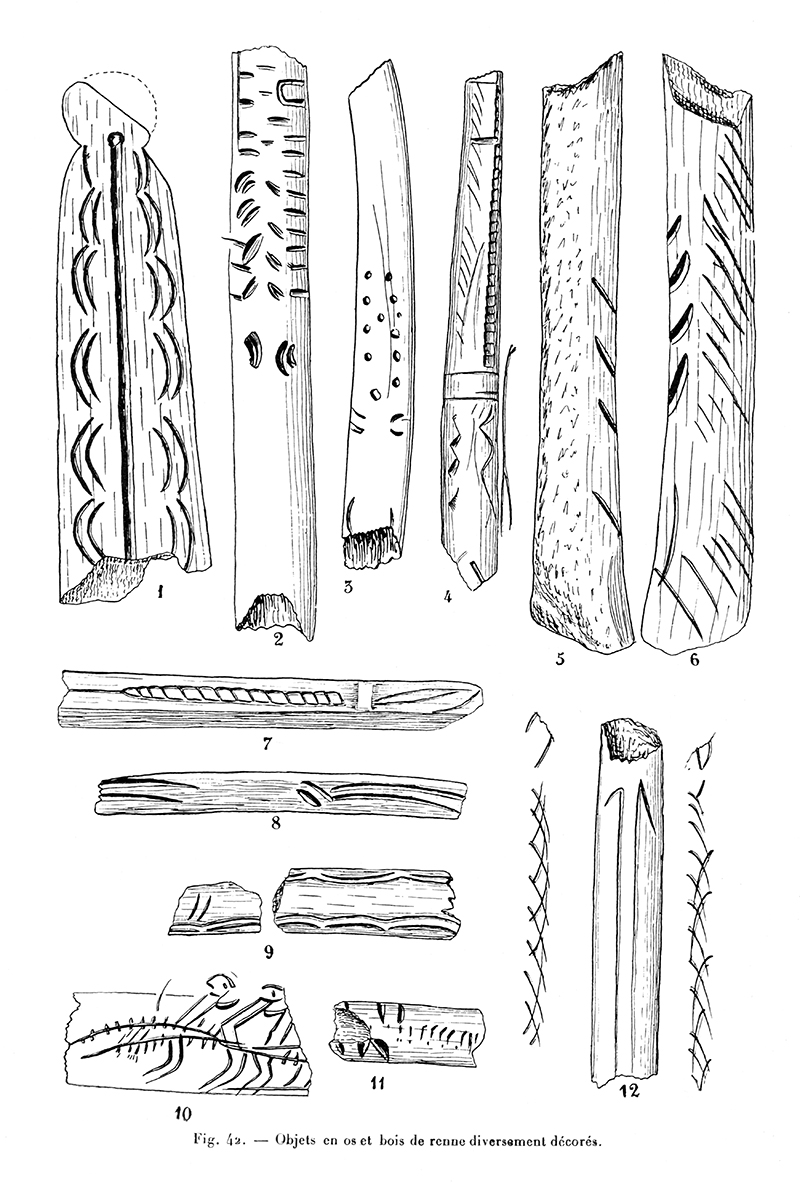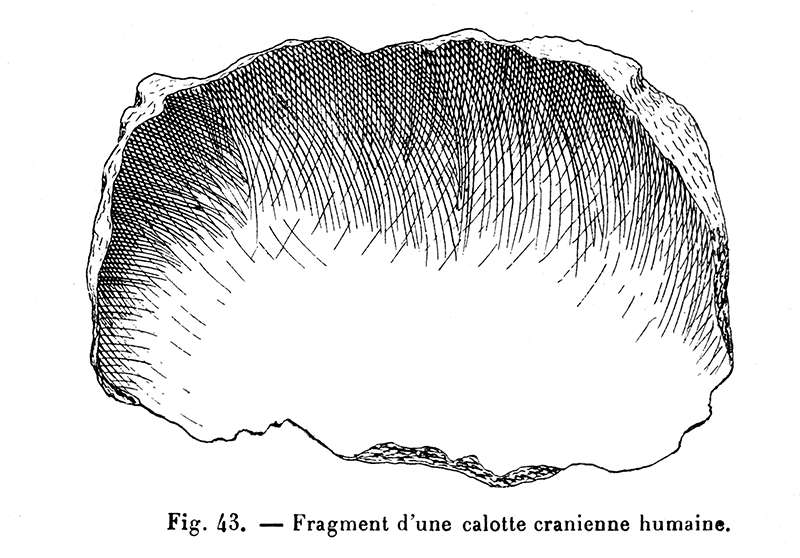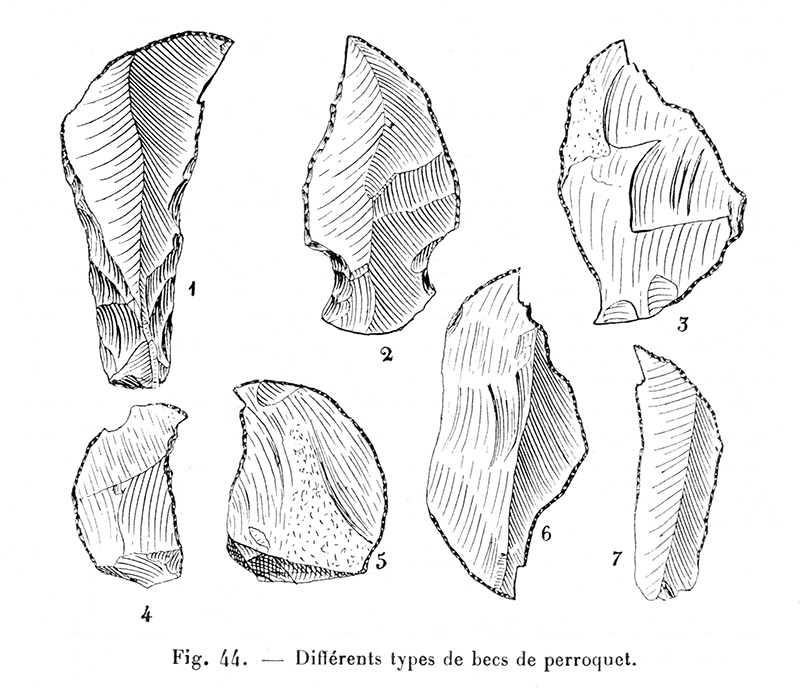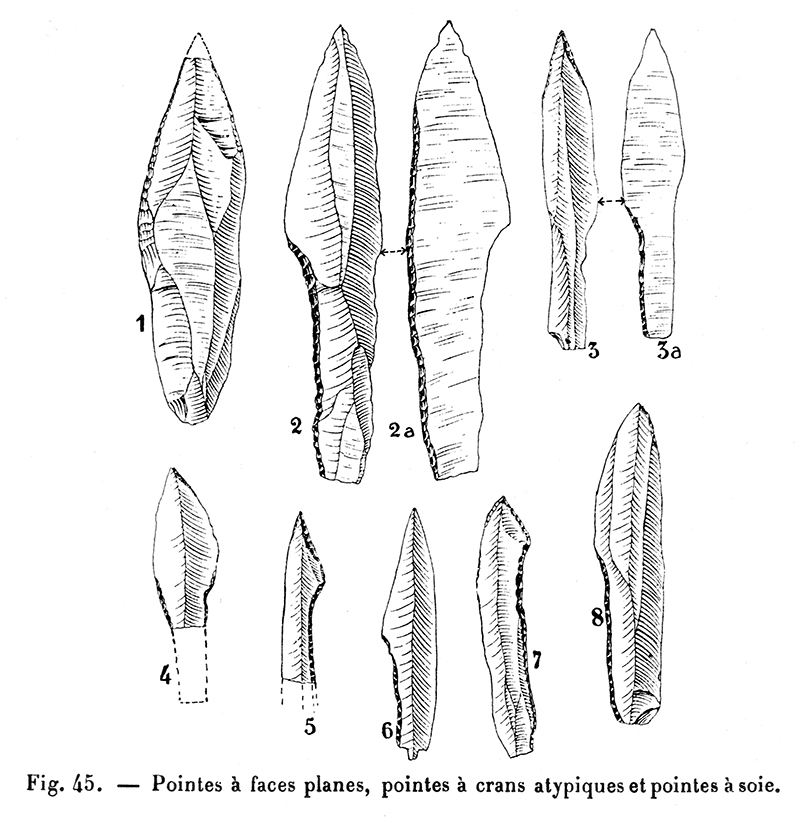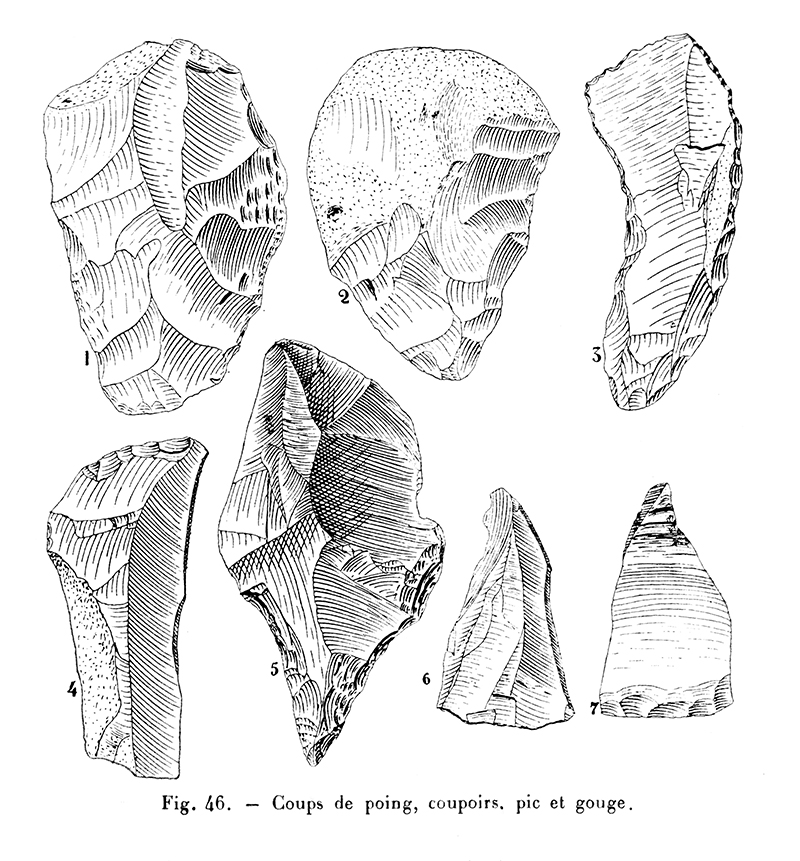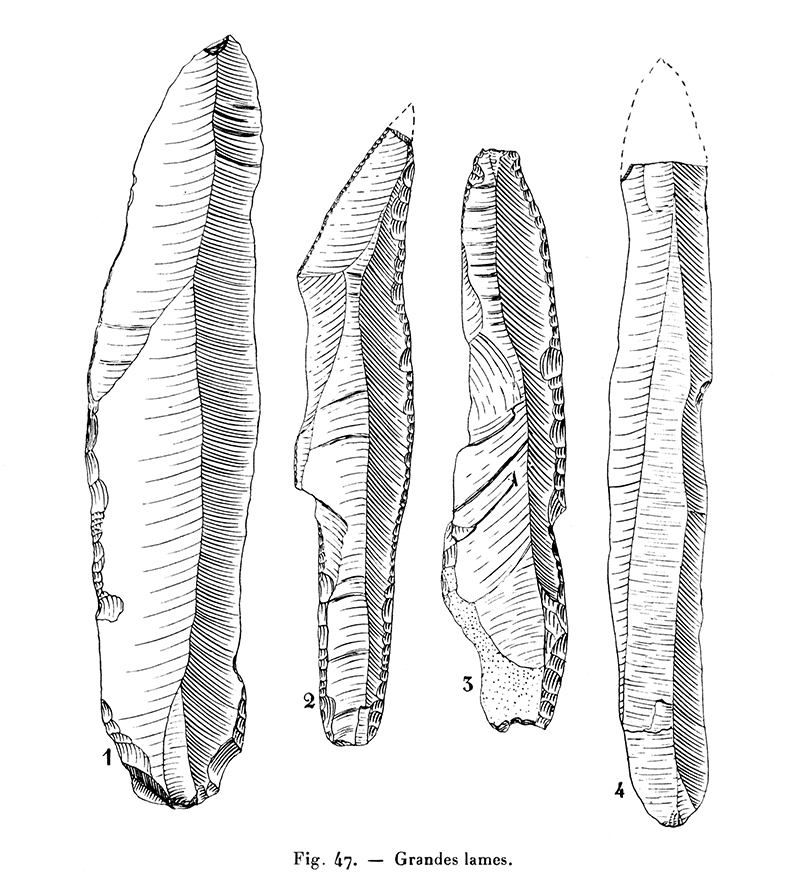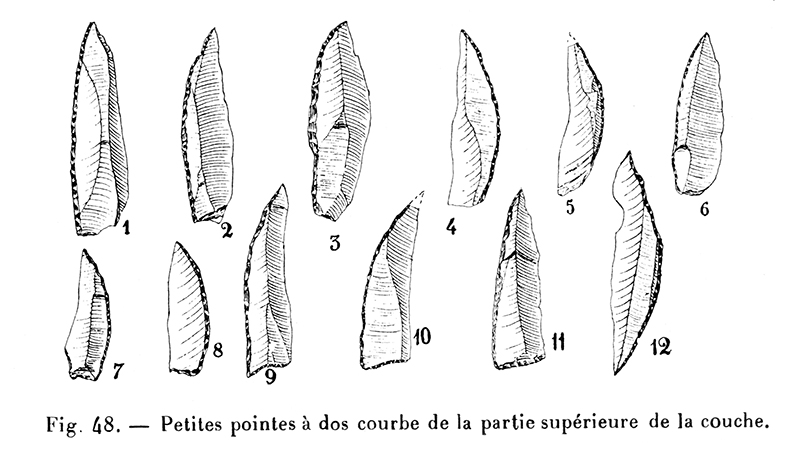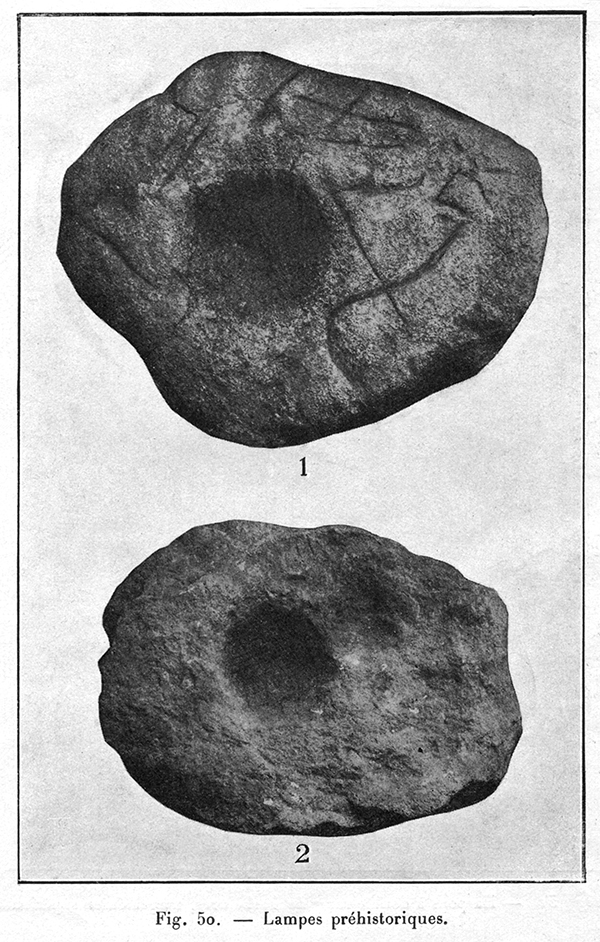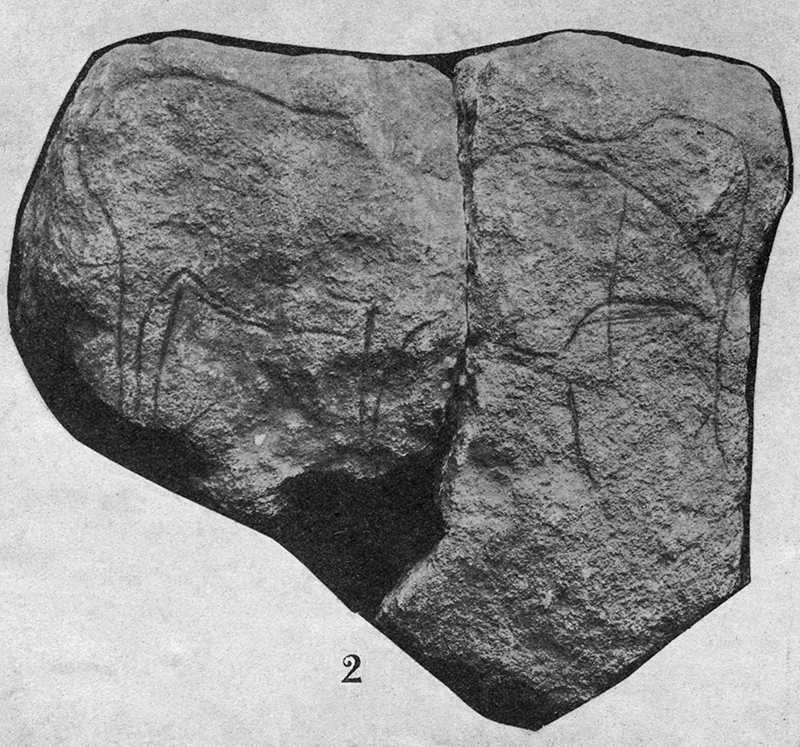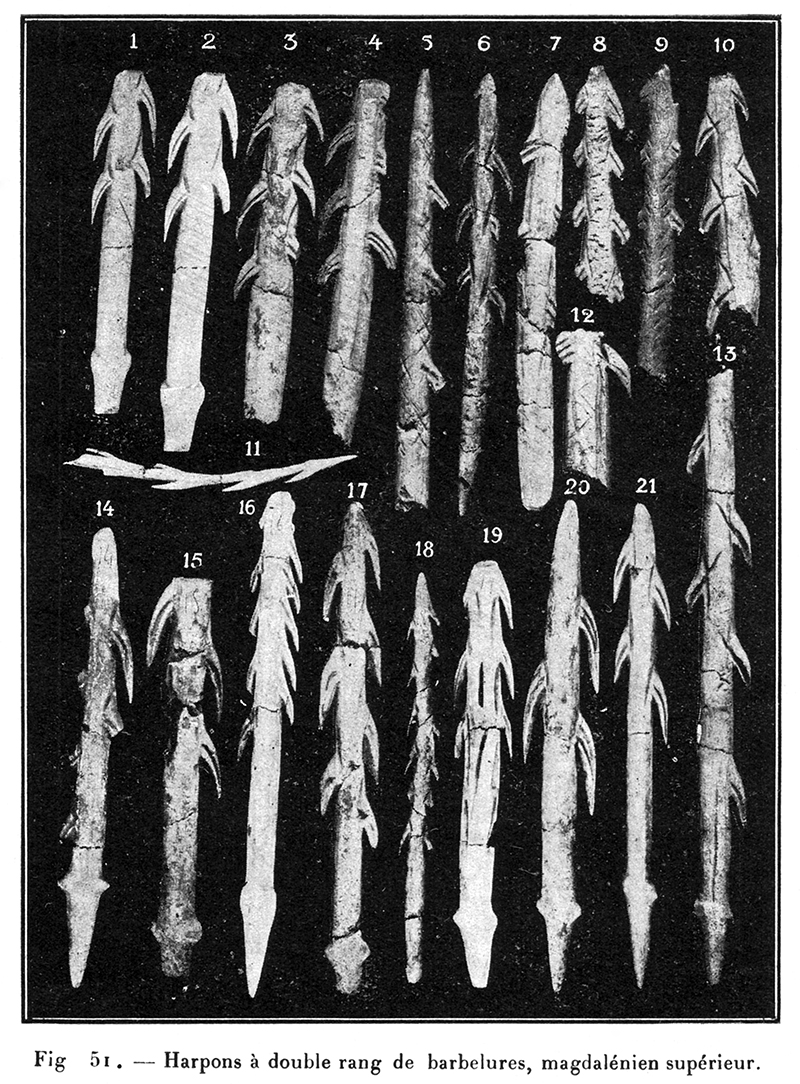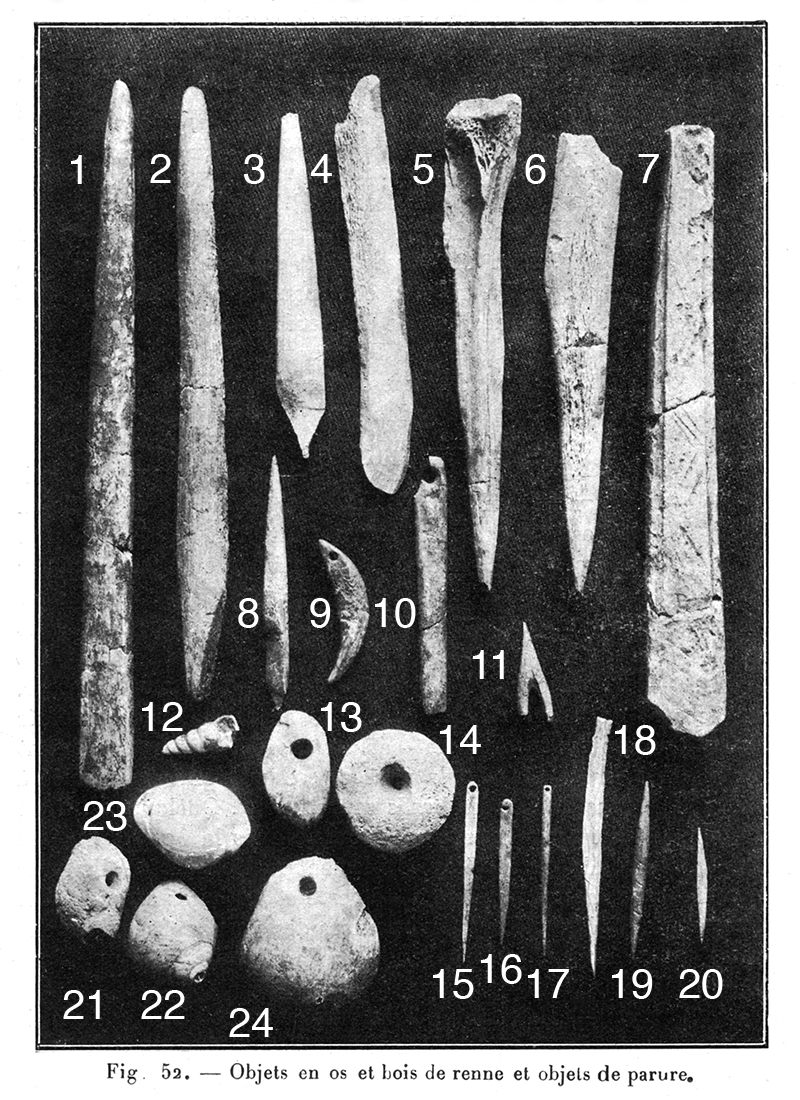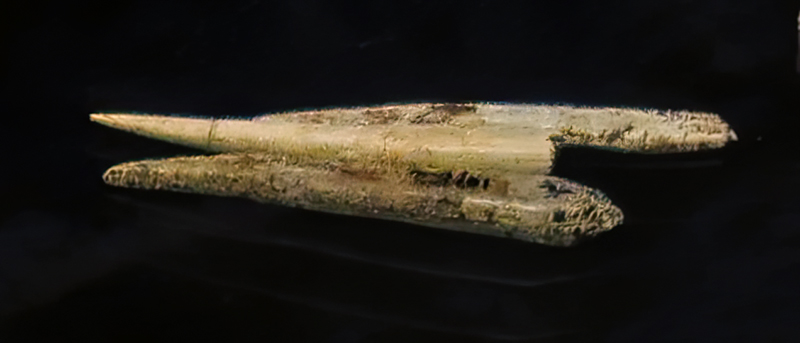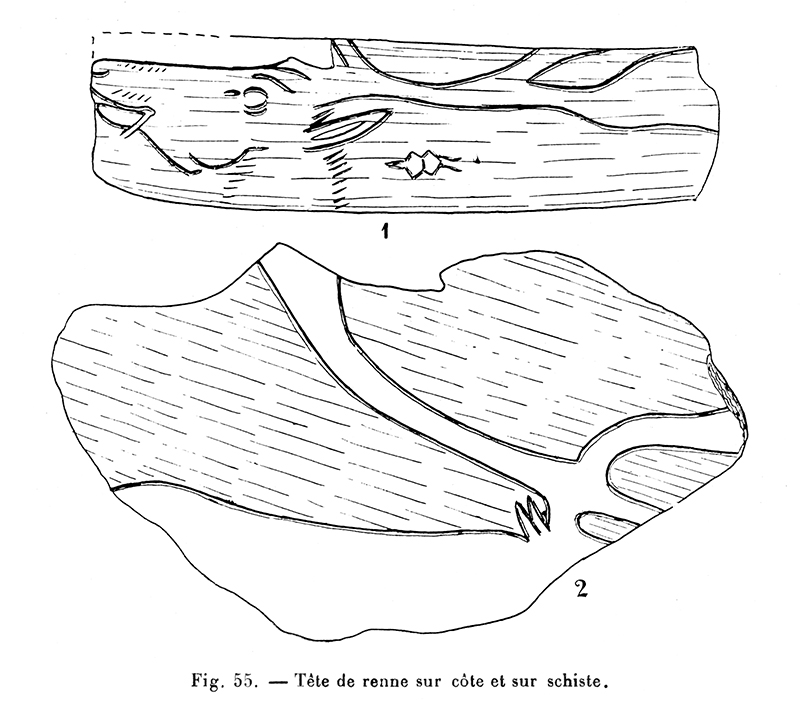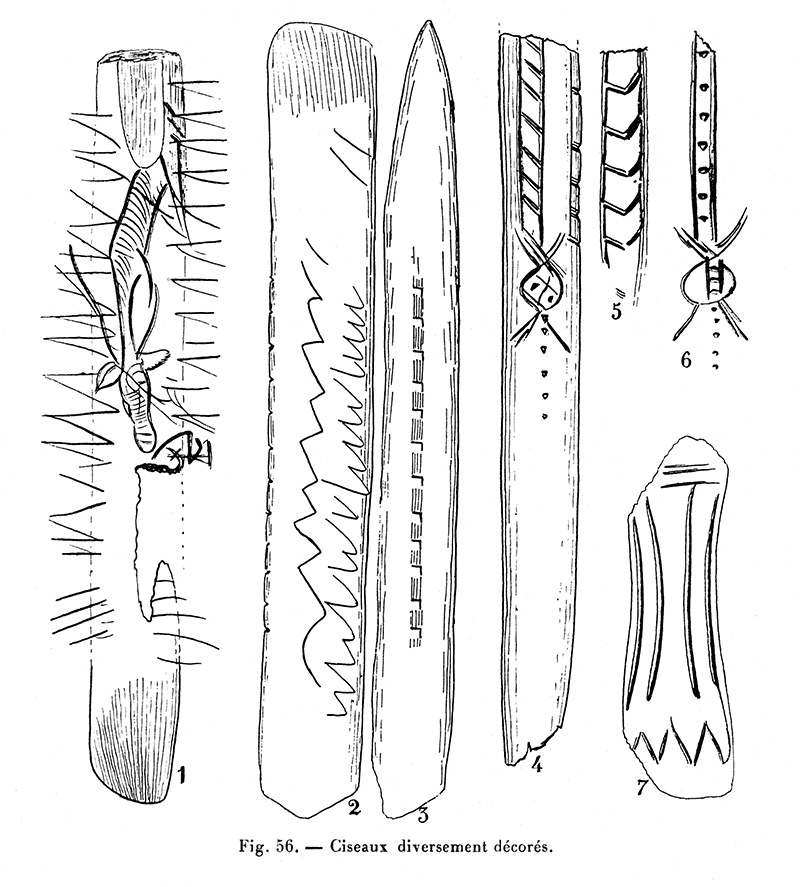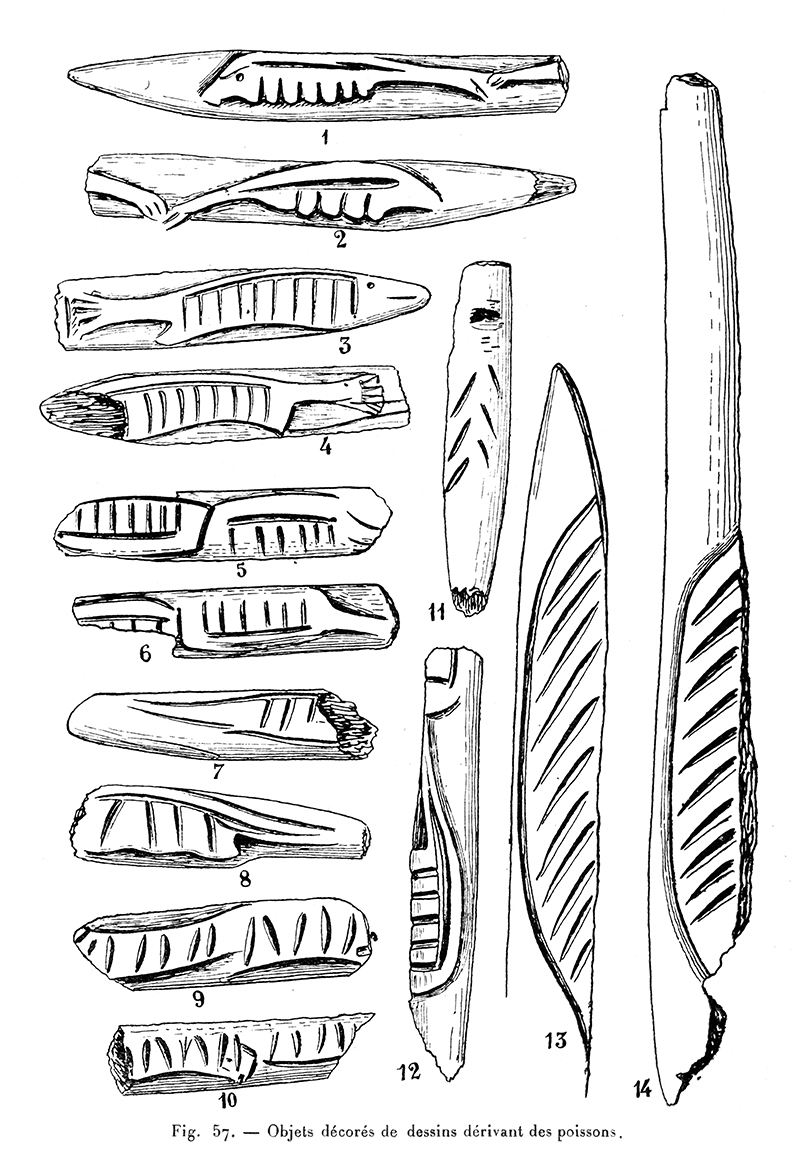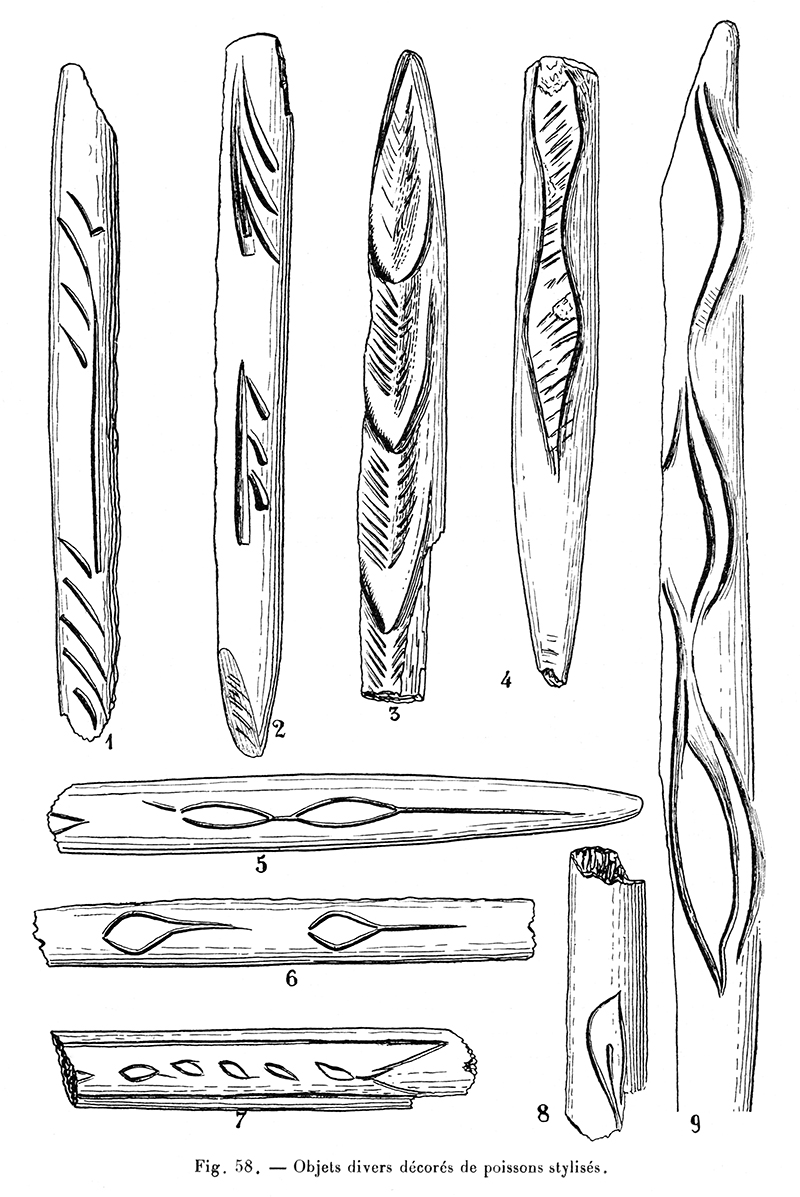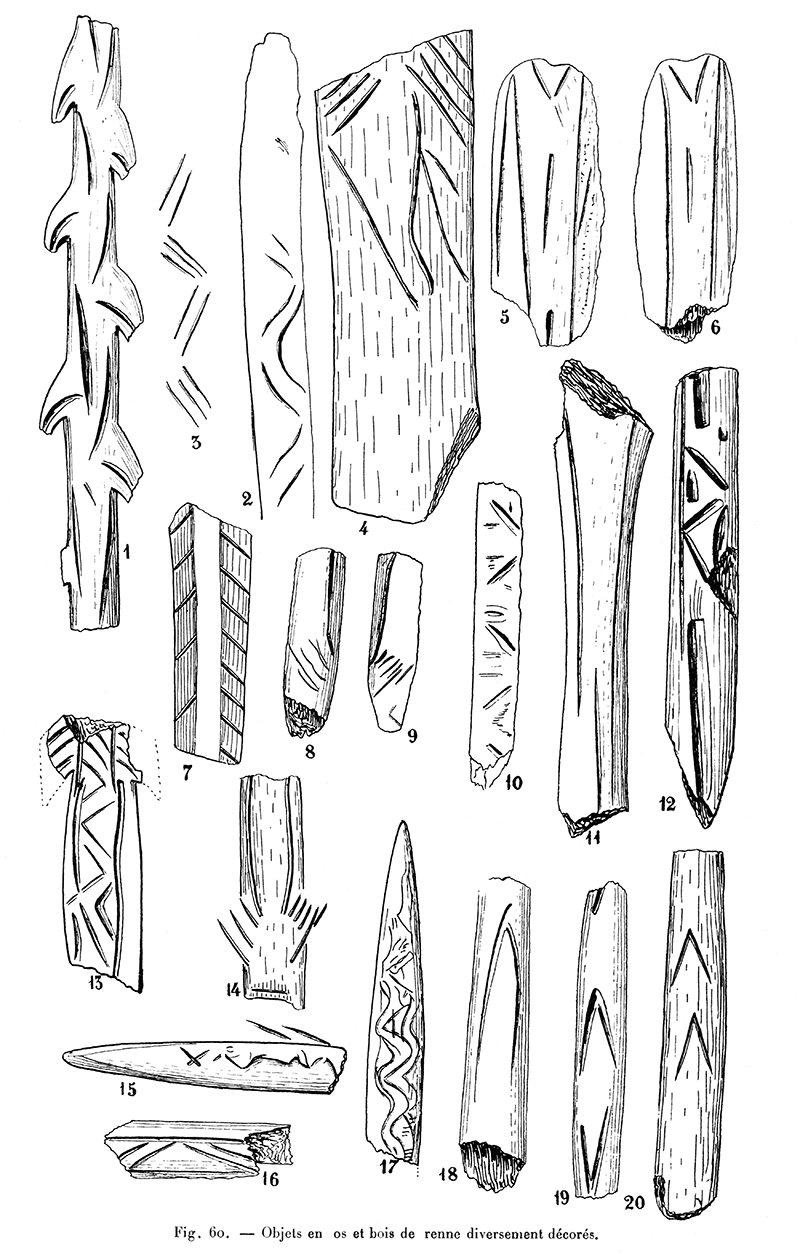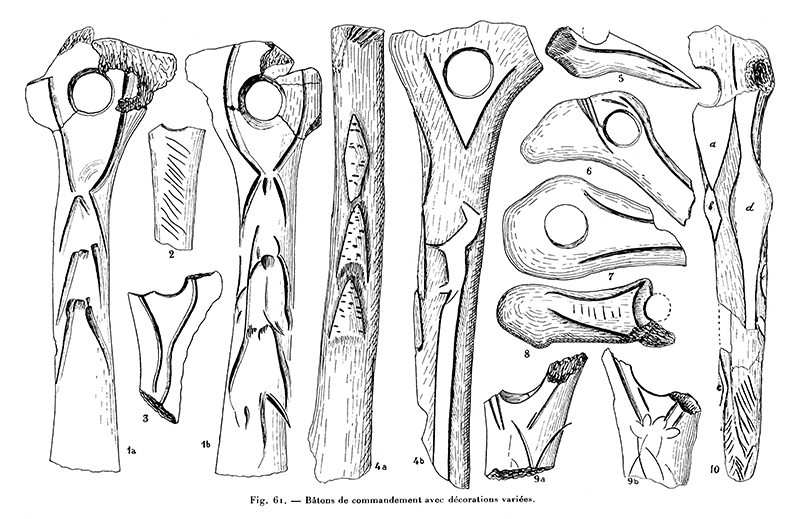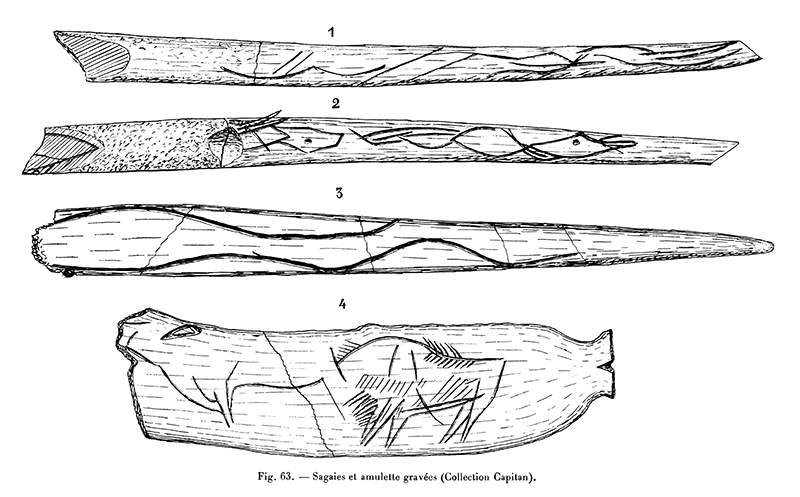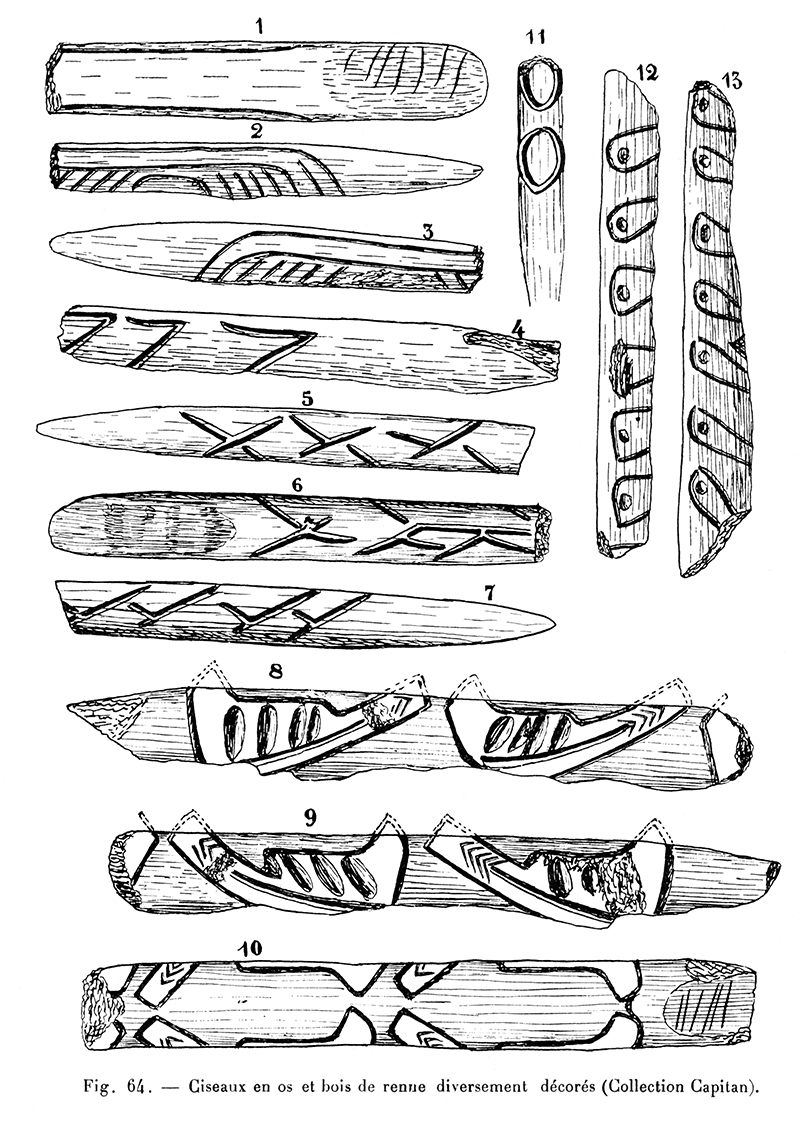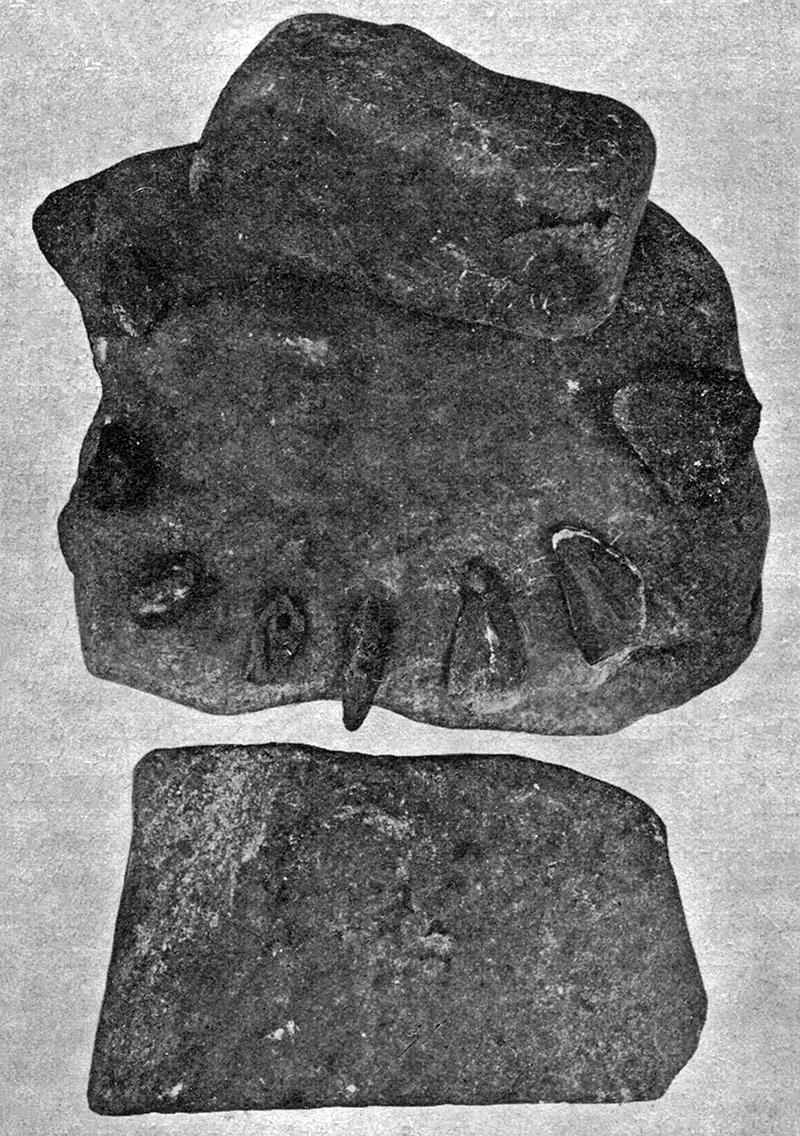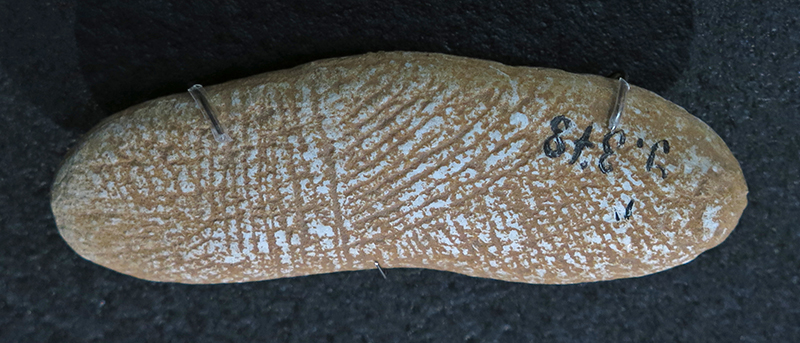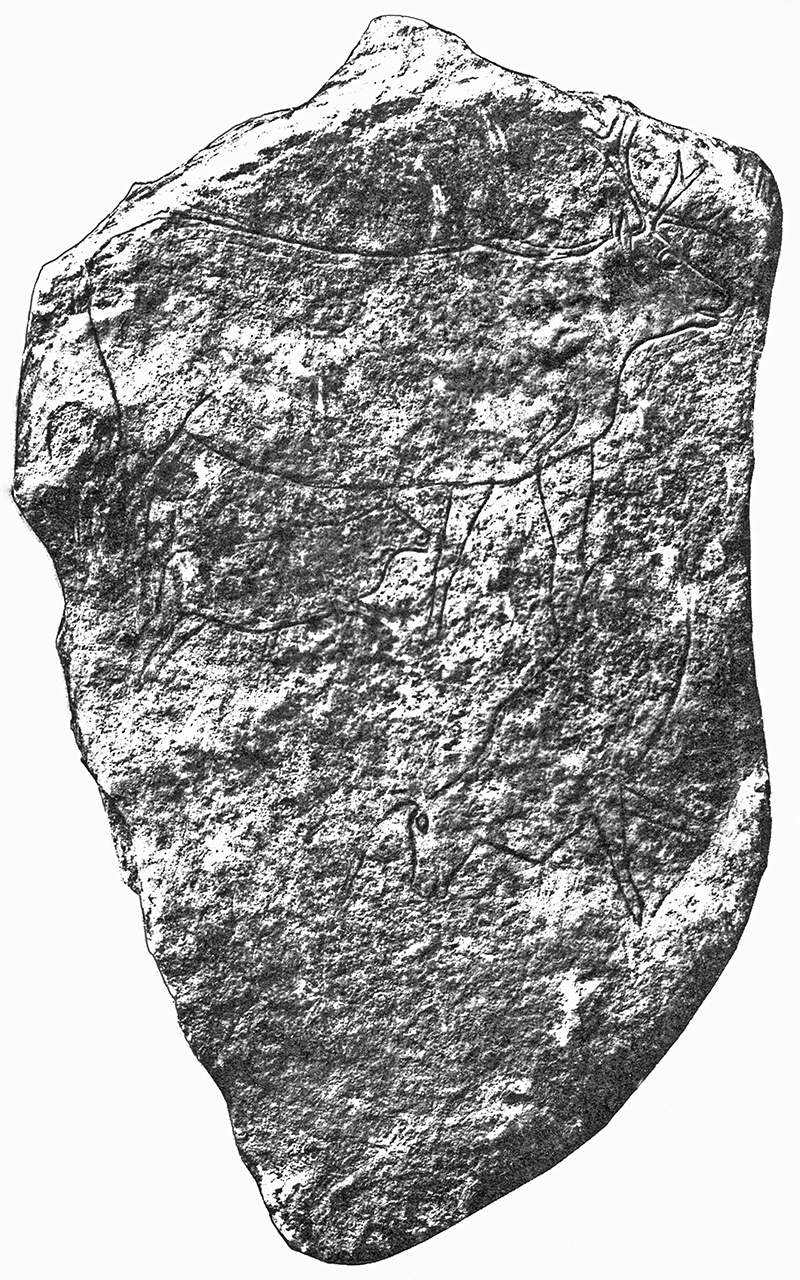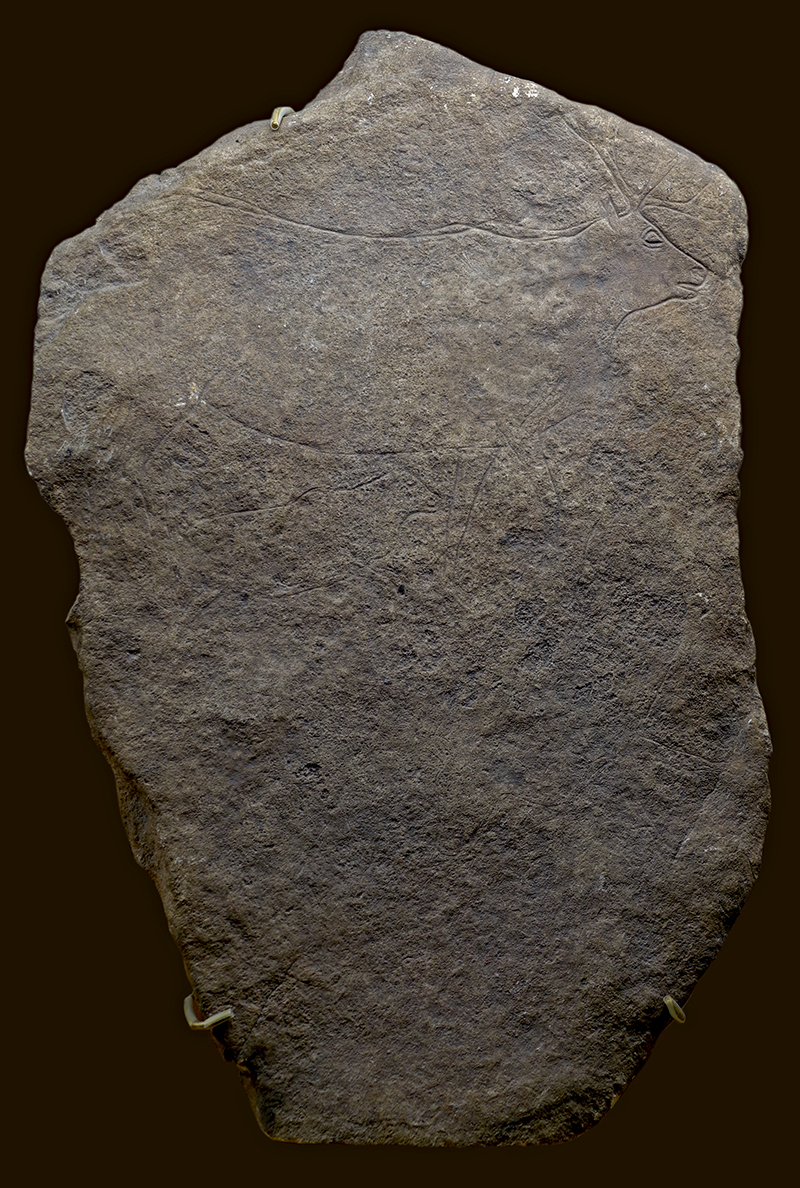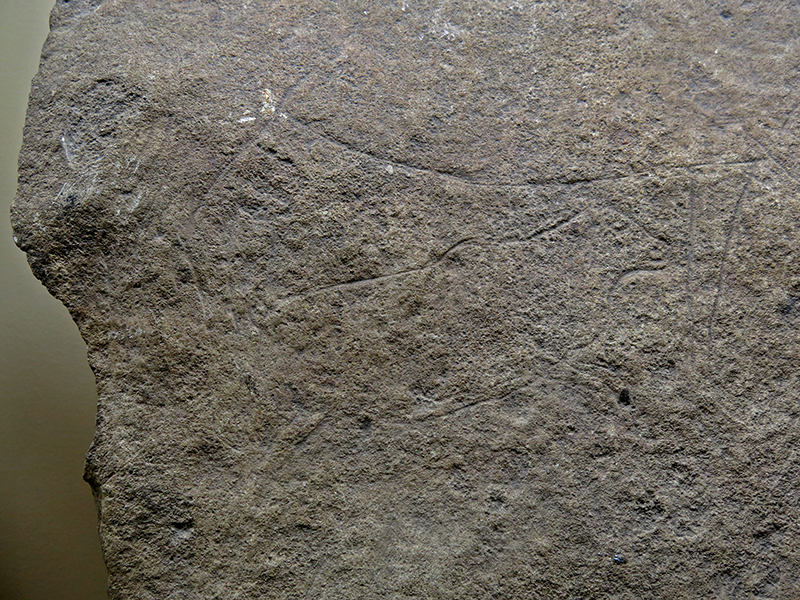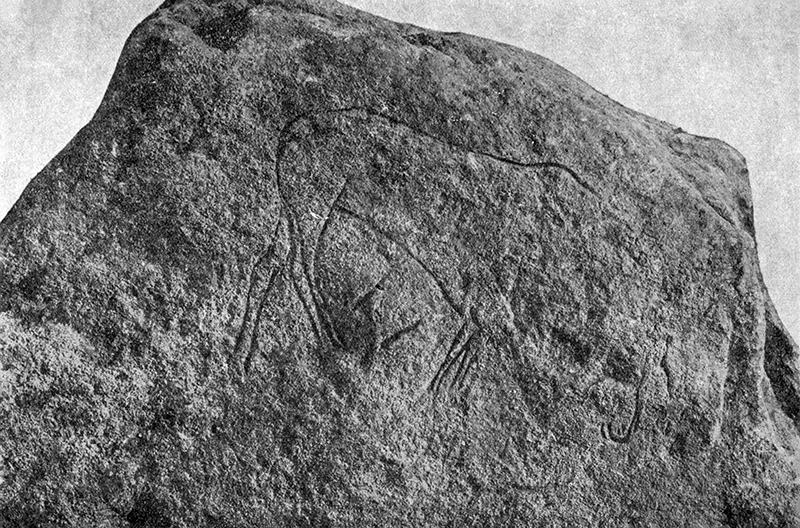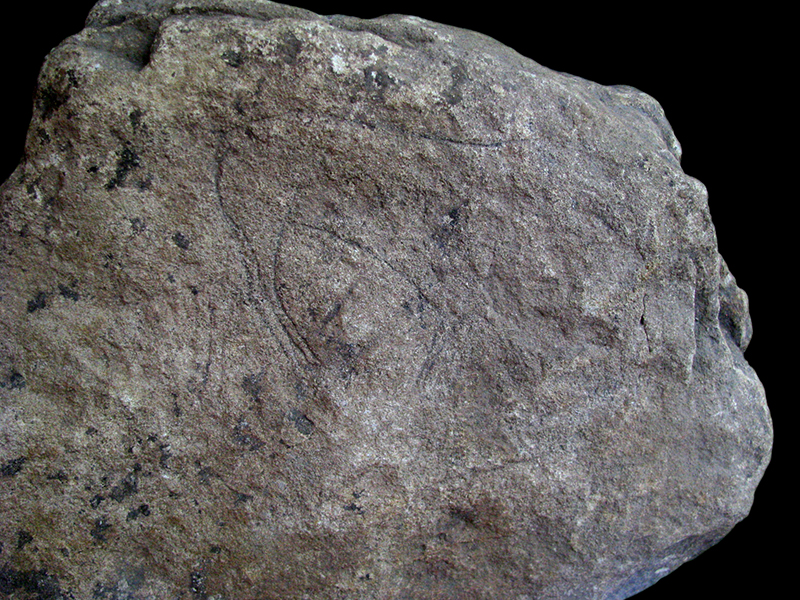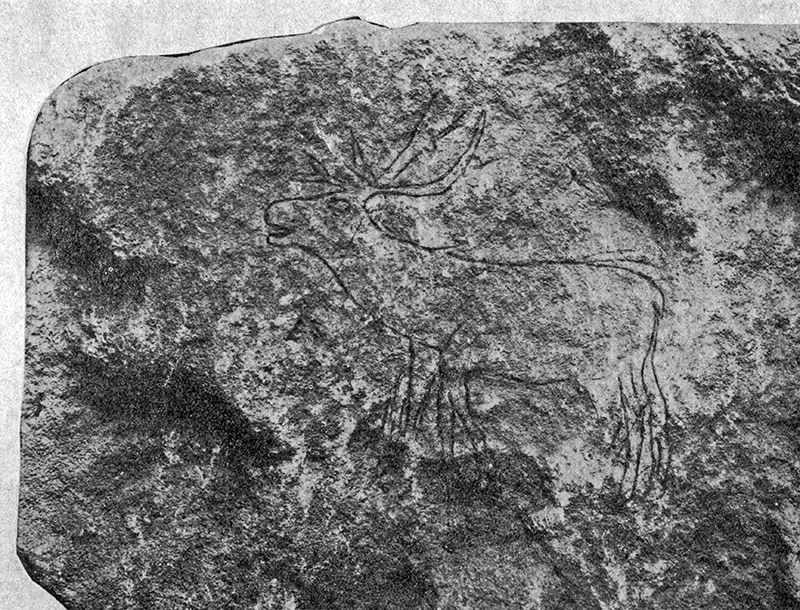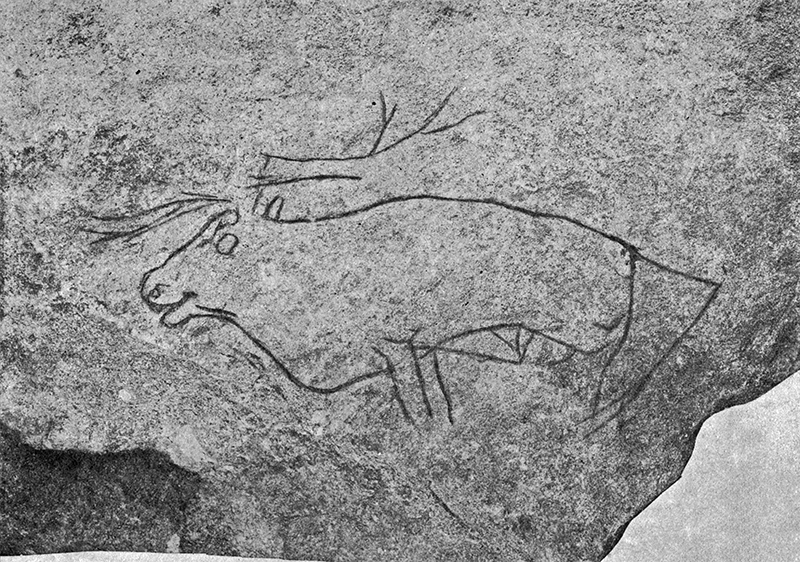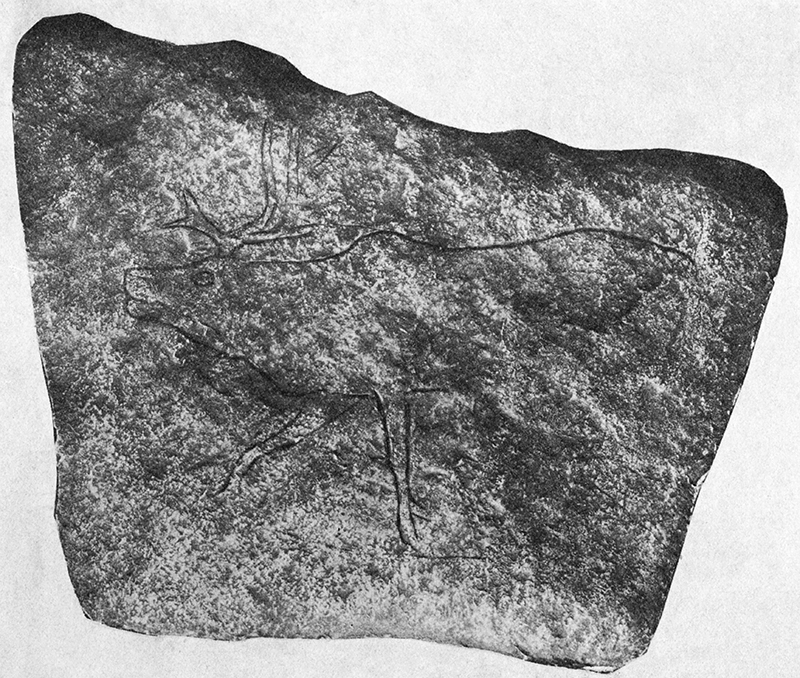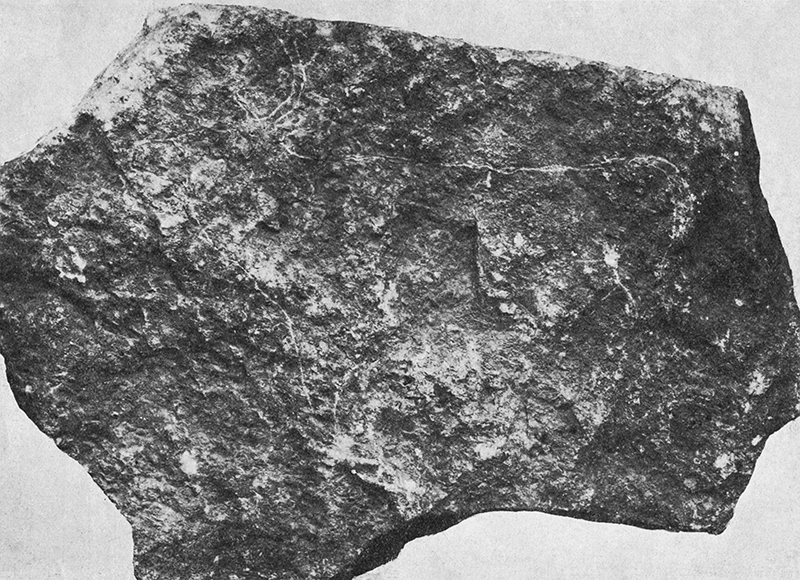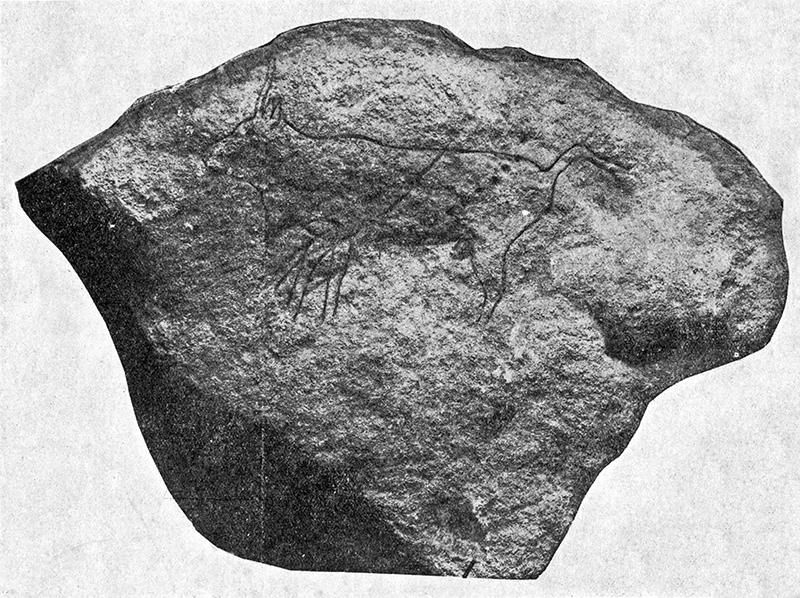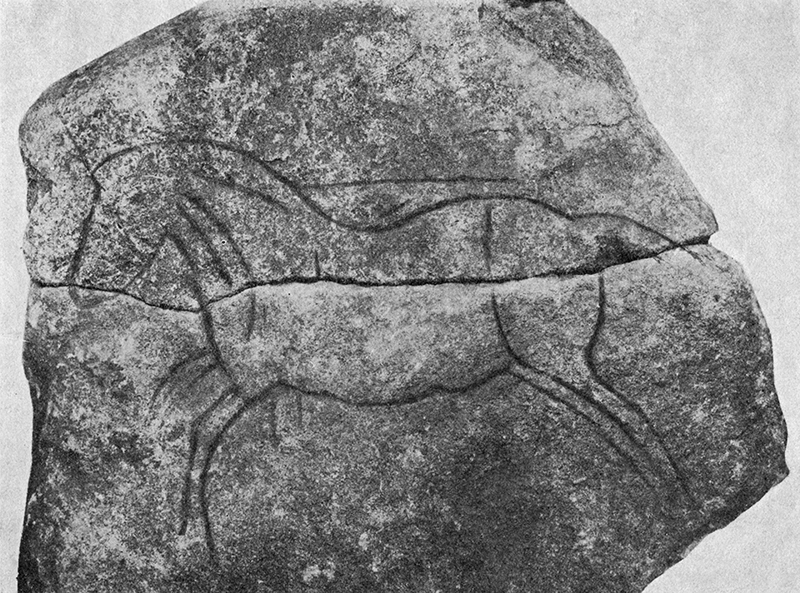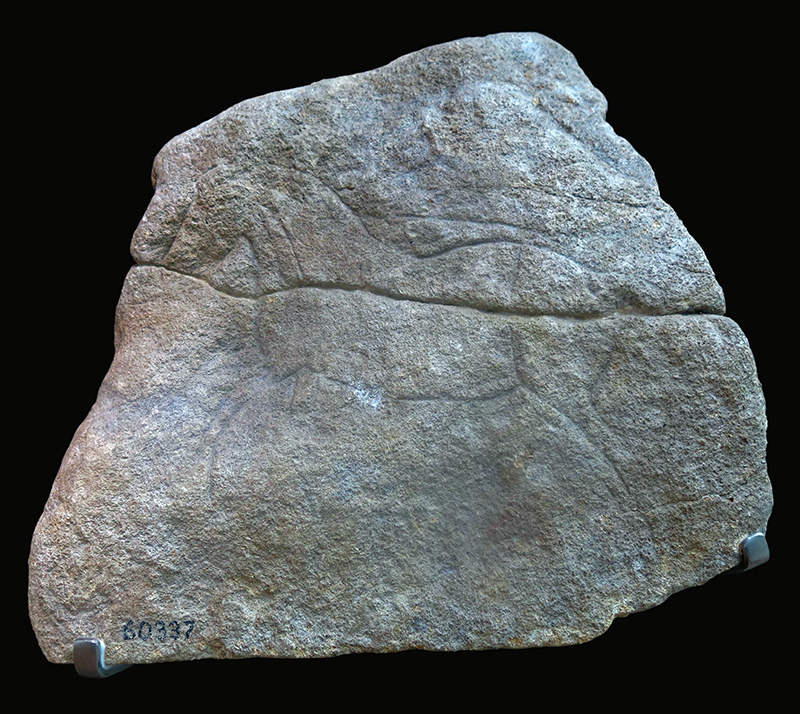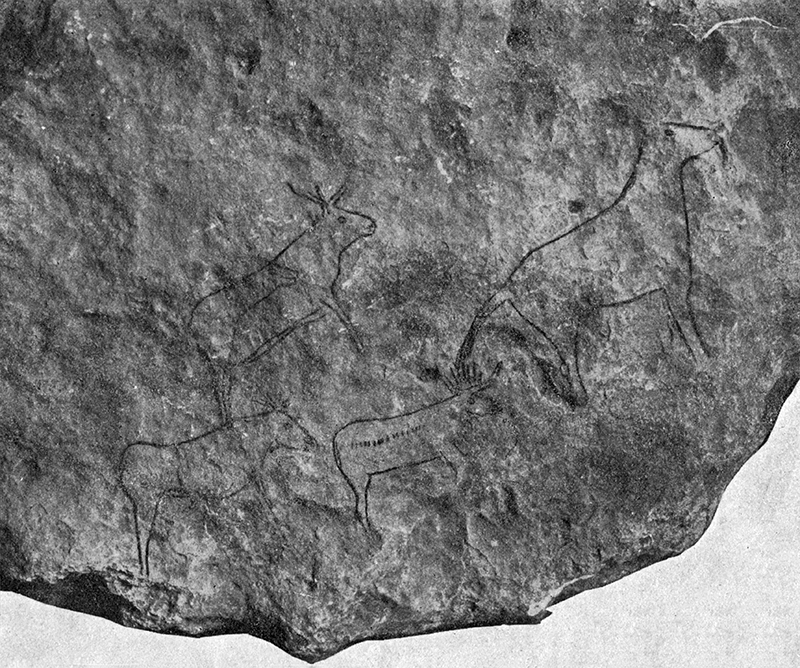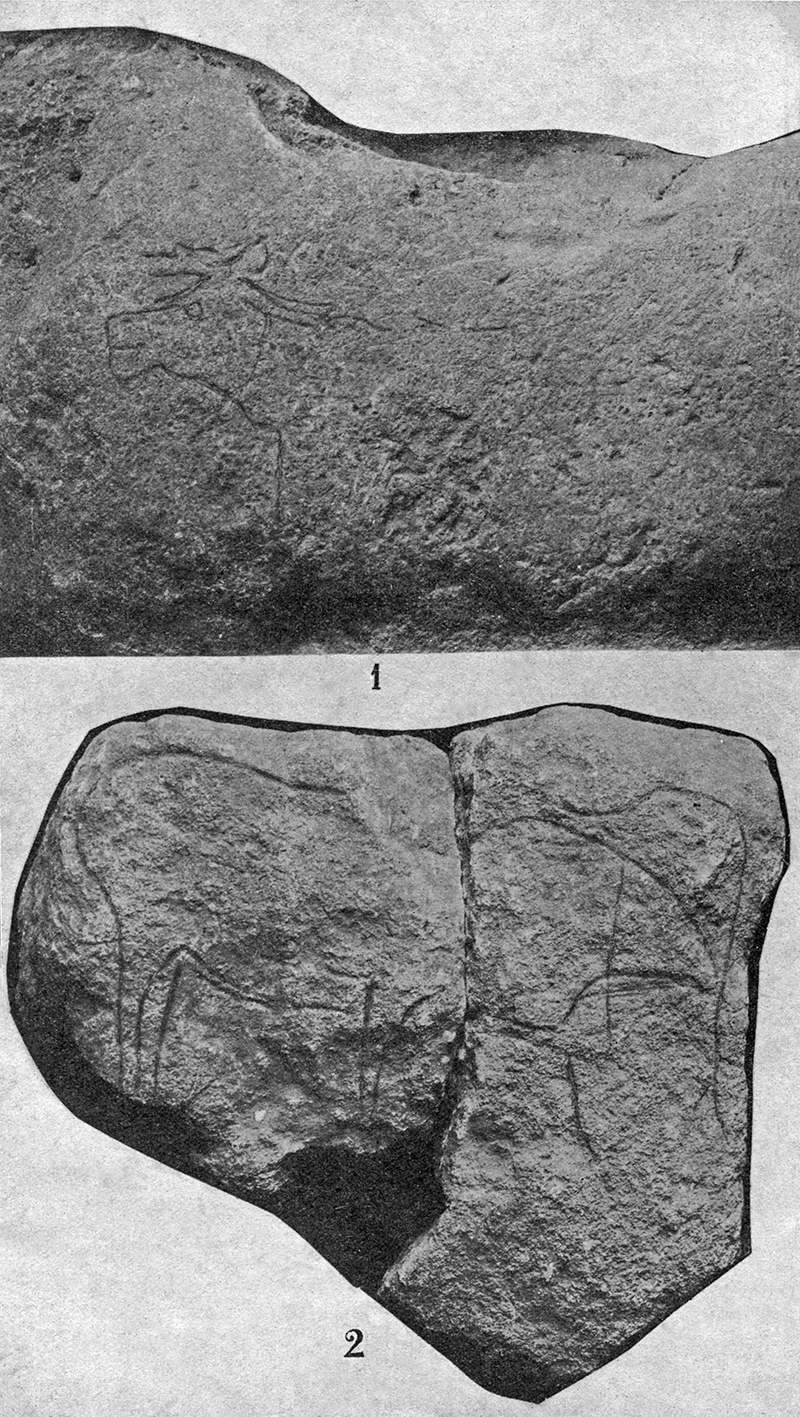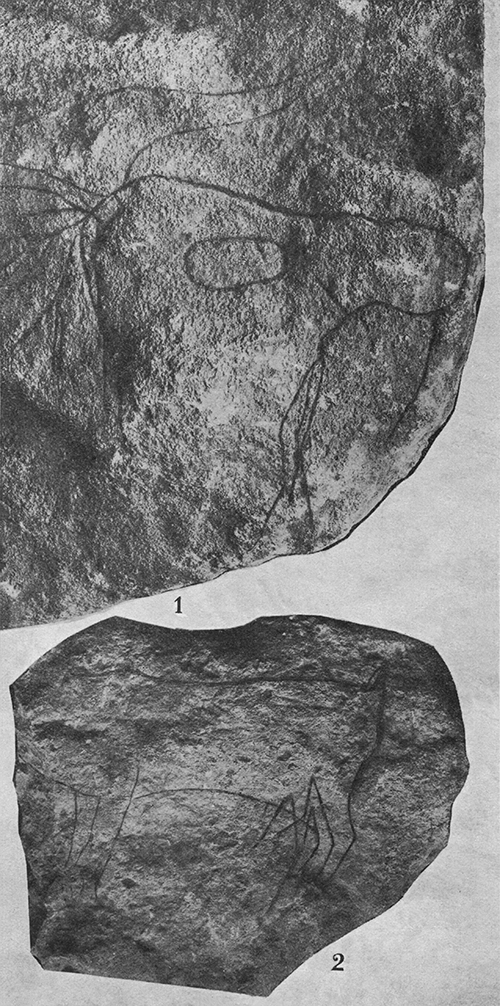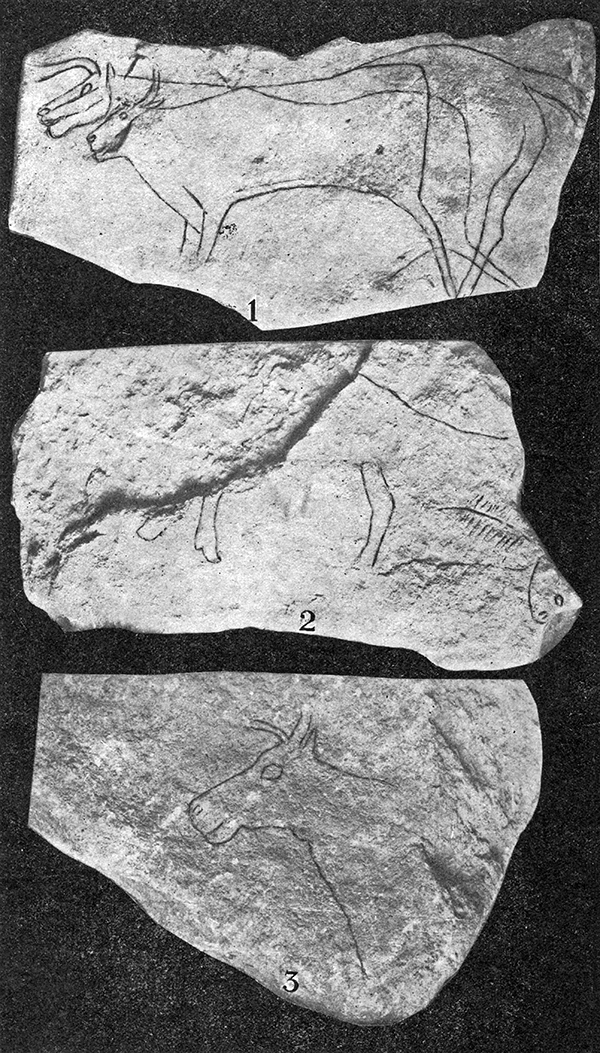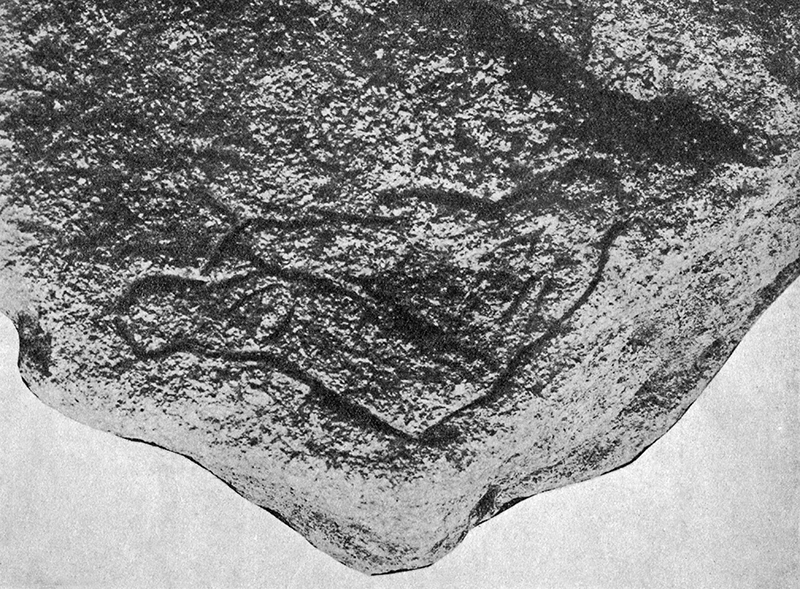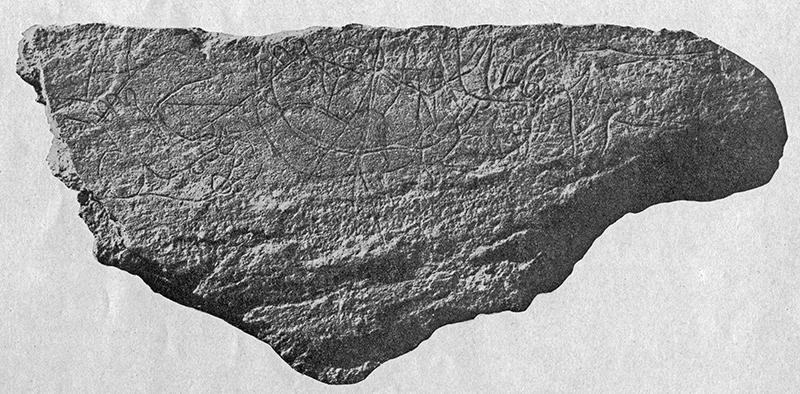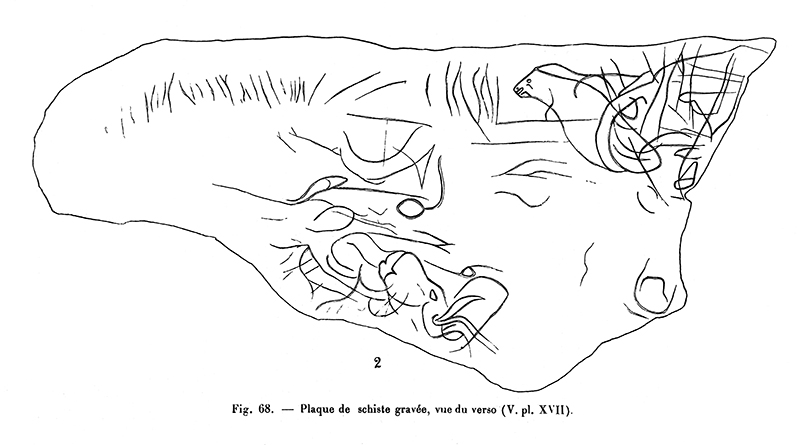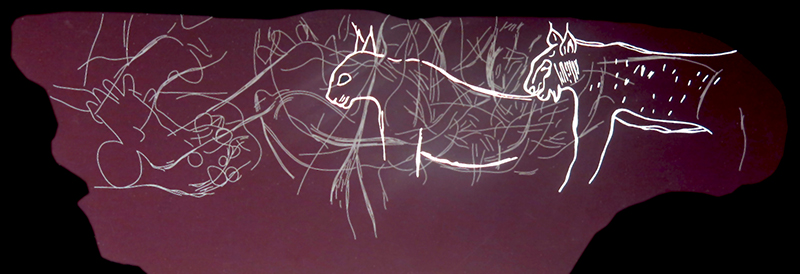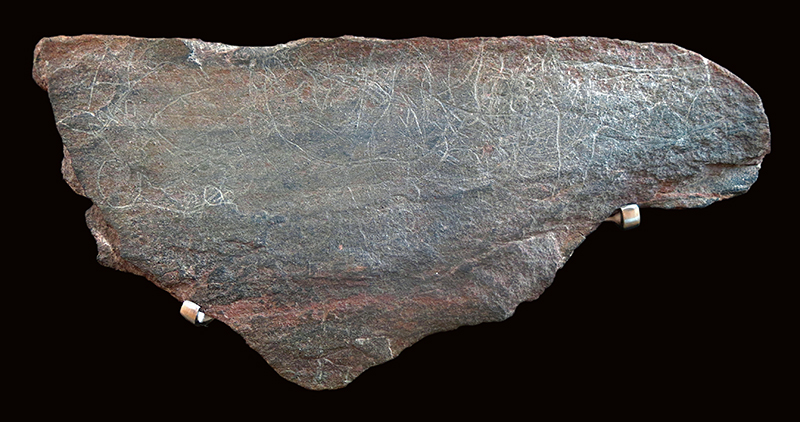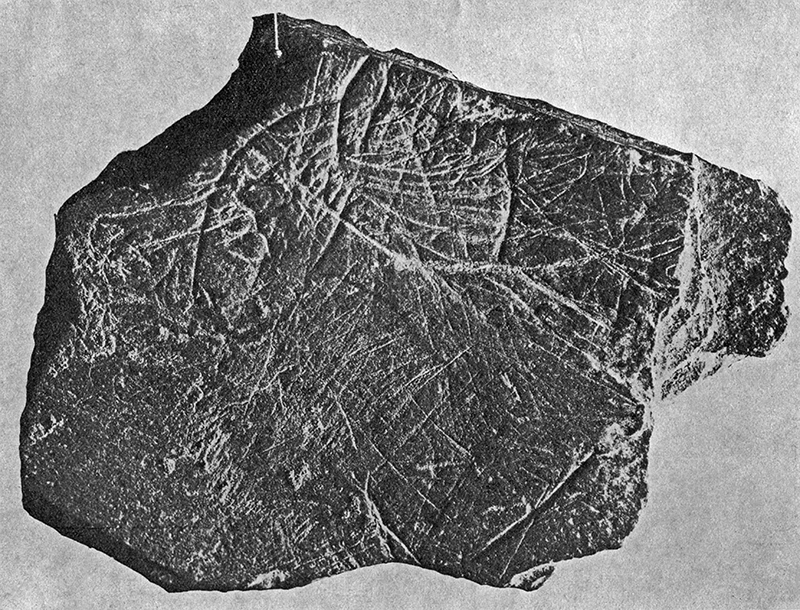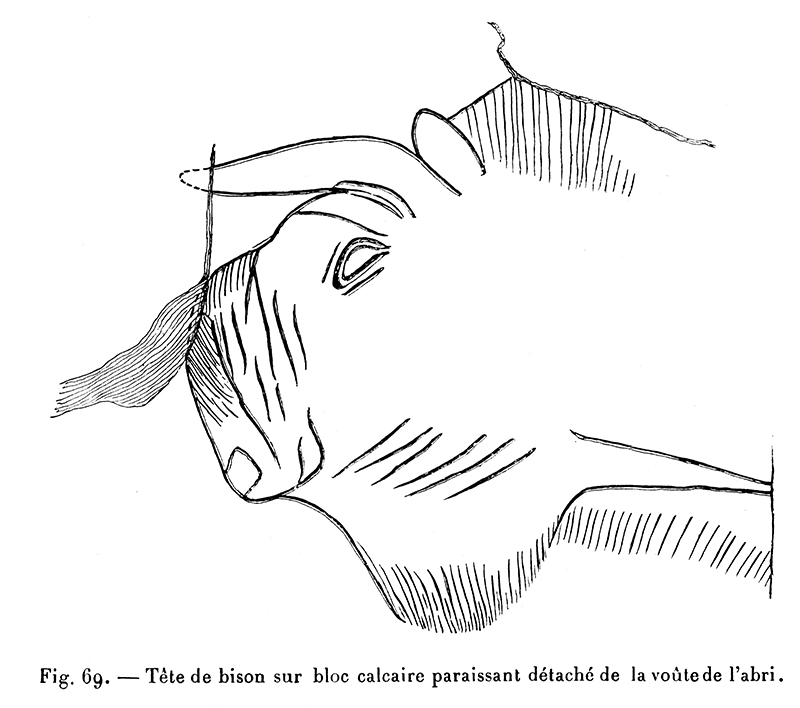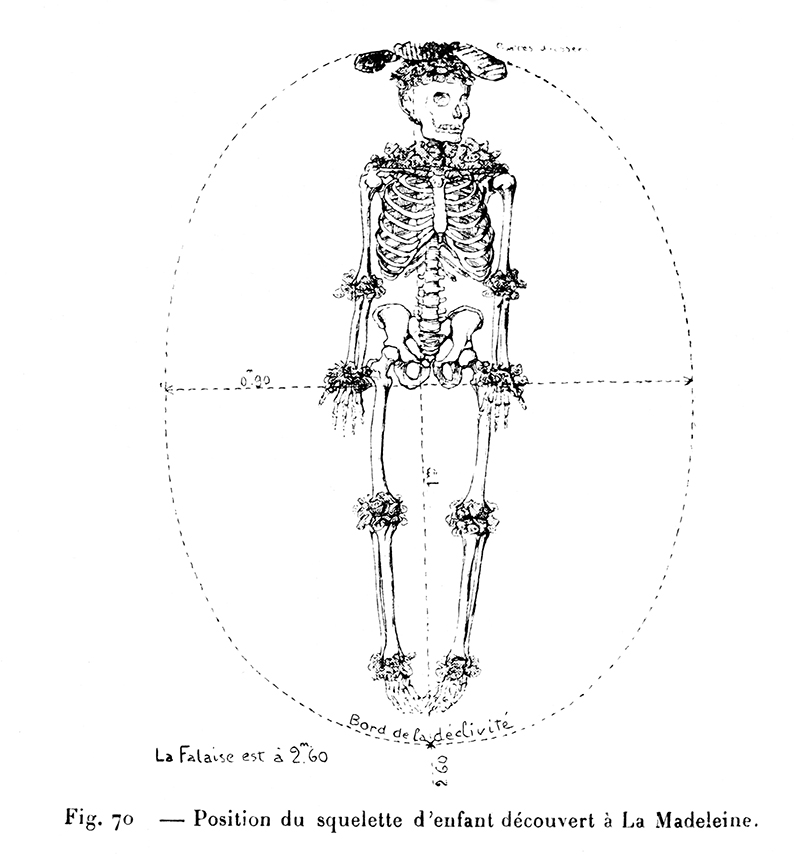La Madeleine - a rock shelter in the Dordogne with exquisite art objects from the Magdalenian
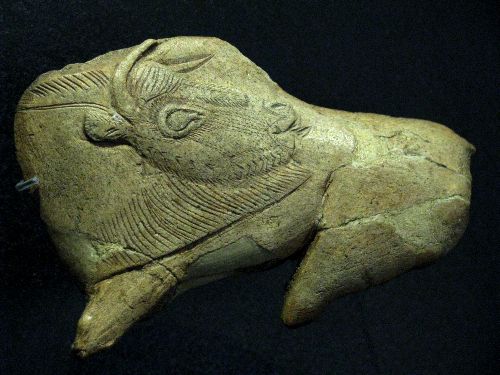
Bison licking its shoulder, from La Madeleine
Photo: Don Hitchcock 2008
Source: Original on display at Le Musée National de Préhistoire, Les Eyzies-de-Tayac
La Madeleine is a rock shelter located in the Vézère valley, in the Dordogne, France. In 1926 the skeleton of a three year old child was discovered, with exquisite shell jewellery, dating from the end of the Magdalenian period. It is a treasure house of art and knowledge about the people of the Magdalenian. Much of this art is on display at the Musée National de Préhistoire, Les Eyzies-de-Tayac.
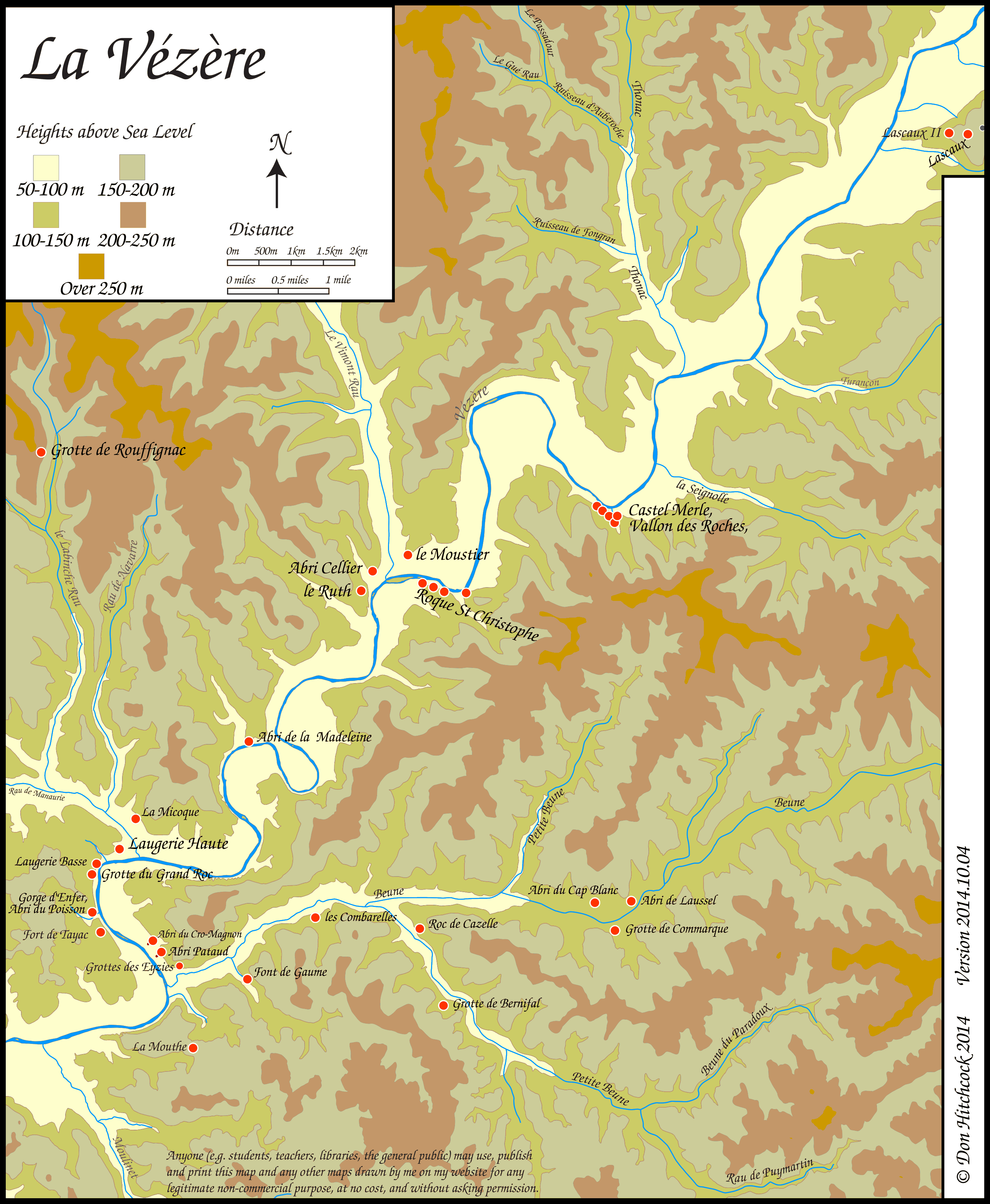
Map of sites in the Vézère Valley of France, including l'abri de la Madeleine.
If you click on the map you will see a larger map with the ability to click on the sites marked with a red dot and get further information.
Photo: Don Hitchcock
The archaeological site of l'Abri de la Madeleine is a rock shelter under an overhanging cliff situated near Tursac, Dordogne. The medieval castle of Petit Marsac stands on the top of the cliff just above the shelter.
Photo: © Sygic Maps, 2022.
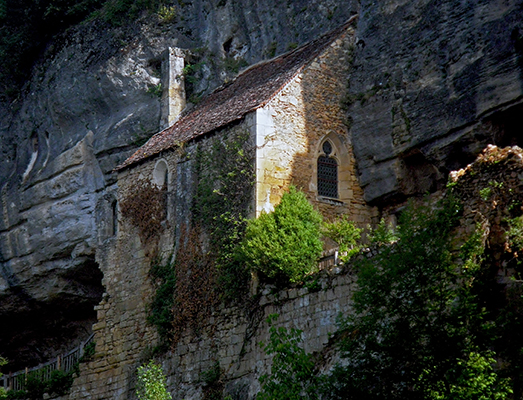
l'Abri de la Madeleine (and thus the archaeological period of the Magdalenian), is named after this chapel of Sainte Madeleine, part of what is now known as the Troglodyte Village of Madeleine.
Lord Beynac built the Sainte Madeleine Chapel in 1354 on the foundations of a previous chapel. l'Abri de la Madeleine is almost directly beneath it.
Photo: Don Hitchcock 2014
Source: Taken from a kayak on the Vézère River on a trip from below Roque St Christophe to Les Eyzies, to document the important sites along this section of the Vézère.
The abri of La Madeleine. This view is unchanged except for the growth of vegetation since the date of the historic photos below.
Photo: © Gerard Bastiaan, 2022
The abri of La Madeleine.
Photo: Heinrich Wendel (© The Wendel Collection, Neanderthal Museum)
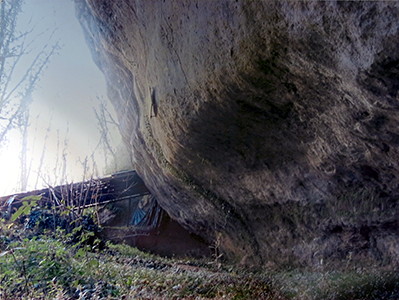
Another view of la Madeleine.
Photo: J. G. Marcillaud - Service Départemental d'Archéologie Dordogne
Rephotography: Don Hitchcock 2014
Source: Musée d’art et d’archéologie du Périgord, Périgueux
Le gisement, or archeological site, of la Madeleine, downstream from the tourist site and the medieval rock shelter of La Madeleine
Photo: Christine Dubourg, Service archéologique départemental Dordogne, Christine Dubourg, Service archéologique départemental Dordogne
Source: http://www.pole-prehistoire.com/page_site.php?site=20
The Magdalenian site of La Madeleine may be approached via the Peasant Farm of La Madeleine, La Ferme Paysanne. Both the cliff-top Medieval site and the Farm beside the Vézère are owned and managed by the Hamelin family, and are well worth a visit.
These destinations are well run, interesting, and informative.
The family, Charles, Louis and Marie, took over the site of the cliff-top Medieval site in 2019, and have worked to provide an excellent experience with tours, activities and information boards.
Charles had worked for ten years in management of the Troglodyte Village of La Madeleine, which was first occupied in Medieval times, and was enhanced with stone walls to make a series of dwellings. The site was chosen for its ease of defence in difficult times especially during the 100 years war, above the prehistoric site of La Madeleine, which uses the rock shelters beside the Vézère River.
Charles' children, Louis and Marie now help him to run both the Troglodyte Village, and La Ferme Paysanne, an interesting site on the flat, rich, alluvial land below the Troglodyte Village.
The family provide tours, activities (workshops and other experiences, available in summer) to make any visitor welcome and interested, and these are always being renewed and improved.
The abri of La Madeleine may be approached via La Ferme Paysanne, on the river bank of the Vézère.
Photo (left): © Gerard Bastiaan, 2022
Photo (right): © guide-du-perigord.com
The path continues at river level towards the Medieval village on the cliffs above.
Photo: © Gerard Bastiaan, 2022
The sign (circled in the left hand image) reads, in part:
150 metres from here lies the prehistoric deposit of La Madeleine.
It is a world famous archaeological site. Like many other sites in the Périgord Noir, the prehistoric site of la Madeleine was discovered (in 1863) by Édouard Lartet and Henry Christy.
It was neither chance, nor luck that drove these two archaeology enthusiasts to explore along the Vézère. They knew that hunter-gatherer peoples around the world shared similar behaviours:
• Living at the entrances to caves or under rock shelters, abris.
• Preferably with a southern aspect
• Presence of a river or water source.
From the turning of the first sod, thousands of flint, bone tools, reindeer antlers, bones, and dozens of engraved bones and stones were exposed.
The prehistoric industries revealed by these excavations were used in 1872 by G. De Mortillet to characterise the period as the Magdalenian, named after the Abri de la Madeleine.
In 1926, Peyrony discovered the burial of a child between the ages of two and four, accompanied by more than 1500 pieces of shell jewellery. Jean-Marc Bouvier was the last archaeologist to search the site, which is now a UNESCO World Heritage Site.
Photo: © Gerard Bastiaan, 2022
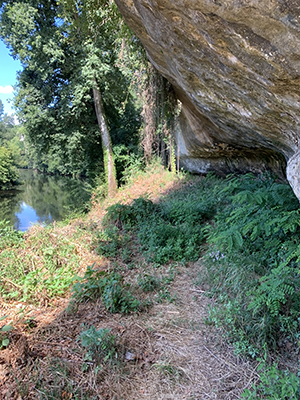
Just after passing the sign, the river has cut in to form a narrow passageway between the cliff and the Vézère.
Photo: © Gerard Bastiaan, 2022
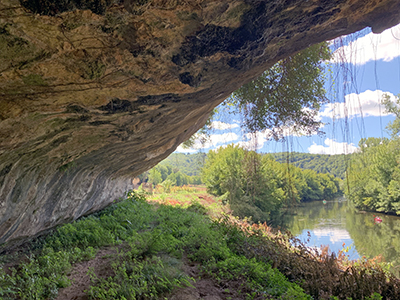
Past this 'choke point', the path widens a little under an overhanging abri. If this ground has not been excavated, it may prove advantageous to do so.
This view looks upstream from underneath the mediaeval town.
Photo: © Gerard Bastiaan, 2022
Here we may see the advantages of an abri for the original inhabitants. The cliff shelters this area from rain and snow, and hide curtains might be erected at the drip line to protect from the wind.
Photo: © Gerard Bastiaan, 2022
(left) Soon the gisement of the abri of La Madeleine appears, protected by a fence around its perimeter. This is the upstream, eastern end of the fence.
(right) View along the fence line. The forest seems to be quite young.
Photo: © Gerard Bastiaan, 2022
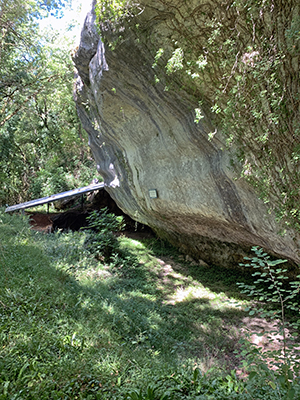
Gerard Bastiaan writes:
View through the fence downstream. I think the part of the site with the roof on it is the part which on the drawing of Peyrony is mentioned as not excavated. I now can see the stonewall which is shown on his drawing.
Photo: © Gerard Bastiaan, 2022
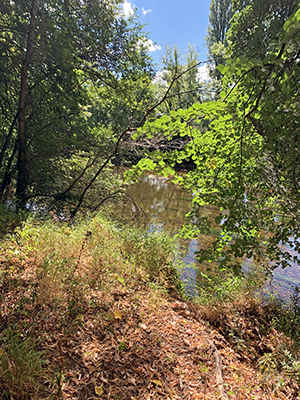
(above) The abri of La Madeleine.
The Vézère is just a few metres away on the left of the abri.
Note how shallow it is at this point, the river was 70 cm lower than normal because of the drought.
Photo: © Gerard Bastiaan, 2022
In 1913, the distance from the cliff to the edge of the Vézère was about thirty metres, and the hills were bare. Now the river is just 2.5 metres from the cliff, and trees have reclaimed the land.
( It may be that goats which kept the vegetation in check were removed from the area - Don )
The text that accompanies the photo in Capitan et Peyrony (1928) reads:
General view of the rocks of La Madeleine with the ruins of the old castle. On the left, behind the trees, the famous shelter before the excavations.
Photo: Belvès
Source: Capitan et Peyrony (1928)
Additional text: sign at La Ferme Paysanne
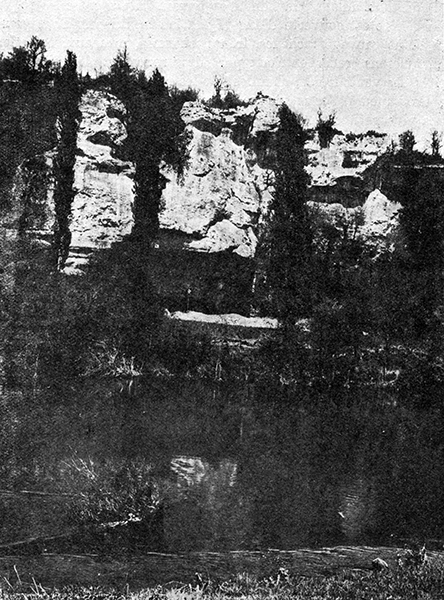
Front view of the La Madeleine shelter. In the foreground, the Vézère. The excavated material forms a white band at the foot of the cliff.
Photo and text: Capitan et Peyrony (1928)
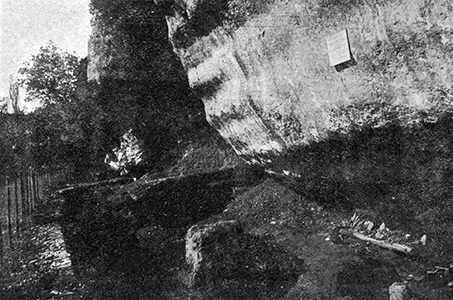
View of l'abri de la Madeleine during the course of the excavations.
Photo and text: Capitan et Peyrony (1928)

Peyrony or Capitan (in the background) and workers during the excavation of La Madeleine in 1926.
Photo: Capitan et Peyrony (1928)
Looking upstream, south east, along the Vézère River from the Medieval Rock Shelter at the tourist site of La Madeleine, towards the end of the huge incised meander or 'cingle' in the course of the river.
Photo: Don Hitchcock 2008
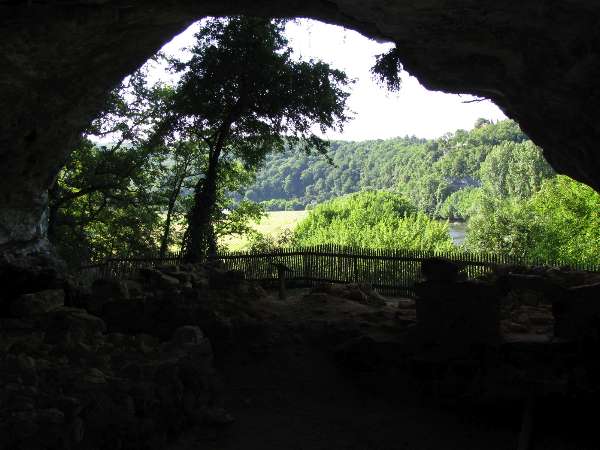
View down the Vézère valley from the Medieval La Madeleine rock shelter, towards the archaeological gisement of La Madeleine.
Photo: Don Hitchcock 2008
Map of the location of La Madeleine on the Vézère River
Photo: Don Hitchcock 2008
Source: Display at La Madeleine
Aerial photograph of the location of La Madeleine on the Vézère River. The rock shelter used in medieval times shown above may or may not have been used during the Magdalenian. I would appreciate further information on this point.
However the major archaeological site of l'Abri de la Madeleine is further downstream from the cliff site shown above. The gisement of La Madeleine has been an historic monument since October 1956.
Rephotography: Don Hitchcock 2008
Source: © Display at the Troglodyte Village of La Madeleine
This is a very valuable sketch of the layout of the Troglodyte Village, supplied as part of a catalog or tour guide lent to visitors at the time that I was there.
• 1 Car Park, Museum and Reception
• 2 Look out post
• 3 Troglodyte Village
• 4 Resident with oven
• 5 Drainage
• 6 Outside stairs
• 7 Look out post
• 8 Water channel and pigeon holes
• 9 Sheep pen
• 10 Troughs 1 and 2
• 11 Base of partition wall
• 12 First floor 'bedrooms'
• 13 Inside stairs
• 14 Slots for beams
• 15 Bakers oven
• 16 Marks where a kitchen once stood
• 17 Multi use reception
• 18 First floor kitchen
• 19 Cloth makers workshop
• 20 Walls of stone
• 21 Centre altar
• 22 10th century altar
• 23 Sun dial
• 24 Central room
• 25 Refuge
• 26 Intermittent fountain
• 27 Interior arrangement
• 28 Door arrangement
• 29 Rock slide
• 30 Observation shelter
• 31/32 Vegetable garden path
• 33 Original enclosed vegetable garden
Rephotography: Don Hitchcock 2008
Source and text: © Catalog at the Troglodyte Village of La Madeleine
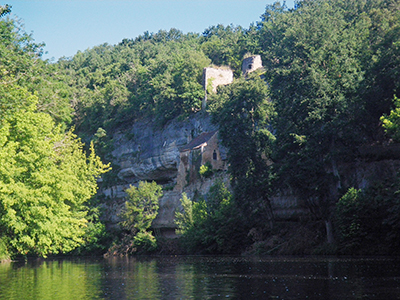
The Troglodyte Village of La Madeleine, seen from a kayak on the Vézère River.
Photo: Don Hitchcock 2014
Source: Taken from a kayak on the Vézère River on a trip from below Roque St Christophe to Les Eyzies, to document the important sites along this section of the Vézère.
Maps showing a) the extent of the Magdalenian, as well as the the maximum extent of Weichselian glaciations (the last glacial maximum, LGM, between 26 500 and 19 000 - 20 000 BP) and distribution of loess covers in Europe (orange patches); b) the Late Weichselian major glacial phases (Pz = Poznan, Pm = Pomerania, Ga = Gardno, Sb = Stupsk Bank, Sm = Southern Middle Bank), distribution of loess covers in Poland (orange patches).
(This is an important map which shows how widespread the Magdalenian culture was, from relatively warm coastal areas in southern France and Spain, to continental climates within fifty kilometres of the ice sheet at its maximum extent, although of course at the time of the Magdalenian, 18 000 BP to 10 000 BP the ice sheets were in retreat from their maximum extent at the LGM. The site of Klementowice in Poland, known since the early 1980s, is the furthest east and north which displays this culture - Don )
Photo: Wisniewski et al. (2012)
Location map of Homo Sapiens during Magdalenian culture, between 17 000 ~ 10 000 BP.
Photo: Sémhur, Furfur
Permission: Creative Commons Attribution-Share Alike 3.0 Unported License.
At the end of 1863, Édouard Lartet, a palaeontologist, and his friend and benefactor Henry Christy discovered the shelter of La Madeleine by the side of the Vézère River. They were returning from investigating Le Moustier a few kilometres away, and noticed a large shelter on the right bank of the river. At this time there was no bridge, and they stopped a passing boat for assistance in crossing the river. A search was carried out with shovels and spades, and they began to realise the importance of the site. Each level revealed the presence of mankind: burins, flint blades, spear points. Numerous unrecognised objects turned up, made from unknown bones: harpoons, spears, needles, and numerous artefacts made from reindeer antlers. They decided to leave a serious investigation until spring.
The next spring, they continued their research. In May 1864 workers discovered five fragments of an ivory plate, which once reassembled, revealed an exceptional engraving of a mammoth. The accuracy of the engraving confirmed without doubt that the artist had observed the living creature and reproduced it in accurate detail: wooly coat, tusks, and hump were all faithfully recorded. The rear end of the animal was also clearly defined.
From Lartet and Christy (1875):
The next spot we visited in descending the Vézère was the station, near the ancient castle of La Madelaine, which has been, and still is, under examination by Messrs Lartet and Christy, lies at the foot of the cliff on the north bank of the river, about 30 yards distant from it; and the upper surface of the deposit is not more than 20 feet above the level of the stream, so as to be even now within reach of the highest floods.
The beds, which must be about 50 feet in length by about 25 feet in width and 8 to 10 feet in thickness, lie in a recess under the overhanging cliff, a portion of which appears, however, to have fallen off not more than a century or two ago, at the most. The upper bed consists principally of rubble from the cliff above; but the lower part of the deposit is a regular Kjökken-Mödding, rich beyond conception in the rude implements formed by the primitive occupants of the spot. Flint flakes of all sizes, many of them of most symmetrical form, some of great length and others of most diminutive size, scrapers of various forms and sizes, and cores or nuclei of flint abound.
Interspersed in the deposit are numerous large stones used as hearths, and occasionally, as it appears, arranged to form a sort of oven. There are also numbers of large pebbles of quartz, granite, and other rocks, some few of which, of spheroidal form, have had a slight recess worked in one of their faces so as to look like a sort of mortar ; a few others bear traces of rubbing upon them; and many others, especially of quartz, have their edges battered, or have even been broken, by having been used as hammers.
A few flint cores bear traces also of having been used in the same manner. Some of the flakes and scrapers have been broken diagonally from each side so as to produce a pointed end or tang, as if for insertion into a handle, or for use as a narrow chisel. But in addition to the worked flints, the beds contain a large number of implements, of various forms and sizes, made of Reindeer antler or of bone.
The principal of these are dart or arrow heads with a number of barbs running along either one or both sides, stylus shaped instruments, pointed at one end and chisel-shaped at the other (harpoon-points), and needles of good finish and workmanship, with neatly drilled eyes.
Some perforated pieces of reindeer antler, and others bearing the marks of sawing upon them, have also been found, as well as some bearing animal forms sculptured upon them, but not so finely engraved as those which will subsequently be mentioned. The deposit is of course full of animal remains, and the fauna is the same as that of the Cave of Les Eyzies.
Map of the shelter of La Madeleine.
Photo: Patrick Paillet
Source: Paillet (2011)
Map of the la Madeleine excavation.
Peyrony and Capitan began new excavations at the rock shelter of La Madeleine in 1911-12, where they recorded stratigraphic changes in stone and bone artifacts and collected specimens of portable art. In fact their collection of Palaeolithic portable art recovered from various sites had grown so large that they donated a substantial number of objects to the Musée des Antiquités Nationales [Museum of National Antiquities] in 1912.
Drawing: Denis Peyrony, from his 1911 report
Proximal source: journals.openedition.org/paleo/4058?lang=fr
The plan of the gisement at la Madeleine by Capitan and Peyrony, as well as some cross sections.
Photo: after Capitan et Peyrony (1928)
Drawing (engraving) of a woolly mammoth engraved on a plate of ivory found in the cavern of La Madeleine, Perigord
Photo: C. Lyell 'The Antiquity of Man' (1873)
Woolly mammoth engraved on a plate of ivory found in La Madeleine.
( note that this is a photo of a facsimile - Don )
Photo: Delporte.
A recent photograph of the mammoth from La Madeleine.
In its present size, the fragment of La Madeleine mammoth ivory measures 248 mm long and 106 mm width. Its thickness is 18 mm section on the left side and 8 mm on the fracture.
Photo: © Patrick Paillet (2009) avec l’autorisation du Département « Histoire de la Terre », Muséum national d’histoire naturelle.
Source: Paillet (2011)
The original mammoth from La Madeleine.
Photo: © Jc Domenech
https://storify.com/public/templates/slideshow/index.html?src=//storify.com/franceinter/visite-virtuelle-du-musee-de-l-homme#25
The original mammoth from La Madeleine.
Photo: Don Hitchcock 2018
Source: Musée de l'Homme in Paris
A recent tracing of the mammoth from La Madeleine.
Photo: © Patrick Paillet (2009)
Source: Paillet (2011)
A selective tracing of the mammoth from La Madeleine.
Photo: © Patrick Paillet (2009)
Source: Paillet (2011)
The back of the piece of ivory on which the woolly mammoth was engraved in La Madeleine.
Photo: © Patrick Paillet (2009) avec l’autorisation du Département « Histoire de la Terre », Muséum national d’histoire naturelle.
Source: Paillet (2011)
Reindeer and calf on a slab of limestone, from the excavations of Peyrony.
Photo: Don Hitchcock 2014
Source: Original, Musée d'Archeologie Nationale et Domaine, St-Germain-en-Laye
Female reindeer and calf engraved on a stone block. Such careful and realistic representation is typical of Leroi-Gourhan's late Style IV, from La Madeleine, Dordogne. 65 cm in length.
Photo: Sieveking (1979)
Source: Original on display at Le Musée de Saint-Germain-en-Laye
Left to right, left photo:
• Ciseau, chisel or wedge.
• Lissoir, polisher, used to stretch hides during the tanning process.
• Aiguille, eyed needle.
• Poinçon, awl, used to make holes in hides preparatory to sewing.
• Pointe double, thin rod sharpened at each end.
Left to right, right photo:
• Propulseur, spear thrower.
• Pendeloques, pendants, apparently of cave bear teeth.
Photo: Don Hitchcock 2014
Source: Original, Musée d'Archeologie Nationale et Domaine, St-Germain-en-Laye
Left to right, left photo:
• Sagaie à base fourchue sculptée, engraved spear point with forked base.
• Sagaie à biseau simple, spear point with a single bevel base.
• Harpon, harpoon.
• Baguette demi-ronde, half cylindrical spear point, one of a pair.
Left to right, right photo:
• Harpon, harpoon.
• Sagaie à biseau double, spear point with a double bevel base.
• Harpon, harpoon.
Photo: Don Hitchcock 2014
Source: Original, Musée d'Archeologie Nationale et Domaine, St-Germain-en-Laye
Left to right, left photo:
• Perçoir, drill.
• Perçoir, drill.
• Pointe de Laugerie-Basse, point typical of some points from Laugerie-Basse.
The Laugerie-Basse point shown in the drawing on the right has a particular shape and method of retouch which makes it quite unique.
Photo: (left) Don Hitchcock 2014
Source: Original, Musée d'Archeologie Nationale et Domaine, St-Germain-en-Laye
Photo: (right) Bordes et al. (1973)
Left to right, left photo:
• Four lamelles à dos, small backed blades.
• One lamelle denticulé, small toothed blade.
Right photo:
• Three burins.
Photo: Don Hitchcock 2014
Source: Original, Musée d'Archeologie Nationale et Domaine, St-Germain-en-Laye
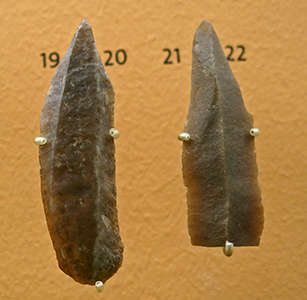
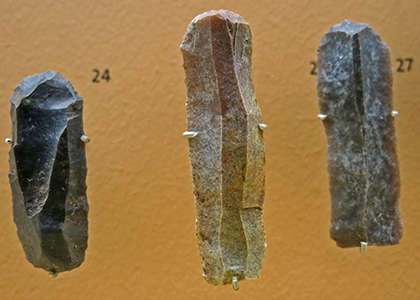
(left photo): Burins
(right photo, on left of photo): Grattoir double, scraper on each end of the tool.
(right photo, centre and right): Grattoirs , scrapers.
Photo: Don Hitchcock 2014
Source: Original, Musée d'Archeologie Nationale et Domaine, St-Germain-en-Laye
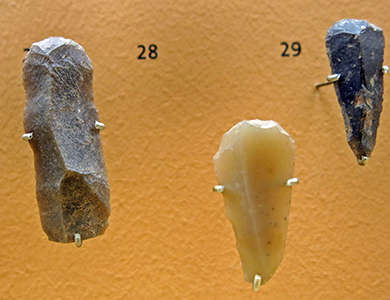
Grattoirs, scrapers.
Photo: Don Hitchcock 2014
Source: Original, Musée d'Archeologie Nationale et Domaine, St-Germain-en-Laye
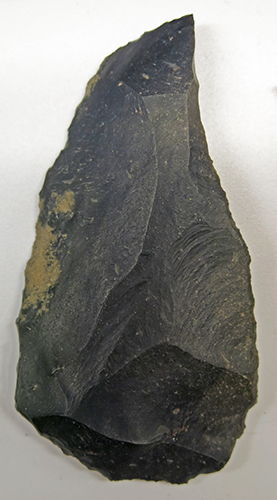
Parrot beaked burin from la Madeleine.
Photo: Don Hitchcock 2015
Source: Original, display at Musée d'Aquitaine à Bordeaux
In 1868 Gabriel de Martillet established a new timescale for the prehistoric centuries, and La Madeleine became the type site for "Magdalenian" times.
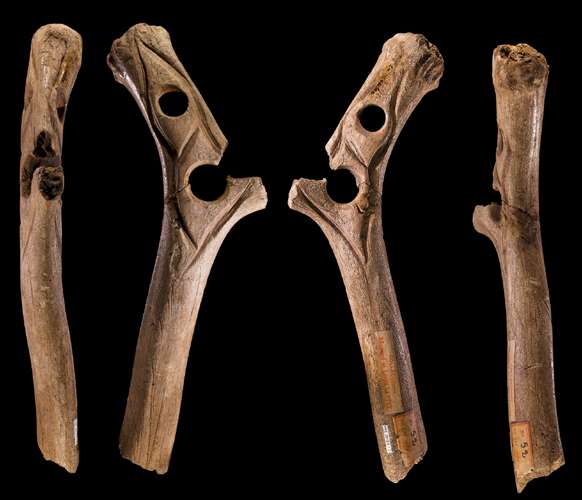
Larger version
Bâton percé in deer antler.
Magdalenian, between 17 000 and 10 000 BP.
La Madeleine, Tursac, Dordogne, France.
Former collection of Édouard Lartet (1801 - 1871), Muséum of Toulouse.
Size : 165x48x21 mm
Photo: Original, Didier Descouens
Permission: Creative Commons Attribution-Share Alike 3.0 Unported license.
The site was also studied by Paul Girod and Elie Massenet, as well as numerous amateur investigators. Denis Peyrony restarted the research in 1911, and refined knowledge of the site. In 1926 the skeleton of a three year old child was discovered, with exquisite shell jewellery, dating from the end of the Magdalenian period. In 1968, following several years without further developments, the research was restarted by Jean-Marc Bouvier.
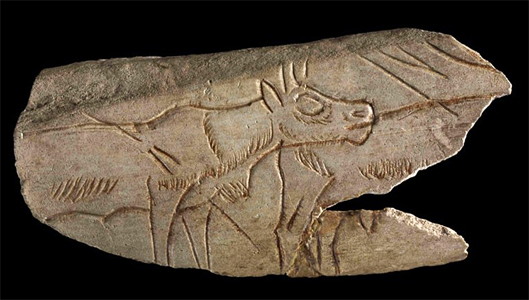
Fragment of decorated reindeer metatarsal (bone) engraved on the obverse surface with two reindeer, one of which is now incomplete; decorated bone; Palaeolithic; Madeleine, France.
Photo: © The Trustees of the British Museum
Text: http://www.telegraph.co.uk/culture/culturepicturegalleries/9847457/Ice-Age-Art-in-pictures.html?frame=2470431

Assegai (spear point) with double beveled base from la Madeleine. Two views of the same object.
Sagaie à base biseautée double. Deux vues du même objet.
Magdalenian
Locality: Tursac, Dordogne, France ; site of La Madeleine
217 x 18 x 15 mm, 21.3 g
Collection Edouard & Louis Lartet
Muséum of Toulouse MHNT.PRE.2010.0.1.4
Photo: Rama, Wikimedia Commons, Cc-by-sa-2.0-fr
commissioned by Wikimédia France
Permission: licensed under the Creative Commons Attribution-Share Alike 2.0 France license.

These are exceptionally well made tools from La Madeleine.
Photo: http://www.aggsbach.de/
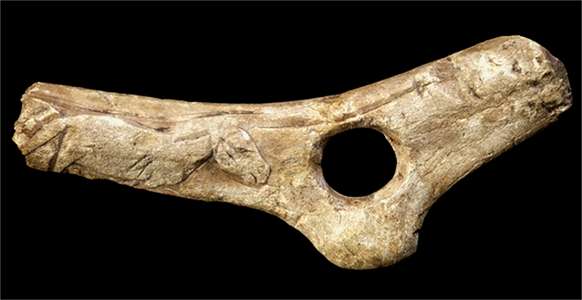
Perforated baton with low relief horse, 16.6 cm long.
Late Magdalenian, about 12 500 years old
From the rockshelter of La Madeleine, Dordogne, France
Made from reindeer antler
Between about 14 000 and 10 000 years ago, many objects made of bone and antler were decorated with animals. At La Madeleine, horses seem to have been a particular favourite. Here the surface of the antler around the outline of the horse has been scraped away, so the body stands out in low relief.
The line of the horses' chest, the way in which the front legs point towards the back and the upward position of the tail all suggest that the animal is running. Its head and eye are large and not accurately to scale with the body. This may be the artist's way of emphasising the character of the animal in a small space. It is a common technique in portable art, but one that is rarely seen in the painted cave art of the period.
Source: www.britishmuseum.org/explore/highlights/highlight_image.aspx?image=k125497.jpg&retpage=21186
Photo and Text: © The British Museum
Other Data:
Length: 16.600 cm
Excavated and bequeathed by Henry Christy
P&EE Sieveking Catalogue no. 310
Room 2
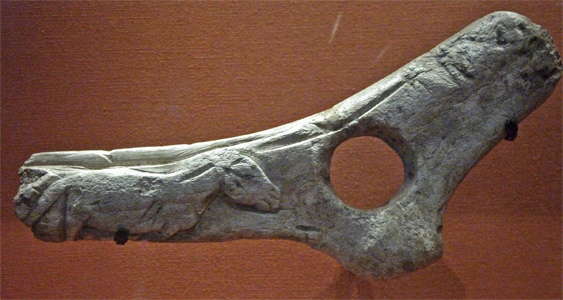
Same object as above, perforated baton with low relief horse, Late Magdalenian, about 12 500 years old, from the rock shelter of La Madeleine, Dordogne, France.
Made from reindeer antler, on display in the British Museum.
Photo: Johnbod
Permission: Creative Commons Attribution-Share Alike 3.0 Unported license.
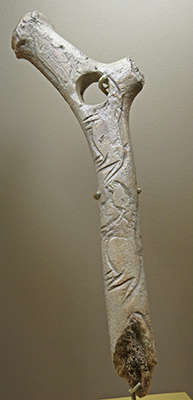
Bâton percé gravé figurant une file de chevaux, spear straightener engraved with a line of three horses.
13 000 BP, reindeer antler, 31 cm long.
Photo: Don Hitchcock 2014
Source: Facsimile, Musée d'Archeologie Nationale et Domaine, St-Germain-en-Laye
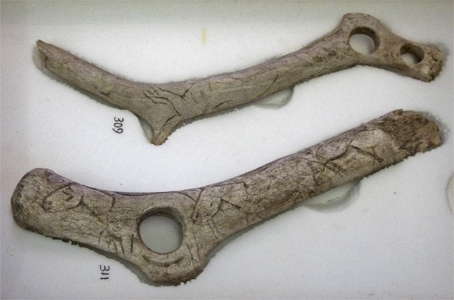
Pierced batons from la Madeleine.
Photo: Johnbod
Permission: licensed under the Creative Commons Attribution-Share Alike 3.0 Unported license.
Source: BM Ice Age Art Event, 2011
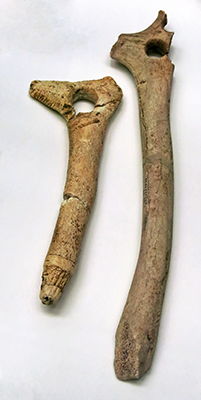
(right) Pierced baton from La Madeleine, Tursac, in reindeer antler.
(left) Pierced baton from Cap Blanc.
Photo: Don Hitchcock 2015
Catalog: 60.524.1 (la Madeleine)
Source: Original, Musée d'Aquitaine à Bordeaux
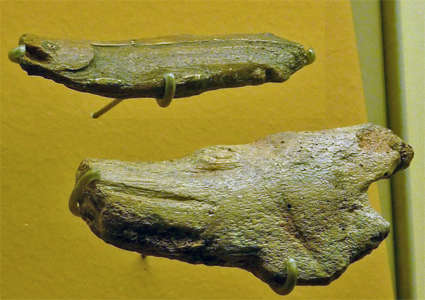
Fish carved in reindeer antler.
Photo: http://anetcha-parisienne.blogspot.com.au/2012/09/en-passant-par-saint-germain-en-laye.html
Source: Facsimiles on display at Le Musée de Saint-Germain-en-Laye
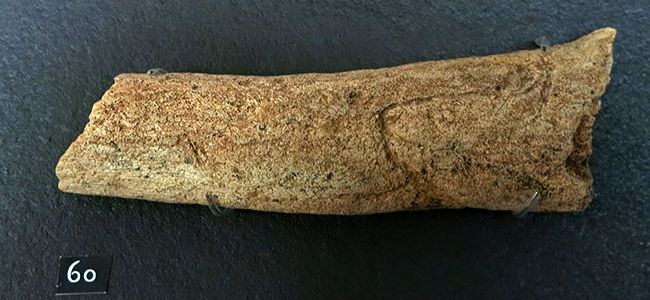
Carving of a feline on antler.
Photo: Don Hitchcock 2014
Source: Original, Le Musée National de Préhistoire, Les Eyzies-de-Tayac
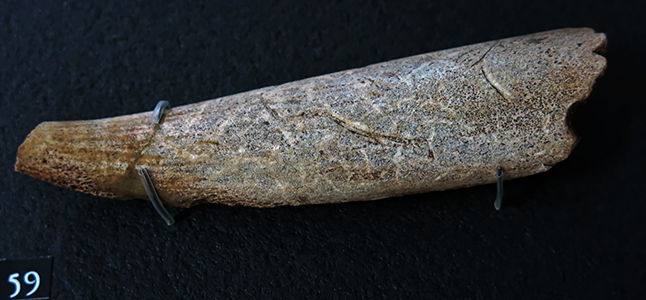
Carving of a deer head on the point of a deer antler.
Photo: Don Hitchcock 2014
Source: Original, Le Musée National de Préhistoire, Les Eyzies-de-Tayac
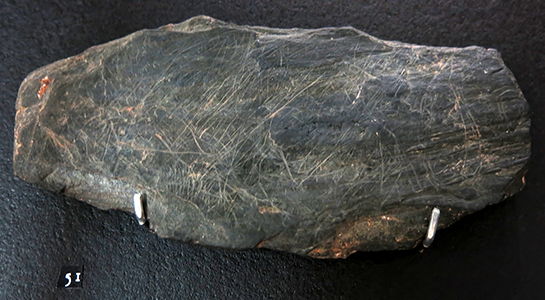
Engraved plaquette.
Photo: Don Hitchcock 2014
Source: Original, Le Musée National de Préhistoire, Les Eyzies-de-Tayac
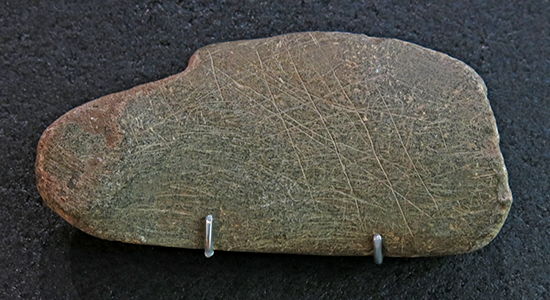
Compresseur from la Madeleine, Upper Magdalenian.
Photo: Don Hitchcock 2014
Source: Original, Le Musée National de Préhistoire, Les Eyzies-de-Tayac


The skeleton of the child burial at La Madeleine.
Photo: Don Hitchcock 2008, 2014
La sépulture de l'enfant de la Madeleine
Magdalénien final
Découverte par D. Peyrony en 1926, cette sépulture d'un enfant de 2 à 4 ans vient d'être datée par spectrométrie de masse de 10 190 ± 100 B.P. (fin de Magdalénien)
La structure funéraire reste modeste: une simple fosse accueille le corps allongé sur le dos; la tête placée au Sud, est entourée de trois pierres. Cette simplicité contraste avec une parure exceptionelle (présentée ci-contre), probablement ocrée, composée de près de 1500 pièces réparties sur le corps.
Burial of the la Madeleine child
Final Magdalenian
Discovered by D. Peyrony in 1926, this burial of a child 2 to 4 years old has been dated by mass spectrometry at 10 190 ± 100 BP (the end of the Magdalenian)
The funeral was modest: a simple pit houses the body lying on her back, her head placed to the south, and was surrounded by three stones. This simplicity contrasts with an exceptional adornment, probably sprinkled with ochre, comprising nearly 1 500 shells spread over the body. (probably originally sewn to a garment - Don)
Photo: Don Hitchcock 2008
Source: Original on display at Le Musée National de Préhistoire, Les Eyzies-de-Tayac
Text: Display at Le Musée National de Préhistoire, Les Eyzies-de-Tayac
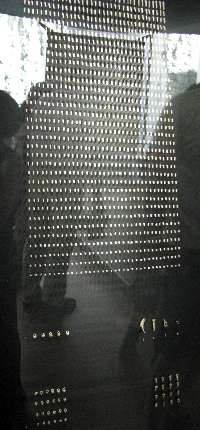
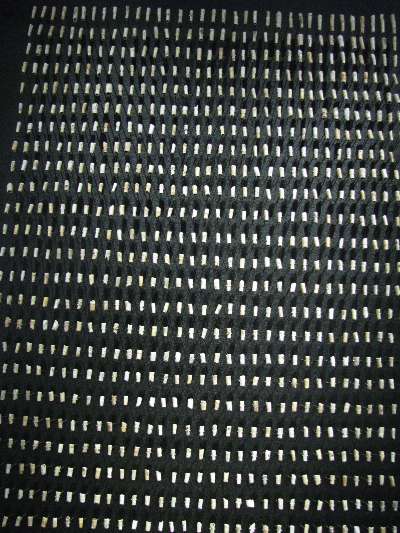
La parure de l'enfant de La Madeleine (Tursac, Dordogne) est fortement enracinée dans le monde magdalénien, bien que datée de 10 190 ± 100 B.P.
En 1927, Denis Peyrony la découvrit ainsi: " [Le] squelette était allongé, étendu sur le dos, suivant la direction Nord-Sud, la tête vers ce dernier point [...]. De nombreux petits coquillages perforés (dentales et turritelles) et des dents percées, se trouvaient dans la région des chevilles, des genoux, des poignets, des coudes, du cou et de la tête [...]. Le cadavre de cet enfant enduit de rouge (saupoudré d'ocre, ou plus vraisemblablement peint avec cette matière), avait été déposé là soigneusement, orné d'une riche parure". L'analyse récente des objets renseigne sur la fabrication, l'assemblage et l'utilisation de cette parure. L'usure des coquillages, tronçonnés en tubes de petite taille, indique que les dentales auraient pu être cousus sur l'habit et que l'enfant aurait pu porter le vêtement de son vivant.
Le nombre d'objets impliqués et le temps nécessaire à la réalisation de cette parure évoquent une motivation dépassant l'affection parentale. Serait-ce lié à une hiérarchisation sociétale à base héréditaire ou à un statut social propre à cette classe d'âge dans les sociétés de la fin du Paléolithique Supérieur?
- Dentalium sp. (1275)
- Cyclopes (5)
- Turritelles (19)
- Néritenes (24)
- Canine de renard
- Phalange de lagomorphe
- Humérus de lagomorphe
- Vertèbre de poisson
In 1927, Denis Peyrony discovered the burial: "The skeleton was lying, stretched out on its back, in the North-South direction, head to the South.... Many small perforated shells (Dentalia and Turritella) and pierced teeth were in the region of the ankles, knees, wrists, elbows, neck and head. The corpse of the child, which was covered with red ochre (sprinkled, or more likely painted with ochre), was removed carefully, and was decorated with a rich parure. The child wore seashells, cut into small tubes, so that the Dentalia shells could be sewn onto the garment, and the child could wear the vestments for the rest of time.
The number of objects involved and the time required to achieve this dress evoke motivation beyond parental affection. Could this be related to a social hierarchy based hereditary or social status specific to this age group in the societies of the late Upper Palaeolithic?
- Dentalium sp. (1275)
- Cyclope sp. (5)
- Turritella (19)
- Néritenes (Neritidae?) (24)
- Fox canine tooth
- Lagomorpha phalange (Lagomorpha are animals from the hare/rabbit family)
- Lagomorpha humerus (Lagomorpha are animals from the hare/rabbit family)
- Fish vertebra
Source: Originals on display at Le Musée National de Préhistoire, Les Eyzies-de-Tayac
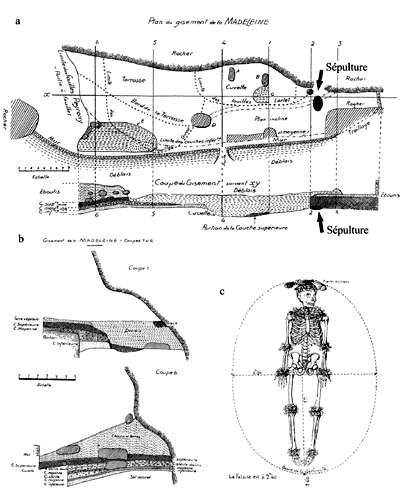
Excavated by D. Peyrony in 1926 (Peyrony 1926, 1927, Capitan et Peyrony 1928) in the eponymous site of the Magdalenian, the tomb of the La Madeleine child was discovered in a strongly ochred depression, located in the eastern part of the shelter 260 cm from the wall.
Although Peyrony estimated the remains to be of a child of 5 to 7 years old, they correspond more closely to an individual aged between 2 and 4 years of age.
The child had been deposited lying on the back. The head, facing south, was surrounded by three stones and decorated, as was the neck, elbows, wrists, knees and ankles by "many small shells and perforated teeth" (Capitan et Peyrony, 1928). Unfortunately, Peyrony did not give more precise information on the nature and location of these objects.
Their representation in the drawing that illustrates the burial site of the monograph is too schematic to identify them and do not reveal morphological differences sufficient to identify each category of objects and identify their location on the skeleton.
In its inventory of shell ornaments associated with this burial Taborin (1993) mentions 900 Dentalium, 160 Neritina, 20 Cyclope and 36 Turritella shells.
The attribution of this tomb in Magdalenian IV, given by Capitan and Peyrony and accepted by most authors, has recently been contradicted by the direct dating by AMS 14C of a fragment of the skull of the child which gave an age of 10,190 ± 100 BP (95,457 GIFA) or 9990-10390 cal BP, which assigns the child to the Azilian period.
Photo: Capitan et Peyrony (1928)
Text: translated from Vanhaeren et d’Errico (2001)
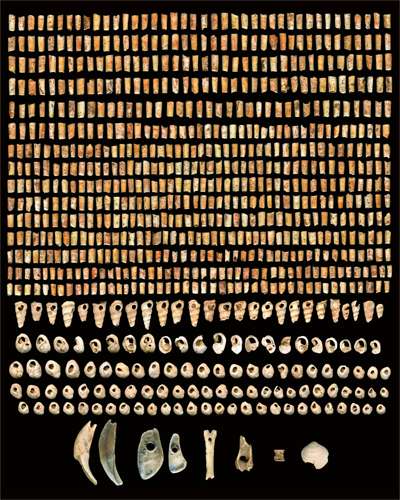
Ornaments found in a box labelled "Magdalenian IV" but probably belonging to the La Madeleine child.
Photo and text: Vanhaeren et d’Errico (2001)
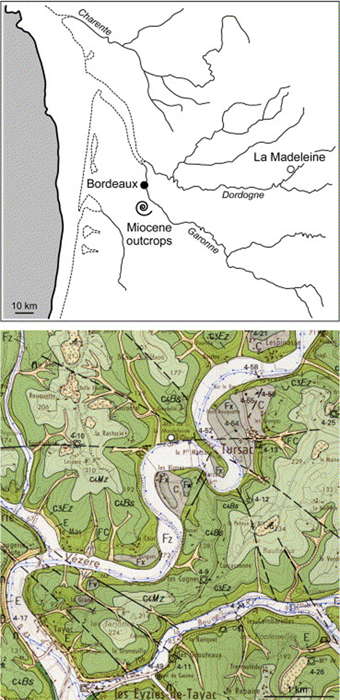
It seems likely that the Dentalium shells used for parure on the Madeleine child were collected from beaches. Shown on the map are the location of the La Madeleine site and Miocene fossil outcrops from Saucats-La Brède. Coastline at 10 ka BP is indicated by a solid line, present day coast by an interrupted line.
Bottom: Geological map with the location of the La Madeleine site (white dot). C3EZ: Middle–Upper Coniacian, C4BS: Lower Santonian, C4MZ: Middle Santonian, A, E, C, FC, FX: Quaternary formations.
While the identification of the source of shells used as personal ornaments is crucial for determining home range and exchange networks of prehistoric hunter-gatherers, it is often difficult to identify the coastal versus fossil origin of the shells as most genera used as beads were available both at beaches and fossil outcrops. Here we present the first application of 87Sr / 86Sr isotope dating to identify the origin of Upper Palaeolithic shell beads. We analysed four out of a collection of one thousand Dentalium shells associated to the La Madeleine child burial dated to and one Dentalium from the occupation layers of this site.
87Sr / 86Sr ratios indicate that shells were collected by Late Upper Palaeolithic beadworkers on far away beaches rather than at nearer Miocene outcrops. This may be due to the narrowness of Miocene Dentalium shells, incompatible with the size of bone needles used to sew these shell beads on clothes.
Photo and text: Vanhaeren et al (2004)
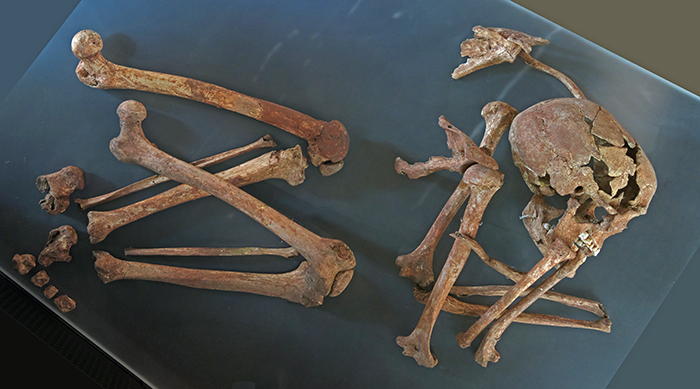
A Middle Magdalenian Burial
La sépulture de Saint-Germain-La-Rivière, Magdalénien moyen.
Découverte en 1934 par R. Blanchard, La sépulture de Saint-Germain-La-Riviere abritait le squelette complètement enduit d'ocre d'une femme d'une trentaine d'années richement parée. Les parois de la fosse étaient étayées par des dalles formant caisson, lui-même recouvert de deux grosses pierres plates constituant le couvercle. Il semble que cette structure de 'dolmen' abusivement admise pendant longtemps, ait été créée de toute pièce par les conditions particulières dans lesquelles s'est effectuée la fouille.
Photo: Don Hitchcock 2014
Source: Original on display at Le Musée National de Préhistoire, Les Eyzies-de-Tayac
Text: Display at Le Musée National de Préhistoire, Les Eyzies-de-Tayac

La présentation proposée aujourd'hui parait beaucoup plus fiable. La position latérale fortement fléchie semble caractéristique de l'époque et se différencie nettement des inhumations postérieures (voir, à proximité, les sépultures de la Madeleine ou du Roc-de-Cave). Le squelette a tout récemment été daté de 15 780 ± 200 BP, comme d'autres fossiles humains de la région, contemporains du Magdalénien moyen (Chancelade et Laugerie-Basse IV par exemple).
Photo: Don Hitchcock 2014
Source: Original on display at Le Musée National de Préhistoire, Les Eyzies-de-Tayac
Text: Display at Le Musée National de Préhistoire, Les Eyzies-de-Tayac
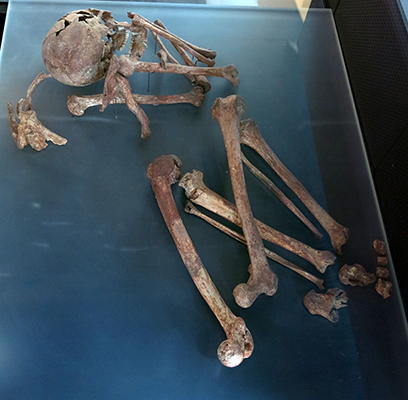
The burial at Saint-Germain-la-Rivière, Middle Magdalenian.
Discovered in 1934 by R. Blanchard, the grave at Saint-Germain-la-Riviere contained a skeleton completely coated with ochre, of a richly adorned woman, about thirty years of age. It had been reported that the walls of the pit were supported by slabs forming a box, itself covered with two large flat stones forming the cover. It seems that this 'dolmen' structure was wrongfully accepted for a long time, but it is now believed that the structure had been falsely understood by the particular conditions under which the excavations were performed at that time.
Photo: Don Hitchcock 2014
Source: Original on display at Le Musée National de Préhistoire, Les Eyzies-de-Tayac
Text: Display at Le Musée National de Préhistoire, Les Eyzies-de-Tayac
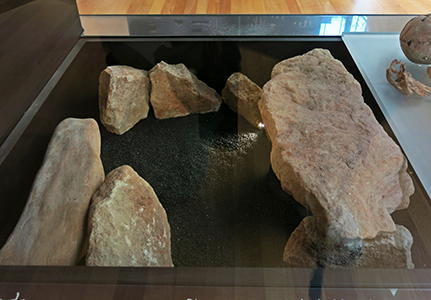
The presentation proposed today seems much more reliable. (see the way the position of the stones is now interpreted, left - Don ). The highly flexed lateral position seems characteristic of the time and is clearly distinguishable from subsequent burials (see, nearby, the graves of la Madeleine or the Roc de Cave).
The skeleton has recently been dated to 15 780 ± 200 BP, like other human fossils in the region, in the contemporary Middle Magdalenian (Chancelade and Laugerie Basse IV for example).
Photo: Don Hitchcock 2014
Source: Original on display at Le Musée National de Préhistoire, Les Eyzies-de-Tayac
Text: Display at Le Musée National de Préhistoire, Les Eyzies-de-Tayac

Human profile engraved on a pebble from la Madeleine.
Photo: http://www.arretetonchar.fr/
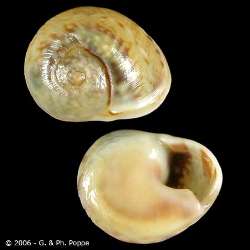
Cyclope neritea, one of the cyclope shells, from Spain, San Carlos de la Rapita. On sand, 20 cm deep. June 2001.
This is probably not the same species as was used for the La Madeleine parure, but gives some idea of the genus.
Photo: http://www.conchology.be/en/availableshells/shellsforsaledetails.php?uniquenumber=305516#f
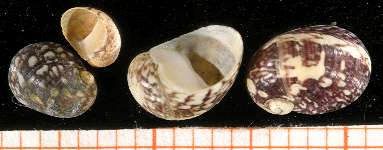
Theodoxus fluviatilis, common name the river nerite, is a small species of freshwater and brackish water snail with a gill and an operculum. It is an aquatic gastropod mollusk in the family Neritidae, the nerites. (This I think is similar to the shells labelled Néritenes in the display of the parure of the Magdalenian child. - Don)
Photo: Wikipedia
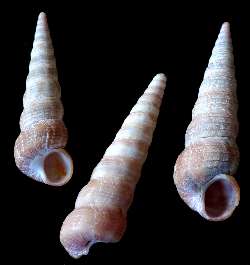
There are many species of Turritella, and those in the parure were not identified to species, but one of the most common in Europe is Turritella communis, a species of medium-sized sea snails with an operculum, marine gastropod mollusks in the family Turritellidae.
The photo shows three beachworn shells of Turritella communis from North Wales
Photo: Wikipedia
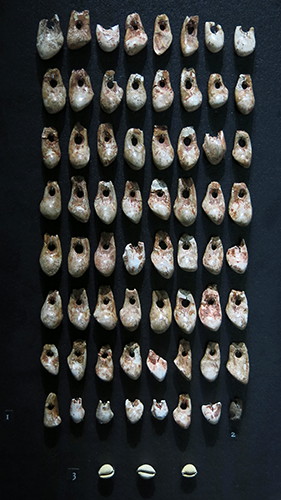
Deer teeth and cowrie shells from one of the burials at La Madeleine.
Photo: Don Hitchcock 2014
Source: Originals on display at Le Musée National de Préhistoire, Les Eyzies-de-Tayac
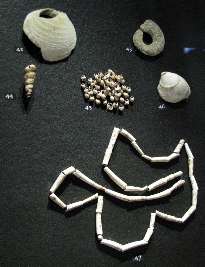
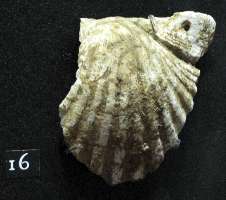
Parures Funéraires
Photo: Don Hitchcock 2008
Source: Originals on display at Le Musée National de Préhistoire, Les Eyzies-de-Tayac
Evocation d'une parure paléolithique
F. Boutis, 2004
La réalisation de ces pièces contemporaines s'est appuyée sur l'étude d'éléments de parures paléolithique.
Evocation of a Paleolithic parure
F. Boutis, 2004
This beautiful recreation was based on study of the elements of Paleolithic decorated clothing.
Photo: Don Hitchcock 2008
Source: Originals on display at Le Musée National de Préhistoire, Les Eyzies-de-Tayac
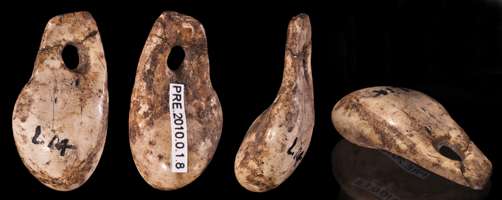
Several views of a single deer canine, drilled for a necklace.
Photo: (fr.wikipedia.org/wiki/Fichier:Collier_1.8_global.jpg)
Date: 14 juin 2010
Photo: Didier Descouens
Permission: En tant que détenteur du droit d’auteur, je publie cette œuvre sous la licence suivante :
w:fr:Creative Commons, paternité partage à l’identique. Ce fichier est disponible selon les termes de la licence Creative Commons Paternité – Partage des conditions initiales à l’identique 3.0 Unported
Source: Original on display at the Muséum de Toulouse MHNT PRE 2010.0.1.8 (Size 20x11x7 mm)
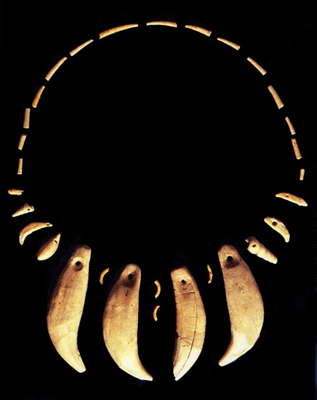
A necklace from Abri du Rocher de la Peine, near Les Eyzies.
It is Magdalenian in age, and consists of three cave bear teeth and one lion tooth, together with other drilled teeth and shells, including fossil Dentalium shells.
This is the description from Beloit College, the Logan Museum of Anthropology:
Magdalenian IV, ca. 12 000 BP
Dentalium shell and bear, lion, fox and deer teeth
Largest tooth 8.5 cm
Rocher de la Peine, Les Eyzies (Dordogne), France
Museum Purchase
LMA 4.7.253
These objects were purchased in 1925 from Jean Esclafer, a local miller who had excavated the site, and from whom the Logan Museum leased the site for further exploration. Three of the large teeth are bear canines, the fourth is from a lion (second from the right). A number of smaller teeth are also present: a wolf incisor, a deer canine and incisor, and a fox canine.
Photo and text: http://www.istmira.com/foto-i-video-pervobytnoe-obschestvo/3923-iskusstvo-predystorii-pervobytnost-1.html
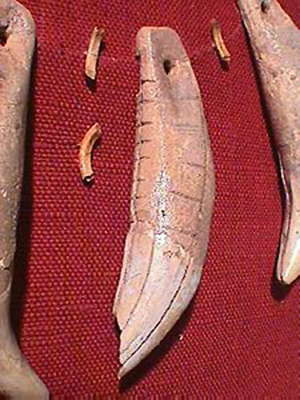
Necklace detail.
LMA 4.7.253
A detail of the lion canine reveals a series of incisions along all sides of the tooth. The tooth has been flattened and drilled for use as a pendant in a necklace. The incisions may indicate that this was considered a valued piece, perhaps because it came from a lion rather than from the more common bear.
Photo and text: http://www.beloit.edu/logan_online/exhibitions/virtual_exhibitions/before_history/europe/rocher_de_la_peine.php
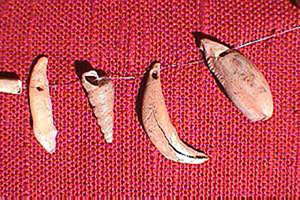
Necklace detail from Rocher de la Peine.
LMA 4.7.253
A variety of other teeth and shell form the remainder of the pendants. Here we have, (from the top), a red deer incisor, turritella shell, fox canine and cowrie shell. Such variety indicates the relative rarity of the various pieces, as well as a degree of artistic sensibility.
The site at the Abri Rocher de la Peine was excavated in 1926 by George Collie and Alonzo Pond, and has been referred to as the "Logan Museum site". The site yielded a large number of ivory objects.
Photo and text: http://www.beloit.edu/logan_online/exhibitions/virtual_exhibitions/before_history/europe/rocher_de_la_peine.php

An early postcard of the Abri Rocher de la Peine.
Photo: Oeuil de Lynx, http://www.flickr.com/photos/oeuil_de_lynx/2250600432/lightbox/
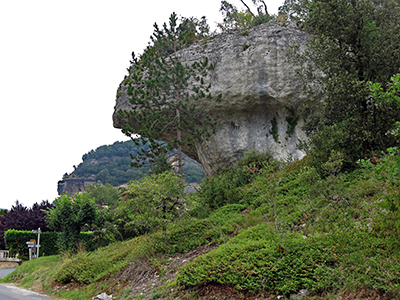
Abri Rocher de la Peine.
Photo: Don Hitchcock 2014
Carvings from La Madeleine in the Dordogne
These stunning pieces of art were used as propulseurs. A bison licking its shoulder on the left, a hyena in the centre, and what I think of as the 'sad' bison on the far right.
Photo: Don Hitchcock 2008
Source: Originals on display at Le Musée National de Préhistoire, Les Eyzies-de-Tayac
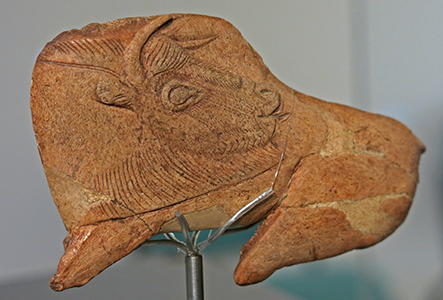

Bison, left side.
Photo: Don Hitchcock 2014
Source: Original, le Musée National de Préhistoire, Les Eyzies-de-Tayac
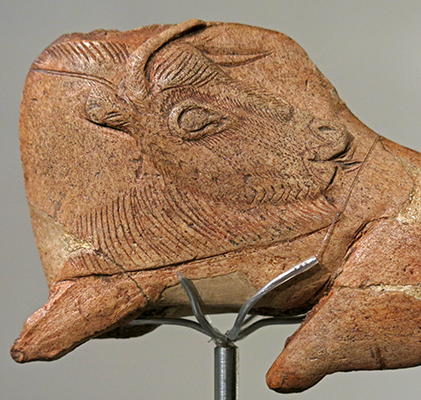
Close up of the head and forequarters of the bison.
Photo: Don Hitchcock 2014
Source: Original, le Musée National de Préhistoire, Les Eyzies-de-Tayac
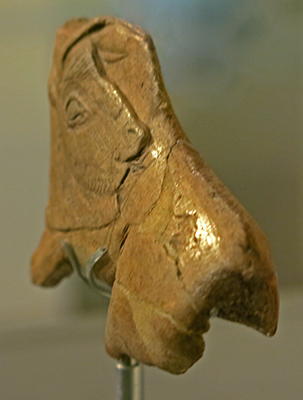
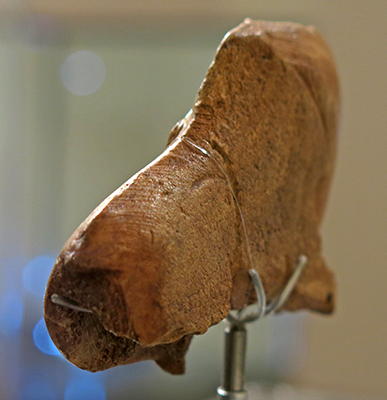
Bison, shown from the rear of the sculpture.
Photo: Don Hitchcock 2014
Source: Original, le Musée National de Préhistoire, Les Eyzies-de-Tayac
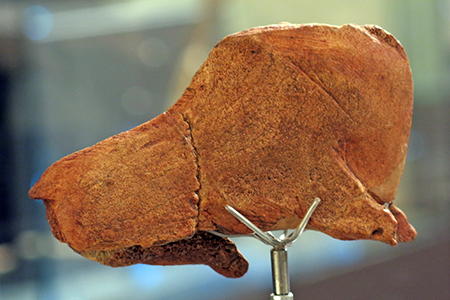
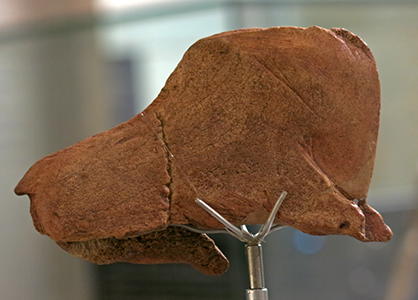
Right side of bison.
Photo: Don Hitchcock 2014
Source: Original, le Musée National de Préhistoire, Les Eyzies-de-Tayac
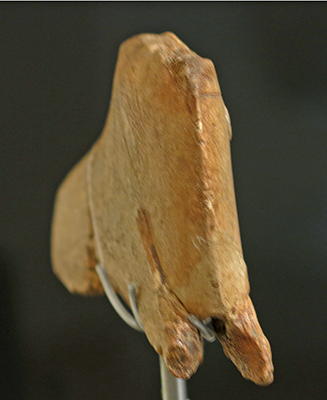
Bison sculpture from the front, showing left and right sides.
Photo: Don Hitchcock 2014
Source: Original, le Musée National de Préhistoire, Les Eyzies-de-Tayac
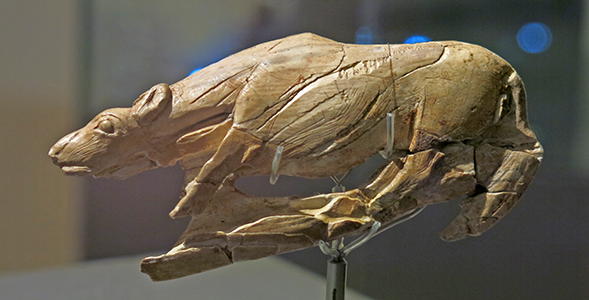
This is the front of the hyena propulseur.
Photo: Don Hitchcock 2014
Source: Original on display at Le Musée National de Préhistoire, Les Eyzies-de-Tayac

The artist has included the ground surface on which the hyena is sneaking up on its prey. This is like a scene in nature, a superb piece of work.
Photo: Don Hitchcock 2014
Source: Original on display at Le Musée National de Préhistoire, Les Eyzies-de-Tayac
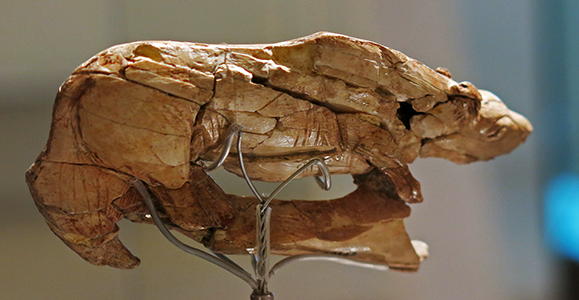
This is the rarely photographed back of the hyena propulseur, showing clearly the many pieces that the propulseur was found in, as well as a good view of the hook used to propel the dart.
Photo: Don Hitchcock 2014
Source: Original, le Musée National de Préhistoire, Les Eyzies-de-Tayac
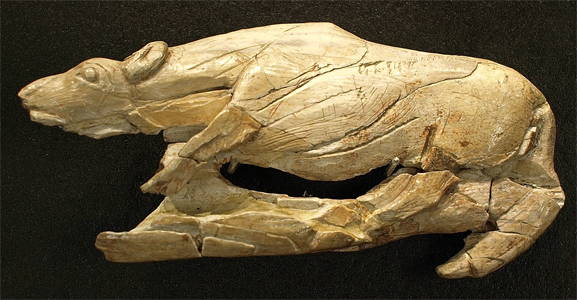
This is a large version of this very important work, and I am grateful to the uploader of the image. I have flipped it horizontally to agree with reality, though this problem has now been rectified on the Wikipedia page.
Wikipedia text: Part of a spear thrower made of reindeer antler, found in the Abri La Madeleine (Tursac in the Dordogne, France). Exhibit of the National Prehistoric Museum in Eyzies-de-Tayac.
Photo: Klaus D. Peter, Wiehl, Germany
Permission: Creative Commons License Attribution 3.0 Germany
(note that this photo seems to have been slightly stretched longitudinally compared with all the photos I have taken.
At the time of writing, December 2014, readers may compare the versions at:
de.wikipedia.org/w/index.php?title=Datei:Propulseur_hy%C3%A8ne_rampante_-_La_Madeleine_-_Tursac_-_MNP.png&filetimestamp=20110823160802
and at:
de.wikipedia.org/wiki/Datei:Speerschleuder_LaMadeleine.jpg
The photos on the first link to a Wikipedia page for this artefact have all been horizontally flipped except for the original 2009 version. They have been outlined to remove the background, which is rarely a good idea unless done with great skill and a lot of care. I am very grateful that Wikipedia gives the various versions which have been posted, a very responsible attitude, such as we have come to expect from Wikipedia in all sorts of ways. I had not realised before the great value of this particular idiosyncrasy of Wikipedia - Don )

African hyena, photographed in Kenya.
Note the characteristic long muscular neck, short hind legs, and prominent ears.
Photo: © L. Franco
Source: https://www.emaze.com/@AFTZQLOI/African-Wild-Dog
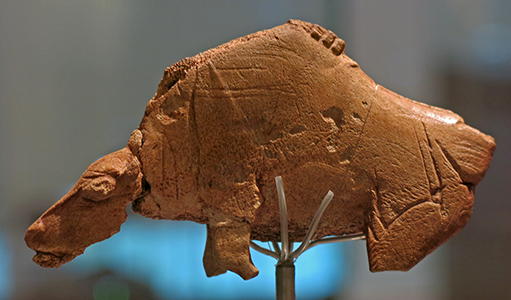
'Sad' bison, left side.
Photo: Don Hitchcock 2014
Source: Original, le Musée National de Préhistoire, Les Eyzies-de-Tayac
'Sad' bison, right side.
The piece is an amulet, the remains of a suspension hole may be seen at the throat.
Photo: Don Hitchcock 2014
Source: Original, le Musée National de Préhistoire, Les Eyzies-de-Tayac

Harpoons and other bone/antler tools from La Madeleine in the Dordogne
Photo: Don Hitchcock 2008
Source: Originals on display at Le Musée National de Préhistoire, Les Eyzies-de-Tayac
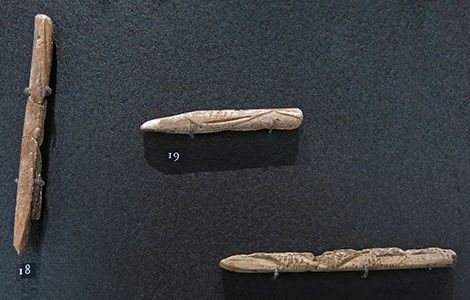
These are labelled as ciseaux, or chisels. The term is somewhat enigmatic, and I have been unable to find a sensible use, or even a reliable definition, for items of this type. The ones shown here are basically cylindrical, with one end narrower than the other, and somewhat sharpened. Number 19 is labelled as a double bevel chisel.
Many are flat, like modern chisels, but without handles. Being of bone or antler, they could have been used (for purposes suitable for what we now think of chisels) on only the most delicate of tasks, perhaps breaking apart bones previously weakened by a burin to form shapes suitable for bone spear points, for example.
Photo: Don Hitchcock 2014
Source: Original, Le Musée National de Préhistoire, Les Eyzies-de-Tayac
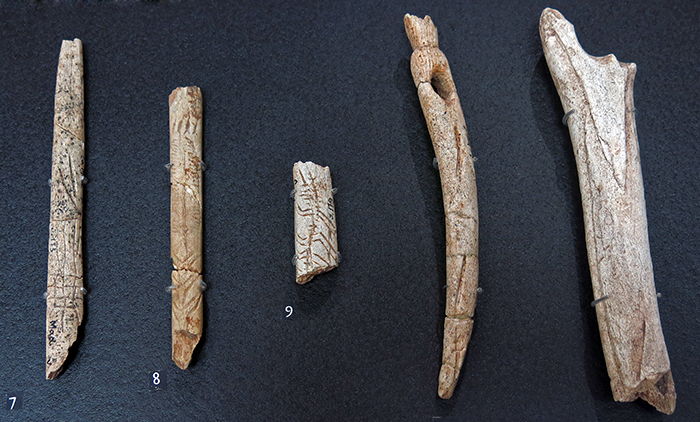
Left to right:
Three baguettes demi-ronde, and two batons percé.
The baguettes demi-ronde are half cylinders which were wrapped around a flint point forming the end of an ivory or antler or bone spear head, depending on the material of which they were made. They were then attached to a spear/dart shaft, and were treated as, to some extent, disposable, as opposed to the spear shaft which was not easy to replace, and required a great deal of work to create, as well as the raw material (long, thin saplings) being in short supply in many times of the palaeolithic.
At this time, climatic conditions were harsh, and not conducive to the growth of such plants. In addition, spear shafts/darts were long and awkward to lug around, and not many could be carried by a hunter at one time, whereas many prepared spear heads could be easily transported in a small leather bag, and swapped fairly easily as required. The spear heads were designed to come apart from the shafts once they had sunk into the prey, leaving the shafts to be collected undamaged, and reused.
The baton percé second from the right calls into question the alleged purpose of these tools as spear straighteners. This small, delicate tool could never have served this purpose.
Photo: Don Hitchcock 2014
Source: Original, Le Musée National de Préhistoire, Les Eyzies-de-Tayac
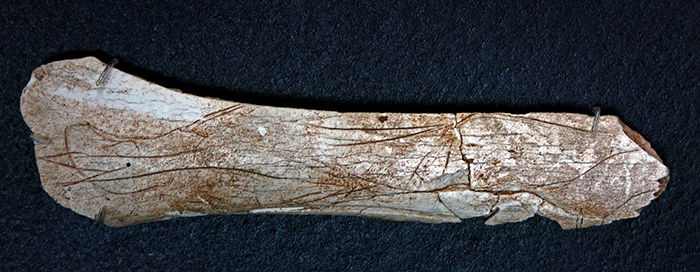
Decorated diaphyse, the middle portion of a long bone, Middle Magdalenian.
Photo: Don Hitchcock 2014
Source: Original, Le Musée National de Préhistoire, Les Eyzies-de-Tayac
Engraving of a horse head on a diaphysis, the middle of a long bone, Middle Magdalenian.
Photo: Don Hitchcock 2014
Source: Original, Le Musée National de Préhistoire, Les Eyzies-de-Tayac
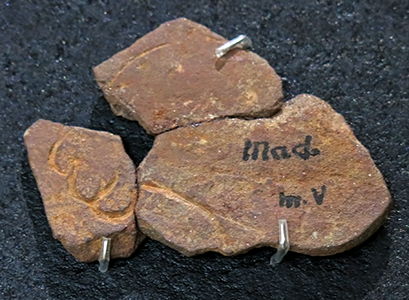
Engraving of a lion head on a sandstone plaque, Upper Magdalenian.
Photo: Don Hitchcock 2014
Source: Original, Le Musée National de Préhistoire, Les Eyzies-de-Tayac
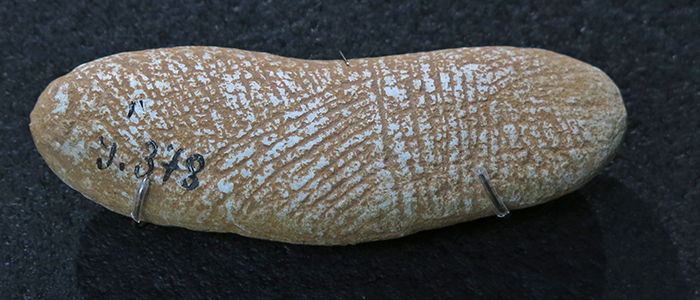
Pebble engraved with a pattern, Upper Magdalenian.
Photo: Don Hitchcock 2014
Source: Original, Le Musée National de Préhistoire, Les Eyzies-de-Tayac
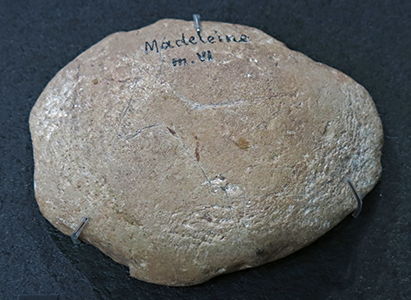
Engraving of an ibex on a pebble, Upper Magdalenian.
Photo: Don Hitchcock 2014
Source: Original, Le Musée National de Préhistoire, Les Eyzies-de-Tayac
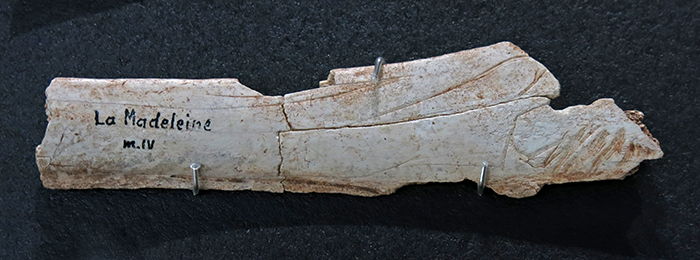
Engraved rib, used as a compressor in flint knapping, Middle Magdalenian.
Photo: Don Hitchcock 2014
Source: Original, Le Musée National de Préhistoire, Les Eyzies-de-Tayac

Engraved horse head on a diaphyse, the middle of a long bone, Middle Magdalenian.
Photo: Don Hitchcock 2014
Source: Original, Le Musée National de Préhistoire, Les Eyzies-de-Tayac
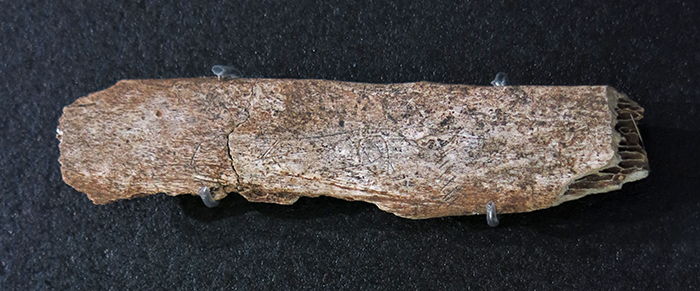
Engraved horse head on a rib, Middle Magdalenian.
This is a quite rectilinear design, with even the eye shown as a rectangle.
Photo: Don Hitchcock 2014
Source: Original, Le Musée National de Préhistoire, Les Eyzies-de-Tayac
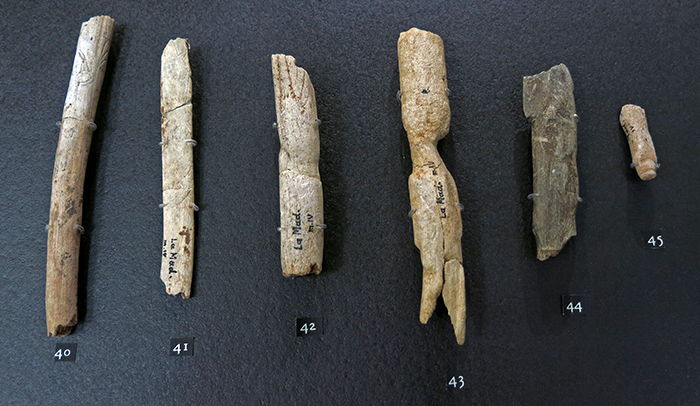
Middle Magdalenian.
40 Antler.
41 Rib.
42 Shaft, probably a propulseur, a spear thrower.
43 Propulseur, spear thrower.
44 Probable propulseur, spear thrower.
45 Sculpted antler, probably a leg.
Photo: Don Hitchcock 2014
Source: Original, Le Musée National de Préhistoire, Les Eyzies-de-Tayac

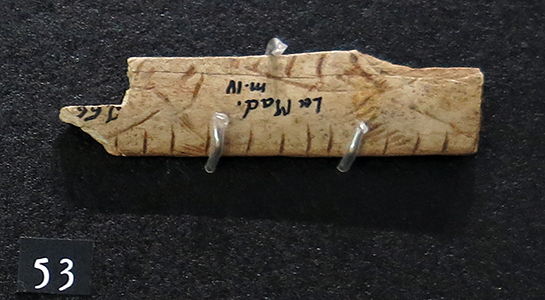
Middle Magdalenian.
(left) Rib.
(right) Lissoir, a polisher for preparing leather.
Photo: Don Hitchcock 2014
Source: Original, Le Musée National de Préhistoire, Les Eyzies-de-Tayac
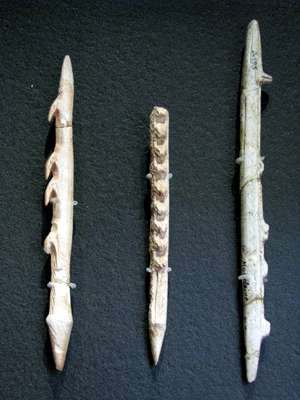
Harpoons from La Madeleine in the Dordogne
Photo: Don Hitchcock 2008
Source: Originals on display at Le Musée National de Préhistoire, Les Eyzies-de-Tayac
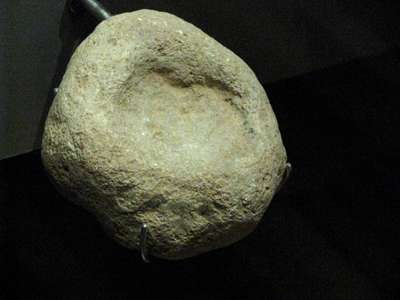
Lamp carved in limestone, from la Madeleine. It would have had fat or oil in the depression, with a twist of moss or string for a wick.
Photo: Don Hitchcock 2008
Source: Originals on display at Le Musée National de Préhistoire, Les Eyzies-de-Tayac
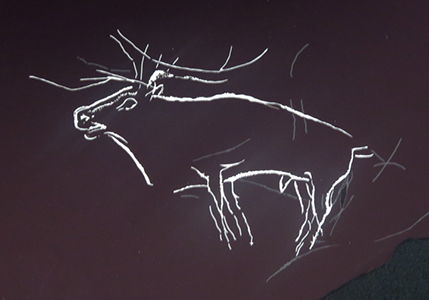

Reindeer.
From la Madeleine.
Photo: Don Hitchcock 2014
Source: Original, Le Musée National de Préhistoire, Les Eyzies-de-Tayac
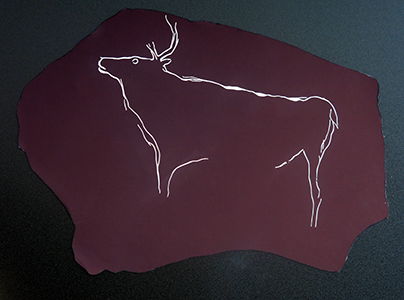
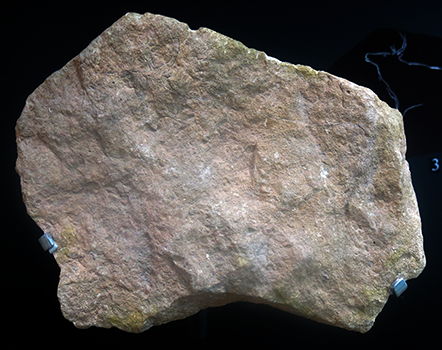
Male reindeer bellowing during the rutting season.
From la Madeleine.
Photo: Don Hitchcock 2014
Source: Original, Le Musée National de Préhistoire, Les Eyzies-de-Tayac
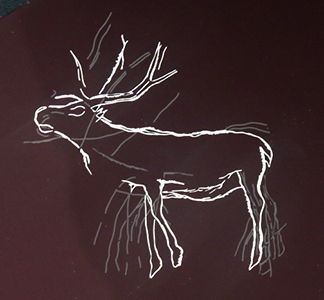
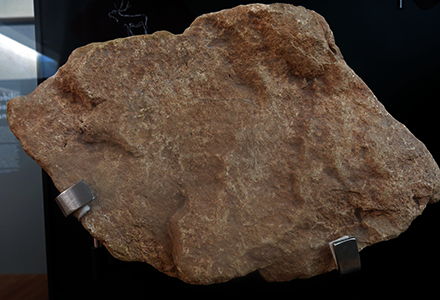
Male reindeer bellowing during the rutting season.
From la Madeleine.
Photo: Don Hitchcock 2014
Source: Original, Le Musée National de Préhistoire, Les Eyzies-de-Tayac
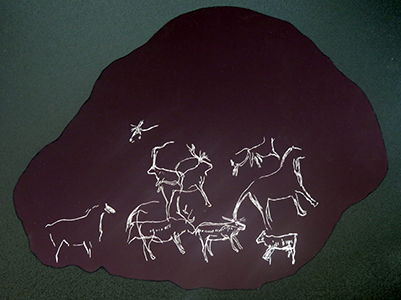
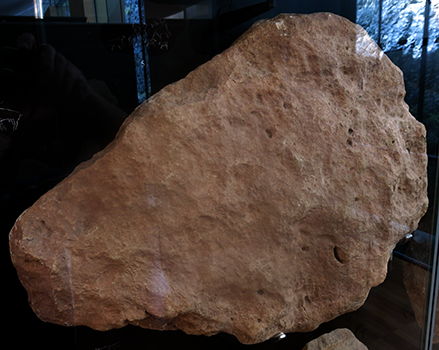
Reindeer, horses, other animals, and indeterminate lines.
From la Madeleine.
Photo: Don Hitchcock 2014
Source: Original, Le Musée National de Préhistoire, Les Eyzies-de-Tayac
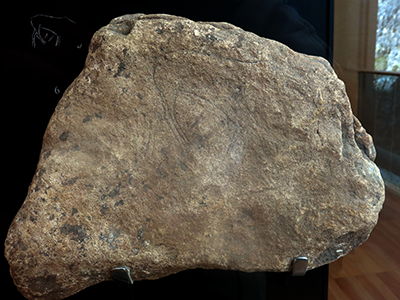

Grazing reindeer.
From la Madeleine.
Photo: Don Hitchcock 2014
Source: Original, Le Musée National de Préhistoire, Les Eyzies-de-Tayac
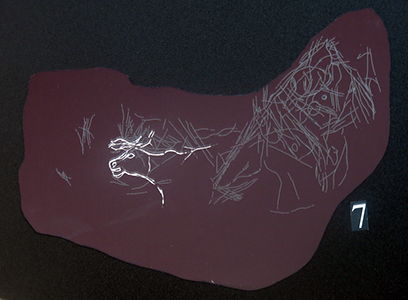
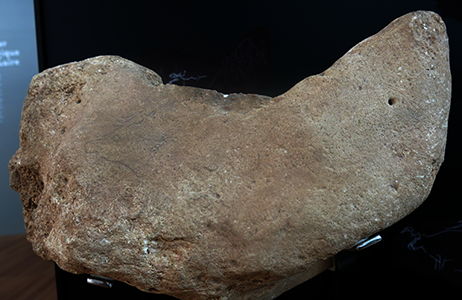
Head, neck, shoulders and chest of a reindeer.
From la Madeleine.
Photo: Don Hitchcock 2014
Source: Original, Le Musée National de Préhistoire, Les Eyzies-de-Tayac
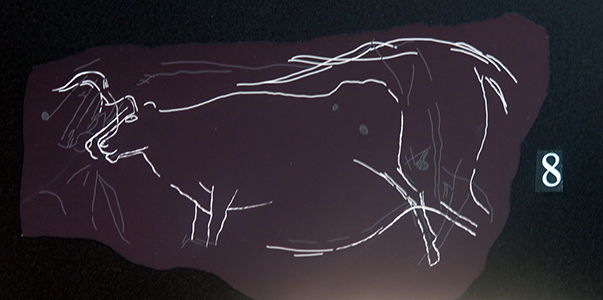

Aurochs and the hindquarters of a horse.
From la Madeleine.
Photo: Don Hitchcock 2014
Source: Original, Le Musée National de Préhistoire, Les Eyzies-de-Tayac
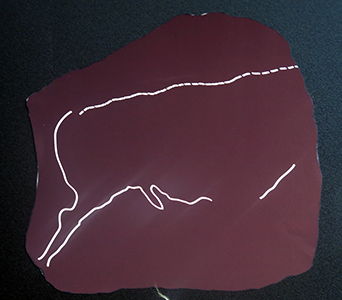
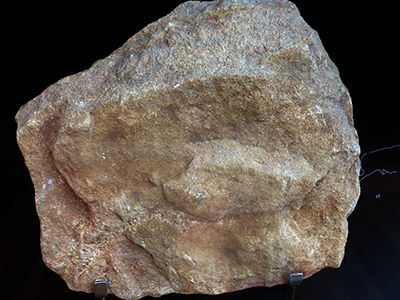
Hindquarters of a reindeer.
From la Madeleine.
Photo: Don Hitchcock 2014
Source: Original, Le Musée National de Préhistoire, Les Eyzies-de-Tayac
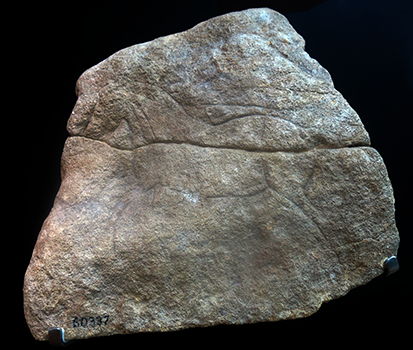
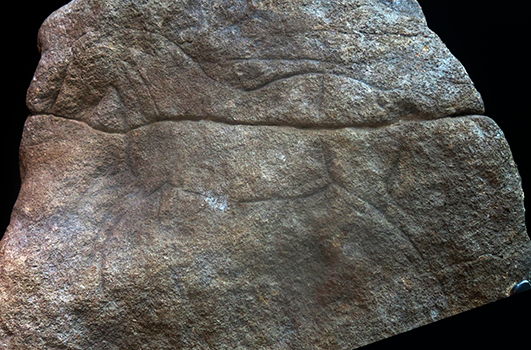
Horse.
From la Madeleine.
Photo: Don Hitchcock 2014
Source: Original, Le Musée National de Préhistoire, Les Eyzies-de-Tayac
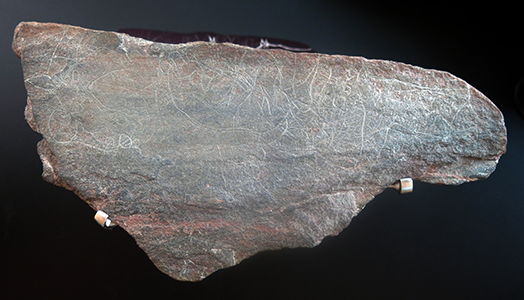
Lynx, indeterminate signs and lines.
From la Madeleine.
Photo: Don Hitchcock 2014
Source: Original, Le Musée National de Préhistoire, Les Eyzies-de-Tayac

Engraving of a reindeer on stone, Magdalenian.
Photo: Don Hitchcock 2008
Source: Original on display at Le Musée National de Préhistoire, Les Eyzies-de-Tayac

Engraving of an aurochs on stone, Magdalenian.
Photo: Don Hitchcock 2008
Source: Original on display at Le Musée National de Préhistoire, Les Eyzies-de-Tayac

Ibex carved on a rib, from Grotte des Eyzies, Magdalenian.
Photo: Don Hitchcock 2008
Source: Original on display at Le Musée National de Préhistoire, Les Eyzies-de-Tayac
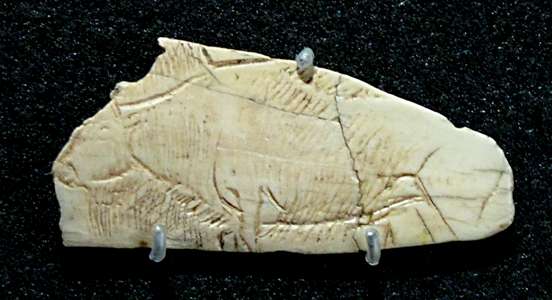
Bison carved on a lissoir, a polisher, from Arancou, Magdalenian.
Photo: Don Hitchcock 2008
Source: Original on display at Le Musée National de Préhistoire, Les Eyzies-de-Tayac
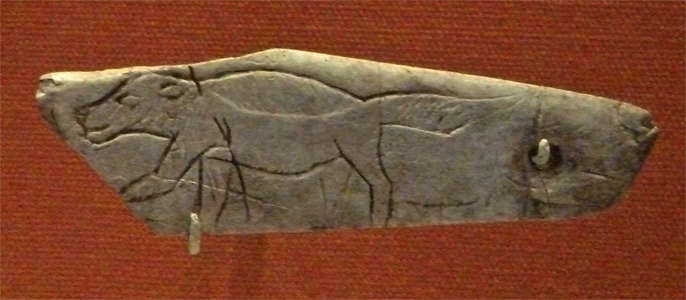
Bone pendant decorated with an engraved drawing of a wolverine, Late Magdalenian, around 12&nbp;500 years old.
Probably from the cave of Les Eyzies, Dordogne, France
Photo: Johnbod
Permission: Creative Commons Attribution-Share Alike 3.0 Unported license.

Two horses carved on a propulseur or spear thrower, from La Madeleine.
Photo: Don Hitchcock 2008
Source: Original on display at Le Musée National de Préhistoire, Les Eyzies-de-Tayac
Fig. 1. A cylindrical piece of reindeer antler, on which are carved two outlines of fishes, one on each side. In the figure here given, the form of the head, the shape of the gills, an obscure indication of the back-fin, and the proportions and general appearance permit us to refer this fish to one of the freshwater kind, probably of the Cyprinoid (Carp) family.
The fragment is broken at both ends ; and we can scarcely form an opinion as to its original use, and whether, indeed, it was an ornament or not. From La Madelaine.
Fig. 2. This is a piece of bird's bone, broken at both ends by old fractures. The absence of an articular extremity makes it very difficult to attribute a specific relation for this bone. Nevertheless, in spite of its broken and worn condition, we may recognise the upper part of a cubitus of a very large
palmipede (web footed bird), probably a swan. On it is engraved the incomplete figure of a four-footed mammal standing still.
( Note that the pepper's patches evident on this mammal identify it as a young and/or female deer or reindeer - Don )
By the old fracture of the fore part the head has been lost; but what remains of the shoulder, rising towards the withers, which join by a slight incurving the line of the back, that ends in a short tail, enables us to recognise the reindeer, so often represented by the aborigines of Périgord. The four legs, but not their extremities, are shown. Hatchings or indications of hair under the line of the back, at the beginning of the limbs, and below the ribs, have given a kind of relief to the drawing. It is not apparent for what intention this figure has been surcharged with a longitudinal series of chevrons or zigzag lines from shoulder to haunch. The figure is in other respects boldly drawn, and the contours vigorously rendered.
From La Madelaine.
Fig. 3. This is also a fragment, broken at the ends, and showing at one of them the broken rim of a hole intended either for hanging it up by, or for some other use. The material is of stag's antler, the red deer (Cervus elaphus); and the animal which we find represented on it is certainly a ruminant with complex antlers. The animal is squatting, having the legs folded under the body. The form of the head, with the mouth
open, is not sufficiently characteristic for determining the species; but the disposition of the antlers is certainly that of the Common Stag (Cervus elaphus), bearing a chief branch, surmounted by a smaller one, and followed by the middle branch. We may see, moreover, behind, the commencement of the top-branching.
The shoulder, slimmer than in the Reindeer, bears two rows of hatchings or marks for hair; and we see others on the forehead, and some patches of lines thrown in here and there on the body, probably to give relief to the drawing.
On the opposite face of this specimen, which we thought to be too difficult to figure, we find confusedly intermixed several engravings, amongst which, how-
ever, we can distinguish the leg and foot of a Horse, sufficiently well designed. From La Madelaine.
Fig. 4. A very thin slice of reindeer antler, broken on several sides, and on which is the figure of an animal somewhat difficult to define as to its specific characters. The size and shortness of the shoulder, in excluding the reindeer, the stag, and the horse, might yet serve for a Bovine animal; but the fracture at the attachment of the antlers deprives us of the means of judging if it be of this character. The withers do not seem high enough for the Aurochs ; or, at least, they would do only for a young individual. The marks for hair, indicated on different parts of the body, are also distributed with intelligence, for the purpose of making the drawing more effective.
From Les Eyzies.
Fig.5. The material here used by the old engraver is not the antler of the reindeer, but a plate from the cannon-bone or metatarsal of that animal. Of the design, unfortunately, only a part remains; it comprised at least two animals. Of one, we see the hinder part ; but its croup (rump) is hidden by the head of the one that follows. This last appears to us to be a reindeer. The general attitude, the form of the shoulder, and the different outlines would leave small doubt as to the species to which it is to be referred, were it not more evidently confirmed by the tuft of hair, characteristic of the male Reindeer, which appears under the chest in front of the brisket. The head, though well set on, is short and not very correct in design: the lower lip has too salient an angle at the chin; the nose is dilated at the muzzle, as it is not in the reindeer; and the eyes are immoderately large. In front of the ear there is, as an indication of antlers, a slender horn without a brow-antler, and which would seem as if a young animal was meant to be represented. The hatchings, or marks for hair, are cut on different parts of the figure to mark the projections either of bone or muscle. By the attitude of the body and a certain degree of animation expressed in the head, the figure recalls tolerably well the drawing of a young reindeer by Count Mellin in plate viii. of his ' Natural History of the Reindeer'
Fig. 6. This is a piece of the palm of a Reindeer's Antler, by the natural contour of which the old artist has profited in engraving on its two sides, in light lines, the profile of the head and fore body of an animal which we cannot refer to any other than the Bouquetin or Ibex (Capra ibex). Its head is rather heavy, and the forehead is not hollow enough. The horns, sketched on one of the branches of the palm, are thin and without exactitude of proportion; nevertheless their simple curvature and the absence of any sign of twist in them permit us rather to refer this animal to the ibex of the Alps than to that of the Pyrenees. Lastly, it is to the ibex of the Alps that we may refer other natural and very well characterised remains that have been discovered in the Caves of this district of France.
From Laugerie Basse.
Fig. 7. Here we find a piece of the beam of a reindeer antler, with indication of a hole for suspension, and with broken ends. Two animals are here figured evidently galloping, with nose in the air. However much the sketch is wanting in exactitude, nevertheless the general attitude and physiognomy of the two animals, combined with a manifest expression of certain zoological characters (among others, the dilatation of the antlers, however incorrect it may be), make them, in our eyes, represent two reindeer better than anything else.
On the opposite side of this piece of the beam of a horn are engraved two figures of Horses, which have not been reproduced on our Plate, in view of our having occasion to figure others in the course of this Publication.
From La Madelaine.
Figs. 8 a, 8b. The objects here represented are, in the original, engraved on the face of a cylindrical rod, which our artist has rendered diagrammatically in two separate figures, so as to reproduce the whole in halves.
On one of these halves (represented as a flat surface, fig. 8 a) we see two heads, one after the other, evidently referable to a Bovine genus. We may add that characters for a determination of the species are not altogether wanting. The points of attachment and the direction of the horns suffice, by themselves, to decide for the Aurochs; whilst, moreover, a more significant indication could not be offered than the convexity of the forehead and the presence of hair-tufts, both on the face and under the throat.
On the opposite side of the other half-cylinder (reproduced as a plane in fig. 8 b) we see, in a medley of figures, sometimes upside down, first, a human form, with the limbs not finished very incorrectly, although the face is without any expression a negligence probably intentional on the part of the ancient artist, who has perfectly characterised, close by it, a horse's head and part of its chest, with their details pretty well rendered.
More to the right, we perceive a second horse's head, not so well cut. To the left of and behind the human form, amongst rows of dashes, or figures, of which we cannot comprehend either the intention or value, there is an outline (reversed with respect to the other figures) of a serpent, or rather of an eel with indications of the tail fin; and its head, with mouth open, approaches the leg of the human figure.
In this bizarre group of figures, or in the figures themselves, we avow we cannot see any intention or premeditated arrangement; and if others, more knowing, think that they here recognise the expression of an allegory, or of any symbolism, we very willingly leave to them the merit as well as the responsibility.
( No provenance is given, but other sources give it as La Madelaine/Madeleine, (origin not specified by the authors, but it is from La Madeleine, as below)
- Don )
Source and text: Lartet and Christy (1875)
Proximal source: archive.org
Photo of a human figure, snake
( identified by Lartet and Christy (1875) as an eel - Don ) and horse heads on a bone from La Madeleine, indicating two arced leaves on a branch. Note the depth of the engraved notational marks at the left.
Photo and text: Marshack (1972)
This is Marshack's drawing of the piece above.
Photo: Marshack (1972)
This is Breuil's drawing of the piece above. Note that, as Marshack points out, the twig the man is carrying has leaves which arc in an opposite direction to the one on the object, and also that the mouth and eye drawn by Breuil are not really there, but only seem to be there because of breaks and marks on the bone.
Photo and text: Marshack (1972)
This is Lartet and Christy's drawing of the piece, showing the other side, and their description.
The objects here represented are, in the original, engraved on the face of a cylindrical rod, which our artist has rendered diagrammatically in two separate figures, so as to reproduce the whole in halves.
On one of these halves (represented as a flat surface, at 8 a) we see two heads, one after the other, evidently referable to a Bovine genus. We may add that characters for a determination of the species are not altogether wanting. The points of attachment and the direction of the horns suffice, by themselves, to decide for the aurochs; whilst, moreover, a more significant indication could not be offered than the convexity of the forehead and the presence of hair-tufts, both on the face and under the throat.
On the opposite side of the other half-cylinder (reproduced as a plane in 8 b) we see, in a medley of figures, sometimes upside down, first, a human form, with the limbs not finished very incorrectly, although the face is without any expression a negligence probably intentional on the part of the artist, who has perfectly characterised, close by it, a horse's head and part of its chest, with their details pretty well rendered.
More to the right, we perceive a second horse's head, not so well cut. To the left of and behind the human form, amongst rows of dashes, or figures, of which we cannot comprehend either the intention or value, there is an outline (reversed with respect to the other figures) of a snake, or rather of an eel with indications of the tail-fin; and its head, with mouth open, approaches the leg of the human figure. In this bizarre group of figures, or in the figures themselves, we avow we cannot see any intention or premeditated arrangement; and if others, more knowing, think that they here recognise the expression of an allegory, or of any symbolism, we very willingly leave to them the merit as well as the
responsibility.
Source and text: Lartet and Christy (1875)
Proximal source: archive.org
Bone Implements etc.
B. Plates III. & IV. (One Plate.)
The dimensions of the objects we have at present to describe make it necessary for the plate to be of double the ordinary size. Hence plates B. III. & IV. have to be consolidated in one.
( I have made an attempt to join these plates, no easy task since a sheet of glass had been used to hold down the pages, which distorted both plates optically at the edges, and the plates were not separated by white space, but met in the 'join' ( hinge ) of the book - Don )
Some of the specimens before us, showing to some extent the form that it was intended they should take, can be regarded only as having been roughly begun (if indeed they be not remnants from which material has been removed), as they keep the ruggedness of fracture even where they would have to be held while being completed. Such are specimens figs. 2 and 3. Many of those who have examined the four almost complete specimens figured in this plate have thought that they may have been used as weapons by the primitive people; and this interpretation, though not unsuitable for figs. 2 and 3, would be less applicable to figs. 1 and 4.
There have been found many stems or beams of reindeer antlers ornamentally carved throughout their length. Some, moreover, are pierced with a hole in the broad part near the base (fig. 4); and there are others that have two, three, and even four such perforations. We shall subsequently figure a reindeer antler with four holes, arranged in a row along its stem. Very flat and thin, its thickness having been reduced by cutting, it could scarcely have been used either as a weapon or as an implement for any work whatever. Others have not been pierced at all. The holes referred to are sometimes large enough to admit of the finger, frequently much smaller.
It has been suggested that these reindeer antlers, so fashioned, and sometimes ornamented with careful and very numerous carvings, might have been either symbols of authority, or simply marks of social position.
Fig. 1. The stem or beam of a reindeer's antler, rather slender, probably from a young individual, or a doe. It was a shed antler; and these are always harder and more compact than others; such, indeed, are even at the present time preferred by workmen who use this substance in the arts. The brow-antler and the second branch (bez-antler) have been taken off; and close behind their place of attachment the stem has been perforated with two round holes, of unequal size, and edged with a raised border. On the long part of the stem some outlined shapes are carved. Two of these (shown in the figure) are generally taken for figures of fishes. The tail of the second of these is confused with the much better-defined head of a horse, of which the ear, the mane, the line of the hack, and even the tail leave little to find fault with; but the artist,
cramped doubtless by want of space, has been more negligent in reproducing the legs. On the side opposite to that shown on the plate are three other fish-like figures, and a fourth is on the concave surface, altogether forming a group of six fishes. There is nothing represented on the other side of the horse. The further end of the specimen having been lost by an old fracture, we cannot tell whether it was obtuse or pointed.
From La Madelaine.
Fig. 2. At first sight this specimen is always taken for a Poniard
( or poignard - a small, pointed dagger - Don ). It has indeed been evidently tapered and pointed at one end (either intentionally, or by removal of material to be otherwise used); but at the other end, or butt, which would have been the handle, the rough parts, left on detaching the two branches near the base, have not been smoothed down. This horn was broken from the skull, and has some of the frontal bone still attached. The intention may have been to ornament the butt by carving; and even now this rugged end fits the grasp of the hand, like a rough pistol-butt.
From La Madelaine (?).
Fig. 3. Another antler, larger than the foregoing, and also broken from the forehead of the freshly killed reindeer. Both the brow-antler, and the second branch higher up (bez-antler), have been shortened, but not cut off at the base. Several lines have been cut along the beam; and the two middlemost of these
border a series of little rhombs, cut in relief, for nearly the whole length. The specimen thins off gradually towards the extremity, which (lost by recent fracture) was probably pointed, with a slanting edge. Although the ornament was considerably advanced in this specimen, the workman had not removed the
projections of the broken branches and frontal bone from the part which ought to serve for the handle, and which perhaps was intended to receive one or more holes, or to be carved in some other manner.
From Laugerie Basse.
Fig. 4. Another antler, belonging to a young reindeer, or rather to a female, judging by its small proportions. There is a round hole through it at the broad part where the brow-antler was set on. The stem is marked both by several longitudinal furrows and by numerous irregular cross cuts. If this was meant for ornament, it must be regarded as very coarse work. At its base this antler is still attached to the broken frontal bone. It is truncate at the further extremity.
From La Madelaine.
Fig. 5. A much carved and flattened piece of reindeer antler, broken at both ends, but bearing three entire holes and part of a fourth. The holes have a raised border given to them by a groove running more or less parallel to the circumference, above and below, but not between the holes.
We cannot possibly guess the original form and use of this specimen, any more than those of the following, except from its anaology to the other perforated deer antlers, described above.
From La Madelaine.
Fig. 6a, 6b. Another fragment, analogous to fig. 5, bearing three holes at least. On one of its surfaces (fig. 6b) is carved a series of figures comparable with a vertebral column, or the fleshless back-bone of an animal, five and a half of such joint-like or hourglass-like shapes being visible.
( I can only make out four and a half of these hourglass-like shapes - Don )
From La Madelaine.
Source and text: Lartet and Christy (1875)
Proximal source: archive.org
Venus of La Madeleine

This piece was labelled "Ciseau - Magdalénien moyen" which translates literally as "Chisel - Middle Magdalenian". It is 131 mm long.
It looked to me more like a rough draft for a venus figure, and Duhard (2009-2010) (see below) agree.
It was discovered by Capitan and Peyrony at La Madeleine, (Capitan et Peyrony, 1928) and was described as a dagger blade made of reindeer antler. 'It was decorated with deep oblique furrows, symmetrical, two by two, from the edge and converging towards the middle without meeting. The handle bears a longitudinal groove and three arcs deeply incised, presumably to avoid slipping when held in the hand. The deep incisions were probably intended to promote the flow of blood from injured animals.'
Photo: Don Hitchcock 2008
Source: Original on display at Le Musée National de Préhistoire, Les Eyzies-de-Tayac




(left) Anterior side (cortical bone), 131 mm long.
(left centre) Right lateral side with bow form frieze
(right centre) Back (spongy bone)
(right) Left lateral side with longitudinal groove.
This object, elongated and with a semi-circular section, is shown in a case in Le Musée National de Préhistoire, Les Eyzies-de-Tayac, and labeled 'fragment of antler, chisel'.
Its true nature did not escape N. Aujoulat who in his inventory of portable art of the MNP, has called it a 'probable anthropomorphic sculpture'. Rightly so, because it is actually a human, specifically a female figure carved and engraved, represented by the upper trunk to the beginning of the thighs.
Coming from the Magdalenian IV, this is a segment of cortical reindeer antler, an elongated and round semi-section 131 mm long, 30 mm wide and 13 mm thick, cut from a reindeer antler, probably in the antler or antlers of the central stem.
Reindeer had to be the principal game because 'reindeer antlers were piled up in all directions and formed a powerful deposit in the lower layer' as reported by Capitan et Peyrony, (1928)
The object is unlikely to have been used as a dagger or chisel. Nothing is less certain: it is small, appears fragile and has no sharp proximal or distal end.
Photo and text: Duhard (2009-2010)
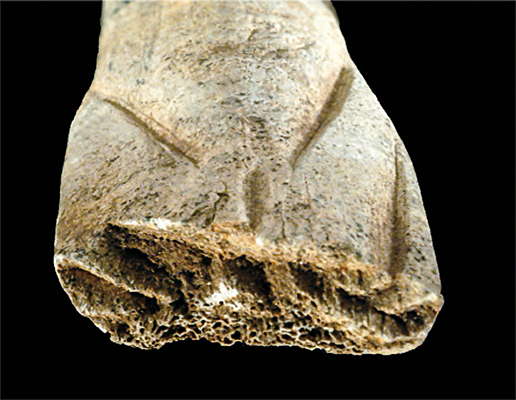
Detail of the pelvis, 30 mm wide.
Photo and text: Duhard (2009-2010)

Another view of the same venus figure.
Label:
Bois de renne sculpté
La Madeleine
Fouilles Capitan et Peyrony
Les Eyzies-de-Tayac, musée national de Préhistoire
MNP 1928-7-16
Photo: Don Hitchcock 2014
Source: Musée d’art et d’archéologie du Périgord, Périgueux

Engraved spear straightener.
Label:
Bàton percé gravé
La Madeleine
Fouilles Capitan et Peyrony
Les Eyzies-de-Tayac, musée national de Préhistoire,
MNP 1928-7-4
Photo: Don Hitchcock 2014
Source: Musée d’art et d’archéologie du Périgord, Périgueux

Engraved spear straightener, with an unidentified animal engraved on the shaft. The spear straightener has had one hole broken out, and another inserted. It was obviously a favourite implement of the hunter who made it.
Photo: Don Hitchcock 2014
Source: Musée d’art et d’archéologie du Périgord, Périgueux

As above, viewed from a higher angle, label:
Bàton percé gravé, la Madeleine, Fouilles Bouvier
Les Eyzies-de-Tayac, musée national de Préhistoire, MNP 1996-9-1-3
Photo: Don Hitchcock 2014
Source: Musée d’art et d’archéologie du Périgord, Périgueux

Engraved spear straightener, as above.
The animal engraved is not part of the standard repertoire of images. With its large eyes, small ears, whiskers and fur/hair at the throat, and a streamlined body, it looks like an aquatic mammal.
As AnnDee points out, it is probably an otter.
Photo: Don Hitchcock 2014
Source: Musée d’art et d’archéologie du Périgord, Périgueux

Otters are members of Mustelidae, the weasel family. They are highly inquisitive predators with voracious appetites and rapid metabolisms. Otters differ from their land-dwelling cousins, weasels and ferrets, in a very important way: they are specially adapted for life in the water. The bodies of otters are generally long and slender, with flattened tails that they use like a rudder to steer through the water. They all have webbed hind feet and most have webbing on the front feet, making them very strong and agile swimmers. For the most part, otters divide their time between the land and the water. They are very opportunistic predators and they will occasionally take prey such as insects and small mammals while on land. However, otters do the bulk of their hunting underwater, coming ashore only to rest, mark their territories, or care for their young.
The water in which otters feed is often very muddy or dark, making hunting by eyesight difficult at best. To cope with these conditions otters have stiff whiskers, called vibrissae, around their faces and on their elbows. The vibrissae help otters feel the vibrations caused by swimming prey, allowing them to track fish, frogs or crustaceans in water that is murky or deep. These waters may also be fairly cold, and (unlike marine mammals like seals and whales) otters do not have a layer of blubber to keep them warm. Instead, otters fluff their fur with their paws to trap air in their thick coats. The trapped air acts as insulation from the cold.
Photo: oceana.org/en/explore/marine-wildlife/european-otter
Text: adapted from http://www.conservenature.org/learn_about_wildlife/otters/otters.htm
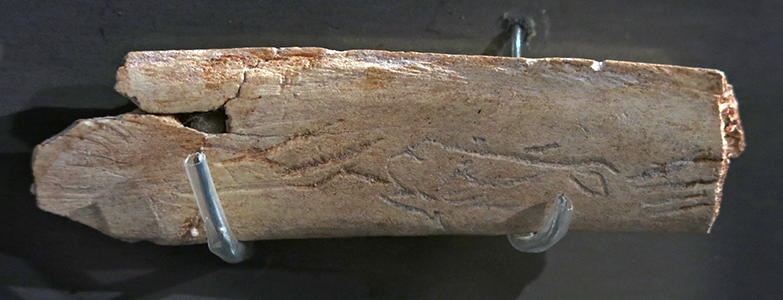
This engraving on a rib bone shows a mammal's head, possibly an ibex, on the right. My thanks for interpretation of this piece to Andrea Castelli.
Length 65 mm, width 15 to 18 mm, thickness 4 mm.
Label:
Côte gravée
La Madeleine
Fouilles Bouvier
Les Eyzies-de-Tayac, Musée national de Préhistoire
MNP 1996-9-1-7
Photo: Don Hitchcock 2014
Source: Musée d’art et d’archéologie du Périgord, Périgueux
Additional text: Crémades (1994)

This carved spear point may represent a fish.
Photo: Don Hitchcock 2014
Source: Musée d’art et d’archéologie du Périgord, Périgueux
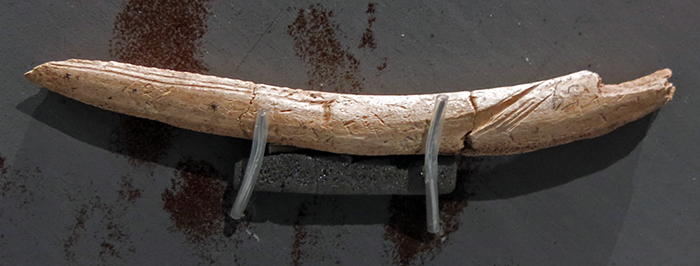
Label:
Pointe de sagaie gravée
La Madeleine, Fouilles Capitan et Peyrony
Les Eyzies-de-Tayac, Musée national de Préhistoire
MNP 1928-7-8
Photo: Don Hitchcock 2014
Source: Musée d’art et d’archéologie du Périgord, Périgueux

This is a curious little piece with no obvious purpose, which looks almost like a tally of events or items. It appears to be mis-labelled, since it is clearly marked as coming from La Madeleine, but the label for it in the cabinet says it comes from Laugerie Basse.
Label:
Baguette gravée, Laugerie-Basse, Fouilles Le Bel et Maury
Les Eyzies-de-Tayac, musée national de Préhistoire, MNP 1992-13-64
Photo: Don Hitchcock 2014
Source: Musée d’art et d’archéologie du Périgord, Périgueux

Spear straightener engraved with horses, side A.

Spear straightener engraved with horses, side B.

Spear straightener engraved with horses, side B.
Label:
Bâton percé gravé, Les Eyzies (La Madeleine?)
Collection Combes (1872?)
Agen, musée des Beaux-arts, 1270
Photo: Don Hitchcock 2014
Source: Musée d’art et d’archéologie du Périgord, Périgueux
Pierced batons - 1, 2, 3 (left and upper) Middle Magdalenian, 4, 5 (right and lower) Upper Magdalenian
Photo: Don Hitchcock 2008
Source: Originals on display at Le Musée National de Préhistoire, Les Eyzies-de-Tayac

Pierced baton - Middle Magdalenian
Note that the baton has been carved with the artistically stylised likenesses of two aurochs or bison, or one of each - but they have the characteristic 'beard' of a bison.
Photo: Don Hitchcock 2014
Source: Original, Le Musée National de Préhistoire, Les Eyzies-de-Tayac
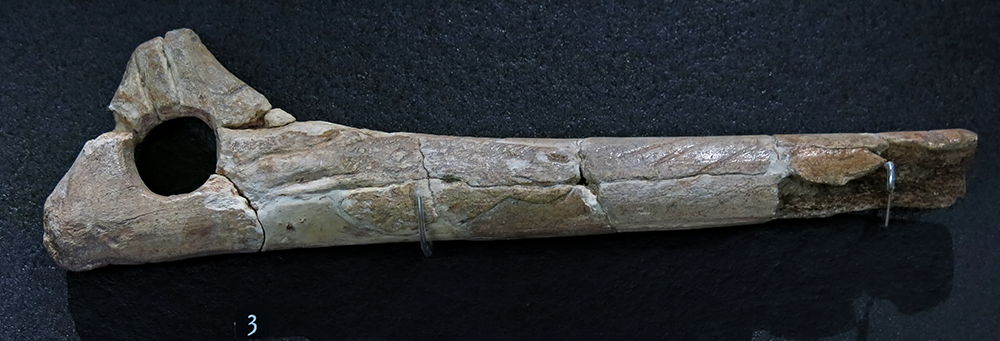
Pierced baton - Upper Magdalenian
This is a superbly decorated piece. The horse head, facing to the right, has been shown with the effect of all over shading, which is accentuated by the smoothing of the reindeer antler outside the outline.
Photo: Don Hitchcock 2014
Source: Original, Le Musée National de Préhistoire, Les Eyzies-de-Tayac

The heads of two horses have been carved into the baton, facing to the left. The jaw is accentuated on the leftmost, larger of the two, and the mouth, nostril, eye, ear, and mane are indicated.
Photo: Don Hitchcock 2014
Source: Original, Le Musée National de Préhistoire, Les Eyzies-de-Tayac
(Bâtons de commandement or bâtons percé or batons perforé or pierced batons are thought by some to have been spear straighteners, (which may be why they are often found broken at the hole). There are many other theories as to their use. However no one seriously thinks they were marks of rank within the community any more.
The spears used are more properly referred to as darts, they were not the strong thrusting spear as used by, say, the Romans, but a long, thin, whippy piece of wood. The ability to bend is an integral part of why they are able to be thrown such long distances. The bend stores up energy which is released in the form of extra speed as it leaves the spear thrower.
An alternative explanation, and one that has been confirmed by experiment, is that the batons can be used as spear throwers or atlatls. You can attach a thong near (but not at) the end of a spear, thread the thong through the hole, lay it along the baton, hold the baton and the thong and the spear (!) in one hand, and by deft handling, send the spear and the attached thong on its way just as with a conventional spear thrower, of which there are of course many examples. I have read of one of these batons showing wear from a leather thong, so it is possible that some were used in that way. You've then got a spear thrower and a spear straightener all in the one tool! - Don )
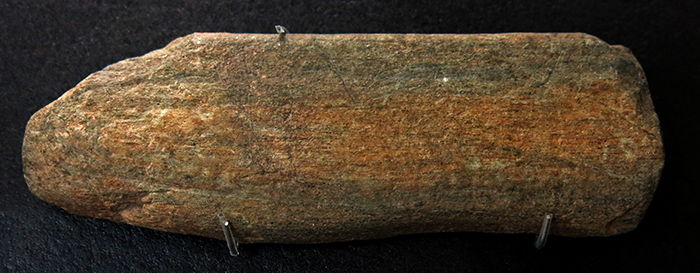
Engraved limestone pebble - Middle Magdalenian
A horse, with muzzle, mouth, eye, jaw, forehead, mane, neck, and part of the chest, has been carved into this limestone pebble.
While a case can be made that art such as this was used as hunting magic on pierced batons, this would seem to be purely for artistic purposes, or perhaps practice.
Photo: Don Hitchcock 2014
Source: Original, Le Musée National de Préhistoire, Les Eyzies-de-Tayac
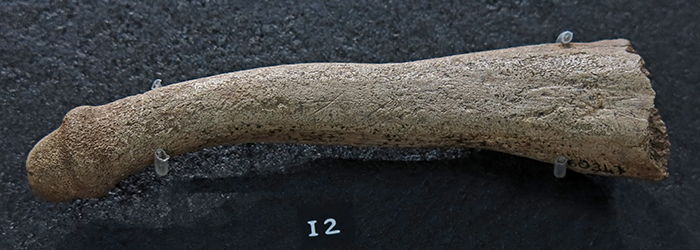
Phallus carved from reindeer antler - Upper Magdalenian, from la Madeleine.
Photo: Don Hitchcock 2014
Source: Original, Le Musée National de Préhistoire, Les Eyzies-de-Tayac

Phallus carved from reindeer antler - Upper Magdalenian, from la Madeleine.
Photo: Don Hitchcock 2008
Source: Original, Le Musée National de Préhistoire, Les Eyzies-de-Tayac
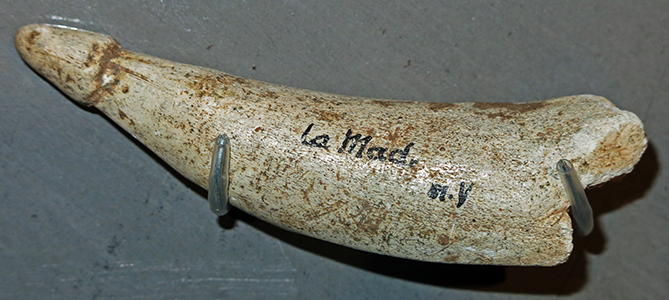
Phallus, as above, fortuitously showing the other side.
Carved in the round of reindeer antler, on loan from Les Eyzies-de-Tayac, musée national de Préhistoire.
la Madeleine
Label:
Bois de renne sculpté en ronde bosse, La Madeleine, Fouilles Capitan et Peyrony
Les Eyzies-de-Tayac, musée national de Préhistoire, MNP 1928-7-15
Photo: Don Hitchcock 2014
Source: Musée d’art et d’archéologie du Périgord, Périgueux
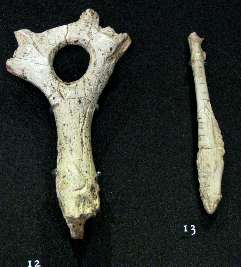
Gauche (12) - Bâton percé - Magdalénien supérieur
Left (12) - Pierced baton - Upper Magdalenian
Droit (13) - Bois de renne sculpté d'une tête de cheval - Magdalénien supérieur
Right (13 - Reindeer antler sculpted into the shape of a horse's head.
Photo: Don Hitchcock 2008
Source: Originals on display at Le Musée National de Préhistoire, Les Eyzies-de-Tayac
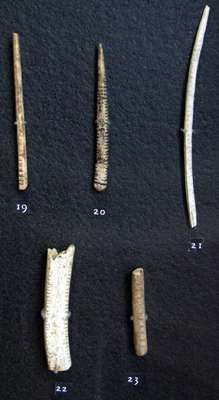
19 La Madeleine - Compresseur - Magdalénien
20 Saint-Germain-la-Rivière - Bâton percé (pierced baton) - Magdalénien
21 Grotte des Eyzies - Fragment de côte (rib) - Magdalénien
22 Pont-d'Ambon - Fragment d'os (fragment of bone) - Azilien
23 Laugerie-Basse Bois de cervidé (deer antler) - Magdalénien
(Note - number 20 seems mislabelled, it seems not to be a Bâton percé, it is much more likely to be a compresseur, used for doing delicate retouch on a flint tool - Don)
Photo: Don Hitchcock 2008
Source: Originals on display at Le Musée National de Préhistoire, Les Eyzies-de-Tayac
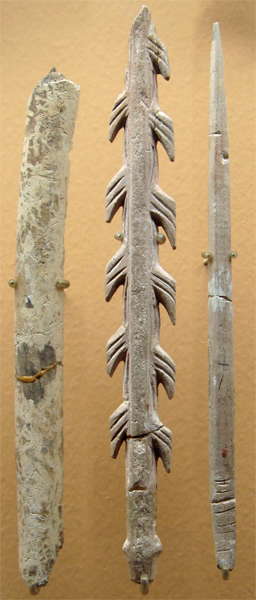
Harpoon and spikes from l'Abri de la Madeleine.
Photo: World Imaging, 2009
Source: Musée d'Archéologie Nationale
Permission: This file is licensed under the Creative Commons Attribution-Share Alike 3.0 Unported license.
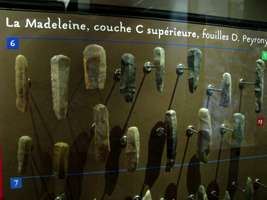
La Madeleine tools.
Denis Peyrony is a giant of the field in this area. He made many important discoveries, and was indefatigable in his endeavours to find and recover for science evidence of the former inhabitants of the Dordogne.
Photo: Don Hitchcock 2008
Source: Originals on display at Le Musée National de Préhistoire, Les Eyzies-de-Tayac
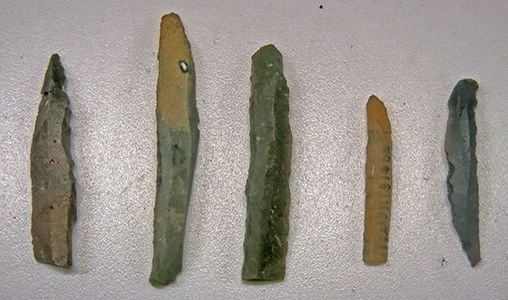
Backed blades from la Madeleine.
Photo: Don Hitchcock 2015
Catalog: 60.529.26 to 60.529.30
Source: Original, Musée d'Aquitaine à Bordeaux
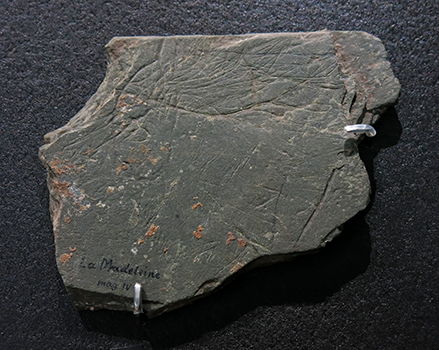
Carved plaque - Upper Magdalenian.
The carvings include what appears to be a horse head, with a large eye, but there are many other lines on this plaque.
Photo: Don Hitchcock 2014
Source: Original, le Musée National de Préhistoire, Les Eyzies-de-Tayac
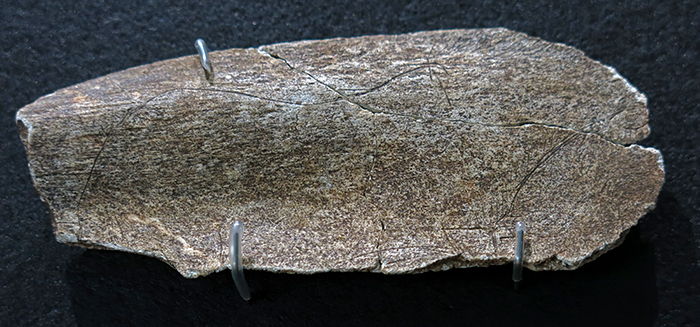
Carved omoplate or shoulderblade - Middle Magdalenian.
The carving shows the body of a horse, including parts of the tail, hindquarters, and forequarters. Also included is the line of the back, the neck, and what may be the muzzle, as well as the mane.
Photo: Don Hitchcock 2014
Source: Original, le Musée National de Préhistoire, Les Eyzies-de-Tayac
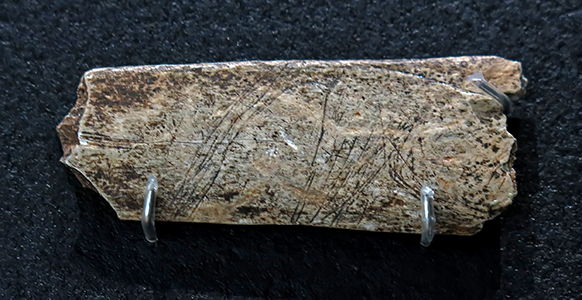
Carved rib - Middle Magdalenian.
The carving shows the hindquarters of a horse, with a long flowing tail, several attempts at a rear leg, as well as the abdomen and the rear part of the back. The forequarters and head are missing.
Photo: Don Hitchcock 2014
Source: Original, le Musée National de Préhistoire, Les Eyzies-de-Tayac

Ciseau, Upper Magdalenian
There is an engraving on the left of the ciseau showing the head of what may be a horse.
(Note - Ciseau translates as chisel, and I have found that they are used for scraping, or at least have marks due to scraping, but I am very unsure of their exact mode of use. They may also have been used to split open pregrooved bones along the line of weakness. Some have marks of percussion on the blunt end, as in a chisel. The ones I have seen have all been decorated, but this might be because decorated tools are more likely to be photographed and displayed - Don)
Photo: Don Hitchcock 2014
Source: Original, le Musée National de Préhistoire, Les Eyzies-de-Tayac
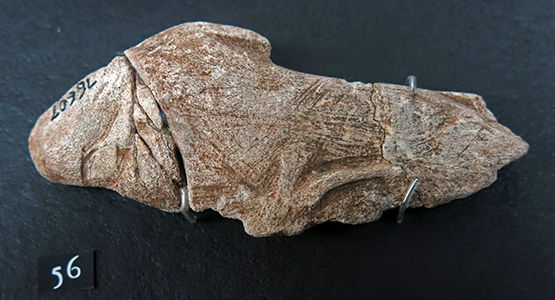
Propulseur - Middle Magdalenian
( this propulseur is enigmatic. It reminds me of a fish shape, but it is difficult to identify the carvings as anything in particular. I would like to have been able to turn it over and examine it more carefully. I fancy I can make out an animal's head lightly engraved into the right hand side of the object , and the dewlap and front leg of a bison in the lower centre of the piece - Don )
Photo: Don Hitchcock 2014
Source: Original, Le Musée National de Préhistoire, Les Eyzies-de-Tayac
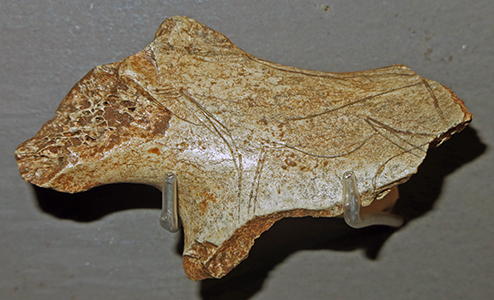
Engraved coxal bone, part of the pelvis of a herbivore, on loan from Les Eyzies-de-Tayac, musée national de Préhistoire. It has been decorated with a carving of what could be a reindeer or horse.
Middle Magdalenian, la Madeleine
Label: Os coxal gravé, Fouilles Capitan et Peyrony
Les Eyzies-de-Tayac, musée national de Préhistoire, MNP 1928-7-21
Photo: Don Hitchcock 2014
Source: Musée d’art et d’archéologie du Périgord, Périgueux

Épois - Magdalénien moyen
Point from the end of a deer's antlers, decorated with what may be the head of a horse - Middle Magdalenian
Photo: Don Hitchcock 2008
Source: Original on display at Le Musée National de Préhistoire, Les Eyzies-de-Tayac
A decorated long bone or Diaphysis - Middle Magdalenian
The diaphysis is the main or midsection (shaft) of a long bone. It is made up of cortical bone and usually contains bone marrow and fat.
This is a curious creature. It bears some resemblance to an otter. Only one rear limb is shown on the engraving.
Photo: Don Hitchcock 2008
Source: Original on display at Le Musée National de Préhistoire, Les Eyzies-de-Tayac
This image of two creatures is remarkably similar to the otter-like one above, but importantly, it is shown wearing neckbands, bracelets and anklets. These creatures may be human, or figures from mythology, or even two images of an animal god of some kind. They may also represent a shaman dressed in shape-shifting clothes and mask.
The creatures are marked with barbs and other symbols, but it is not certain what they represent.
Source: "Exploring the Ice Age" by Margaret Cooper, copyright 2001, isbn 0-689-82556-0
The book says that it comes from a French Pyrenees rock shelter, but no other information is given. It comes from Isturitz, and is of Magdalenian age.
My thanks to Marion for bringing this excellent book to my attention.
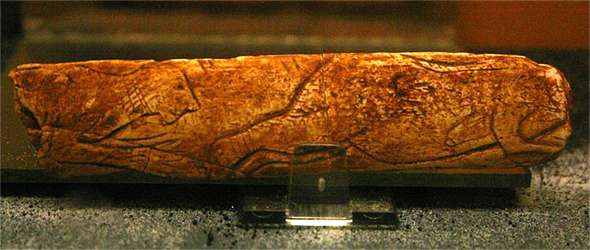
Another photo of the object above, apparently of the original.
Source: http://prehistoart.canalblog.com/
The web page says it comes from Isturitz, it is ten centimetres long, and that on the other side is the image of a bison and the rump of another. The barbed signs are apparently not uncommon in the art of Isturitz, and it assumes that the two figures are of women.

Photo: http://polephylogenie.free.fr/GrotteIsturitz.htm
This is a drawing of the two sides of the bone. It shows clearly the barbs on both sets of images.
According to this site, JA Mauduit describes the object in 40 000 ans d'Art Moderne:
"A man lying naked, adorned with bracelets, reaches for a woman lying before him. The woman is strong and hairy, and on her thigh, an arrow with a triple row of barbs, the symbol of his conquest. The engraving on the other side is not unrelated to the previous one: it is a bison male ready to mate with a female of which there are the hindquarters and tail erect, the male also has on the shoulder of barbed arrows.
Source: Figure taken from the book of Heuvelmans et Porchnev, p. 430.
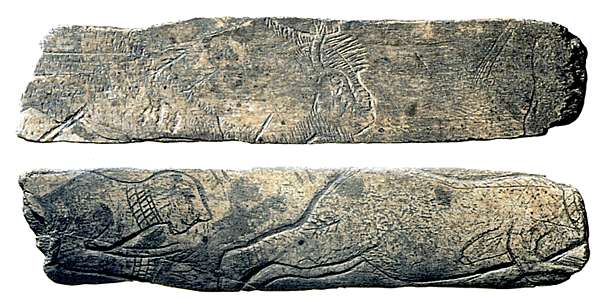
And yet another image, this one showing the reverse side, with the two bison. Note that the breast of the woman in front is lying flat on her chest, as though she is standing up.
Photo: "Journey through the ice age" by Paul G. Bahn, Jean Vertut
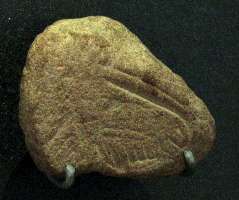
Ronde-Bosse de patte de cheval- Magdalénien moyen
Carving of a horse - Middle Magdalenian
Photo: Don Hitchcock 2008
Source: Original on display at Le Musée National de Préhistoire, Les Eyzies-de-Tayac

Ronde-Bosse de bison- Magdalénien moyen
Carving of a bison - Middle Magdalenian
Photo: Don Hitchcock 2008
Source: Original on display at Le Musée National de Préhistoire, Les Eyzies-de-Tayac
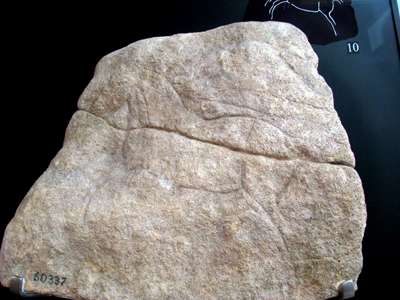
Horse engraved on a stone block, Magdalenian.
Photo: Don Hitchcock 2008
Source: Original on display at Le Musée National de Préhistoire, Les Eyzies-de-Tayac

Broken bone rod from La Madeleine engraved with the head of a bear facing a complex phallic form. Upper Magdalenian.
Photo and text: Marshack (1972)

Baguette demi-ronde- Magdalénien supérieur
This baguette demi-ronde is possibly one half of a projectile point that together with another similar one would form a specific point - a baguette demi-ronde. - Middle Magdalenian.
( The carvings on this piece are surreal - what looks like a bear's head and a double phallus - Don )
Photo: Don Hitchcock 2008, Source: Original on display at Le Musée National de Préhistoire, Les Eyzies-de-Tayac
( As far as I can make out, baguette demi-rondes were fixed to a shaft, (somehow!) and the reason for the half round shape, i.e. round on one side, flat on the other, is that they were tied together around a flint (or bone or ivory I suppose) projectile point, with the flat sides against the point and each other, the round shape towards the outside.
Thus the two round sides made a roughly cylindrical shape, which could then be, say, inserted in a socket in the spear shaft and secured in some way. The end of the spear shaft could also have been whittled down to a tongue shape, flat on both sides, around which the two baguette demi-rondes were placed and secured with cord. If I was doing it, that's what I would try first. The darts weren't really of a large enough diameter to be able to carve a hole to accept the baguette demi-ronde. Harpoon shafts, however, were used more as thrusting spears as far as I can work out, so they could be of a much larger diameter, into which you could carve a socket.
Birch bark glue may have been used, and the glue would also have been used to strengthen the cords holding the two halves together. Birch bark glue is a very difficult glue to make, but the technique was well understood at that time.
The advantage is that if the flint is broken by impact with the ground or a bone, you can simply insert another flint head, attach it with cord or a leather thong, and you are ready to hunt again. You then only have to carry a few spear shafts and many light and easily packed flints when you go on a hunt, apart from the other things you need.
The spears used are more properly referred to as darts, they were not the strong thrusting spear as used by, say, the Romans, but a long, thin, whippy piece of wood. The ability to bend is an integral part of why they are able to be thrown such long distances. The bend stores up energy which is released in the form of extra speed as it leaves the spear thrower, and the spear straightens.
I emphasise that this is all conjecture on my part, I have been unable to get anything more than very unsatisfactory allusions to the technique.
However the idea of a fore-shaft is one that was used in a number of cases, and especially for harpoon heads. Methods were needed to attach bone or ivory harpoon heads to the shaft of the harpoon, and I've heard of sockets being used in that instance.
In the abstract of Pearson (1999) you will find this, in reference to north american hunting methods:
Based on the compiled information, a new hafting method for Clovis points is put forth that links the attributes of bi-beveled rods to a specific role within this system. This new hypothesis suggests that bi-beveled rods were tied facing each other around a Clovis point and a main shaft as part of composite clothes pin-like foreshafts.
- Don )

7, 8, 9 - Baguettes demi-ronde, with another small carved baguette below them.
10, 11 - Bâton percés.
From La Madeleine. Note that the Bâton percé at number 10 is a small, delicate example, as though it was made to straighten lighter, thinner diameter darts.
Photo: Don Hitchcock 2008
Source: Originals on display at Le Musée National de Préhistoire, Les Eyzies-de-Tayac

Base de perche débitée- Magdalénien supérieur
Carved bone - Upper Magdalenian
Photo: Don Hitchcock 2008
Source: Original on display at Le Musée National de Préhistoire, Les Eyzies-de-Tayac

Magdalenian two sided harpoon with five barbs, from l'abri de La Madeleine, in reindeer antler.
Dimensions: 147 mm long, 28 mm wide, 12 mm thick.
( This is possibly the most (justifiably) well known harpoon in the lexicon. It is not only useful, it is beautifully made, and a work of art. It was fashioned by an artisan at the peak of their abilities. Note in particular the 'knobs' on either side of the lower part of the spear head allowing the harpoon to be easily and firmly attached to a spear shaft using sinew and birch bark glue - Don )
Catalog: MAN20062
Photo: Don Hitchcock 2015
Source: Original, Musée d'Archeologie Nationale et Domaine, St-Germain-en-Laye
Text: https://www.photo.rmn.fr
Magdalenian artefacts from other sites besides la Madeleine
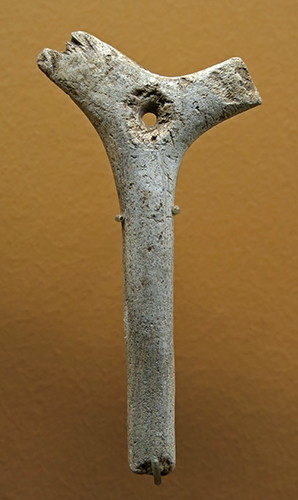
Magdalenian pierced baton from Laugerie Basse, in reindeer antler.
Catalog: MAN54052
Photo: Don Hitchcock 2015
Source: Original, Musée d'Archeologie Nationale et Domaine, St-Germain-en-Laye
Text: https://www.photo.rmn.fr
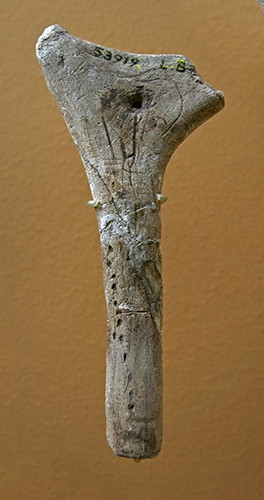
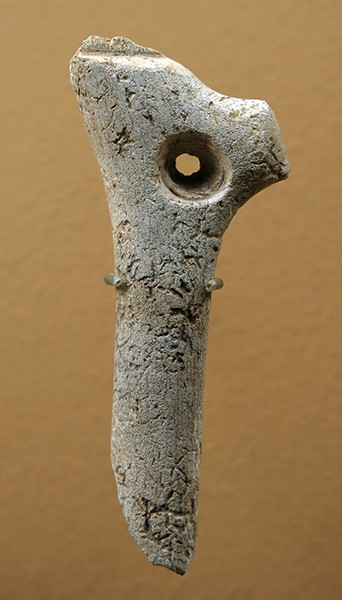
(left): Magdalenian reindeer antler from Laugerie Bassewith the beginnings of a perforation to make it into a bâton percé.
Dimensions: length 132 mm, width 58 mm, thickness 11 mm.
Catalog: MAN53919
(right): Magdalenian bâton percé of reindeer antler from Laugerie Basse.
Dimensions: length 89 mm, width 32 mm, thickness 14 mm.
Catalog: MAN54054A
Photo: Don Hitchcock 2015
Source: Original, Musée d'Archeologie Nationale et Domaine, St-Germain-en-Laye
Text: https://www.photo.rmn.fr
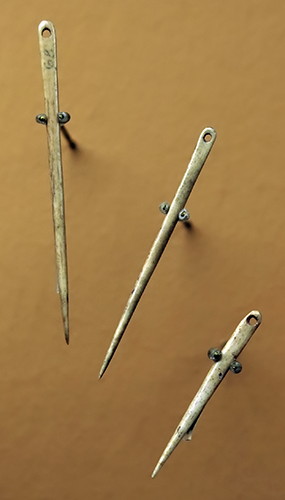
Magdalenian bone eyed needles from la grotte de la Vache.
(left): Dimensions: length 55 mm, width 3 mm, thickness 2 mm.
Catalog: MAN83640R71
(centre): Dimensions: length 46 mm, width 3 mm, thickness 2 mm.
Catalog: MAN83062.3
(right): Dimensions: length 31 mm, width 3 mm, thickness 2 mm.
Catalog: MAN83643CLXXR3
Photo: Don Hitchcock 2015
Source: Original, Musée d'Archeologie Nationale et Domaine, St-Germain-en-Laye
Text: https://www.photo.rmn.fr
Making a needle
First, two long grooves were made in a suitable long bone using a burin, with two short grooves at either end, completing a long thin rectangle.
This was then split using a wedge or ciseau, to break open the grooves made in the hollow bone, and the rectangle was carefully levered out. This is why reindeer antler was rarely used for this purpose, since it was easier to make it from bone, which is hollow, and takes a very sharp point.
The eye was then put into the rectangular piece of bone at this point, while there was still plenty of 'meat' around the hole being made, and the needle was then carefully sanded and polished into shape.
Photo: Don Hitchcock 2014
Source: poster, artist unknown, Musée d'Archeologie Nationale et Domaine, St-Germain-en-Laye
Text: Don Hitchcock

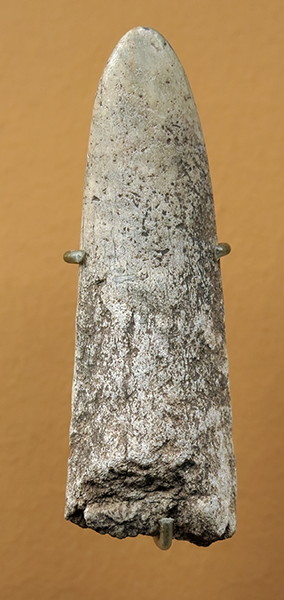
(left): Magdalenian bone lissoir, used for leather processing, from l'abri de Laugerie-Basse.
Dimensions: length 120 mm, width 21 mm, thickness 5 mm.
Catalog: MAN54215
(right): Magdalenian reindeer antler lissoir, used for leather processing, from l'abri de Laugerie-Basse.
Dimensions: length 80 mm, width 27 mm, thickness 13 mm.
Catalog: MAN54247E
Photo: Don Hitchcock 2015
Source: Original, Musée d'Archeologie Nationale et Domaine, St-Germain-en-Laye
Text: https://www.photo.rmn.fr

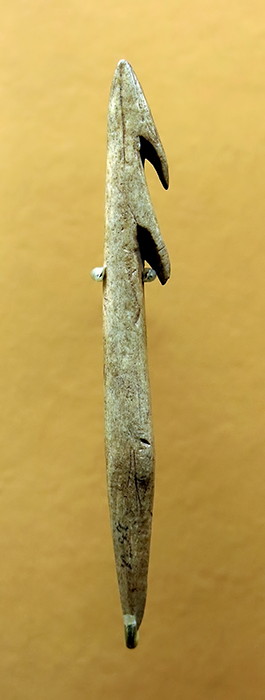

(left): Magdalenian harpoon with one barb, from la grotte de La Vache, in reindeer antler.
Dimensions: 89 mm long, 8 mm wide, 6 mm thick.
Catalog: MAN83643
(centre): Magdalenian harpoon with two barbs on one side, from la grotte de La Vache, in reindeer antler.
Dimensions: 86 mm long, 10 mm wide, 6 mm thick.
Catalog: MAN83062.46
(right): Magdalenian harpoon with three barbs on one side, from la grotte de La Vache, in reindeer antler.
Dimensions: 110 mm long, 12 mm wide, 7 mm thick.
Catalog: MAN83641.VIC54
Photo: Don Hitchcock 2015
Source: Original, Musée d'Archeologie Nationale et Domaine, St-Germain-en-Laye
Text: https://www.photo.rmn.fr


(left): Magdalenian one sided harpoon originally with four barbs, of which three remain, from la grotte de La Vache, in reindeer antler.
Dimensions according to the catalog: 139 mm long, 140 mm wide, 70 mm thick.
( Likely actual dimensions: 139 mm long, 14 mm wide, 7 mm thick - Don )
Catalog: MAN83642CXLIII C 62
(right): Magdalenian one sided harpoon with six barbs, though there may originally have been more, from la grotte d'Isturitz, in reindeer antler.
Dimensions: 173 mm long, 13 mm wide, 8 mm thick.
( Of particular interest in this piece is that the barbs are not exaggeratedly wide like most such harpoons. This would have allowed much less force to have been used to get good penetration of the prey, although it would have been less secure - Don )
Catalog: MAN75295.I
Photo: Don Hitchcock 2015, 2018
Source: Original, Musée d'Archeologie Nationale et Domaine, St-Germain-en-Laye
Text: https://www.photo.rmn.fr

Magdalenian two sided harpoon with ten barbs, from la grotte de La Vache.
Dimensions: length 105 mm, width 14 mm, thickness 9 mm.
Catalog: MAN83640.C.40
Photo: Don Hitchcock 2015
Source: Original, Musée d'Archeologie Nationale et Domaine, St-Germain-en-Laye
Text: https://www.photo.rmn.fr
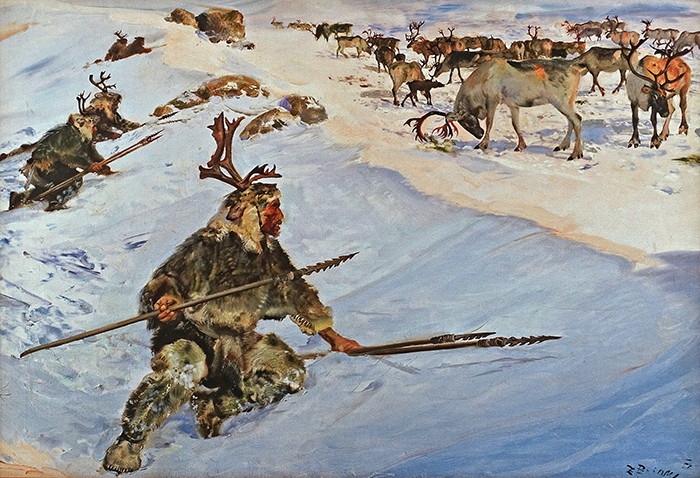
A winter hunting scene in Magdalenian times. Note that spears with harpoon heads are shown, but no spear throwers form part of the kit in this recreation by the talented artist Zdeněk Burian, 1905 - 1981.
Painting: Zdeněk Burian
Rephotography: Don Hitchcock 2018
Source and text: Anthropos Pavilion/Moravian Museum, Brno, Czech Republic
Additional text: Don Hitchcock
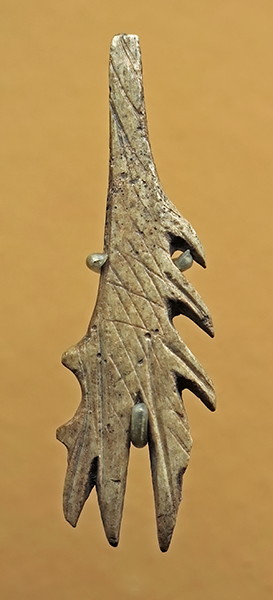
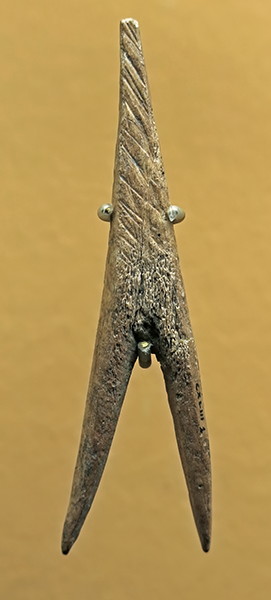
(left): Magdalenian foëne or fish spear from la grotte de La Vache.
Dimensions: length 61 mm, width 19 mm, thickness 5 mm.
Catalog: MAN83641CLXC61
(right): Magdalenian foëne or fish spear from la grotte de La Vache.
Dimensions: length 71 mm, width 21 mm, thickness 8 mm.
Catalog: MAN83640.CXLIIIC43
These are points of reindeer antler which were attached to a long shaft, used for catching flatfish, particularly while wading in shallow waters. Its handle could be equipped with a cord, enabling the spear to be retrieved when thrown at a fish. In particular, foëne were often used for eel fishing, the extra points making it possible to catch these fish, which are slippery and difficult to catch otherwise.
It is speculated that they may have been used to take down birds as well.
Photo: Don Hitchcock 2015
Source: Original, Musée d'Archeologie Nationale et Domaine, St-Germain-en-Laye
Text: https://www.photo.rmn.fr
Additional text: Wikipedia


(left): Magdalenian spear point with a simple pointed base, from la grotte du Placard.
Dimensions: length 118 mm, width 13 mm, thickness 8 mm.
Catalog: MAN55021
(right): Magdalenian spear point with a simple pointed base, from la grotte d'Isturitz.
Dimensions: length 71 mm, width 7 mm, thickness 5 mm.
Catalog: MAN83886
Photo: Don Hitchcock 2015, 2018
Source: Original, Musée d'Archeologie Nationale et Domaine, St-Germain-en-Laye
Text: https://www.photo.rmn.fr
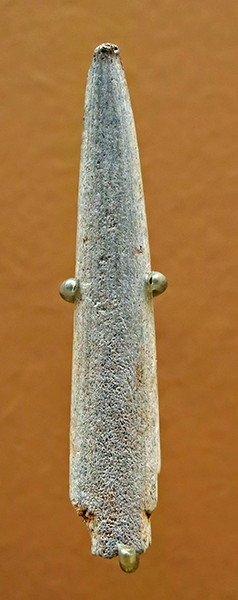

(left): Magdalenian spear point with a trimmed base, from la grotte du Placard .
Dimensions: length 60 mm, width 11 mm, thickness 7 mm.
Catalog: MAN55072g
(right): Magdalenian spear point with a trimmed base, from la grotte de La Vache.
Dimensions: length 96 mm, width 8 mm, thickness 7 mm.
Catalog: MAN83642
Photo: Don Hitchcock 2015, 2018
Source: Original, Musée d'Archeologie Nationale et Domaine, St-Germain-en-Laye
Text: https://www.photo.rmn.fr
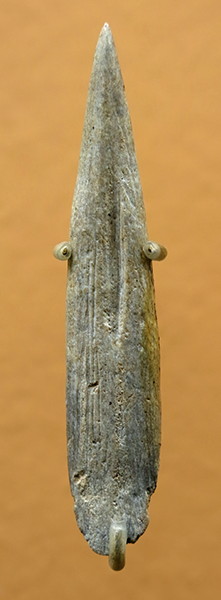
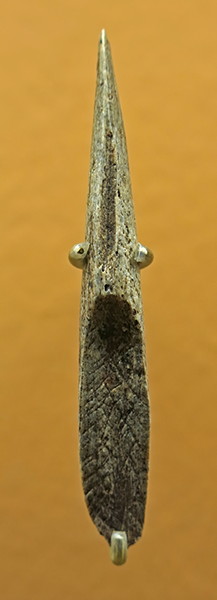

(left): Magdalenian spear point in reindeer antler, of the Lussac-Angles type, from la grotte d'Isturitz.
Dimensions: length 62 mm, width 11 mm, thickness 8 mm.
Catalog: MAN83886
(centre): Magdalenian spear point in reindeer antler, of the Lussac-Angles type, from la grotte d'Isturitz.
( note the single bevel on this point, scored with crosshatching to give purchase for the birchbark glue used to attach the spear point to the shaft of the spear - Don )
Dimensions: length ? mm, width 9 mm, thickness 8 mm.
Catalog: MAN83886
(right): Magdalenian spear point with a single bevel in reindeer antler from la grotte d'Isturitz.
Dimensions: length 114 mm, width 12 mm, thickness 11 mm.
Catalog: MAN83886
( note that the catalog numbers are all the same for these items - Don )
Photo: Don Hitchcock 2015
Source: Original, Musée d'Archeologie Nationale et Domaine, St-Germain-en-Laye
Text: https://www.photo.rmn.fr

Magdalenian spear point with a single bevel in reindeer antler from l'abri de Laugerie-Basse.
Dimensions: length 94 mm, width 9 mm, thickness 8 mm.
Catalog: MAN54226K
Photo: Don Hitchcock 2015
Source: Original, Musée d'Archeologie Nationale et Domaine, St-Germain-en-Laye
Text: https://www.photo.rmn.fr

Magdalenian spear point with a single bevel in reindeer antler from la grotte du Placard.
Dimensions: length 129 mm, width 13 mm, thickness 7 mm.
Catalog: MAN55020a
Photo: Don Hitchcock 2015
Source: Original, Musée d'Archeologie Nationale et Domaine, St-Germain-en-Laye
Text: https://www.photo.rmn.fr


(left) Magdalenian spear point with a double bevel in reindeer antler from la grotte de La Vache.
Dimensions: length ? mm, width 9 mm, thickness 7 mm.
Catalog: MAN83642.XLID114
(right) Magdalenian spear point with a double bevel in reindeer antler from la grotte de La Vache.
Dimensions: length 76 mm, width 8 mm, thickness 6 mm.
Catalog: MAN83643.XXXVID124
Photo: Don Hitchcock 2015
Source: Original, Musée d'Archeologie Nationale et Domaine, St-Germain-en-Laye
Text: https://www.photo.rmn.fr
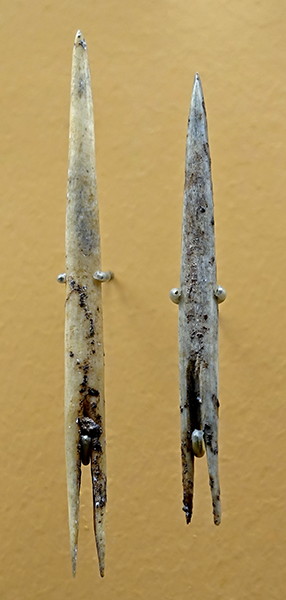
(left) Magdalenian spear point with a forked base in reindeer antler from la grotte d'Isturitz.
Dimensions: length 108 mm, width 8 mm, thickness 7 mm.
Catalog: MAN86495
(right) Magdalenian spear point with a forked base in reindeer antler from la grotte d'Isturitz.
Dimensions: length 87 mm, width 8 mm, thickness 6 mm.
Catalog: MAN77163G(?)45
Photo: Don Hitchcock 2018
Source: Original, Musée d'Archeologie Nationale et Domaine, St-Germain-en-Laye
Text: https://www.photo.rmn.fr

Magdalenian baguette demi-ronde in reindeer antler from la grotte d'Isturitz.
Dimensions: length 147 mm, width 13 mm, thickness 6 mm.
Catalog: MAN77159B6
( Baguettes demi-ronde were used in pairs as part of a spear point, with a flint point clamped at the ends between the two half round pieces of reindeer antler, secured with sinew and black birch bark glue. They were often highly decorated - Don )
Photo: Don Hitchcock 2015
Source: Original, Musée d'Archeologie Nationale et Domaine, St-Germain-en-Laye
Text: https://www.photo.rmn.fr
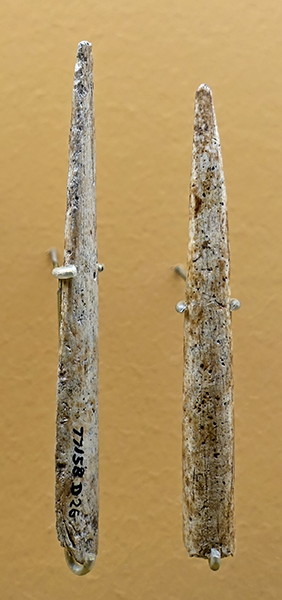
(left): Magdalenian baguette demi-ronde in reindeer antler from la grotte d'Isturitz.
No dimensions given in the catalog.
Catalog: MAN77185D26 ( note that the catalog number written on the item is 77158D26 - Don )
(right): Magdalenian baguette demi-ronde in reindeer antler from la grotte d'Isturitz.
Dimensions: length 95 mm, width 11 mm, thickness 5 mm.
Catalog: MAN83885
Photo: Don Hitchcock 2018
Source: Original, Musée d'Archeologie Nationale et Domaine, St-Germain-en-Laye
Text: https://www.photo.rmn.fr
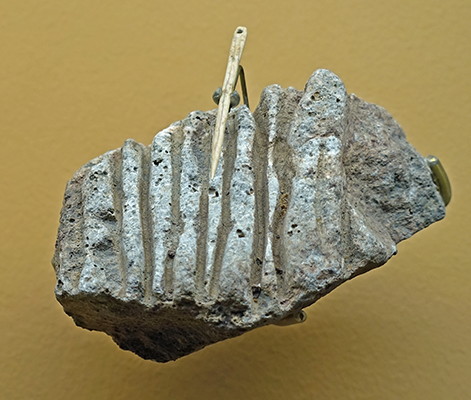
Magdalenian needle polisher from la grotte d'Isturitz.
Dimensions: length 97 mm, width 59 mm, thickness 42 mm.
Catalog: MAN77155E1
Photo: Don Hitchcock 2018
Source: Original, Musée d'Archeologie Nationale et Domaine, St-Germain-en-Laye
Text: https://www.photo.rmn.fr
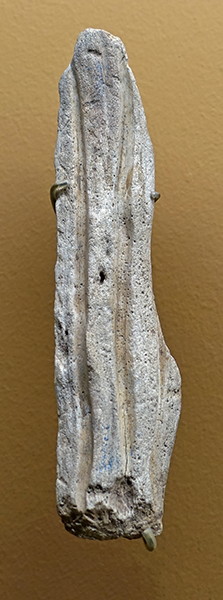
Magdalenian grooved reindeer antler from la grotte d'Isturitz.
Dimensions: length 161 mm, width 39 mm
Catalog: MAN83886 (sic)
Photo: Don Hitchcock 2018
Source: Original, Musée d'Archeologie Nationale et Domaine, St-Germain-en-Laye
Text: https://www.photo.rmn.fr

Magdalenian spear point with a single bevel from la grotte d'Isturitz.
Dimensions: length 109 mm, width 9 mm thickness 9 mm.
Catalog: MAN83886 (sic)
Photo: Don Hitchcock 2015
Source: Original, Musée d'Archeologie Nationale et Domaine, St-Germain-en-Laye
Text: https://www.photo.rmn.fr
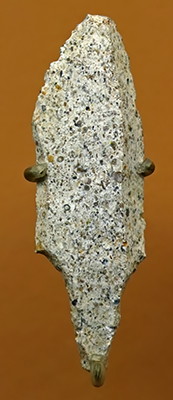
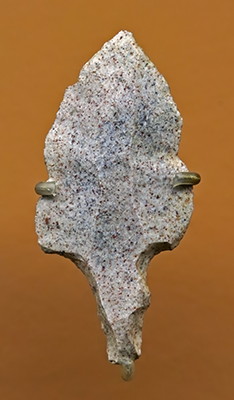
Tanged Magdalenian Teyjat points.
( named after the flint tools found at the Grotte de la Mairie à Teyjat in the north of the Dordogne, notable for its beautiful engravings of Aurochs - Don )
(left): Magdalenian point in flint from la grotte de la Mairie.
Dimensions: 54 mm long, 16 mm wide, 5 mm thick. Catalog MAN52475
(right): Magdalenian point in flint from lla grotte de la Mairie.
Dimensions: 52 mm long, 25 mm wide, 5 mm thick. Catalog MAN52475
( note that these two items have the same catalog number - Don )
Photo: Don Hitchcock 2015
Source: Original, Musée d'Archeologie Nationale et Domaine, St-Germain-en-Laye
Text: https://www.photo.rmn.fr
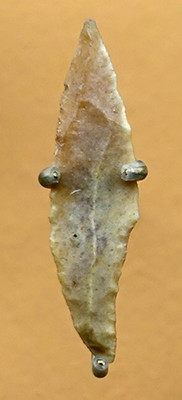
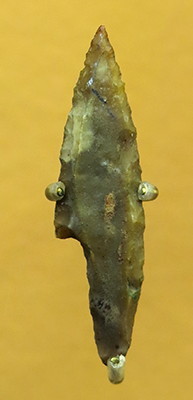
Magdalenian shouldered points, pointes à cran.
(left): Pointe à cran from the grotte de Noailles
Dimensions: length 42 mm, width 11 mm, thickness 2 mm.
Catalog MAN50721
(right): Pointe à cran from the abri de La Garenne.
Dimensions: length 42 mm, width 11 mm, thickness 3 mm.
Catalog MAN46690
Photo: Don Hitchcock 2018, 2015
Source: Original, Musée d'Archeologie Nationale et Domaine, St-Germain-en-Laye

Magdalenian points of the 'Laugerie Basse' type.
Photo: Don Hitchcock 2018
Source: Unknown provenance, original, Musée d'Archeologie Nationale et Domaine, St-Germain-en-Laye
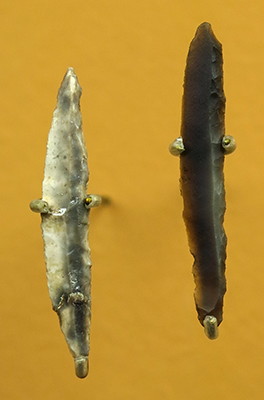
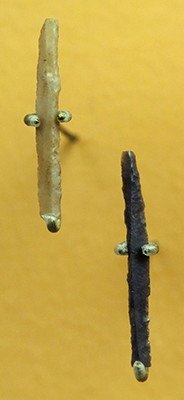
Magdalenian backed blades.
Photo: Don Hitchcock 2015
Source: Unknown provenance, original, Musée d'Archeologie Nationale et Domaine, St-Germain-en-Laye
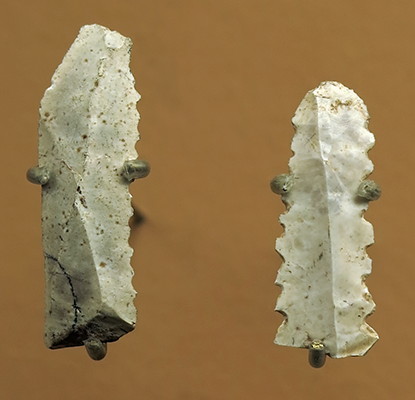
Magdalenian denticulate blades.
Photo: Don Hitchcock 2015
Source: Unknown provenance, original, Musée d'Archeologie Nationale et Domaine, St-Germain-en-Laye
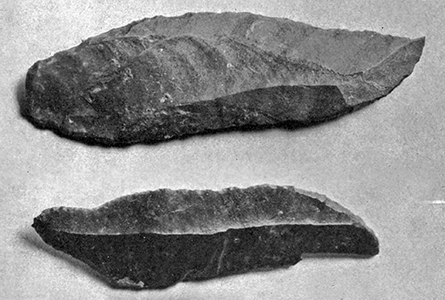
Parrot Beak Burins (bec de perroquet) from La Madeleine.
Photo and text: Collie (1928)
Skulls and Bones
C. PLATE IX & X.
(Double.)
[All the figures, drawn on the stone from the originals, are reversed in the plate.
They were sketched in geometric projection by aid of Gavard's diagraph, and reduced to half-size by Sauvage's pantograph.]
_________
Fig. 1a. La Madelaine.
Frontal, front view.
1 b. Internal cast of the same.
_________
Fig. 2. Cro Magnon.
Half of the Upper Jaw of "No. 4" from Cro-Magnon, with the second premolar and the first two molars still in place and much worn.
_________
Fig. 3. La Madelaine.
Portion of the lower jaw of the Man of La Madelaine.
_________
Fig. 4. Cro Magnon.
Fragment of the Lower Jaw of "No. 4" from Cro-Magnon, bearing two molars much worn.
_________
Fig. 5. Cro Magnon.
First lumbar Vertebra of the "Old Man" of Cro Magnon, showing the separation of the diapophysis into a metapophysis and parapophysis.
_________
Fig. 6a. Cro Magnon.
The Pelvis of "No. 1" from Cro Magnon, reconstructed by M. Hamy :
represented as seen from above, and so that the plane of the upper narrowing is horizontal.
6b. The same, seen from behind, for the particular study of the sacrum.
_________
Fig. 7. Cro Magnon.
Shaft and upper extremity of a left radius from Cro Magnon, view of the anterior surface.
_________
Fig. 8. Cro Magnon.
Shaft and lower extremity of another radius from the same place, view of the posterior surface, to show the depth of the grooves.
_________
Fig. 9. Cro Magnon.
Left ulna of one of the subjects from Cro Magnon, profile, to exhibit the incurvation of the upper extremity.
_________
Fig. 10a. La Madelaine.
Right Femur of the Man of La Madelaine, anterior surface.
10b. Profile of the same, to show its antero-posterior curve and the flattening of the upper fourth of its outer edge.
10c. Section of this Femur at its narrowest point, showing the projection of the linea aspera in the form of a small column.
_________
Fig. 11 a. La Madelaine.
Right tibia of the same subject, represented in profile, to give an idea
of the amount of its transverse flattening.
11 b. Section of the same bone at the level of the foramen nutritium, showing the lozenge-shape resulting from platycnemism.
_________
Fig. 12. Laugerie Basse
Right fibula of the Man of Laugerie Basse "No. 4" with the deep groove in its outer surface.
_________
Fig. 13a, 13b, 13c. Laugerie Basse
The left first Metatarsal of the same, views of the dorsal and plantar surfaces and profile, to show the extent of its metatarso-phalangial surface of articulation.
_________
Fig. 14. Cro Magnon
Astragalus of the "Old Man" of Cro-Magnon, seen from above.
_________
Fig. 15. Cro Magnon
Cuboid from the same subject, in the same position.
Source and text: Lartet and Christy (1875)
Proximal source: archive.org

Photo: Don Hitchcock 2008

Photo: Don Hitchcock 2008

Here may be found a pdf of the original monograph by Capitan and Peyrony
Below are many figures and text from this important work.
Translation: Don Hitchcock
Photo: Capitan et Peyrony (1928)
Plate 1
In 1913, the distance from the cliff to the edge of the Vézère was about thirty metres, and the hills were bare. Now the river is just 2.5 metres from the cliff, and trees have reclaimed the land.
( It may be that goats which kept the vegetation in check were removed from the area - Don )
The text that accompanies the photo in Capitan et Peyrony (1928) reads:
General view of the rocks of La Madeleine with the ruins of the old castle. On the left, behind the trees, the famous shelter before the excavations.
Photo: Belvès
Source: Capitan et Peyrony (1928)
Additional text: sign at La Ferme Paysanne
Introduction
When, following the uneven and picturesque road which goes from Les Eyzies to Le Moustier, and descends from the heights to which the castle of Marzac clings, one suddenly sees in front of one, at the bottom of the escarpments which overhang the winding Vézère, a vast clearing opening, bordered in the background by the wooded heights that frame its bed, laterally by the sheer drops that dominate the river, and closed below by the lapping of the reddish waters of the Vézère encircling the whole with a wide aqueous loop.
It is there, in the background, that in the middle of large steep and overhanging cliffs, opens the vast shelter which was La Madeleine and where lived, for several millennia, a dense population of skilful hunters, hardy fishermen, and incomparable artists, living at a time of dry cold. They were buried in the middle of the woods, well sheltered from the wind, exposed to the least rays of sun, surrounded by abundant fauna, protected by their topographical situation, rock walls on the one hand, the bed of the Vézère on the other, and simple paths easy to locate and to defend in the woods constituting the only means of access to the small stronghold.
On the opposite bank of the stream, a kind of embankment, levelled and made bare by the floods, quite wide, formed a point where, in fine weather, huts could be erected or a place where animals could be hunted, and people could form a village annexed to the true centre: the enormous shelter of the Madeleine, whose formidable sloping vault covered a wide space under which an important tribe could reside thus completely protected (see Figure 2).
Figure 2: View of l'abri de la Madeleine during the course of the excavations.
Photo and text: Capitan et Peyrony (1928)
Such is the framework that the prehistorian geographer sees rising before him. He furnishes it easily with its ancient inhabitants of the Magdalenian period. In the woods, it is the rustle of the beasts that roam them: reindeer fleeing, bison sent hurtling down the cliff face, saiga antelopes fleeing along the river and, in the background, the noise of the mammoth moving away with slow steps in cracking the branches, while a band of horses spring up in alarm and escape deep into the woods.
Over there, in the background, along the edge of the water, there is a swarm of people around and in front of the shelter. The men return from the hunt and bring back their game, while, descending the Vézère on their rafts, the fishermen return to their homes.
All around the enormous home, well protected from the weather and closed off by enormous tree trunks covered with moss, the women come and go, here preparing the supper for the newcomers, there sewing skins to make clothing, here again trading finely made flint blades, while, under the direction of an old artist, young people practice carving bone, horn, and ivory.
And all this lives, stirs and gives its support to the common task which, from the depths of the shelter, is directed by the great chief, an experienced old man and retired sorcerer...
Yes, all this and many other details are seen by prehistorians who understand human geography. ... even that of prehistoric times...
This is at least the modern way in which they very succinctly think they can present this enormous collection of lovingly collected prehistoric things, and how they consider that they can be interpreted when, full of life, they served man and were even a part of his existence...
But now we must abandon this evocation of a former life, descend towards the Vézère, cross it, and follow the small path along the projecting rock above which the medieval ruins of the old castle of La Madeleine stand to finally reach the shelter itself.
Map of the Eyzies region where the names of the main prehistoric stations have been underlined: La Madeleine, Les Eyzies, Les Combarelles, Grotte de Font de Gaume.
Photo: Capitan et Peyrony (1928)
Description of the site
Arriving almost opposite the village of Tursac (Dordogne), the Vézère, coming from le Moustier, describes a large loop, passing under the chateau of Marzac, then seems to retrace its steps by another path to the ruins of the chateau La Madeleine built on the isthmus that is formed at this point, leaving the hamlet of Petit Marzac on the right. After almost bumping into the cliff, it heads west, skirting it at an average distance of thirty metres.
These large rocks form an almost uninterrupted line, of about 500 metres, extending from Petit Marzac to the valley of Combe-Guillère.
To the east, halfway up, you can see a terrace on which open several beautiful shelters that you would take from afar for cave entrances. We explored them carefully; we only found there, as well as on the terrace, the remains of old buildings, dating at most from the Middle Ages. Although they were occupied in prehistoric times, there is currently little trace of them; they have since been emptied and the detritus emptied into the valley below, from which it has been carried away by the floods of the Vézère.
At the western end of the platform, there is still a small chapel, fairly well preserved, from the end of the 15th century; it was a part of the castle, the ruins of which stand directly above, on the sheer rock.
At the base of the cliff, there is a series of more or less deep shelters. Those to the east, with low vaults and terraces, are invaded by the waters at the smallest flood; those in the middle and west once formed, and some still form, large, high overhangs; floods invade them only very rarely. They are the ones our prehistoric ancestors chose for their habitat.
They face south, near an abundant spring flowing from the valley of Combe Guillère. The archaeological deposits seem to extend, with some breaks in continuity, over a length of four hundred metres; but they are sometimes covered with enormous scree resulting from the collapse of the vault of the shelters.
At the western end, people of the Middle Ages took advantage of a natural fault in the rock to dig, in an inaccessible place, rooms whose entrance can be seen, but which can only be reached with the help of ropes. Below, at the foot of the great rocky wall, there must have been a few miserable huts, as the holes intended to receive roof timbers still testify.
Except in front of the famous shelter where a natural meadow extends (see Plate I), everywhere else, the strip of land situated between the rocks and the river is covered with luxuriant vegetation. Everything grows there in the wild: oaks, ashes, hornbeams, elms, hazelnuts, boxwood, bushes, linked together by brambles and clematis, sheltered from the cold winds, warmed by the rays of the sun, moistened by mists; in places it is a tangled mess.
The tiniest crevices and the smallest rocky places retaining earth and dust are lined with boxwood and grasses of all kinds, giving a pleasing impression to the eye. It is a wild and marvellous site where one can enjoy, at ease, the charms of nature.

Front view of the La Madeleine shelter. In the foreground, the Vézère. The excavated material forms a white band at the foot of the cliff.
Photo and text: Capitan et Peyrony (1928)
Excavation history
The exploration of the large shelter, located at the bottom of the meadow, was begun in 1863 by Lartet and Christy. At this point, the archaeological layers were almost on the surface; thus, the first works were easily done.
Later, occasional diggers extended, to the east, the Lartet trench. Then came Dr. Paul Girod, Massénat and Emile Rivière, who did their research on the west side. Finally, in October 1910 , we began ours on behalf of the State; they continued, with interruptions, until October 20, 1913.
The first were made with the kind authorisation of the owners Mr. and Mrs. La Borderie, and ours with that of Mrs. Veuve La Borderie, née Limoges.
Identification of excavations
When we arrived on the site for the first time, the rubble from the old works covered the entire floor of the shelter. Brambles and bushes had invaded part of it and were encroaching heavily on the meadow in front. It was impossible, at first sight, to recognise the points that had remained unexcavated; everything seemed to have been turned upside down. It was therefore without much enthusiasm that we undertook our research.
Some scrapings, made in the cuttings, had given us numerous and fairly good flint pieces and some bone fragments.
By re-excavating these materials, we might have the chance to take advantage of the inexperience of the early searchers and find the interesting objects that may have escaped their attention; we then decided to do this work and completely empty the shelter. This allowed us to locate the old excavations, to find the unexplored parts and to reconstruct the shelter at the beginning of its habitation.
Lartet and Christy had reached the base of the archaeological layers everywhere, except at the bottom of a basin near limestone block B of the plan (fig. 3). Thanks to an article published in the Archaeological Revue of 1864, we have been permitted to limit their work in a precise manner. Starting from the east side, from the letter L engraved on the wall of the shelter, they extended to the bottom of the latter over a length of 15 metres and a width of 7 metres on average.
Those of Dr. Paul Girod, Elie Massénat and Emile Rivière had been made one after the other, on the west side, about 16 metres long and 7 metres wide. All layers had been removed over 5 metres long and 4 metres wide; then, everywhere else, the superior alone had been followed, and the two inferiors were intact.
They had dug a few trenches here and there around the large limestone blocks scattered in front, but had not touched them.
To the east, occasional diggers had arrived at 250 cm beyond the letter L, but without reaching the base of the deposit. All the other parts were pretty much pristine, or at least disturbed only in places; they were almost always covered with scree which had protected them.
Fig. 3
Plan of the gisement of la Madeleine.
Photo and text: Capitan et Peyrony (1928)
The floor of the abri, and the arrangement of the layers
The natural floor of the shelter is made up of earthy sand from flooding mixed with a few limestone stones; Here and there you can see several large blocks.
The excavated part can be divided into two, separated by rock D (Fig. 3) and a straight line starting from the latter and going to the rear wall of the shelter.
The west side includes, behind, a terrace about 20 metres long and 4 to 5 metres wide, ending in front with an inclined plane which descends in places to nearly 150 cm below terrace level.
The east side is composed, between nos. 2 and 4, fig. 3, of a large basin occupying the entire back of the shelter, over 550 cm wide; forward, it was bounded by a rise in the ground one metre wide, ending in an inclined plane similar to the previous one.
The lower layer followed all the irregularities of the ground and rested everywhere on the natural ground, except in the large basin. The middle layer extended over the previous one. The upper layer was much more irregular; it completely covered the other two, but did not have the same thickness everywhere.
It was this upper layer which lined the large basin; we found an intact fragment at the base, with the industry characteristic of this level (fig. 3). The Upper Magdalenians must have emptied it of the earlier deposits because the latter were flattened at the edge of a hollow and came up against a blockage of flat stones.
On the west side, it went very far forward in the meadow; it exceeded the others by a great deal and formed, in a depression of the ground, a rather large lens, behind which was a series of small blocks.
The wall built 12 metres on average in the front, to support the rubble and enclose the deposit, roughly limits the latter (fig. 2). It is probable that at some depth, throughout the meadow, flints and bones would be found; the great flood of March 30, 1913 having made slip a part of the bank located at approximately 30 metres from the cliff, one sees everywhere knapped flints in the slope produced; but they are not part of the deposit in place; they were swept there by the flood waters as they retreated. Excavations made at this place could however provide some good pieces.
Nature of the layers and observation on their formation
The lower layer, even in its highest parts, on the west terrace, was formed mostly of clayey sand by the flood. Only a few traces of hearths could be seen there. During its formation the waters of the river seem to have very often invaded it; they gullied the deposits, carried away the ashes and the cinders, sometimes the bones and other objects, and deposited thin layers of sand. In the latter were mixed limestone pebbles polished by rolling and some rather large stones of the same composition.
The formation of this level corresponds to a somewhat humid and not very cold period, since we did not encounter the limestone rubble that sometimes exists elsewhere, resulting from the flaking of the cliff by the frost.
The base of the middle layer was of the same nature as the previous one, but further up it became clayey and small angular calcareous elements gradually increased. There was a constant decrease in the intensity of the floods. The climate was getting drier. It must have been colder, since the limestone elements detached from the vault are more and more numerous.
In the upper level, there was no sand from flooding, although some parts, in front, were not higher than the base of the lower one located on the terrace (fig. 3).
This black layer was composed of much limestone scree of all sizes, earth, broken animal bones and prehistoric objects. Unlike the previous layers, the interstices existing between these various materials were not filled.
The waters of the Vézère do not seem to have risen there often during its formation. The climate must have been colder and drier than today, because current floods sometimes cover the deposit; that of March 30, 1913 had brought 50 cm of water.
From the middle of the layer to the upper part, the stones diminished imperceptibly to the point that, at the top, there were hardly any left; the ground was compact; one noticed there, down to a certain depth, numerous helixes (land snails) and a few valves of anodonts (mussels).
From a careful examination of this horizon, it seems to result that the climate at the beginning must have been dry and the cold very intense to detach from the vault of the shelter such a quantity of limestone plates.
Then, imperceptibly, the temperature became mild and humid, as evidenced by the remains of molluscs collected.
We will see later that these observations agree exactly with the faunal data.
Stratigraphy
During our work, we noted six sections which are numbered from 1 to 6 on our plan (fig. 3), corresponding to the numbers engraved on the walls of the shelter. We will only give two which will allow us to realise the nature of the deposit.
Coupe no. 1, fig. 4, was found in the main part of the shelter where the first searches had taken place, and no 6 on a completely sterile spot.
In the sterile part of section no. 1, fig. 4, the lower archaeological level rested directly on the natural floor of the shelter and embraced all its irregularities.
In front, it abutted against a large limestone block; behind, a small blockage separated it from the basin, where the Lartet excavations had taken place, still containing at the base the remains of the upper level which originally lined it.
Above, the average level was exactly superimposed on the previous one.
Finally, the upper layer covered the other two and, in the basin, rested directly on the natural ground.
Behind it had been searched; we found there only cuttings and fragments of breach which, strongly adhering to the wall, could not be detached.
The whole area was covered with 20 to 25 cm of topsoil and spoil from old work.
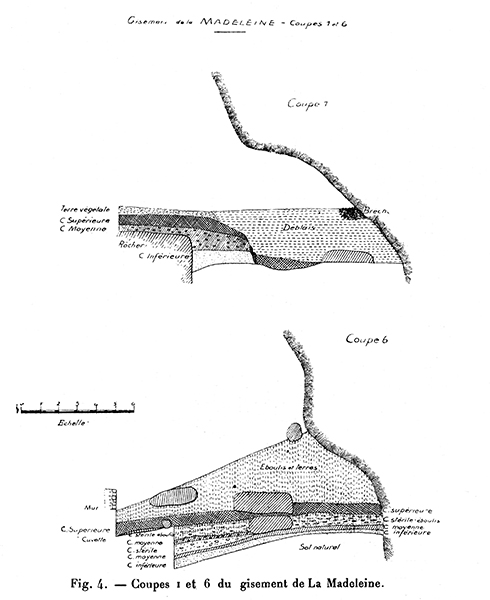
Coupes 1 and 6 of the gisement of la Madeleine.
(Brecn = Brèche, breach or hole)
Photo and text: Capitan et Peyrony (1928)
In section No. 6, fig. 4, the lower layer rested on the terrace at the bottom of the shelter and on the inclined plane in front; it extended over a width of about 11 metres.
The middle layer exactly covered the previous one and did not exceed it in size or extent.
The upper layer was separated from the others by a barren layer of large and small scree; it advanced much further into the meadow where it formed a strong lens. These layers were covered by a thick layer of scree of all sizes.

Figure 4 bis.
Peyrony or Capitan (in the background) and workers during the excavation of La Madeleine in 1926.
Photo: Capitan et Peyrony (1928)
1 - The Bottom Layer
This level, formed of clayey sand from floods, was the colour of brick clay. In front, it sometimes reached more than a metre in thickness, while behind, it varied between 25 cm and 50 cm.
Between coupes nos. 1 and 4, we noticed two thin brown strata, one at the top, the other at the base.
The latter consisted mainly of a bed of hare bones 4 to 5 cm thick. The remains of these rodents have been found all over the site, but nowhere else in such large numbers.
They seem to be the remains of meals from the great nocturnal birds of prey of that period.
The old excavations had reached very little of this layer; it has therefore been possible for us to follow it over a large area and to study it well. On the inclined plane, it rested on a kind of limestone paving. This arrangement allowed the residents driven out by the floods to reoccupy the shelter, as soon as the waters had receded, without having to suffer too much from mud underfoot.
The Lithic Industry
Figure 5 - Solutrean objects, or those with characteristic Solutrean features.
At the base of the layer, on the surface of the shelter floor, we collected a fragment of a laurel leaf blade (no. 1) and half of a scraper (no. 2) that had been slightly polished*. These pieces, located outside the human deposit, do not seem to have been carried there by Magdalenians, but rather abandoned by Solutreans, who, during a hunting expedition, must have rested there. The burin (no. 3) found in the middle of the layer is apparently of Solutrian design; however, the patina of the flint indicates that it cannot be classified with the preceding objects; despite its size, it appears to be early Magdalenian.
( The polish* or glazing referred to here is a common post-depositional alteration of the surface of a flint artefact. When present, the entire surface is usually uniformly affected. Almost all flint artefacts which have been exposed to ground water for extended periods of time exhibit some amount of glazing. This may be caused by adsorption of dissolved silica from soil solutions bathing the artefact in situ, or the dissolution and reprecipitation of siliceous constituents of the artefact's surfaces. Artefacts with advanced glazing (or gloss patina) have a true glossy lustre and feel pleasantly smooth to the touch.
See Howard (2002) for further explication of glazing - Don )
Photo and text: Capitan et Peyrony (1928)
Figure 6 - Various types of burins.
Burins - Burins comprised half of the stone tools found. We have shown several times that they are above all bone, antler and ivory carving tools. They were born with this industry and multiplied as the use of these materials became more widespread. They certainly served also to execute sculptures and engravings on stone, but the finest drawings on bone were made with more delicate points (Fig. 10), and burins of the parrot beak type (Fig. 44)
The burins are quite varied, most often straight, formed from a blade, at the end of which two blows of the knapper were skilfully given, one to the right, the other to the left, which removed small flakes and gave a double bevel (fig. 6, no. 2 and the top of no. 3, fig. 6). If the blade was too thick, several flakes had to be detached to obtain the dihedral angle (fig. 6, nos. 1, 1a), sometimes one side was obtained by a sharp blow as before and the other by steep retouching (fig. 6, no. 4).
The angled burin and its derivatives present a most interesting set. If, starting from the true angled burin, with rectilinear truncation (fig. 6, no. 5), very numerous in the Upper Aurignacian, we take the series with concave and oblique truncation, we arrive at the oblique burin ( fig. 6, nos. 6, 7) and the burin bec-de-flûte (fig. 6, nos. 8 and 9).
( The burin bec-de-flûte is the simplest classic burin of all. The bevel, placed at the end of the blade, is formed by two faces which meet at a rather acute dihedral angle whose edge is perpendicular to the plane of the blade. There is only one removal on each side. See: Cheynier (1963).
Note, however, that Peyrony seems to use a different definition to that now used. His example (fig. 6, nos. 8 and 9) is not a simple acute angled dihedral burin.
- Don )
If, on the contrary, we examine the one with convex truncation (fig. 6, no. 10), we are led to oblique burins of another kind (fig. 6, no. 11, 12) ending imperceptibly in the first parrot beak burins (becs de perroquets) (fig. 6, nos. 13 and 14) which are still rare and coarse.
Some of these tools are double, such as nos. 3 and 11, fig. 6.
Photo and text: Capitan et Peyrony (1928)
Figure 7 - Various types of grattoirs and pieces with abrupt retouches.
Grattoirs or scrapers represent about one fifth of the lithic tools. They are, after burins, the most numerous artefacts.
They are usually simple and on the end of a blade. There are some very large ones (Fig. 7, no. 1), while others are very small (Fig. 7, no. 4). Some are retouched all around as in the Aurignacian and Solutrean periods (fig. 7, no. 2). Others, rarer, have abrupt retouching (Fig. 7, no. 3). Double scrapers (Fig. 7, no. 6), are few and there are also only a few of the thick ones, reminiscent of the Aurignacian carinated scrapers, and used for the same purpose (Fig. 7, no. 5).
The uses of the scrapers appear to be multiple, but poorly defined. There is one, however, that seems certain, the idea of which was suggested to us by the barely sketched hole of a command stick. The first part of this perforation forms a large, regular and shallow cupule which could only be obtained with the convex and rounded part of a scraper on the end of a blade used as a gouge auger. Until now it was assumed that these holes were made with a made with a strong pointed tool, a drill.
Scraper-burin - some pieces have two ends, a scraper at one end and a burin at the other (fig. 7, no. 8).
Pieces with abrupt retouches - at the base of the layer we have collected pieces with abrupt retouches (fig. 7, no 7, 9, 10, 11 and 12) similar to those which we reported at the base of the Laugerie Haute site (at Abri Leyssales), at the Champs Blancs, immediately above the final Solutrean, at Badegoule.
MM. de Fayolle and Féaux encountered identical ones on the surface of the Solutrean of Laugerie Haute and M. Délugin, at the same level, in the small shelter of Mazérat, commune of Bayac (Dordogne).
M. Delage, from Limoges, has sent to one of us (Peyrony), some picked up at Placard. Passing through Saint-Germain, the latter asked to see the drawer containing the oldest Magdalenian in this site; he was happy to see the presence of several of these tools.
Among the rare objects that we found in 1912, when exhuming the Magdalenian skeleton from the Cap-Blanc sculpture shelter, there are two of the same type; they come from the lower level of this deposit, since the upper one had been completely removed.
Wherever these pieces have been encountered in stratigraphic position, they characterise the initial phase of the Magdalenian.
Photo and text: Capitan et Peyrony (1928)
Figure 8 - Awls and blades
Awls - These tools usually have a point made conical by use (Fig. 8). (Fig. 8, no. 6 1, 1a, 3, 3a, 4, 4a); some are very large (fig. 8, nos. 1, 1a); others, medium in size (fig. 8, no. 5); but most of them are small and delicate (fig. 8, nos. 2, 3, 3a, 4, 4a).
Blades - The Magdalenians knapped flint into blades of all sizes with extraordinary skill; they are always long, thin and rather narrow; many are rough (fig. 8, no. 6); some rather large, straight or curved, have been backed (fig. 8, nos. 7 and 8). Sometimes they have been truncated at one end (fig. 8, no. 9); other smaller ones, such as no. 10, Fig. 8, are simply obliquely truncated at one end (fig. 8, nos. 11 and 12) and seem to have been prepared to obtain burins, like no. 13, fig. 8, by giving the right-hand corner a sharp blow with the striker.
Photo and text: Capitan et Peyrony (1928)
Figure 9 - Pointed blades, backed flakes, backed points, tanged points, miscellaneous flakes and points.
Pointed blades - Some small blades are pointed by unilateral or bilateral unopposed retouching (fig. 9, no. 1), or bilaterally symmetrical (fig. 9, nos. 2, 3 and 4). They must have been used as points on spears.
Backed flakes - Thin, narrow, backed blades, (fig. 9, nos. 8 and 9), a kind of small pocket knife, are quite frequent.
Backed points - These are numerous and of all types. They vary in size from two to ten centimetres in length. Some, like fig. 9, no. 10, must have been as long as the large La Gravette points; many are medium in size (nos. 5, 6, 7, 11), but most are small and delicate (fig. 9, no. 12); we have found one curved example (fig. 9, no. 5) but this form is very rare in this layer.
Tanged points - The above pieces are not the only ones reminiscent of the Upper Aurignacian; there are also some rare tanged points, pointes à soie, (fig. 9, no. 13).
Miscellaneous flakes and points - there is a variety of small blades with thin peduncles, thick rough backs, straight cutting edges (fig. 9, nos. 15 and 16) or arcuate in shape (fig. 9, no. 14); some with solutrean-type ends (fig. 9, nos. 17 and 18). Nos. 14, 15, and 16 were obtained by making burins. All these small pieces were used to drill, engrave, etc. or to arm spears.
Photo and text: Capitan et Peyrony (1928)
Figure 10 - Engraving tools
Engraving tools - For fine engravings on bone and stone, instruments with a delicate point were needed. These were either straight points obtained by two-sided and symmetrical retouching (fig. 10 no. 1) or were quite small, straight burins (fig. 10 no. 2) or angled ( fig. 10 no. 3), and sometimes both types combined (fig. 10 no. 4), or small curved points forming a parrot's beak (fig. 10 nos. 5 and 6).
Photo and text: Capitan et Peyrony (1928)
Figure 11 - Choked (strangled) blade, and a toothed blade
Lames à étranglement basilaire - Blades with a small notch on each side of the butt.
Fig. 11 No. 1 is a thin blade, shaped like a small cleaver , broad but with a narrow base, without marginal retouching, and has a constriction at the base produced by two symmetrical notches, allowing it to be firmly attached to a cord or strip of leather, and to be worn suspended, perhaps at the belt.
We have noticed the same feature on a parrot beak from the upper layer and on a burin from the cave of Les Eyzies.
Serrated blades
Some blades are toothed all around (fig. 11 no. 2), or only on one side, the teeth being formed by notches arranged more or less regularly. It is very likely that these were small saws.
Photo and text: Capitan et Peyrony (1928)
Figure 12 - Mousterian objects.
Objects from the Mousterian culture - Two small triangular points, identical to those of the Upper Mousterian (Fig. 12, no. 6) were found in this level together with a scraper (Fig. 12, no. 5) and two small discs (Fig. 12, no. 4).
We also collected two handaxes, one of which was quite regular (Fig. 12, no. 3). Is it purely a matter of chance that it was given this shape, or is it intentional?
By careful examination we saw that the retouching has been done to regularise the edges and give the shape of a heart. We were not very surprised to find this object there. Already, a few years ago, we had discovered one in la grotte des Eyzies; it is currently in the collection of one of us (Capitan).
We will see later that the upper layer provided two of them (fig. 46, nos. 1 and 2). These pieces, mixed with other similar ones from the Lower Palaeolithic
cannot be distinguished from them. It may be objected that they were only there accidentally, brought by the Magdalenians who, in their excursions to the neighbouring plateaux, had picked them up on the surface.
The objection would be correct if their patina were different from that of the other pieces in the layer, but it is identical: these handaxes probably did not have the same destiny as those of the ancient Palaeolithic; they must have served as chisels or gouges to the prehistoric artist to model the sculptures made by the pics (fig. 12, nos. 1 and 2).
Picks - Picks or pics are a large tool used to dig holes or cupules in wood or stone. They usually have a strong heel which is generally continued by a point in the shape of a triangular pyramid (fig. 12, nos. 1 and 2); they have some resemblance with the primitive Chelléen ( now referred to as Acheulean - Don ) handaxes.
Until now, many excavators have overlooked them, taking them for debitage, the scraps of manufacture; we have always collected them with care; we thought they were large tarauds ( large awls or pointed digging tools, often used for wood, and often of rough workmanship - Don ). However, the polished edges of the point told us that they must have been used to work something other than bone.
But what were they? The discovery of the rock sculptures of Cap Blanc made us aware of their main use. After having traced his sketch on the stone with a burin, the prehistoric artist used a pick to remove the parts of the rock that would give relief to the drawing; with gouges and grattoirs (scrapers) at the end of a blade, he accentuated the hollows and modelled the projections; he cleaned up the angles with a burin.
Photo and text: Capitan et Peyrony (1928)
Figure 13 - A pestle.
Molette or pestle - A hard calcareous stone with a rounded shape with two adjacent worn faces. It is a small hand grinder.
Photo and text: Capitan et Peyrony (1928)
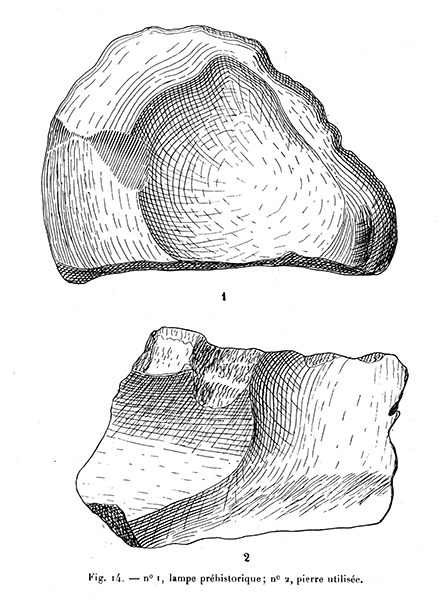
Figure 14 - No. 1, prehistoric lamp; no 2, a "used stone".
Lamps - Several pieces of limestone with regularised contours bear a cupule, sometimes natural, sometimes enlarged, or completely artificial.
They all show traces of fire on their surface. (fig. 14, no. 1). They have long been mistaken for paint pots; but not the slightest particle of the colouring matter so apparent and so well preserved on grinders and on hollow utensils from other deposits can be seen.
The cup face has been subjected to the prolonged action of fire, of which the cup seems to have been the centre. We are therefore led to admit that these objects are the first lamps, fuelled by the fat and tallow of animals, with a bundle of moss as a wick, as used among the Inuit.
Photo and text: Capitan et Peyrony (1928)
Ochre grinders - There are a few large flat pebbles with one of their faces stained with red ochre; others, smaller, round, oblong or prismatic, which can be easily held by hand, are covered with it. The first was the disc on which the ochre was ground with the second: they are identical to those of the two other layers (fig. 65, n° 1).
Pierre à anneau - One large stone and another, much less, present an artificial ring identical to those so numerous in the Aurignacian. What were they intended for? Stretching tent ropes, nets and fishing ropes? or to tie up or fetter captured animals?
Used stones - On a fragment of lithographic stone (fig. 14, no. 2), one notices on one of the faces areas of flint scrapings arranged irregularly, thus forming reliefs and hollows on the surface the purpose of which is very difficult to form an opinion.
Strikers - These are quartzite pebbles always bearing one or more hammering surfaces.
Nuclei - They are numerous. Many fairly large and regular ones could still have been used, but they were abandoned for other better ones, the raw material being abundant; those that could no longer be debited are of small dimensions. They have all been reused, either as thick scrapers or as picks or gouges.

Figure 15 - Retouchers and compressors
Retouchers and compressors - Some small oblong or flat pebbles (fig. 15, nos. 2 and 4) have usage zones near the ends, similar to those found on some bone fragments (Fig. 15, no. 1) and also found in the Aurignacian and Solutrean.
These differ from the typical Mousterian in that on them, the usage zones are similar to those found on the Mousterian (fig. 15, no. 1) and which are also found in the Aurignacian and Solutrean; the latter differ from the typical Mousterian in that, on these, the cuts are transverse and there is no depression, whereas on the others, the usage was lengthwise and the tool was used for a longer time; however, a horse phalange (Fig. 15, no. 3) has traces identical to those found by Dr Henri Martin at La Quina.
Photo and text: Capitan et Peyrony (1928)
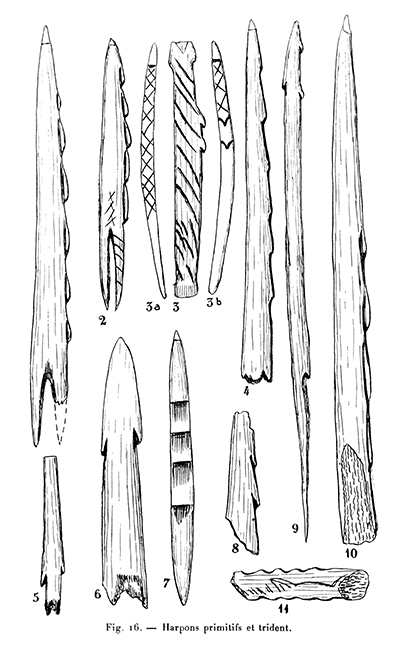
Figure 16 - Primitive harpoons and trident
Bone, ivory, and reindeer antler industry
In some places, reindeer antlers were piled up in all directions and formed a large deposit; but they were in such a poor state of preservation that it was usually only possible to collect the bases and the ends of the andouillers ( small horns on the antler - Don ), which were less friable. Almost all of them had undergone the beginnings of flaking.
The bone objects included:
Primitive Harpoons - There are only four whole ones (fig. 16, nos. 1, 2, 3 and 9), all the others are fragmented. They are all made of reindeer antler except no. 9 which is made of ivory and nos. 4 and 8 of bone. No. 7, fig. 16, appears to be more of a shaft with a notch to secure several movable barbs with the help of ties than a real harpoon.
There is a harpoon from the Solomon Islands in the Eyzies Museum, of a type which is still used by the natives. It consists of a reed shaft at the end of which porcupine spines are staggered and solidly attached with the help of sinew, so as to form recurring barbs like those on a prehistoric harpoon.
The piece we are interested in may have been armed identically with bone, wooden or perhaps even flint points. Some types have only faint lateral notches (Fig. 16, nos. 4 and 11); others have barbs barely indicated by a small bulge (Fig. 16, nos. 8 1, 2, 6, 8, 10); finally, some have small points (Fig. 16, nos. 8 3 and 9). One has a basilar bulge that facilitated its insertion (fig. 16, no. 3). Its head is flattened in bevel with lateral projections and a triangle in bas-relief on both sides at the end. Eight oblique and almost parallel grooves occupy the upper two thirds of the piece, while eight others, arranged in a more disordered manner, fill the other third. The left side (fig. 16, no. 3-a) is decorated with a grid formed by two series of ten oblique lines, some on the right, others on the left, intersecting. The same feature affects the portion of the right side between the barbs and the upper bulge (fig. 16, no. 3-b).
Two others have their base bifurcated like the forked base of an spear point (fig. 16, nos. 1 and 2). One of the latter type exists in the Piette collection, coming from the lower level of Gourdan, a level corresponding to the lower one of la Madeleine.
Trident - A bone piece (Fig. 16, no. 5), terminated at one end by two small, very short points, bears, at one centimetre from the end, two symmetrical bilateral barbs, barely indicated, like those of primitive harpoons. The other end, broken off, is thinned out and would have formed the shank of this tool. With forward points, it is comparable to the trident used by fishermen to catch large fish.
( These fish spears are common in the Magdalenian, and are often given the name foëne. See the entry below on fish spears from la grotte de la Vache - Don )
Photo and text: Capitan et Peyrony (1928)


(left): Magdalenian foënes or fish spears from la grotte de La Vache, more complete specimens than the bone piece (Fig. 16, no. 5) from la Madeleine, above.
Dimensions: length 61 mm, width 19 mm, thickness 5 mm.
Catalog: MAN83641CLXC61
(right): Magdalenian foëne or fish spear from la grotte de La Vache.
Dimensions: length 71 mm, width 21 mm, thickness 8 mm.
Catalog: MAN83640.CXLIIIC43
These are points of reindeer antler which were attached to a long shaft, used for catching flatfish, particularly while wading in shallow waters. Its handle could be equipped with a cord, enabling the spear to be retrieved when thrown at a fish. In particular, foëne were often used for eel fishing, the extra points making it possible to catch these fish, which are slippery and difficult to catch otherwise.
It is speculated that they may have been used to take down birds as well.
Photo: Don Hitchcock 2015
Source: Original, Musée d'Archeologie Nationale et Domaine, St-Germain-en-Laye
Text: https://www.photo.rmn.fr
Additional text: Wikipedia
Figure 17 - Various objects in bone, ivory and reindeer antler.
Spear points - Some from the bottom of the deposit are almost lozenge-shaped, with a short base, and decorated with two rows of oblique strokes, starting from the edges and heading towards a median groove (Fig. 17, no. 4); there are six in each series. Others are cylindrical-conical, with a pointed base, decorated longitudinally with a series of oblique lines and parallel lines arranged symmetrically, two by two, on each side of the piece (Fig. 17, no. 3).
In the other parts of the layer, we found several with a quadrangular pyramidal base (fig. 17, no. 8 1, 2, 5, 16); no. 2 presents, laterally, a row of oblique gouge strokes parallel to each other; a cylindro-conical ( cylindrical with one end tapering to a point - Don ) point, whose oval-sectioned base (fig. 17, no. 15) bears oblique lines to facilitate fitting; it is the same as some of those found in the Upper Solutrean, but it is those with a single-bevelled base that are the most numerous (fig. 17, nos. 13, 17, 18); as for those with a double-bevel, they are still small in size, barely the size of a large needle (fig. 17, nos. 9 and 10)
A few rare ones have a sort of peduncle with two symmetrical notches (fig. 17, no. 12). We found two bone blades with a very flattened oval cross-section and sharp edges, pointed at one end, the other rough (Fig. 17, no. 19). Are these still spear points or are they small dagger blades?
Points with a forked base - There are only two pieces of this type (Fig. 17, nos. 11, 20); they are identical to two others found at Laugerie Basse by M. Maury, in the primitive harpoon level that corresponds to that of La Madeleine.
Another similar one was collected by the same person in the corresponding level of the Marseilles excavation, located about a hundred metres upstream from the previous one. In Périgord, these pieces have so far only been found with the primitive harpoons, some of which also have a forked base (fig. 16, nos. 1 and 2). We said that Piette had discovered a harpoon with rudimentary barbs and a bifid ( divided by a deep cleft or notch into two parts - Don ) base at Gourdan, in the base level corresponding to the lower one at La Madeleine. But contrary to what happens in the Dordogne, the forked points similar to ours, which are very numerous in the Pyrenean region, belong, according to Piette and Abbé Breuil, to the harpoon base with unilateral barbs.
According to the excavations carried out in 1913 in the Isturitz cave (2) by Passemard, these objects seem to have appeared even later in the western Pyrenees. He collected them in a level containing both harpoons with one and two rows of barbs, corresponding consequently to the upper layer of the Marseilles, where these two types of harpoons are also found together. The primitive harpoon with a forked base, which is quite rare, appeared almost at the same time on the banks of the Vézère and in the Pyrenees.
But the use of points with the same base seems to have originated in the Perigordian caves; it was then transmitted to the populations of the central Pyrenees, to end up in the western region of the chain and reappear in Périgord in the form of a small arrowhead at the end of the Magdalenian period.
Ciseaux or chisels - They are usually made of large reindeer antler shafts with one end rounded and hammered, the other bevelled (Fig. 17, no. 21); some are ornamented. They may have been used for splitting antler or bone or small pieces of wood.
Photo and text: Capitan et Peyrony (1928)
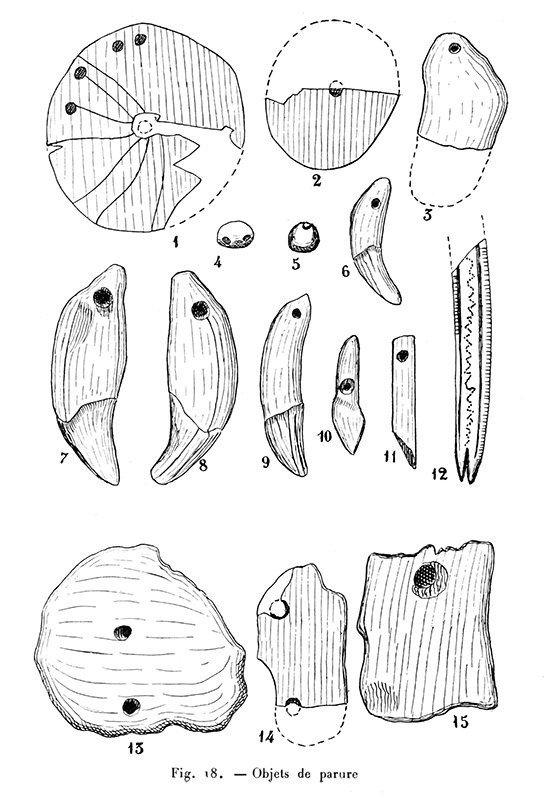
Figure 18 - Ornamental objects
Ornamental objects - We collected several red and black samples probably used for body grooming (painting or tattooing), various kinds of pierced teeth (Fig. 18, nos. 6, 7, 8, 9, 10), pierced marine shells (Fig. 18, no. 4), a charred ivory bead (Fig. 18, no. 5), small limestone pebbles (Fig. 18, nos. 3, 13 and 14), a pierced schist baton (Fig. 18, no. 11), a perforated bone (Fig. 18, no. 15), and a reindeer antler amulet (Fig. 27).
Many of these pieces were simply the various elements of necklaces, hairnets or bracelets; others, such as the stones and large bones, seem to have had another purpose. Were they amulets? An almost complete disc (Fig. 18, no. 1) with four round holes and several radiating lines and a fragment of a second one with a central hole (Fig. 18, no. 2) were found at the base of the deposit. Are these the first buttons or other objects of adornment?
Tattoo point - A thin and regular blade of bone, with blunt edges (fig. 18, no. 12), is broken at one end and, at the other, terminated by a bifid point; it is slightly arched.
The inner face has two longitudinal lines parallel to the edges, dividing the surface into three unequal bands; the middle one is wider than each of the other two; each side band is decorated with a series of small lines; that of the middle, of a sinuous dotted line going from one end to the other and ending in the small furrow which separates the two points. This face is covered with red ochre; on the other, there is not the slightest trace of colour or ornamentation.
We believe this is the first time an item like this has been reported. What could it be good for? The two sharp points that end it, the deep groove, which can serve as a reservoir for a liquid, that separates them, the dotted design that adorns one side, the colour that covers it entirely, make us think of tattooing; this piece would be the operator's tool; we cannot, for the moment, assign it any other use.
One of us (P.) saw a modern tattoo artist operate. He used three fine needles firmly tied together, the points of which formed a small triangular reservoir; he dipped the points in a coloured liquid and pricked the part of the body to be adorned, holding the skin tight with the other hand. Two tips would have sufficed, but with three, the reserve of liquid was greater.
With two points, the tool would be almost identical to the one just mentioned.
Photo and text: Capitan et Peyrony (1928)
Figure 19 - Sketches of horse heads
Art Objects
We know that art began in the Aurignacian period (statuettes from Laussel, from Brassempouy, an engraved horse from Sergeac, wall engravings from Pair-non-Pair, but with such archaic characters!
During the Solutrean, little progress was made; but from the beginning of the Magdalenian period, with the development of the bone industry, it took its upward march.
Aurignacian artists seem to have drawn animals from memory. Their images (engravings and paintings) show little or no evidence of trial and error.
One hardly notices the extraneous features of trial and error, which are numerous in Magdalenian works. Also, not only are the Aurignacian outlines stiff, but they most often lack proportion and, above all, expression.
The Magdalenians, on the other hand, like our contemporary artists, studied their subject from nature. A bone, a fragment of reindeer antler, an animal rib, a piece of schist, a soft sandstone, a limestone, etc as a slate, and with a burin in their hands, they travelled through the landscape and sketched the animals in various attitudes from life.
First the head, which best expressed the feeling, was the object of all their attention. Then came the hindquarters. Sketches of whole animals are rarer. They thus composed a series of detailed studies, a sort of album on which they drew abundantly to execute beautiful works of art on bone or rock.
We have grouped these various sketches into three plates which we present before the real works of art. In figure 19 are grouped all the equidae heads collected.
No. 1, on flat spongy bone, shows a bearded horse sketched in a few strokes of the burin. The ear erect, the mane raised, with a triangular eye, it seems to scan the horizon.
Head no. 2 stretched forward, the ear laid back, is that of an animal at full gallop. It appears to be out of breath, as evidenced by the bundles of lines coming out of its mouth and nostrils, probably representing its spittle. Its hairy face indicates an older animal.
Images nos. 5, 6 and 9, of different subjects, present the same attitude as the previous one, galloping hard. No. 4, on red sandstone, is in an attitude of observation; muzzle raised, ears erect slightly forward, with a bright eye.
Nos. 3 and 7 refer to young subjects at rest and Nos. 10 and 11 to older individuals. Nos. 8 and 12 are cursory studies.
No. 9 shows an eye and ear study at the top, and to the left of the muzzle, which can be put in the normal position by turning the piece over from top to bottom.
Finally, No. 13 shows almost the entire body of a horse at full gallop; the head is very neat. It has three acute angles on the flank with very long sides which seem to simulate the points of shafts wounding the animal.
This feature, also found on the bison of Niaux, a reindeer from Limeuil, etc., seems to be related to certain superstitious practices, probably of hunting magic. Note the suppleness of the features and the expression of these various figures.
Perhaps zoologists will find material to discern several races in these well rendered studies.
Photo and text: Capitan et Peyrony (1928)
Engraving of a horse head on a diaphysis, the middle of a long bone, Middle Magdalenian, as drawn at number 5, above.
Photo: Don Hitchcock 2014
Source: Original, Le Musée National de Préhistoire, Les Eyzies-de-Tayac
Engraved horse head on a diaphyse, the middle of a long bone, Middle Magdalenian, as drawn at number 6, above.
Photo: Don Hitchcock 2014
Source: Original, Le Musée National de Préhistoire, Les Eyzies-de-Tayac
Figure 20
Various sketches on bone, reindeer antler, and stone.
A fragmented reindeer antler (Fig. 20, no. 1) bears a well-groomed reindeer hindquarters and an inverted horse hindquarters. There is deformation due to the winding of the design on the cylindrical antler. Three sharp double-line angles appear to represent line points in the same way as those found in fig. 19, no. 13.
No. 2, fig. 20, is the profile of a bovid on reindeer antlers with a few lines behind indicating a sort of mane.
No. 3, Fig. 20, is a doe's head, ear erect in a scrutinising position.
No. 4, Fig. 20, on a pebble, is the forequarters of a chamois (izard) with its small unfinished right horn.
No. 5, Fig. 20, on limestone, is a poorly executed canid.
No. 6, fig. 20, is the hindquarters of a mammoth, very recognisable by its small tail, the shape of its back and the long hair that covers it entirely. It is drawn on a fragment of a bone dagger blade. The two crosses placed at the back are special signs of the author to indicate his work; it is, if one can express it this way, his signature, as Piette said.
No. 7, Fig. 20, on a rib, represents two ibex heads, one male with a short, thick muzzle, the other female, thinner and more elongated, of good execution.
No. 8, fig. 20, is a reindeer antler on which a lynx head has been strongly incised, easily recognisable by its very pointed ears. In front of this drawing, two acute angles with converging bases appear to represent the front ears of the same animal.
No. 9, fig. 20, is a reindeer antler on which a few deep incisions placed in the right place produce the profile of a beautiful antelope head.
Photo and text: Capitan et Peyrony (1928)
Figure 21
Various sketches on bone and reindeer antler.
Fig. 21 shows a series of sketches of varying degrees of sophistication, but which nonetheless shed light on the way in which these skilful artists proceeded.
No. 1, very schematic, on a limestone pebble, appears to be a running boar. Nos. 2 and 3 are studies of animal bodies. No. 4, very crude, is the hindquarters of a deer, while Nos. 5 and 7 are sketches of equine hindquarters, and No. 6 is a quick and sloppy sketch of a similar animal. The other drawings are studies of the details.
No. 8 consists of a series of almost parallel lines simulating hair or mane.
No. 9 is a representation of the horns of a bovid with the frontal tuft, and No. 10 that of a bison forequarters reduced to its most characteristic parts: angular muzzle, dewlap with long hair, shorter belly hair.
Nos. 11, 12 and 14 are different studies of eyes, while No. 13 appears to be a series of more or less detailed ears.
Photo and text: Capitan et Peyrony (1928)
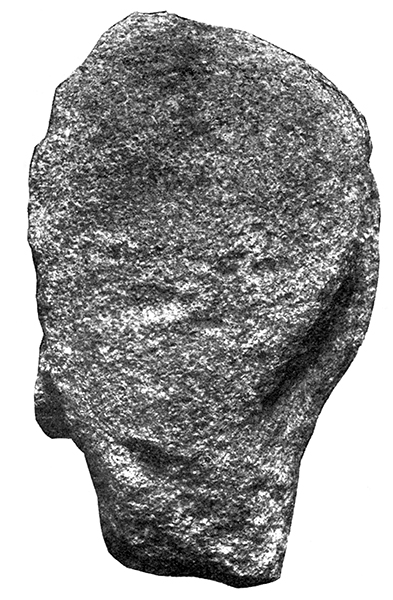
Figure 22
Sculpture - During this phase, sculpture developed and reached its peak. It was collected at all the heights of this level; however, the following ones come from the base:
Left, Fig. 22, the limestone hindquarters of an animal in the round. The two legs still joined are unfinished, the two thighs are indicated by a groove that separates them; one can clearly see the the start of the belly. The whole is well modelled. It is regrettable that this statuette is not complete.
Photo and text: Capitan et Peyrony (1928)
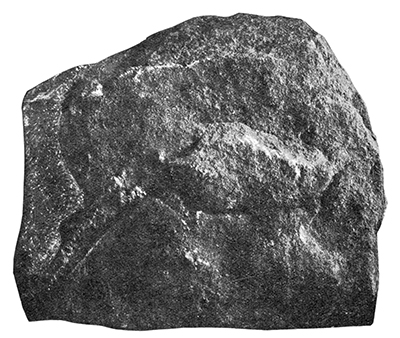
Figure 23
Sculpture - A limestone slab with a galloping deer, without a head, in strong relief. The hind leg, with the hock stretched out, is well sculpted; a series of pick strokes bring out the belly and the genitals. The artist has given his work modelling and movement.
Photo and text: Capitan et Peyrony (1928)
Figure 24
Sculptures, bas-reliefs and cut-out shapes
A fragment of a reindeer antler spear thrower (fig. 24, no. 1) with animal heads barely indicated by small reliefs and drawings composed of almost parallel sinuous lines and dotted lines.
An identical propulseur, one with a clear eye, the beginning of ears and the snout indicated by several lines is shown at fig. 24, no. 3.
A command staff (baton percé) from the middle of the layer is decorated on one side with a beautiful reindeer head in relief (Fig. 24, no. 2a) and oblique lines and on the other with a barbed arrow (Fig. 24, no. 2b). A piece of a second (Fig. 24, no. 6) bears two horns in relief, symmetrically placed on one side each; the part that follows simulates a kind of crest with deep gouge marks; it could also indicate a strong mane. An almost identical piece has been found in the corresponding level of Laugerie-Basse.
A phallus made of reindeer antler, the drawing of which dispenses with any description (Fig. 24, no. 8).
A small unfinished sculpture (fig. 24, no. 7), a sketch of a quadruped in the round.
No. 10, fig. 24, is a fragment of a hooked spear thrower carved in the shape of a horse's head; the two ears are very clear and the muzzle is pointed.
No. 9, fig. 24, is a propulseur identical to no. 10, with a broken top.
Another propulseur fragment shows, symmetrically and in relief on both sides, an ear and a buffalo horn (Fig. 24, nos. 4a and 4b) and in addition, on one of them, a deeply incised buffalo hind leg (Fig. 24, no. 4a).
Cut-out contours
Fig. 24, nos. 5a and 5b is a very flattened equine leg. It was first drawn on an animal rib, then cut out and the corners rounded. On each side, tufts
of hair and some signs are engraved.
Photo and text: Capitan et Peyrony (1928)
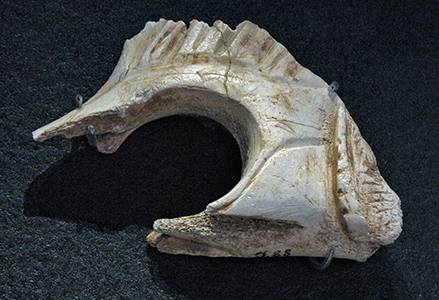
A photograph of Fig. 24, no. 6 above, part of a beautifully made bâton percé.
Photo: Don Hitchcock 2008
Source: Original, Le Musée National de Préhistoire, Les Eyzies-de-Tayac
Phallus carved from reindeer antler - Upper Magdalenian, from la Madeleine, as drawn at Fig. 24, no. 8 above.
Photo: Don Hitchcock 2014
Source: Original, Le Musée National de Préhistoire, Les Eyzies-de-Tayac
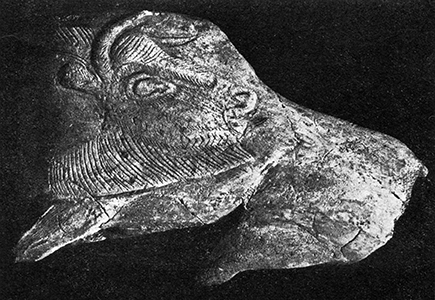
Figure 25
Bison sculpture
Finally, a superb reindeer antler statuette, representing a bison, head turned over, licking its flank (fig. 25, left). The artist made a real tour de force to execute it. He first carved, the body of the animal, except for the head; then, as he lacked the material to make the latter, he has ingeniously turned the difficulty the difficulty by representing it in a retrospective position, and admirably engraved it, slightly in relief, on the withers.
The way in which this head is treated is astonishing; everything is there: the forehead trimmed with a mane, the arched nose covered with hair, a horn in relief, the other recessed, the small ear, the large and well studied eye, the mucous membranes of the nose and mouth separated from the skin by a dotted line, the dewlap and mane represented by long striations, the tongue protruding from the mouth but recessed ( in intaglio ) on the back, the hairy parts well marked, the whole modelled in a surprising way.
Together with the Lourdes horse and the statuette below, Fig. 26 (1 and 2), an ivory statuette (propulseur) representing a feline or hyena and also from La Madeleine, this is the most beautiful work of prehistoric art known. As for the others, found in this level, it was not always easy to assign them a precise place because of the irregularity of the layer and the natural ground.
Photo and text: Capitan et Peyrony (1928)

Bison licking its shoulder, from La Madeleine
Photo: Don Hitchcock 2008
Source: Original on display at Le Musée National de Préhistoire, Les Eyzies-de-Tayac
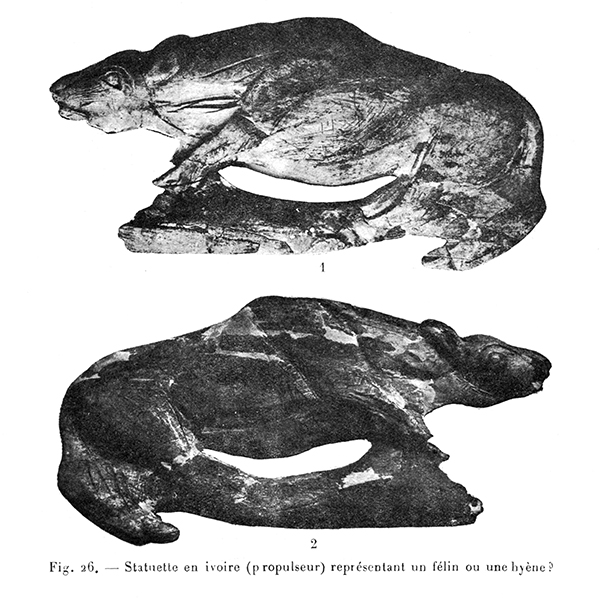
Figure 26
Under the shelter, near the base of the wall, we discovered a statuette in the round, made of ivory, in very poor condition. The material had become flaky and cracked, and we were only able to collect the numerous fragments by taking a thousand precautions and washing away all the dirt. We sent it in this state to the skilful assembler of the Musée de Saint-Germain, Mr Champion, who, by dint of patience and skill, managed to reconstitute this masterpiece. This piece is a hook for a spear thrower.
No. 1 represents one of the sides. The short and thick muzzle, the small nostril, the rounded forehead, the almost round eye, the ear and the lower jaw denote a feline or hyena head. The other parts of the body except the legs are very well studied and rendered. The animal, slightly sunk on its legs, is crouched in a vigilant attitude, ready to pounce on prey.
No. 2 is the other side, less well treated.
Photo and text: Capitan et Peyrony (1928)

The artist has included the ground surface on which the hyena is sneaking up on its prey. This is like a scene in nature, a superb piece of work.
Photo: Don Hitchcock 2014
Source: Original on display at Le Musée National de Préhistoire, Les Eyzies-de-Tayac

This is the rarely photographed back of the hyena propulseur, showing clearly the many pieces that the propulseur was found in, as well as a good view of the hook used to propel the dart.
Photo: Don Hitchcock 2014
Source: Original, le Musée National de Préhistoire, Les Eyzies-de-Tayac
Fig. 27
Bison sculpted in reindeer antler
At some distance from the latter, still near the cliff face, we found another in reindeer antler representing a bison without horns (fig. 27); the rump and the hump with its mane are indeed the characteristic parts of the body of this animal, but the head is disproportionate.
Photo and text: Capitan et Peyrony (1928)
Bison.
Photo: Don Hitchcock 2014
Source: Original, le Musée National de Préhistoire, Les Eyzies-de-Tayac
Turning the figure over from top to bottom, one notices a beautiful deer drawing on the thigh, whose head was on the broken leg of the bison.
( We can see what may be the back and antlers of a deer - Don )
This piece had a hanging hole placed under the neck of the animal. It was an amulet, a lucky charm.
Photo and text: Capitan et Peyrony (1928)
Other less important pieces include:
Figure 28
Figures representing mostly fishes
No. 2, Fig. 28, is a fish with an oval body and long tail, deeply incised. It could be related to the bream which still populates our rivers; no fins are visible, but all around there is a series of oblique lines and on the body small transverse lines indicating the scales. Behind the tail there is a series of parallel lines.
Fig. 28, nos. 3a and 3b show a fish of bone with an indication of fins and scales.
Fig. 28, no. 4 is a fragment of a reindeer antler showing the remains of deep engravings: firstly, part of an equine head - an ear, forehead, and neck. In front and above, when the figure is turned upside down, the leg and belly line of another animal can be seen.
No. 1, fig. 28, is a cylindrical piece of reindeer antler around which a series of drawings are arranged in relief; they all touch at their upper ends and thus form a continuous line; they appear to represent highly stylised heads of bovids similar to those in fig. 40, no. 9, unless they are fish tails.
Engravings. - We shall add to this list two engravings of fish; one on bone (fig. 28, no. 5), rather schematic, appearing to refer, with its pointed snout, to a pike; the other, on limestone (fig. 28, no. 6), represents two carps, one of which bears a broad band terminated by a series of parallel lines.
Photo and text: Capitan et Peyrony (1928)
This is a photograph of one of the pieces shown above, No. 2, Fig. 28, a fish with an oval body and long tail, deeply incised.
Photo: Don Hitchcock 2014
Source: Original on display at Le Musée National de Préhistoire, Les Eyzies-de-Tayac
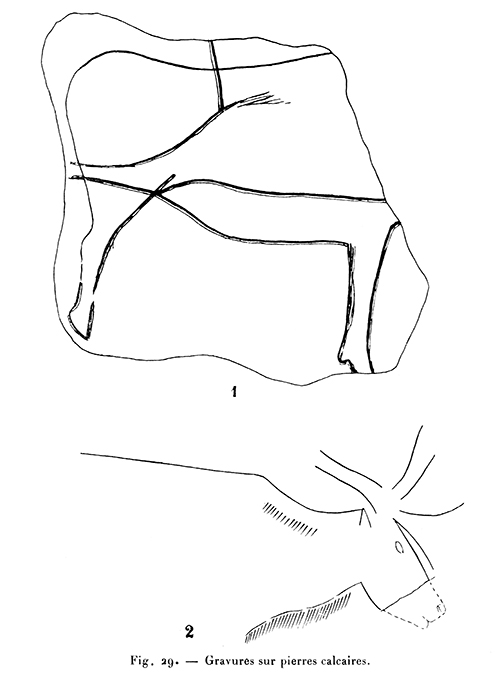
Then two others on stone: The first is a drawing of a headless bovid or deer (Fig. 29, no. 1). The lines are sharp and deep and the proportions well observed.
Rotating the figure by 90° anticlockwise, one can see the hind leg, the thigh and a bit of the belly line of another animal.
A fragmented lithographic stone was used to lightly engrave a reindeer (no. 2, Fig. 29).
Photo and text: Capitan et Peyrony (1928)
Anthropomorphic figures
On a fragment of bone, a bizarre head with two irregular eyes is seen, continued by a constriction representing the neck and an enlargement, the shoulders and the trunk (fig. 30, no. 1a).
The 'pear-shaped' part on the left would seem to be a hanging breast. This engraving is placed on the piece next to that of the hindquarters of a quadruped (Fig. 30, no. 1b).
At the extreme base of the layer we encountered a small triangular pyramid-shaped pebble with very soft ends and edges, one side of which served as a retoucher (Fig. 30, no. 2).
On the same side, but at the opposite end, we see the profile of the trunk and head of a woman; the latter is covered by a mask. The breast is very prominent below the arm bent forward; the body is furrowed with oblique and parallel striations representing perhaps the hair of a pelt with which she was covered.
The short, strong head with its snout projected forward has a bestial character that we cannot attribute to any animal species known at the time. On the other side there is a full human profile (Fig. 30, no. 3) representing a man also wearing a mask.
Here, no more than in the previous image, the head cannot be related to any animal existing at that time. So one is naturally inclined to suppose that the troglodytes not only used the remains of whole beasts to disguise themselves as we have noticed on the 'diablotins' ( little devils - Don ) of the bâton percé of the Mège shelter at Teyjat, but that they also had to make masks according to their imagination, as the American First Nations still do. Some other more inferior drawings can be placed in this category.
Fig. 30, no. 5, is also a very disproportionate human profile, remarkable above all for the slenderness of the body. It contrasts with no. 6, Fig. 30, with its large, shapeless head, large belly, strong thigh and small stature.
Finally, no. 4, fig. 30, is a lissoir, one end of which is cut out in the profile of a human head; the neck constriction was intended to suspend the tool. If the figure is turned over from left to right, so that the object is placed horizontally, a thin antelope head can be seen with its horns spread over the human profile.
Photo and text: Capitan et Peyrony (1928)
Figure 30 bis
During our recent excavations, we also discovered, at the base of the deposit, a bone bearing an engraved ithyphallic masked figure (fig. 30 bis), whose photograph dispenses with any description. Its mask, like that of nos. 2 and 3, fig. 30, does not recall any known animal head. These strange figures have their counterpart in the caves of the Périgord and Pyrenean regions. At Combarelles, several of them are clearly visible among the numerous cave decorations, and the same is true at Altamira (Spain) and in many other places.
Photo and text: Capitan et Peyrony (1928)
Diaphyse - Magdalénien moyen
Decorated long bone - Middle Magdalenian
This is a curious creature. It bears some resemblance to an otter. Only one rear limb is shown on the engraving.
Photo: Don Hitchcock 2008
Source: Original on display at Le Musée National de Préhistoire, Les Eyzies-de-Tayac
Fig. 31
Various decorations of objects in bone, ivory, and reindeer antler
Daggers - No. 1a, fig. 31, appears to be a dagger handle; there is a bit of the broken blade left. It carries two symmetrical lateral projections separating the latter from the handle and forming a detent; the start of the blade is decorated with oblique straight lines quite deeply incised, perhaps to allow the flow of blood. Fig. 31, no. 1b, represents the same part seen from the side.
( Note that this 'dagger' is now identified as a venus figure. See the photograph and text below - Don )
No. 2, fig. 31, a fragment of fluted reindeer antler, must have served as a blade for a cylindrical-conical dagger. No. 2, fig. 32, is a more complete piece, but unfinished; the handle is formed by the base of a reindeer antler; it bears deep gouge marks on both sides which are the beginning of a sculpture; natural protrusions allow the workpiece to be securely gripped; the blade is obtained by the thinning of the antler; its section is that of a flattened oval.
Marrow spoons - Two pieces, with one end cut into a point (fig. 31, nos. 9, 13), are made of reindeer antler split in two, then hollowed out inside; they look like a fragment of lead pipe split in two longitudinally, one end of which has been pointed; they are both decorated with oblique lines. What are these objects? They can be compared to other almost identical ones found by Piette in the corresponding Pyrenean levels, and which this scholar has called 'marrow spoons'; they come from the base of the layer.
Other bone parts - There are beautiful and delicate needles of all sizes (fig. 17, nos. 7, 8), small hooks (fig. 17, no. 6), awls (fig. 17, no. 14) , smoothers, baguettes demi-rondes (fig. 31, nos. 3, 4 and 5 and fig. 32, nos 7, 8 and 9), hooked propulseurs (fig. 24, nos 4a, 4b, 9, 10), bâtons percés (fig. 24, nos. 2a, 2b), etc.
Items of adornment - We collected several samples of red and black colour probably used for personal hygiene (painting or tattooing), various kinds of pierced teeth (fig. 18, nos. 6, 7, 8, 9, 10), pierced marine shells (fig. 18, no. 4), a charred ivory pearl (fig. 18, no. 5), small limestone pebbles (fig. 18, nos. 3, 13 and 14), a stick of pierced schist (fig. 18, no. 11), a perforated bone (fig. 18, no. 15), and a reindeer antler amulet (fig. 27).
Many of these pieces were only the various elements of necklaces, fishnets or bracelets; others, such as stones and large bones, seem to have had another usage. Was it for amulets?
An almost entire disc (fig. 18, no. 1) pierced with four round holes, bearing several radiating lines and a fragment of a second with a central hole (fig. 18, no. 2) were found at the base of the deposit.
Some baguettes demi-rondes show a longitudinal series of quadrilaterals in relief alternating with straight grooves (Fig. 31, nos. 3, 4 and 5); others a longitudinal median rib (Fig. 32, nos. 7, 8 and 9), or several straight, curved, sometimes oblique longitudinal grooves (Fig. 31, no. 17 and Fig. 32, no. 3).
A reindeer antler has a sinuous rib on one side, terminated at one end by two barbs facing away from each other, (Fig. 31, no. 8a), and on the convex side (Fig. 31, no. 8b), two other ribs with barbs, each represented by two parallel lines, and another barbed arrow consisting of a line simulating the shaft and oblique lines, the points (3).
The drawing in no. 7, fig. 31, is of the same type. A fragment of bone (Fig. 31, no. 12) is decorated with almost parallel longitudinal lines with slightly oblique transverse lines, forming a comb with one of them. This decoration appears to derive from that of no. 8b, fig. 31, as well as that of no. 11, fig. 31.
The series of acute angles in no. 6, fig. 31, is in the same style as No. 7, fig. 31. It is a barbed arrow without a shaft or a series of line points.
Fig. 31 No. 9, closely related to the preceding one, departs more and more from the original type; a series of oblique grooves arranged laterally on objects. Nos. 14 and 18a, Fig. 31, would, by extending them to their meeting point, give an identical image, but an even more marked stylisation leads to the decoration of Nos. 13 and 18b, Fig. 31, and finally to that of No. 19, Fig. 31. The dagger blade (Fig. 31, no. 1a) was decorated with deep oblique grooves, symmetrical in pairs, starting from the edge and converging towards the middle without meeting.
It seems that the designer was always inspired by the line point. The handle has a longitudinal groove and three deeply incised arcs (fig. 31, no. 16), probably to prevent slipping in the hand.
No. 2, Fig. 31, is a fragment of pointed reindeer antler with deep flutes converging towards the tip. It was probably the blade of a dagger of a different type from the previous one. The deep incisions on both were probably intended to help the blood flow from wounded animals. Many insignificant objects bear series of transverse lines (Fig. 31, no. 15), the significance of which is not clear. The same is true of the oblique lines in no. 1, Fig. 32. The others are decorated Bâtons percés(Fig. 32, no. 6).
Those of no. 10, Fig. 32, on schist, form between them line points that can be compared to those of no. 6, Fig. 31. Finally, various 'ticked' bones such as no. 16, Fig. 31, were only hunting marks.
Alphabetiform signs. - An ivory blade (Fig. 33, no. 1) from the base of the layer bears a series of four signs identical to our capital E and to others found by Piette on coloured pebbles from Mas d'Azil. A series of five other drawings, three on one side of a rib (Fig. 33, no. 4), two on the opposite side, seemed to us to be placed next to the previous ones; we found this sign on a chisel (Fig. 33, no. 5) from the same level; it is also reproduced next to a superb reindeer head (Fig. 55, no. 1) from the upper layer; it is also on a bone from the Piette collection (Layer 5, display case of works of art, Musée de Saint-Germain). The two marks (Fig. 33, no. 3) placed behind the mammoth may fit into this group.
Photo and text: Capitan et Peyrony (1928)

Labelled by Peyrony as a dagger blade (Fig. 31, no. 1a and 1b), this is obviously a venus figure, and is now recognised as such in the literature.
Label:
Bois de renne sculpté
La Madeleine
Fouilles Capitan et Peyrony
Les Eyzies-de-Tayac, musée national de Préhistoire
MNP 1928-7-16
Photo: Don Hitchcock 2014
Source: Musée d’art et d’archéologie du Périgord, Périgueux
Fig. 32
The significance of the oblique lines in no. 1, Fig. 32 is not clear. The others are decorated bâtons percés (Fig. 32, no. 6).
The gouged lines of dagger no. 2, Fig. 32, were probably intended to facilitate gripping.
A serpentine line can be seen on the field of a fragment of a reindeer antler spear head point (Fig. 32, no. 4). The lines of no. 10, Fig. 32, on schist, form between them points that can be compared to those of no. 6, Fig. 31.
Nos. 5a and 5b, fig. 32, are the two flattened sides of the same object which is a cut out outline. It is a fragment of an instrument whose preserved end forms a trident.
Photo and text: Capitan et Peyrony (1928)
Fig. 33
Various objects made of bone, ivory and reindeer antlers with alphabetiform signs
The two marks (Fig. 33, no. 3) placed behind the mammoth may fit into this group.
During their excavations at La Madeleine, Lartet and Christy collected a fragment of reindeer antler bearing a series of alphabetical signs (fig. 33, no. 2), the whole of which seems to form a word or a sentence, but which is an enigma for us. At the 'Crozo de Gentillo' or cave of 'Combe-Cullier', M. Viré found a baguette having on one side a series of signs which may be similar to the above.
What are these drawings? Separated, as on the chisel (Fig. 33, no. 5), the engravings (Fig. 33 no. 3) and fig. 55 (no. 1), they could well be, as Piette suggested, the author's mark, his signature, if you like; in this case, they would be comparable to certain potter's marks, which are incomprehensible to us.
But when these characters are on insignificant objects and they are repeated (fig. 33, nos. 1 and 4) or combined (no. 33, no. 2), we can neither admit that they had an ornamental purpose, nor that they are pure marks of authorship; rather, it seems to us that they are signs with a meaning for those who used them, known to all the people of a tribe and probably even to many tribes, since they are found in all the Magdalenian deposits of south-western France; this was probably the first writing.
Photo and text: Capitan et Peyrony (1928)
Most of these characters were found by Piette painted on the pebbles of the Azilian or Tourassian layer of the Mas d'Azil; some of them are found much more frequently in the Eteocretan alphabet.
Fauna
All the fauna was collected. The mammals were carefully determined by Mr. E. Harlé and the birds by Mr. E. F. Newton, whose notes we reproduce and to whom we express our sincere thanks.
Mammals
Base of the layer. - A large number of bones which are, unfortunately, very fragmented.
In the layer:
Bear: the size of the present one: one lower end of a humerus (maximum width about 96 mm.).
Wolf: of ordinary size and very large size: a few remains of ordinary fox.
Horses: of ordinary size and large size: numerous bones, some of which are adult and others young.
Large bovid: very few bones.
Reindeer: abundant remains of various sizes, some very large.
Chamois: one mandible.
Saiga (?): portion of an upper jaw with the first two back molars.
Birds: Lagopus muta ( Montin, 1776 ): - Rock ptarmigan. Aquila chrysaëtus. (Linn) - Tawny eagle.
Comparison
In summary, the base of this layer was characterised by a few abruptly retouched flints (Fig. 7, nos. 7, 9, 10, 11, 12), carvings in the round and bas-reliefs on stone; the rest of the level, by carvings, bas-reliefs, cut-out outlines, engravings, primitive harpoons, forked spear points; the whole, by numerous single-bevelled spear points, discs, large baguettes decorated with quadrilaterals in relief and by the abundance of horse and reindeer bones.
The lower part of this level is contemporary with the lower part of the Laugerie-Basse and Marseilles deposits, which have yielded sculptures and bas-reliefs in limestone, the lower part of Lorthet and part of the mural sculpture shelter of Cap-Blanc. It seems to be placed directly above the upper layer of the Champs-Blancs, the deposit of the Reverdy shelter at Sergeac, the lower Magdalenian horizon of the Placard cave. The whole layer corresponds to the "Piette equidian"; it is synchronous with the lower level of Gourdan, Arudy, Mas d'Azil, and the two lower levels of Laugerie-Basse and Marseilles.
Middle Layer
The base was of a sandy nature, almost identical to the lower one. Under the shelter, the upper part was mainly composed of small calcareous elements mixed with brick-red silt, a little clayey. We noted the presence of several hearths, but all at the top; they were formed by a paving of rolled Vézère pebbles, on which the ashes and carbonised material lay (one of them was 5.5 metres long and 1 metre wide); there were no traces of washing away by flood waters.
The floods of the Vézère were less severe than previously, since they no longer carried away the ashes and coals, and deposited no sand, but simply a little clayey silt. It is around the hearths, under the shelter, that we found the most beautiful pieces.
Fig. 34
Lithic Industry
It was less abundant than in the previous layer, but the large and small cores were more numerous. The whole of the tooling is more or less the same; we will therefore only speak of the forms that we did not encounter in the lower level. On the whole, the blades are larger (Fig. 34, no. 15). We collected a superb Mousterian facies scraper (Fig. 34, no. 1), a few small notched or toothed blades (Fig. 34, nos. 6, 7, 8, 14), a small, very fine set of tools: backed blades (Fig. 34, no. 13), drills (Fig. 34, no. 12), etc. The parrot beaks ( burins ) are not yet very numerous (14), nor well characterised (Fig. 34, nos. 2, 3, 4, 5), but they are sharper and less massive than in the previous level.
There are no pedunculate (tanged) spear heads (pointes à soie), but there are several atypical notched points (Fig. 34, nos. 9, 10 and 11).
Three triangular prismatic pieces have a roughly flat face, the other two are faceted; sometimes one end is rounded as in a thick scraper (Fig. 34, no. 16). These pieces are identical to those collected by us in the Michelet deposit at Limeuil, to two others found by M. Maury in the prehistoric deposit of Marseilles, one of which is 35 cm. long and is admirably cut. Another as large was discovered, a few years ago, by M. Dublange, a pharmacist at Fleix.
What are these objects? choppers? large knives? scrapers? Perhaps! They could have been used as planes or, resting on the flat face, as anvils for retouching pieces.
Photo and text: Capitan et Peyrony (1928)
The bone, ivory, and reindeer antler industry
Fig. 35
Reindeer antlers with the beginnings of a cut.
The reindeer antlers were well preserved, and we collected some fairly large ones, one of which was in perfect condition (Fig. 35); almost all of them had undergone some sort of shaping.
Photo and text: Capitan et Peyrony (1928)
Fig. 36
Various types of harpoons and tridents from the middle layer
Photo and text: Capitan et Peyrony (1928)
Fig. 37
Various objects in bone, ivory, and reindeer antler
The industry consists of:
Harpoons - They almost always have a single row of very long barbs projecting from the shaft. Some are large (fig. 36, nos. 1, 2, 8, 22), others medium (fig. 36, nos. 3, 4, 5, 6, 7, 20, 21), some very small (fig. 36, nos. 12, 13, 14, 15, 16, 17, 18). Those at the bottom of the layer have angular barbs and their outer edge forms a line parallel to the shaft (fig. 36, nos. 1, 2, 3, 4, 5, 6, 7, 8); those at the top have the points further away from the shaft and are regularly convex (fig. 36, nos. 19, 20, 21, 22); two or three have the base bevelled (fig. 36, nos. 1, 8), while others have a small basilar bulge (fig. 36, nos. 2, 5, 6, 7, 13, 20, 22); no. 5, fig. 36, is of surprising regularity; the small one (no. 17, fig. 36), with a double row of barbs, comes from the middle of the layer.
Tridents/Foënes. - In the upper part of the level, we discovered three pieces that do not resemble each other absolutely, but which seem to be of the same family. No. 11, fig. 36, is a sort of bone fork with flattened handles, furrowed with oblique lines, to better allow it to be inserted; the other end is finished with two bifid branches, one of which is a little broken. This instrument is comparable to the trident used by fishermen to catch certain fish. It has not been possible to find a similar one at l'abri Mège, which gave an industry similar to that of this layer, and one by M. Maury at Marseilles, in the same level.
Nos 9, 10, fig. 36, are midway between the harpoon and the trident; the two flattened ends are prepared in such a way that they can be used alternately as points or foënes and, depending on the case, one can have a harpoon or a trident.
It is not possible to find a similar one at the Mège shelter, which gave an industry similar to that of this layer, and one by M. Maury at Marseilles, in the same level. The two flattened ends are prepared in such a way that they can be used alternately as points or barbs and that, depending on the case, one can have either a harpoon or a trident.
Spear points - Most of them have a double-bevelled base (fig. 37, no. 8, 5, 6, 7, 8), some have a cylindrical-conical base (fig. 37, no. 3) or a quadrangular pyramidal base (fig. 37, no. 4) or a short rounded base (fig. 37, no. 8, 14, 15 and 16); there are some with a single bevelled base, but they are rare.
Bâtons percés - These are usually small. Nos. 1 and 2, fig. 38, are two sides of the same piece, made from a fragment of reindeer antler and decorated with horses' heads. Nos. 3, 4, 5, fig. 38, represent another seen on three sides; one end is carved as a mammoth foot, while the other is terminated by two points forming a U shape. The two small branches of another (Fig. 38, nos. 9 and 11) are shaped like the last, but with shorter points. A reindeer horn with a circular constriction almost at its base and a large hole nearby is sparingly decorated (Fig. 39, no. 1). One fragment (Fig. 39, no. 7) has two holes, one round and one oval; it is broken in the middle of the latter. The bâton percé from the Mège shelter, at Teyjat, is identically perforated.
Finally, one was abandoned during the execution. On both sides, one can see two cupules opposite each other at the base, which could only have been made with the help of a scraper on the end of a blade used as an auger (fig. 39, no. 6).
Hooked spear throwers - a very beautiful one (fig. 38, nos. 7 and 8) has been collected in pieces and admirably reconstructed by M. Champion. It is decorated with two reindeer heads in relief and barbed arrows.
No. 14, fig. 38, is a fragment of the shaft of another with the beginning of ornamentation.
Baguettes demi-ronde - Fig. 40 represents the major part of the fragments of engraved rods from this layer. It should be noted that these pieces are rarely whole.
Only one small, undecorated baguette demi-ronde was found (fig. 37, no. 9), with a thinned base and an opposite end cut into a flute beak. As a whole, they are thinner and narrower than those of the previous horizon.
Miscellaneous objects - The tools are completed by chisels (fig. 37, nos. 1 and 2), punches (fig. 37, no. 18), hooks (fig. 37, no. 13), needles of all sizes (fig. 37, nos. 10, 11 and 12), bones and soft stones ticked (fig. 39, no. 4), etc.
Only one small, undecorated baguette demi-ronde was found (fig. 37, no. 9), with a thinned base and an opposite end cut into a flute beak. As a whole, they are thinner and narrower than those of the previous horizon.
Spear points - Most of them have a double-bevelled base (fig. 37, no. 8, 5, 6, 7, 8), some have a cylindrical-conical base (fig. 37, no. 3) or a quadrangular pyramidal base (fig. 37, no. 4) or a short rounded base (fig. 37, no. 8, 14, 15 and 16); there are some with a single bevelled base, but they are rare.
Photo and text: Capitan et Peyrony (1928)
Fig. 38
Bâtons percés and propulseurs (spear throwers) variously decorated
Bâtons percés - These are usually small. Nos. 1 and 2, Fig. 38, are two sides of the same one, made from a fragment of reindeer antler and decorated with horses' heads.
Nos. 3, 4, 5, Fig. 38, represent another seen from three sides; one end is carved as a mammoth foot, while the other is terminated by two points forming a U shape.
The two small branches of another (Fig. 38, nos. 9 and 11) are shaped like the last, but with shorter points. A reindeer antler with a circular constriction almost at its base and a large hole nearby is sparingly decorated (Fig. 39, no. 1).
One fragment (Fig. 39, no. 7) has two holes, one round and one oval; it is broken in the middle of the latter. The b&acric;ton percé from the Mège shelter in Teyjat is identically perforated.
Finally, one last one was abandoned during the execution.
On both sides, one can see two cupules opposite each other at the base, which could only have been made with the help of a scraper on the end of a blade used as an auger (Fig. 39, no. 6).
Hooked spear throwers -
Hooked spear throwers - a very beautiful one (fig. 38, nos. 7 and 8) has been collected in pieces and admirably reconstructed by M. Champion. It is decorated with two reindeer heads in relief and barbed arrows.
No. 14, fig. 38, is a fragment of the shaft of another with the beginning of ornamentation.
Nos. 3, 4, 5, fig. 38, represent another seen on three sides; one end is carved as a mammoth foot, while the other is terminated by two points forming a U-shape. The two small branches of another (Fig. 38, nos. 9 and 11) are shaped like the last, but with shorter points. A reindeer antler with a circular constriction almost at its base and a large hole nearby is sparingly decorated (Fig. 39, no. 1).
It is decorated on one side with a median longitudinal groove flanked by two series of double arcs, which will be discussed later.
Art Objects
This layer has not given us any sculptures in the round; we have only collected bas-reliefs and engravings.
Bas-reliefs
Nos. 7 and 8, fig. 38, are the profile and face of a spear thrower/propulseur 275 mm long, whose hook is broken; it is decorated with two heads in relief placed one in front of the other, which can only be related to reindeer. The taller one is very elongated, without antlers, as there is not enough room for their development; the ear is well made, the eye in relief, the muzzle well executed.
The second is treated in the same way; the spread antlers are wrapped around the bed, the small ear is very clear, the series of dots running from the forehead to the muzzle indicates the arrangement of the hair; the same is true of the parallel striations covering the upper lip and surrounding the nostril. The base of the object shows two very clear barbed arrow patterns, reminiscent of those previously described in the lower layer.
The bâton percé (Fig. 38, no. 9) bears, in relief, a feline head or skull, very recognisable by its round eyes and short snout. Nos. 11 and 12, Fig. 38, are the other sides of the coin.
In addition to this image, there is a whole series of more or less enigmatic images engraved on various points of the surface. On the right-hand side of face no. 9, there is an engraving, developed in fig. 10, which seems to refer to a fish; there are three dots arranged in a triangle on the caudal region and four in a quadrilateral on the body; a line extends the snout.
The face of no. 11 shows on the right of the hole a canid head (wolf or fox): short ears and small eyes; lower down, a female sexual organ: pubis, with hairy system and vulva indicated, which can be clearly seen on figure 12. We also notice on this one two ears limiting a tuft of hair (toupet or forelock) which make us think of an equid and a drawing almost identical to no. 10, probably that of another fish.
No. 14, Fig. 38, is a broken propulseur in progress with an unfinished carved head. We found only one of these bone sketches, so numerous in the previous level, in this level.
A bone chip (Fig. 38, no. 13) shows a series of seven parallel striations and, next to it, a roughly treated equine head: the forehead, the muzzle and the eye. Another drawing of the same animal can be seen on the chisel (Fig. 37, no. 2), which is reproduced in a larger size in Fig. 38, no. 6. On one side of the bâton percé no. 1, fig. 38, two slightly raised horse heads can be seen and a third one of the same style on the other side (fig. 38, no. 2).
One side of the small bâton percé (Fig. 38, no. 3) is decorated with two superb bovid heads of perfect realism, but with parallel broken or wavy lines in the jaws. On the left between the hole and the U, there are four transverse, parallel lines, while the other end, finished in the shape of a mammoth foot, has three similar lines, the last one on the right forming a triangle with two other oblique lines. The other side (fig. 38, no. 4) shows another bovid head,
( or possibly a chamois head - Don ) less beautiful than the previous ones, with grooves arranged in a different way. The two sides of the object show a kind of grid pattern (Fig. 38, no. 5).
Photo and text: Capitan et Peyrony (1928)
Pierced baton - Middle Magdalenian
This is a photograph of 3, 4, 5, fig. 38, above.
Note that the baton has been carved with the artistically stylised likenesses of two aurochs or bison, or one of each - but they have the characteristic 'beard' of a bison.
Photo: Don Hitchcock 2014
Source: Original, Le Musée National de Préhistoire, Les Eyzies-de-Tayac
Two horses carved on a propulseur or spear thrower, from La Madeleine.
This is the other side of the propulseur shown at fig. 38, nos. 7 and 8 above.
Photo: Don Hitchcock 2008, 2014
Source: Original on display at Le Musée National de Préhistoire, Les Eyzies-de-Tayac
Pierced bâton and sculpture of a fish - Middle Magdalenian
These photos are of:
(a) the pierced bâton from Fig. 38, nos. 9 and 11 above. It is fortuitous that the bâton had been rotated in the period between the two photos, in order to see the two faces.
(b) A bone fish with an indication of fins and scales (see fig. 28, nos. 3a and 3b).
Photo: Don Hitchcock 2014, 2018
Source: Original, Le Musée National de Préhistoire, Les Eyzies-de-Tayac
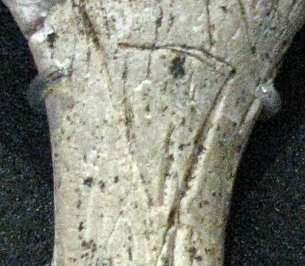
Note that the bâton percé above has a vulva of the type typical of the Magdalenian period carved upon it.
Photo: Don Hitchcock 2014
Source: Original, Le Musée National de Préhistoire, Les Eyzies-de-Tayac
This bâton percé, shown as no. 1 and no. 2 in fig. 38 above, has two slightly raised horse heads carved into the baton, facing to the left. The jaw is accentuated on the leftmost, larger of the two, and the mouth, nostril, eye, ear, and mane are indicated.
Photo: Don Hitchcock 2014
Source: Original, Le Musée National de Préhistoire, Les Eyzies-de-Tayac
This is the other face of the broken propulseur shown as no. 14, Fig. 38.
Photo: Don Hitchcock 2014
Source: Original, Le Musée National de Préhistoire, Les Eyzies-de-Tayac
Fig. 39
Various objects in reindeer antler and stone
The bâton percé (fig. 39, no. 1) is decorated on this side with a line point, five oblique gouge strokes follow one of the branches and are continued by a sinuous longitudinal groove. The other side shows a faint antelope head (Fig. 39, no. 2) with a well marked horn and ear and, below, a line point with one sided barbs (Fig. 39, no. 3). No. 8, Fig. 39, could be a phallus, unless it was a kind of wineskin stopper, the strangulation serving to bind the skin tightly to the object for a hermetic closure.
Photo and text: Capitan et Peyrony (1928)

No. 8, Fig. 39, as above, is a phallus carved from reindeer antler - Upper Magdalenian, from la Madeleine.
Photo: Don Hitchcock 2008
Source: Original, Le Musée National de Préhistoire, Les Eyzies-de-Tayac
Phallus, as above, fortuitously showing the other side.
Carved in the round of reindeer antler, on loan from Les Eyzies-de-Tayac, musée national de Préhistoire, and shown above as no. 8, Fig. 39.
Label:
Bois de renne sculpté en ronde bosse, La Madeleine, Fouilles Capitan et Peyrony
Les Eyzies-de-Tayac, musée national de Préhistoire, MNP 1928-7-15
Photo: Don Hitchcock 2014
Source: Musée d’art et d’archéologie du Périgord, Périgueux
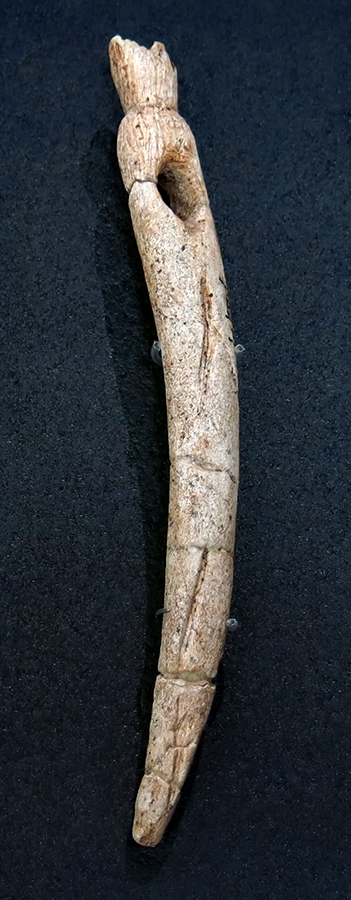
This is the bâton percé shown on fig. 39, labelled no. 1.
Photo: Don Hitchcock 2014
Source: Original, Le Musée National de Préhistoire, Les Eyzies-de-Tayac
Fig. 40
Fragments of baguettes demi-rondes, variously decorated.
A series of baguette demi-ronde fragments are decorated with more or less realistic drawings. On the narrowed and thinned base of no. 1, fig. 40, we see several oblique chisel strokes and, at the other end, a strange head: the perfectly rendered eye, the pointed snout and the upper jaw armed with sharp teeth make us think of a pike or a shark; the back of the head is a bit fanciful; however, the drawing is very neat.
No. 2, fig. 40, is a real puzzle: on the right, a beautiful brown bear head, licking the glans of a phallus that appears to be erect, flanked by two testicles, followed by a female pelvis: belly and vulva half open and very detailed; the dots and fine striations probably represent the hair system.
On no. 3, fig. 40, an antelope's head occupies the right extremity; the two horns are derived from each side of the stick behind the ear, which is very well rendered; the ornamentation is continued by two parallel series of small transverse gouge strokes. No. 4, fig. 40, is an enlargement of the head.
The decoration of no. 5, fig. 40, proceeds from the previous one; the two deep curved and parallel grooves simulate another antelope head, and the sinuous lines which continue them, the two horns treated and arranged like those we have just described. A double row of chisel strokes curved in the same direction extends to the broken end.
No. 6 is the right-hand side of No. 5 enlarged. A series of eyes surmounted by arcs in the style of antelope horns, six punctuation marks and two parallel rows of chisel strokes on the right-hand end make up the whole of no. 7, fig. 40.
No. 8, fig. 40, is reminiscent of the left-hand drawing in no. 2, fig. 40. A series of three stylised bovid heads with the indicated hair system, or perhaps fish tails with scales, decorate the lower part of no. 9, fig. 40; while on the other, a series of very simplified and very small transverse engravings appear to be horse heads. This is best seen by turning the figure upside down; a long longitudinal groove and transverse striations complete the decoration.
No. 10, fig. 40, is rather enigmatic, falling within the framework of the previous ones, but could also represent a fish. Finally, eyes and horns symmetrically arranged in pairs on stick no. 11, fig. 40, are bovid heads reduced to their essential parts.
The representation of antelope horns (Fig. 40, nos. 3, 4, 5, 6) suggested the decoration of harpoon no. 3, Fig. 41, completed by transverse strokes in front of the arcs of the circle and on the base of the object, and oblique strokes between the basilar bulge and the lowest horn. Placing the two wavy lines and the strong oblique lines at the base of each of them side by side produces a drawing identical to nos. 5 and 6, Fig. 40. In other words, each corrugation and the base groove form half of a highly stylised antelope head.
Photo and text: Capitan et Peyrony (1928)
The photograph above of the drawing No. 2, fig. 40 above, shows, on the right, a beautiful brown bear head, licking the glans of a phallus that appears to be erect, flanked by two testicles, followed by a female pelvis: belly and vulva half open and very detailed; the dots and fine striations probably represent the hair system.
Photo: Don Hitchcock 2008
Source: Original, Le Musée National de Préhistoire, Les Eyzies-de-Tayac
Figure 41
Objects in bone and reindeer antler, variously decorated
Are the pectiform signs seen on no. 4, fig. 41, not derivatives of the line point, no. 3, fig. 39, of the command staff no. 1 or of the engravings of nos. 10 and 12, fig. 31? Or should they be compared to the alphabetiform signs of no. 1, fig. 33? Oblique lines are arranged on various points all around this piece.
Harpoon no. 1, fig. 41, is decorated with short, oblique lines placed in different ways. At the top, they appear to represent the body of a mammal, with the line of the back and the two ears and two horns pointing forward.
A piece of the same kind, no. 6, fig. 41, has long, deep, straight and curved incisions all around it, and some transverse lines. A fragment of a reindeer antler lissoir (no. 12, fig. 41) has a design composed of diverging oblique stripes that may represent line points. Finally, the decoration of the three pieces (Fig. 41, nos. 5, 10 and 11) seems to derive from a snake figure.
On harpoon fragment no. 5, two parallel wavy lines ending on one side in a sort of open-mouthed head can only be attributed to an ophidian. The base shows part of an identical design. On the fragment of assegai no. 10, a snake is clearly visible, with a sinuous body and a large head, while another, no. 11, bears a sinuous line that appears to be a stylisation of the previous engraving.
A piece of reindeer antler forming part of a larger tool or weapon bears two symmetrically opposed rows of small reliefs (Fig. 41, nos. 8 and 9). The stick fragment No. 7, Fig. 41, has two broad longitudinal flutes and transverse gouge marks; it fits into the framework of No. 2, Fig. 42.
The representation of antelope horns (Fig. 40, nos. 3, 4, 5, 6) suggested the decoration of harpoon no. 3, Fig. 41, completed by transverse lines in front of the arcs of the circle and on the base of the object, and oblique lines between the basilar bulge and the lowest horn. Placing the two wavy lines and the strong oblique lines at the base of each of them side by side gives a design identical to Nos. 5 and 6, Fig. 40. In other words, each corrugation and the base groove form half of a highly stylised antelope head.
On No. 2, Fig. 41, the arcs of the circle have the same meaning of a highly stylised antelope head, but here there is no longer any detail that might make us suspect their origin, if we did not have before our eyes the progressive simplification of the primitive motif; two series of transverse strokes as on the previous harpoon, rows of striations and scalariform signs, one of which is very clear, still adorn this object.
Alphabetiform signs? - On a harpoon with broken barbs (fig. 41, no. 4) there is a series of six signs similar to our capital E, regularly spaced. We wonder whether they are of the same nature as those of Fig. 33, no. 1 of the lower layer, or whether they should be seen as a pectiforme decoration deriving from the ornamentation of highly stylised barbed arrows similar to nos. 10 and 12, Fig. 31.
Photo and text: Capitan et Peyrony (1928)
Fig. 42
Objects in bone and reindeer antler, variously decorated
Jewellery - The ornaments consist of pierced stones, teeth and shells, colouring materials and an oblong amulet (Fig. 42, No. 1) made of bone. One end is broken off, the other has a hole for hanging. It is decorated on one side with a long median groove.
The various engravings in no. 3, fig. 42, together give an animal head: the two longitudinal curved lines at the bottom, the snout; higher up, the transverse lines arranged in pairs on each side of the object, the eyes; finally, the two longitudinal series of dots, the horns. No. 4, Fig. 42, placed next to it, is a figure of the same kind, but even more stylised, with a series of burin strokes variously placed on the upper part.
The various engravings of no. 3, fig. 42, together give an animal head: the two longitudinal curved lines at the bottom, the snout; higher up, the transverse lines arranged in pairs on each side of the object, the eyes; finally, the two longitudinal series of dots, the horns.
No. 4, Fig. 42, placed next to it, is a figure of the same kind, but even more stylised, with a series of burin strokes variously placed on the upper part.
No. 8, Fig. 42, is part of a spear head. On the right we see the eye, forehead and two horns of a caprid, and on the left the remains of a similar engraving.
The decoration of amulet no. 1, fig. 42, seems to be similar to that of harpoons nos. 2 and 3, fig. 41, derived from the stylisation of antelope horns.
The reliefs of the fragments of rod No. 9, Fig. 42, are similarly derived from the previous one.
The series of quadrilaterals in No. 7, Fig. 42, could well be a representation of a saiga antelope horn; there would be the ear on the right.
No. 10, fig. 42, is a bizarre ensemble: three highly stylised figures following each other in an Indian line are attached and linked together by lanyards.
No. 12, fig. 42, is a fragment of a baguette demi-ronde with a longitudinal relief whose two sides are each finished with a recurring point and, on the fields, oblique grooves crossing each other.
Finally, nos. 5 and 6, fig. 42, are the two faces of a flattened reindeer antler stick with deep incisions on one edge almost forming barbs and oblique stripes on the flat side.
Photo and text: Capitan et Peyrony (1928)
Fig. 43
Human remains. - We collected a fragment of a human skull cap from an adult subject (fig. 43); it is slightly oval and the edges seem to have been regularised, as if it had been intended to be a container. Could it be a cup? Would these peoples have already taken great pleasure in drinking from the skulls of their enemies?
Photo and text: Capitan et Peyrony (1928)
Fauna
Mammals
Bear which appears to be Ursus arctos: a second lower rear molar (length 27 mm).
Wolf: mandibles and canines of fairly large specimens. (length of carnassial tooth 27 mm.). A fifth metacarpal of a huge specimen.
Ordinary fox.
Lynx: a first (proximal) phalange is most probably from a lynx.
Horse: of ordinary size: remains from at least two individuals.
Small equid: one molar.
Sus (wild boar or pig): a lower tusk.
Large bovid: a few remains.
Reindeer: numerous bones (of adults, and several milk teeth).
Chamois: horns and other remains.
Hare, large: a few remains.
Marmot: lower incisor.
Birds - Corvus corax - ordinary crow.
Pica rustica? - Magpie ?
Lagopus mutus - Rock ptarmigan.
Observation: it should be noted that the horse bones, so abundant in the previous level, are becoming rarer and reindeer bones predominate over all others.
Comparison
The middle layer of La Madeleine is characterised by harpoons with very long unilateral barbs, tridents with long branches, numerous double-bevelled spear points, baguettes demi-rondes that are almost always ornamented, less massive than those of the lower layer.
Sculpture in the round had almost entirely disappeared, but there were still some bas-reliefs.
Stylised art, which had begun during the previous phase, developed more and more and took a greater place than realistic art in the decoration of portable objects.
This level corresponds, from the point of view of fauna, to the Tarandian (age of the reindeer) of Piette . It has its equivalent in Lorthet, where it is found in a very small area. It has its equivalent at Lorthet/Lortet, Gourdan, Arudy and Mas d'Azil, les Combarelles cave , l'abri Mège, la grotte de la Mairie à Teyjat, Laugerie-Basse, and Raymonden. At Marseilles, it is so thin that it could not be distinguished from the one above.
III. Upper Layer
The upper layer was very brown, composed of earth and numerous large and small calcareous elements; There were no traces of flooding as in the previous ones; it was very irregular; while at some points it was barely 50 cm thick, in others, it exceeded 150 cm. It was especially noticeable in the west, in front, where it formed a strong lens; in the centre, in the deepest part of the shelter, where it was the centre, in the deepest part of the shelter, where it occupied the whole basin; and to the East, where it reached 150 cm.
We were only able to study the upper layer completely on the eastern side where the occupation of this level continued until the very end. Elsewhere, the upper part did not seem to exist or had disappeared.
Lithic Industry
The whole of the stone industry is more or less the same as that of the other layers; only the proportion of some types differ.
Scrapers on the end of the blade are more abundant, as are the straight cut burins compared to the angled burins.
Fig. 44
Different types of parrot beak burins
Parrot beaks are numerous and varied. Some have a kind of handle produced by cutting off the side edges of the base (Fig. 44, nos. 1, 2),
Some are double, with both beaks turned in the same direction (Fig. 44, no. 6) or with one turned in one direction and one in the other or one turned in one direction and the other in the opposite direction (fig. 44, no. 3); those at the base (fig. 44, nos. 1, 2, 3, 6) are larger than those at the top (fig. 44, nos. 4, 5, 7).
Photo and text: Capitan et Peyrony (1928)
Fig. 45
Pointes à face plan, atypical pointes à cran, and pointes à soie
Atypical tanged points (pointes à cran are abundant (44) ( i.e. 44 examples? - Don ) (fig. 45, nos. 2, 3, 5, 6, 7, 8); abrupt retouches form the notch and regularise the edge, but there are no Solutrean retouches; there is also a pointe à face plan, a flat-faced point (fig. 45, no. 1, with the flat face not shown) and a few pedunculate spear heads (pointes à soie).
Photo and text: Capitan et Peyrony (1928)
Fig. 46
Axes, cutters, pick and gouge
The pics (Fig. 46, no. 5) are generally quite neat.
( Pics or picks are a large tool used to dig holes or cupules in wood or stone. They usually have a strong heel which is generally continued by a point in the shape of a triangular pyramid (fig. 12, nos. 1 and 2); they have some resemblance with Acheulean handaxes. - Don )
Two well-cut (on both sides) 'coups de poing', heart shaped handaxes, (Fig. 46, nos. 1, 2) have been collected; the heel of one of them still has its cortex (Fig. 46, no. 2).
Two pieces are a kind of cutter: one with a natural handle and convex opposite end (Fig. 46, no. 4), the other, slightly curved, with a handle narrowed by lateral retouching, and with a straight, sharp truncation (Fig. 46, no. 3). Nos 6 and 7, fig. 46, represent a kind of gouge seen on both sides.
Photo and text: Capitan et Peyrony (1928)
Fig. 47
Large blades
Large, highly retouched blades are quite rare, but of good dimensions (fig. 47, nos. 1, 2, 3, 4).
No. 1 comes from the second half of the upper layer. The left edge is partly cut and polished; the back must have been rubbed for a long time on sandstone in order to blunt the sharp edges left by knapping.
No. 4 is a rough blade.
Photo and text: Capitan et Peyrony (1928)
Fig. 48
Small points with curved backs from the upper part of the layer
In the upper part of the layer we collected a series of short points, broad in comparison with their length, sometimes with a rough heel (Fig. 48, nos. 1, 2, 3, 4, 5, 6, 7), sometimes with a retouched heel (Fig. 48, nos. 8, 9, 10, 11), sometimes pointed at both ends (Fig. 48, no. 12). They are reminiscent in form, but smaller, of the points of the Châtelperronian.
They are the prototypes of the small, identical pieces found a little later in the Azilian; they are found only accidentally in other parts of the deposit. The upper layer of the prehistoric deposit of the Château des Eyzies provided a certain number of them.
Photo and text: Capitan et Peyrony (1928)
Fig. 49
Polisher in soft sandstone
Small sandstone polishers, with needles, awls, etc, are more numerous than in the other levels; each of them presents grooves in all directions produced by the tool that has been rubbed there (Fig. 49).
Photo and text: Capitan et Peyrony (1928)
Fig. 50
Prehistoric lamps
Lamps are more numerous than in the other levels; there are many natural ones, but most often they are carved out either in limestone (fig. 50, nos 1 and 2), or from quartz pebbles. All have obvious traces of fire and a black residue in the bottom of the socket. Some have engravings. On one side of no. 1, fig. 50, there are a few lines but it was impossible for us to decipher the drawing.
Photo and text: Capitan et Peyrony (1928)
An identical piece to the lamps above shown here, broken in two, coming from the talus slope, bears on the back two hindquarters of animals (Plate XII, no. 2); it is reminiscent of the ornate lamp in the cave of La Mouthe.
Photo and text: Capitan et Peyrony (1928)
Observation. - It is interesting to note that during the Magdalenian period the main Palaeolithic forms reappear: awls (fig. 18, nos. 3,4 and fig. 46, nos. 1, 2), triangular points (fig. 17, no 2), scrapers (fig. 17, no. 3 and fig. 34, no. 1), backed points, Châtelperronian type (fig. 48) and La Gravette type (fig. 14, no. 1), point with flat face (fig. 45, no. 1), tanged points (fig. 14, no. 9 and 45, no. 4), shouldered points (fig. 42, nos. 7, 8, 9 and fig 45, Nos. 2, 3, 5, 6, 7, 8).
Bone, ivory, and reindeer antler industry
Fig. 51
Harpoons with a double row of barbs, from the Upper Magdalenian
Harpoons generally have a double row of barbs. Those found at the base (fig. 51, nos. 14, 15; 16, 17, 18, 19, 20, 21) have the tips slightly apart from the shaft; while those collected above (fig. 51, nos. 1, 2, 3, 4, 5, 6, 7, 12) have their shafts more elongated; we picked up two fragments of curves (fig. 51, no. 1); No. 19, fig. 51, comes from the base of the large basin where a part of the upper layer rested directly on the natural ground.
Often, the barbs are carved with one or more longitudinal grooves allowing the blood of the harpooned animal to flow. Sometimes the shaft presents them also arranged in various ways (fig. 51, nos. 1, 2, 3, 6, 10, 13, 19).
Photo and text: Capitan et Peyrony (1928)
Fig. 52
Objects in bone and reindeer antler, and jewellery
Spear heads - The spearpoints ordinarily have a base
with a double bevel (fig. 52, nos. 1, 2, 8), though a few have a short, pointed base (fig. 52, no. 3).
There are a lissoir at fig. 52, no. 4 (fourth from the top left), awls, fig. 52, nos. 5, 6, 18, and a decorated chisel, fig. 52, no. 7.
There are hooks ( lit. hameçons ) at fig. 52, nos 19 and 20, needles of all sizes at fig. 52, nos. 10, 15, 16 and 17, drilled teeth at fig. 52, nos. 9 and 13, various shells at fig. 52, nos. 12, 21 and 22, a humerus head at fig. 52, n° 23, and a stone at fig. 52, no. 14, also pierced. ( The drilled object no. 24 may be a shell - Don )
Attention is called to a small bone point (fig. 52, no. 11) resembling flint arrowheads with wings and a concave base, so frequent in the Neolithic of North Africa.
At the Périgueux museum, there is an identical one in the Soucy ( or Souci - Don ) series; ( this, and the one mentioned above at fig. 52, no. 11 from la Madeleine is a foène, the point of a fish harpoon, see below at A - Don ) and another whole, and two fragments in that of Raymonden. M. Féaux owns the whole of this last deposit. ( Raymonden was discovered in 1874 by M. Féaux - Don )
In the series of Raymonden, in the museum of Périgueux, there is one with fins and a bone peduncle, which is of the same size as the preceding ones.
( see below at B - Don )
It resembles the flint points of our Robenhausian ( of or relating to a stage of Neolithic culture characterised by lake dwellings, polished stone tools, agriculture, weaving, and domestic animals - Don ).
They appear to be derivatives of the split-based points whose head would have been very shortened and the lips spread apart.
( I have added numbers to Fig. 52 above in order to aid interpretation. The original image may be accessed as always by clicking on the image, when the full size (unnumbered in this case) image will appear - Don )
Photo and text: Capitan et Peyrony (1928)

A This is the foène from Souci displayed at the Périgueux Museum, referred to in the caption to Figure 52 above.
Photo: Don Hitchcock 2014
Source: Original, Musée d’art et d’archéologie du Périgord, Périgueux
B This is the foène from Raymonden displayed at the Périgueux Museum, referred to in the caption to Figure 52 above, described as having fins and a bone peduncle.
The museum card reads 'Catalogue série A, 1905'
Photo: Don Hitchcock 2014
Source: Original, Musée d’art et d’archéologie du Périgord, Périgueux
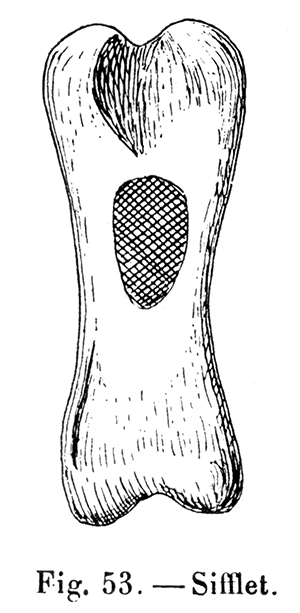
Fig. 53
Whistle
In all sites of the Upper Palaeolithic, one frequently encounters phalanxes of reindeer or cervids pierced with a round hole. Often this orifice is made naturally under the weight of the materials, the bone material being very thin at this place; in this case, the edges are jagged. Sometimes it is the product of intentional work as in fig. 53.
The internal face of the phalanx was previously scraped to reduce its thickness, then an oblong hole was drilled and its edges rounded. This instrument must have been used to produce sounds intended to call comrades from afar or to imitate the cry of certain animals. It is, without doubt, the first musical instrument.
Photo and text: Capitan et Peyrony (1928)
Fig. 54
Pieces in bone and reindeer antler variously decorated
Works of Art
There are only very rare examples of sculpture in the round, but bas-reliefs and engravings are numerous.
Sculptures - A fragment of reindeer antler, roughly worked, vaguely resembles an animal's head. One of the extremities of a piece of a primitive harpoon is carved as the head of a reptile.
Fig. 54 No. 12, represents the object seen from the front; No. 13, seen below; Nos. 10 and 11, in profile. The different parts are well studied and rendered. Does this piece really belong at this level? The rudimentary barbs leave us perplexed on this subject, because they characterise the lower course.
Two hypotheses arise: either the Upper Magdalenians found the piece ready-made and used it; or they simply made the harpoon and carved it.
Bas-reliefs. - Horses in bas-relief decorating the pieces are of a particular character; they are disproportionate: the head is huge compared to the body. Those we met were almost all on the faces of chisels.
Nos. 14 and 15, fig. 54, are the two opposite sides of the same piece; the same applies to nos. 8 and 9, fig. 54. The extension (fig. 54, no. 7) also bears a horse with a strongly pronounced mane, a small and elongated head contrasting with the preceding ones. Two highly incised but fairly proportioned equines decorate the two lateral faces of the chisel, nos. 16 and 17, fig. 54.
Animal engravings - On a fragment of bâton percé, we notice two reindeer nose to nose, the forequarters of one which is galloping and the whole body of the other which is leaping (fig. 54, no.19).
There are no details: quick outlines and that's it; but the pace and movement have been faithfully rendered.
No. 11, fig. 54, ( no. 18, fig. 54? ) is a sketch of a reindeer on a rib fragment.
A fragment of a bâton percé shows the slight profile of an equine head with a little mane (fig. 54, no. 1). On the other side are two parallel longitudinal dotted lines (fig. 54, no. 2).
On one of the sides of a chisel (fig. 54, no. 3) are finely engraved two antelopes, probably saigas, very recognisable by their horns, turned in opposite directions. On the other side, the profile of an unfinished animal, in slight relief (fig. 54, no. 4).
We draw particular attention to a cylindrical piece in reindeer antler (fig. 61, no. 4) ( fig. 54 nos 6 and 7? - Don ) which has one extremity cut in a double bevel like the base of a spear point with oblique and parallel furrows on the bevel to facilitate the fitting, the other end is bifid with a deep cleft or fork like those of shuttles; but it is not a shuttle since only one end is forked.
What then could be the purpose of this object? Was it used as an extension for a double-beveled base of a spear point?.
Other pieces - The rest of the industry includes bâtons percés (fig. 61, nos. 1, 2, 3, 4, 5, 6, 7, 8, 9) variously decorated, daggers, some of which are made of fragments of bâtons percés (fig. 61, no. 10).
The first excavators at La Madeleine, Lartet and Christy, collected identical bas-reliefs either on chisels ( Lartet and Christy (1875), B.pl. X, nos. 1, 4 ) ( B.pl. X, nos. 1, 5? ), or on bâtons percés (Lartet and Christy (1875), B. pl. III and IV, n ° 1, VII and VIII, nos. 1, 6-a, 6b, 6-c, XXIV, no. 7, XXX and XXXI, nos. 2 and 4 of the Reliquiae Aquitanicae).
The site of Soucy ( Souci ) gave a certain number of the same style appearing in the museum of Périgueux. Finally, some Pyrenean drawings from the Piette collection can be compared to those from Périgord.
Photo and text: Capitan et Peyrony (1928)
Fig. 55
Head of a reindeer on a piece of schist
No. 2, fig. 55 is a smooth-surfaced piece of schist showing the dorsal line, both ears, and part of the antlers spread out, of a reindeer. One animal rib is adorned with a beautiful reindeer's head admirably treated (fig. 55, no. 1);
The tongue hangs sideways, the antlers and ear elongated behind, the various hairy parts well indicated. It is one of the most successful designs; so the artist signed his work by placing a small sign beside it, identical to those noted on nos. 4 and 5, fig. 33, lower layer.
Photo and text: Capitan et Peyrony (1928)
Fig. 56
Chisels variously decorated
No. 1, fig. 56, is a chisel decorated laterally with dash points, the sharp part of which is directed towards the longitudinal center line of the piece where there is the long head with two ears hanging laterally, the two horns starting on each side of the nape of the neck, the neck and back, of a beast that can only be attributed to a deer.
This drawing seems to relate to a scene of bewitchment. The decoration of No. 2, fig. 56, although approaching the series of acute angles of the previous one, would perhaps be more related to a kind of primitive writing. It is completed on the field of this piece by a row of quadrangular tubercles.
Drawings of stylised animals and others - Nos. 4, 5 and 6, fig. 56, are the two sides and edge of the same piece broken at both ends. On no. 6, we see a wide longitudinal rib with a regular series of hollow points; below a very stylised animal, seen from the front, globular body, front legs and horns or ears represented by parallel lines, crossed lengthwise by a scalariform sign; the decoration continues at the bottom with five hollow points.
The drawing of no. 4 is almost identical; the top dots are replaced by oblique lines forming with the longitudinal furrows a scalariform sign. The more angular body is divided into four by two lines counting in X. A hollow point is in the center of the two lower squares. A series of six points completes the ornamentation of this face. No. 5 is on the field of the same room. It is a sort of ladder approaching that of No. 4, but with broken rungs.
Photo and text: Capitan et Peyrony (1928)
Fig. 57
Objects decorated with designs deriving from fish
With No. 3, fig. 57, we begin the description of drawings all proceeding from that of a fish. Here the figure is very recognisable: the body is well formed, the eye, the mouth, the anal and caudal fins well indicated; the pectiform sign seems to represent the vertebral column furnished with ridges.
No. 4, fig. 57, is the slightly degraded opposite face. With a little more stylisation, we arrive at no. 1, fig. 57, then at no. 2, which is increasingly deviating from reality, then at nos. 7, 8 and 12, fig. 57; we continue the series with nos. 13 and 14, fig. 57; we pass to nos. 5 and 6, fig. 57, leading to nos. 9 and 10, fig. 57 that we could not interpret if we did not have the various stages before our eyes. Decorations nos. 1 and 2, fig. 58, also fall within the same framework.
Photo and text: Capitan et Peyrony (1928)
Fig. 58
Various objects decorated with stylised fishes
As for the engravings of no. 3, Fig. 58, they again represent fish seen from the front with the two rows of bones well rendered. They explain the decoration of no. 11, fig. 57. Nos. 4 and 9, fig. 58, are still fish reduced to their essential outlines.
Following an even more pronounced stylisation, we arrive at nos. 5, 6 and 8, fig. 58, ending at no. 7, fig. 58.
Photo and text: Capitan et Peyrony (1928)
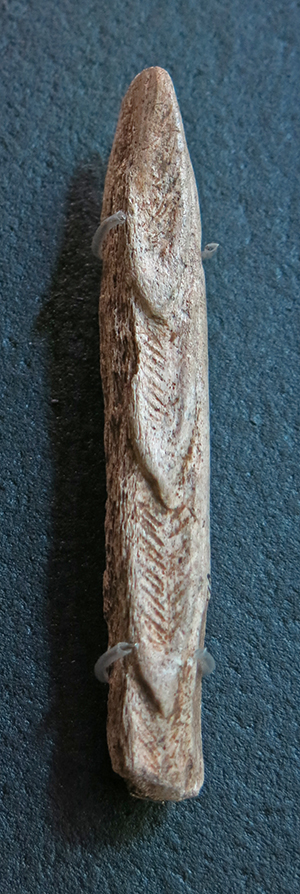
Photo of fig. 58 no. 3 above, stylisation of fish.
Photo: Don Hitchcock 2014
Source: Original, Le Musée National de Préhistoire, Les Eyzies-de-Tayac
Fig. 59
Variously decorated objects in bone and reindeer antler
On a chisel fragment (fig. 59, no. 2) there is a bird with a stylised body and a very sharply defined head. The figure on the opposite face (no. 1) seems to be an even more accentuated stylisation of the previous one with transverse lines: on the globular part. It leads to decoration nos. 3 and 4, fig. 59.
That of nos. 5 and 6, fig. 59, appears to be of the same nature, but unfinished. A reindeer antler base bears the two designs nos. 11 and 12, fig. 59, which appear to be highly stylised bison heads. Nos. 7, 8 and 9, fig. 59, proceed from the same decorative motif. No. 10, fig. 59, could also derive from it as, too, it would seem to approach the series of fish images.
Photo and text: Capitan et Peyrony (1928)
Fig. 60
Objects in bone and reindeer antler variously decorated
Harpoon No. 1, fig. 60, bears a decoration in arcs of a circle probably derived from nos. 11 and 12, fig. 59. On a chisel there are two serpentiform parallel lines (fig. 60, no. 2) and, on the opposite side, an almost identical decoration with broken curves (fig. 60, no. 3). The various elements of the three motifs described (fig. 60) appear combined in no. 13, fig. 60, and also in No. 12, fig. 60, where longitudinal furrows replace curves.
No. 10, fig. 60, is strongly related to No. 3, fig. 60. No. 7, fig. 60, seems to be related to the scalariform signs and perhaps also to representations of fish.
The fragment of reindeer antler (fig. 60, no. 4) bears a schematic head with diverging parallel oblique lines, and a rounded assegai base two similar drawings (fig. 60, nos 8 and 9) which may relate to a sketch rapid of animal head which could be placed next to no. 14, fig. 60; in the latter the transverse furrow simulates the mouth, the two slightly arched longitudinal ones, the horns and the lateral oblique ones the ears and large hairs.
Nos. 5 and 6, fig. 60, are the two faces of the same piece whose ornamentation resembles no. 11, fig. 60. Fig. 60, no. 15, is difficult to interpret; No. 16, fig. 60, can take place in the series of nos. 3 and 13, fig. 60 and no. 17, fig. 60, in that of no. 2, fig. 60.
As for nos. 18, 19 and 20, fig. 60, these are points of lines of the same kind as those of no. 13, fig. 19; no. 1, fig. 20; nos. 6 and 9, fig. 31.
Photo and text: Capitan et Peyrony (1928)
Figure 61
Bâtons percés with various decorations
These Bâtons percés and fragments of Bâtons percés were collected from the upper half of the layer.
The two sides of one of them (nos. 1a and 1b) bear the same designs which appear to be stylisations of heads; those surrounding the hole, to bovid head stylisations, the three following and interlocking designs seem to refer to antelope horns.
A second presents on one of its faces (no. 4b) a triangular relief surrounding the hole on three sides. A heavily incised equine continues the decoration; it is of the same style as those of nos. 7, 16 and 17, fig. 54. A wide longitudinal 'rib' follows it to the lower end. On the face of no. 4a a diamond shape and two other reliefs of the same nature stand out, but these appear to represent only half of the first shape. All three are affected by transverse 'chewing'.
The first can be compared to no. 4, fig. 58, and the two others from no. 3, fig. 58 (stylisation of fish). A fragment of a bâton percé has its base pointed (no. 10); it appears to have been used as a dagger. Its decoration includes designs in high and low relief, some lozenge-shaped (a, b, c), others oval (d); a fifth has the shape of a lizard, its oblique lines occupying the thinned base.
No. 2 is furrowed with oblique transverse lines. The almost triangular engraving of no. 8, with seven incisions across, forms a stylised animal head ending in a more accentuated deformation at no. 3. Nos. 5, 6, 7, 9a and 9b seem to derive from the same type of ideas.
Photo and text: Capitan et Peyrony (1928)
Fauna
Mammals
Wolf: a canine. A first phalange.
Canis, the size of an average dog: a lower carnassial (length 22 mm). This tooth has no trace of the inner lateral tip of the second lobe. I have only noticed this particularity in two of the Canid carnassials in my collection: that (of the same size) of a Canis mandible from the cave of La Tourasse (Haute-Garonne), a prehistoric station of transition from the Quaternary to the present times, and, to a lesser degree, perhaps, that of a mandible of a very small modern dog.
Ordinary fox
Horse, ordinary size: remains of at least three individuals.
Small equine: one molar.
Sus (boar or pig): a mandible.
Large bovid: remains from at least four individuals.
Reindeer, variable in size: bones from more than 30 individuals (31 adult right astragalus or thereabouts and a few remains of juveniles).
Red deer: one mandible.
Chamois? : some remains.
Hare, large: some remains.
Rabbit: a few remains, including an adult humerus (length 62 mm).
Lagomys pusillas, which currently lives in the steppes of Russian Asia: a mandible.
Top of the top layer
Wolf: a molar.
Horse: very few remains.
Sus (boar or pig): several examples.
Large bovid: very few remains.
Reindeer: very few remains.
Red deer: several examples.
Top layer - Birds
Jackdaw: Corvus monedula
Rock Ptarmigan: Lagopus mutus
Eurasian Eagle-Owl: Bubo ignavus / Bubo bubo
Comparisons
This level is especially characterised by harpoons with double rows of barbs very detached from the shaft, the absence of baguettes demi-rondes, so numerous in the previous one, the abundance of chisels, many of which are decorated laterally, parrot's beaks, atypical shoulder, and, at the top, small points with an arched back, in flint, which seem to be the prototypes of the small Azilian blades.
There are also bas-reliefs, but a little simplified; the proportions between the various parts of the body of animals are no longer so well observed as in the other layers.
The art of stylisation reached its apogee from the first half of this period; we feel its decadence from the beginning of the second.
This layer is the same as the top of the cave of la Mairie à Teyjat; it once existed in the Laugerie-Basse site; in Marseilles it is not distinguishable from the previous one because of their thinness; it is found at Soucy (Souci), at Raymonden.
The layer was also in Gourdan, Arudy (Lourdes), Lorthet, and Mas d'Azil. It corresponds as an industry to the Lorthetian of Piette and, as a fauna, to his Elapho-Tarandian.
Figure 63
Spear points and an engraved amulet from the collection of Capitan
( There is no Figure 62 in the monograph, and Figure 62 is not referenced in the text - Don )
Objects of art from the collection of Dr. Capitan - Of the many Magdalenian pieces in Dr. Capitan's collection, several are ornate, all from the upper level.
First of all there is a large spear point (fig. 63, no. 3) bearing on one side two sinuous lines - appearing to represent a snake which can be compared to nos. 5, 10, 11, fig. 41, and nos. 6 and 17, fig. 60.
Another spear point (fig. 63, no. 2) with, on one side , numerous lines and two stylised heads and, on the other (fig. 63, no. 1), a series of lines in the middle of which we seem to distinguish spreading horns.
An amulet (fig. 63, no. 4), broken at both ends, is on one side at the height of the hole (?). It is made up of a blade of bone decorated, on one side, with a bison with stiff outlines from which part of the head is missing, preceded by another without a head and whose hindquarters are not represented. This piece is in character with those found in the upper layer.
Photo and text: Capitan et Peyrony (1928)
Figure 64
Chisels in bone and reindeer antler variously decorated
Nos. 1, 2, 3, fig. 64, are the three decorated sides of the same chisel. Nos. 2 and 3 seem to represent a very stylised quadruped, or rather a fish; it is comparable to nos. 7, 8 and 12, fig. 57.
No. 4, fig. 64, carries a series of three acute angles, probably line points.
Nos. 5, 6, 7, fig. 64, are also the three decorated faces of another chisel. There are deep incisions forming a series of Ts on the face and arranged in another way on the back.
Nos. 8, 9, 10, fig. 64, are also the three decorated faces of a third chisel. The side drawings arranged symmetrically two by two can be classified with those of nos. 1, 2, 3, 4, fig. 57. They are more and more stylised fish.
No. 10, fig. 64, gives us the arrangement of these drawings.
No. 11, fig. 64, is a fragment of a spear point with lateral ovals. Nos. 12 and 13, fig. 64, are two sides of the same piece. They each carry a series of designs which, as well as those of the previous object, are also derivatives of the fish approaching nos. 5,6,7,8,9, fig.58.
Photo and text: Capitan et Peyrony (1928)
Excavations of the rubble
While emptying the shelter of the spoil of the old diggers, we carefully examined all that was extracted. This work has provided us with many flint tools and fragments of bone pieces, identical to those we already know from the previous descriptions.
We collected many lamps in limestone and quartz rocks (fig. 50, nos. 1 and 2), colour grinders (mortars and pestles) (fig. 65, no. 1), an entire palette (fig. 65, no. 2) and several fragments of others in schistose rocks, whose two faces are entirely covered with ochre, two small engraved limestone pebbles (fig. 66, nos 1, 2, 3).
Nos 1 and 2 are the two faces of the same piece, adorned with parallel lines variously arranged; no. 3 has only one side drawn. It is identical to nos. 2a, 2b, A, pl. XXIX of the Reliquiae Aquitanicae from the cave of Les Eyzies.
These objects may be similar to those found by Piette in the level with coloured pebbles of the Mas d'Azil, also decorated with engraved lines. All these pieces are very interesting; but those which gave us the greatest satisfaction are the many ornate stones which lay deep within the shelter.
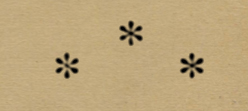
At the beginning of this memoir, we said, that behind, in the deepest part, we had found a cella ( or naos, like an inner temple - Don ) almost underground, the base of which was formed by the floor of the shelter, the back by the cliff, the front by a limestone block separating it from the two lower layers and finally, the sides, by two large isolated limestone blocks (see fig. 3).
If at that distant time they were connected to the rest of the enclosure by a blockage, this disappeared during the Lartet and Christy excavations.
This kind of chamber was originally filled with deposits from the upper level, as evidenced by an intact strip of the layer found on the bedrock (harpoon no. 19, fig. 51 comes from it).
The rubble that lined it therefore belonged to the upper level and the engravings collected must be attributed to it. We will briefly describe each of them:
Figure 65
Mortar and Pestle
Above, colour grinder (mortar and pestle) and pieces of various colours.
Below, schist palette whose two sides are covered with red ochre.
Photo and text: Capitan et Peyrony (1928)
Figure 66
Engraved limestone pebbles
Photo and text: Capitan et Peyrony (1928)
Image of number 3 of the engraved limestone pebbles.
Photo: Don Hitchcock 2008
Source: Original, Le Musée National de Préhistoire, Les Eyzies-de-Tayac
( note that most if not all of the photographs from Capitan et Peyrony (1928) below had been enhanced in the original monograph by the addition of a tracing in black of the engravings - Don )
Plate II
Reindeer and Fawn
A large limestone slab, 75 cm x 41 cm, smoothly surfaced and fine grained bearing a superb engraving of a walking female reindeer, with her galloping fawn alongside. Turned upside down, another reindeer less beautiful and less deeply engraved may be seen.
The head of the first beast is accurately rendered and strikingly truthful. Gait and movement seem to have been one of the artist's main preoccupations. So he managed to render them almost flawlessly. This piece is one of our finest works of prehistoric art.
Photo (above) and text: Capitan et Peyrony (1928)
Photo: (three images below) Don Hitchcock 2018, 2014
Source: Original, Musée d'Archeologie Nationale et Domaine, St-Germain-en-Laye
Plate III
Reindeer
Reindeer drinking, on a fine grained limestone block. The animal, on an inclined plane, braces itself so as not to slip; a shard of stone accidentally removed has made the nape of the neck, the horns and the neck disappear.
There remains a very neat muzzle.
Photo (above) and text: Capitan et Peyrony (1928)
Photo (below) Don Hitchcock 2008
Source: Original, Le Musée National de Préhistoire, Les Eyzies-de-Tayac
Plate IV<
Small Reindeer
Small reindeer on limestone with irregular surface. Despite this difficulty, the grain of the stone not being very coarse, the work is quite good.
The engraver did not seem very sure of himself; he groped a little for the line of the back, but especially for the place of the legs. The rest is pretty good. The animal is represented at rest and braying.
Photo and text: Capitan et Peyrony (1928)
Plate V
Reindeer
Reindeer forequarters on a large piece of limestone. The artist has above all endeavoured to draw the head well and to give it expression; he considered the other parts of the body secondary. This drawing is comparable to some on a stalagmitic cascade in la grotte de la Mairie à Teyjat.
Photo and text: Capitan et Peyrony (1928)
Plate VI
Reindeer
Reindeer on a piece of flat limestone. The anterior part of the body is well processed. The walking animal carries its head forward. This work is part of the Dr. Capitan collection.
Photo and text: Capitan et Peyrony (1928)
Plate VII
Reindeer
Reindeer resting, on bad limestone. The surface is not very regular and the engraving is so slight that we could not at first discern it; also the design has felt the effect of some of the poor quality of the material. The head is fairly well rendered.
Photo and text: Capitan et Peyrony (1928)
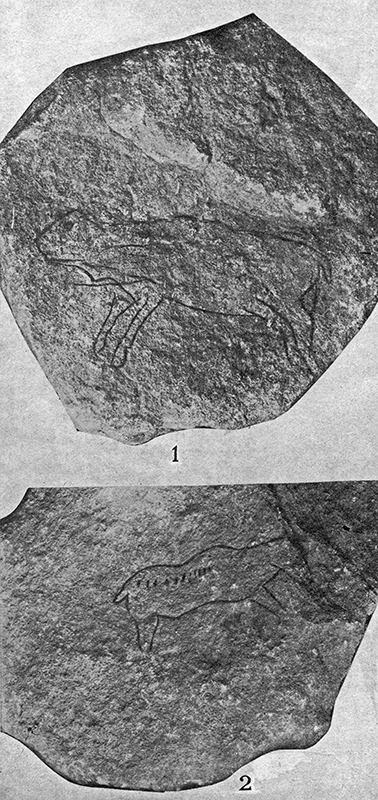
Plate VIII
Deer
No. 1. Deer without antlers at a gallop, on limestone with a not very flat surface.
No. 2. Limestone block with galloping deer bearing a series of elongated, almost parallel punctuations, arranged horizontally on the side. This last particularity can also be seen on one of the reindeer in plate XL.
( Note that the pepper's patches evident on this mammal identify it as a young and/or female deer - Don )
Photo and text: Capitan et Peyrony (1928)
Plate IX
Unknown animal
A beautiful animal very well rendered. The head is surmounted by a small straight horn like that of an antelope, but the rather long tail for this animal would make one think of a bovid, unless it was only an accidental fault due to the connection of the small tail and natural relief.
We must add that the latter, starting from the angular part, is in a sort of cupule. This animal bears a line of hollow points diagonally on its side.
We find the same feature on the engraved fish from the Gorge d'Enfer rock shelter. In the excavations made in 1919 at La Ferrassie, we also noted it on some drawings extracted from the Aurignacian levels.
Photo and text: Capitan et Peyrony (1928)
Plate X
Horse
Galloping horse on limestone. The latter was found broken into two pieces 9 metres apart. The appearance of the animal has been very studied and perfectly rendered.
It is a beautiful work.
Photo (above) and text: Capitan et Peyrony (1928)
Photo: (below) Don Hitchcock 2014
Source: Original, Le Musée National de Préhistoire, Les Eyzies-de-Tayac
Plate XI
Various Animals
A large limestone block with many engraved images, some of which are not very clear and hard to decipher. Others, on the contrary, are very visible and quite neat. We easily notice an equine, three reindeer and the head of a fourth?
Photo (above) and text: Capitan et Peyrony (1928)
Plate XII
Reindeer and Lamp
No. 1 - A small limestone block with a smooth surface and fine grain with many indecipherable engravings in the middle of which stands out a beautiful reindeer's head, more deeply incised.
No. 2. - Underside of a limestone lamp broken into two pieces bearing the well-engraved body of a quadruped whose head has been mutilated by the execution of another design on the fragment on the right.
It is also an animal without a head, which is best distinguished by reversing the photograph from right to left.
Photo (above) and text: Capitan et Peyrony (1928)
Plate XIII
Various Animals
No. 1 - A small lithographic piece of limestone with finely engraved deer, following each other. This subject, as much for its design as for its execution, can be compared to that found by one of us (P.) at Soucy.
No. 2 - Limestone pebble with a poor reindeer head.
No. 3 — Small limestone with forequarters of a chamois.
No. 4. - Hardly intelligible drawing on limestone block seeming to refer to an elephant ( mammoth ).
Photo (above) and text: Capitan et Peyrony (1928)
Plate XIV
Unusual Animal and Deer
No. 1 - Limestone block bearing a deeply engraved bestial head, certainly fanciful, with a thin and elongated muzzle, an oversized eye, a bovine horn lightly engraved on the top of the head, and a series of lines originating from the neck and simulating a mane.
A line hanging under the lower jaw and continuing transversely on the muzzle, would seem to relate to a kind of cord (?longe?). This figure is not that of any animal living in the region at that time, because we all know them very well, either by their image so well rendered, or by their bones so numerous in our prehistoric sites in the south-west of France.
It therefore seems that here the artist gave free rein to his imagination and created one of these fanciful masks comparable to those in fig. 30, nos. 2 and 3 and figure 30 bis and which we also find on the walls of caves.
These representations are numerous at Combarelles.
In our day we find an equally original variety of these personal decorations among the American First Nations.
No. 2. - Headless deer on limestone with an irregular surface.
From what can now be seen, the animal was originally well drawn.
Photo (above) and text: Capitan et Peyrony (1928)
Plate XV
Reindeer, animal, and Reindeer head
No. 1 - Galloping reindeer on fine stone. Another less clear figure, but whose head can be seen with horns curved forward, appears to be a bovid (probably Bos primigenius).
No. 2 - Very deteriorated limestone stone still showing on the old preserved parts the remains of an animal engraving: three legs and part of the head.
No. 3 - Corner of a limestone bearing a fairly finely engraved reindeer's head.
Photo (above) and text: Capitan et Peyrony (1928)
Plate XVI
Childbirth
Drawing deeply incised in one of the corners of a small limestone block. It seems to represent two characters in the attitude of those already mentioned by Dr. Lalanne, also engraved on stone, and coming from the Solutrean of Laussel.
According to him it would be a scene of coitus or childbirth. We would rather lean towards the latter interpretation. The right part seems to relate to a woman with very drooping breast and belly and the left part more to a child than to a man.
Photo (above) and text: Capitan et Peyrony (1928)
Plate XVII
Lynx
Plate XVII, fig 67 - Front of a schist plate furrowed with lines in all directions. In the middle of this mess, the limbs of a lynx stand out clearly to the right: it has a round head, a short and thick muzzle, a circular eye, triangular ears, a large paw and an elongated body. In front we notice another head of the same type, less beautiful and more difficult to distinguish.
Further forward, a human leg with a large foot ending in only four toes. At the knee are arranged four rounded parts placed side by side which seem to be the toes of a second foot which we have not been able to distinguish.
By reversing the figure from top to bottom, we notice on the right the forequarters of an animal. It is only a quick sketch, but the general characters (round head and eye, big paw) relate to a feline.
Forward, on the same level, face to face with the first lynx, another animal, feline or bear? is difficult to determine because of the many unrelated lines that cover it.
Two series of more or less circular signs of different sizes can be seen on the right and left around or on the heads of two felines. Their meaning remains as hypothetical as that of the dots on the Plate VIII mammal and the discs or pellets so numerous in the Pyrenean caves.
( Note that the dots on the Plate VIII mammal referred to are pepper's patches, which identify it as a young and/or female deer or reindeer - Don )
Fig. 68 shows the back of the same plate, but which has a less regular surface. In the middle of many lines, we can manage to decipher, below, a bovine head with a double snout; above, an eye and a horn of another animal of the same type.
Finally, on the right and above, the image of a seal. Representations of the latter are not numerous; they are cited and briefly described in the book Les Combarelles, page 133.
In our digs of 1927, we discovered, in the upper level of the deposit, another slab of schist also engraved on both sides.
Photos (above) and text: Capitan et Peyrony (1928)
Photos (below): Don Hitchcock 2014
Source: Original, and artwork by museum staff, Le Musée National de Préhistoire, Les Eyzies-de-Tayac
Plate XVIII
Reindeer, and Feline Head
- Front of this plate showing two reindeer forequarters in clear. They are side by side and overlap one another; the foreheads, eyes and muzzles are very distinct; the antlers are tangled. We only see one dewlap: that of the animal closest to us.
A feline forequarters, perhaps of a lynx (head, chest and front leg), stands out clearly in black in the middle of the jumble of features.
Photo and text: Capitan et Peyrony (1928)
Plate XIX
Reindeer Head
Verso of the plate XVIII above presenting a multitude of engraved lines in the middle of which clearly appears a beautiful reindeer's head, admirably rendered and very expressive.
Photo and text: Capitan et Peyrony (1928)
Wall Decorations
In the deepest part of the shelter, between the two blocks A and B of the plan (fig. 3), on a fairly regular surface of the wall, we noted a few features covered for the most part with stalactites. For this reason, it was impossible for us to determine its meaning.
Elsewhere the surface of the rock did not lend itself to ornamentation. Despite the irregularity of the wall and the coarseness of the grain of the stone, certain parts now destroyed must have been decorated, as evidenced by a block which seems to have detached from the vault.
It presents on its most regular face the remains of deeply notched engravings. The lines stopping only at the lateral breaks prove that certain parts of the design disappeared when the block was detached; they remained attached to the wall and have since been destroyed by bad weather, or else when they fell they were divided into very small fragments which it was impossible for us to find.
Figure 69
The head of a bison on a limestone block that appears to have been detached from the roof of the shelter.
We have only come across a single piece of these objects which fits very well in a corner of the block forming a beautiful bison's head, nearly entire.
Originally, was the head isolated, or did the animal exist as a whole? We cannot say for sure; but it is certain that part of the image has disappeared as a result of the fracture of the block.
The bison head is well done, despite the difficulty encountered by the artist in the irregularity of the surface. All the parts are well studied and rendered in a striking manner. The small horn and the ear are well in place; the eye is large and expressive, the nose bushy and hairy, the muzzle short, the nostril and mouth well indicated, the drooping goatee and dewlap represented by parallel striations, the start of the neck well indicated.
This engraving, by its technique and its rendering, although it does not stand out well on the granular stone, deserves to be placed next to the masterpieces described above.
Photo and text: Capitan et Peyrony (1928)
Observations
This group of engravings gives us a more complete picture of the art of the Upper Magdalenian. We do not find here the naivety combined with truth that we noticed in the works of the lower level. The artist has neglected the small details, but has devoted himself to studying the position, the gait, the movement of the animals and to rendering them. He has succeeded fully in this.
We noticed that the main pieces lay in the deepest part of the shelter, between the two limestone blocks A and B (fig. 3) in the right-hand side where we saw the traces of parietal engravings. The others were along the wall and therefore not very far from their original location, because the first researchers deposited their rubble close behind them as they went along.
It was therefore at the bottom of the deposit, in the 'cella' or shrine, that these pieces were gathered; we did not find any elsewhere in the upper level.
The rocky walls were not suitable for decoration; nor was there a deep cave nearby for drawing fetish animals and performing mystical ceremonies. It is therefore probable that this secluded and obscure place, closed in front either by skins or by branches, replaced the cave.
It was here that the images personifying the gods were kept. It seems likely that this is the reason why we found them all in this place.
Gallo - Roman Remains
On the surface of the deposit, mixed with the topsoil, we found some remains of more recent civilisations.
These are:
1 - a circular piece of limestone, 35 cm in diameter and 7 cm thick, with a pitted surface to make it gritty. It was probably one of the two parts of a hand mill.
2 - a fragment of a tub or other stone container.
3 - Shards of pottery, two of which are quite large and determinable.
The first is a piece of the body of a vase with the rim and a whole handle. The shape, the nature of the paste and the slip, make it attributable to the Gallo-Roman period.
The second is also a fragment of the body of a pot with the neck and rim. It is decorated with circular and parallel punctuated lines. The paste is grey; it is contemporary with the previous one.
These miserable remains, which probably all date from the same period, do not indicate the construction of a sumptuous villa at this site, but rather a modest dwelling whose occupants, probably hunters and fishermen, were perhaps no happier than their prehistoric predecessors.
Conclusions
At La Madeleine, the initial Magdalenian phase is not distinctly represented. In Périgord and Charente, it seems to begin with the flint level with abrupt retouching, of which the lower part of La Madeleine has given some specimens (Fig. 9). At Le Placard this level is at the extreme base of the Magdalenian; and at Laugerie Haute, at Champs-Blancs or Jean-Blanc, it is situated directly on the beautiful Solutrean with notched points.
According to M. Maury's excavations at Laugerie-Basse and, about a hundred metres upstream, at Les Marseilles, it seems that another horizon is located between the latter and the one with primitive harpoons. It is characterised above all by small daggers with lateral symmetrical projections, assegai points with a quadrangular pyramidal base, bone discs, sculptures and bas reliefs in limestone, etc.
At La Madeleine, we find the various characteristic pieces of these two levels; they are represented there, but the thinness of the lower layer or its poverty when it was thicker, did not allow us to differentiate them clearly from the primitive harpoon layer. In the description of the works of art, we pointed out that the main sculptures (Figs. 25, 26 and 27) and the bas-relief on stone (Fig. 23) were made by the same artist.
This observation is of value; it shows that the main sculptures (Figs. 25, 26 and 27) and the bas-relief on stone (Fig. 23) came entirely from the base of the site. This observation has its value; it shows that these pieces are older than those collected above and allows us to relate them to one of the oldest facies of the Magdalenian, at least to that of the lower layer of the Laugerie- Basse and Marseilles deposits.
But if, in spite of the number and variety of the materials extracted from the classic deposit of La Madeleine, we cannot study the beginnings of this period very clearly (the lower layer having formed two distinct strata only over a small area and the material collected in the lower one not having provided any typical pieces distinguishing it from that of the upper one), they give us a more or less complete knowledge of the primitive harpoon beds, harpoons with unilateral barbs and harpoons with double rows of barbs. They allow us to witness the faunistic, industrial and artistic evolution of this period.
They allow us to see, by comparing them with those of the Pyrenean caves collected by E. Piette:
1 - That the climate of south-western France, that is to say the part between the central plateau and the Pyrenees, was more or less the same in all its parts, during the various Magdalenian phases: the lower layer of La Madeleine, with numerous horse bones, corresponds to Piette's Equidian; the upper one, where the reindeer dominates, to his Tarandian, and the upper one, where the deer is quite abundant in the upper part, to his Elapho-Tarandian.
2 - That the industry of the various corresponding strata is more or less the same, except for the bifid-based points which belong to different levels.
3 - That the art in Périgord and in the Pyrenees has undergone the same evolution.
From all the facts set out above and from the detailed study that has been made, it also emerges that : That if the classic Magdalenian lithic industry (scrapers, blades, burins, drills, etc.) has been known for a long time, there are pieces to which attention has not yet been sufficiently drawn, pieces due to the survival or reappearance of characteristic forms from earlier periods.
Thus, the bristle point (Fig. 9, No. 13) and especially the notched point (Fig. 34, Nos. 8, 9, 10 and 11; Fig. 45) continued to be used as assegai fittings, in conjunction with bone points. The same is true of the large back points of the La Gravette type (Fig. 9) and of the lamellar back microlithic industry that characterise the Upper Aurignacian.
Mousterian forms (punches (Figs. 12 and 46), points (Fig. 12), scrapers (Fig. 34), discs, etc.) are timidly reviving. They are rare, but they do exist.
That the small, short, stubby curved points (Fig. 48), already announcing the Azilian forms, characterise the end of the Upper Magdalenian. They are always found together with numerous helix shells and anodont valves, indicating a significant softening of the temperature. We have also noted this particularity in the Magdalenian deposit of the Château des Eyzies (1).
That parrot beaks, rare in the lower levels, are very numerous in the upper level and of lesser dimensions in the upper level.
That the natural or artificial cups, bearing traces of colouring matter, have been used to crush or dilute it and are, therefore, paint vessels; but that those which do not contain it most often contain the residue of burnt fat, and are almost always cracked or reddened, in places, as a result of the prolonged action of a heat source; that it is rational to see primitive lamps in them, as one of us has explained (1) (fig. 50).
That the colours were pulverised on large flat quartzite or gneiss pebbles found in the bed of the Vézère, with smaller round or prismatic pebbles serving as mollettes (Fig. 65, no. 1).
That these finely powdered colouring materials were washed onto schist palettes, probably with grease, which made the paint greasy, allowing it to be better fixed on the rock faces and to remain there (Fig. 65, no. 2). The coloured bands that form the animals' outlines do not show any smears that would have occurred with water-based paint.
That after the discovery of the tip (fig. 18, no. 12), it is almost certain that the prehistoric Troglodytes did not only paint their bodies, but also tattooed them.
That the anthropomorphic figures (Fig. 30 and Pl. XIV) prove that the use of masks representing not only known animal heads, but also fantasy heads, was in practice at that time. That a kind of writing, the meaning of which is not yet known, already existed (Fig. 33).
That the harpoons with angular, one-sided barbs (Fig. 36, no. 8 '1, 2, 3, 4, 5, 6, 7, 8) characterise the lower part of the level, whereas the harpoons with regular curved barbs (Fig. 36, no. 8 20, 21 and 22) belong to the upper part.
That the harpoons with a double row of angular barbs (Fig. 51, no. 12) or with curved barbs, but with the point at a sufficient distance from the shaft (Fig. 51, no. 8 3, 4, 6), belong to the second upper half of this horizon.
That small bone points (Fig. 52, no. 11) derived from bifid-based points resembling Neolithic winged arrowheads, with a concave base or peduncle, characterise the Final Magdalenian.
That the engraved pebbles (fig. 66) identical to those found by Piette in the painted pebble deposit of Mas d'Azil appear to be at the level of the points (fig. 48). It would seem that an Azilian horizon, still poorly defined, existed at La Madeleine.
That almost all the great fauna of the period was drawn on bone or stone: horses, reindeer, ibex, izards or chamois, hinds, saiga antelopes, bison, oxen, wild boars, canids, bears, lynx, mammoths, as well as numerous fish: pikes, carp.
That the three drawings (fig. 19, no. 13; fig. 20, no. 1 and fig. 56, no. 1), animals pierced with arrowheads, appear to be more particularly magical and relate to scenes of bewitchment.
That the various representations of barbed arrows appearing on the same piece as animal attributes (Fig. 24, nos. 2a and 2b and Fig. 38, nos. 7 and 8) are based on the same idea. That those decorating certain objects (Fig. 31, nos. 6, 7, 8a, 8b; Fig. 42, no. 12 and Fig. 60, nos. 18, 19 and 20) give these weapons or tools a more powerful and deadly power.
Both the scalariform (Fig. 41, no. 2) and pectiform (Fig. 41, no. 4) signs appear to be derived from the barbed arrow (Fig. 31, nos. 10 and 12) or from the stylisation of the fish (Fig. 57, nos. 3, 4, 5, 6).

Fig. 70
Discovery of a Skeleton
- Position of the child's skeleton discovered at La Madeleine.
Thanks to the kind permission of the owners, Mme and M. de Villepin, we were able to resume the excavations at the La Madeleine deposit at the point where we had left them in 1913.
After having removed the brambles and bushes that had invaded part of the deposit, and having had the spoil of the deposit skimmers who had operated in the absence of supervision transported outside, I pushed my research to the east, where the archaeological layer measured no less than 155 cm.
As I had noted in 1913 (an observation recorded in my excavation notebook), I found myself in a real dump; there was a large quantity of flint flakes from debitage or waste, broken bones accompanied by the ordinary lithic tools which were not very abundant and a few fragments of bone and reindeer antler objects; there were few whole pieces.
The layer, which was uniformly black and at least 1 metre thick, provided specimens of the industry of the three levels found on the western side of the shelter, which confirms our hypothesis of a dumping ground.
The excavations, always carried out with the greatest care, led, on 11 December 1926, to the discovery of a bone debris which seemed human. We redoubled our precautions. After a careful and meticulous examination, we were convinced of the presence of a child's skeleton. It took three days to remove the material that covered it, and then, piece by piece, it was completely recovered. It was at this point that the interesting findings began.
This skeleton was outside the living area. It lay in a natural or artificial slope of the clay-sand soil of the station, of an earthy brick red colour that contrasted with the black archaeological deposit on top. The large cavity appeared to have been deepened at this point. There was, however, no real pit (Fig. 70).
The skeleton was 260 cm from the cliff, lying on its back, slightly inclined on its left side, following the North-South direction, with its head towards the latter point. The arms were extended along the body, the skull protected by three stones set up in a semi-circle behind. Numerous small shells and pierced teeth lay on the ankles, knees, wrists, elbows, around the neck and on the head.
The soil directly in contact with the human bones was reddish brown, showing that it contained a significant proportion of ochre. The corpse of this child, coated with red (sprinkled with ochre to a greater or lesser extent, presumably painted with this material), had been carefully deposited in a place adorned with a rich ornament.
All the bones, with numerous red spots, were in anatomical connection, except for those of the head; the latter was broken; some parts had been broken when it was already fossilised, but the face was presumably broken shortly after burial.
The breaks leave no doubt as to the condition of the bone at that time. In addition, teeth and jaw debris were found scattered over the chest and lumbar region, mixed with the lower part of the layer directly over the corpse.
This observation proves that the body had been fairly lightly covered at the time of burial and that the head, which was slightly elevated, had suffered from the comings and goings of the shelter's occupants before being completely buried under the rubbish of all kinds accumulated there by successive generations.
The archaeological layer having provided at its base fragments of primitive harpoons and a piece of carved spear thrower, I think that it is in the corresponding phase of the Magdalenian that we must place the inhumation of this child.
The subject must have been between 5 and 7 years old. He was losing his teeth. I collected milk teeth and adult teeth; some of the latter had not yet emerged from their sockets.
Burial during the Middle and Upper Palaeolithic is certain. However, it is still disputed in various ways. It was certainly not yet the general rule. It seems to have been reserved at first for a few privileged people, chiefs or sorcerers, and for members of their families.
Skeletons are quite rare in relation to the population of that time. The great mass of corpses must have been devoured by ferocious beasts, especially hyenas. But the practice of burial, which became a more or less general rule from the Neolithic onwards, originated in the Mousterian period: witness the skeletons discovered at La Chapelle-aux-Saints, La Ferrassie, etc.
During the Upper Palaeolithic, this custom was perpetuated without, however, taking on any great importance. Here, the grooming of the dead is more meticulous: the bones, most often covered with red ochre, indicate body painting; the shells and various objects, sometimes lying next to them, come from bracelets, necklaces and rings.
It is highly probable that all these precautions would not have been taken if the bodies had been left to the animals.
The discoveries made at Menton, Solutré, Cap Blanc, Combe Capelle, Predmost and now at La Madeleine, prove conclusively that these were neither accidents nor the abandonment of corpses, but a custom in its early stages, which subsequently became widespread. The respect, and perhaps the veneration, of which certain people were the object, accompanied their remains.
Burial did not consist of burying a body at a greater or lesser depth, but rather in the way it was placed in the ground and then protected.
The discovery of La Madeleine therefore supports the thesis of burial during the Palaeolithic.

We cannot end this study without expressing our gratitude to the memory of Mme La Borderie Boulou, née Limoges, who graciously authorised this work and provided every facility for it, as well as to that of our late collaborator and friend, Belvès, whose help was so precious to us.
Our thanks go to Mme and M. de Villepin who continue to give us the same permission;
To our excellent excavator Bouyssou who, with great patience, particular care and a special taste for these researches, found the various fragments which made it possible to reconstitute numerous pieces;
To his devoted comrades Audit Paul, Constant Henri, Adrien and Marc Freyssingeas; To our friends Raveau father and son, volunteer excavators, who spent most of their holidays working with us;
Finally, to our learned friend, Abbé Breuil, whose skillful pen has drawn many of our pieces.
Photo and text: Capitan et Peyrony (1928)

References
- Bordes F., Deffarges, R., de Sonneville-Bordes D., 1973: Les pointes de Laugerie-Basse dans le gisement du Morin. Essai de définition.Bulletin de la Société préhistorique française, Comptes rendus des séances mensuelles. 1973, tome 70, N. 5. pp. 145-151.
- Capitan L., Peyrony D., 1928: La Madeleine : son gisement, son industrie, ses oeuvres d’art. Paris, Librairie Emile Nourry, 1928.
-
Cheynier A., 1963: Les burins, Bulletin de la Société préhistorique de France, tome 60, no. 11-12, 1963. pp. 791-803
doi : https://doi.org/10.3406/bspf.1963.3956
https://www.persee.fr/doc/bspf_0249-7638_1963_num_60_11_3956 - Collie, G., 1928: The Aurignacians and their culture, Issued January 1928 as Beloit College Bulletin, Vol. XXVI. No 2, printed by the Daily News Publishing Company
- Crémades M., 1994: Oeuvres d'art mobilier inédites de la Madeleine (Tursac-Dordogne), (Fouilles J.M. Bouvier). In: Paléo, N. 6,1994. pp. 233-246.
- Duhard J., 2009-2010: Une nouvelle représentation feminine à la Madeleine (Tursac, Dordogne) Paleo, No. 21 – 2009-2010 – Pages 127 à 134
- Guthrie, R., 2005: The Nature of Palaeolithic Art, University of Chicago Press, 2005 - Nature - 507 pp.
- Lartet, E., Christy H.,1875: Reliquiae aquitanicae : being contributions to the archaeology and palaeontology of Pèrigord and the adjoining provinces of Southern France, London: Williams, 1875
- Leroi-Gourhan A., 1973: Prähistorische Kunst: d. Ursprünge d. Kunst in Europa, Herder, 1973 - 601 pages
- Lorblanchet M., 1995: Les grottes ornees de la prehistoire: Nouveaux regards, Editions Errance (1995)
- Marshack, A., 1972: The Roots of Civilization: the Cognitive Beginning of Man’s First Art, Symbol and Notation New York, McGraw-Hill
- Paillet, P., 2011: Le mammouth de la Madeleine (Tursac, Dordogne), Paleo, 22 | 2011, pp 223-270
- Pearson, G., 1999: North American Paleoindian Bi-Beveled Bone and Ivory Rods: A New Interpretation, North American Archaeologist, Volume 20, Number 2 / 1999 pp 81 - 103
- Peyrony, D., 1926 - Fouille de La Madeleine, Carnet de fouilles D. Peyrony, Archives du Musée national de Préhistoire, Les Eyzies-de-Tayac, p. 110-112.
- Peyrony, D., 1927 - Découverte d’un squelette humain à La Madeleine, Institut International d’Anthropologie, Amsterdam, 1927, 3, p. 318-320.
- Sieveking, A., 1979: The Cave Artists, Thames and Hudson
- Taborin, Y., 1993: La parure en coquillage au Paléolithique XXIXe supplément à "Gallia Préhistoire" Paris : CNRS, 1993
- Vanhaeren, M. et d’Errico, F., 2001: La parure de l’enfant de la Madeleine (fouilles Peyrony). Un nouveau regard sur l’enfance au Paléolithique supérieur, Paléo [En ligne], 13 | 2001, mis en ligne le 26 mai 2010, Consulté le 04 octobre 2010. URL : paleo.revues.org/index1058.html
- Vanhaeren, M. et d’Errico, F., Billy, I., Grousset F., 2004: Tracing the source of Upper Palaeolithic shell beads by strontium isotope dating, Journal of Archaeological ScienceVolume 31, Issue 10, October 2004, pp. 1481–1488
- Vialou D., 1991: La prehistoire (L'univers des formes), Gallimard (1991).
- Wisniewski T., Mroczek P., Rodzik J., Zagorski P., Wilczynski J., Nyvltova Fisakova M., 2012: On the periphery of the Magdalenian World: An open-air site in Klementowice, Quaternary International 272-273 (2012) 308 - 321
Back to Don's Maps
 Back to Archaeological Sites
Back to Archaeological Sites
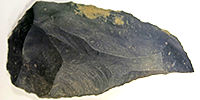 La Madeleine tools
La Madeleine tools
